MEET THE SPECIALISTS
At Lyon & Turnbull we want to make buying at auction as easy and enjoyable as possible. Our specialist team are on hand to assist you, whether you are looking for something in particular for your home or collection, require more detailed information about the history or current condition of a lot, or just want to find out more about the auction process.




3
Olivia Ross Junior Specialist olivia.ross@lyonandturnbull.com
Philip Smith Senior Specialist philip.smith@lyonandturnbull.com
Joy McCall Senior Specialist joy.mccall@lyonandturnbull.com
John Mackie Head of Sale john.mackie@lyonandturnbull.com


PAIR OF GOTHIC REVIVAL CANDLESTICKS, CIRCA 1880
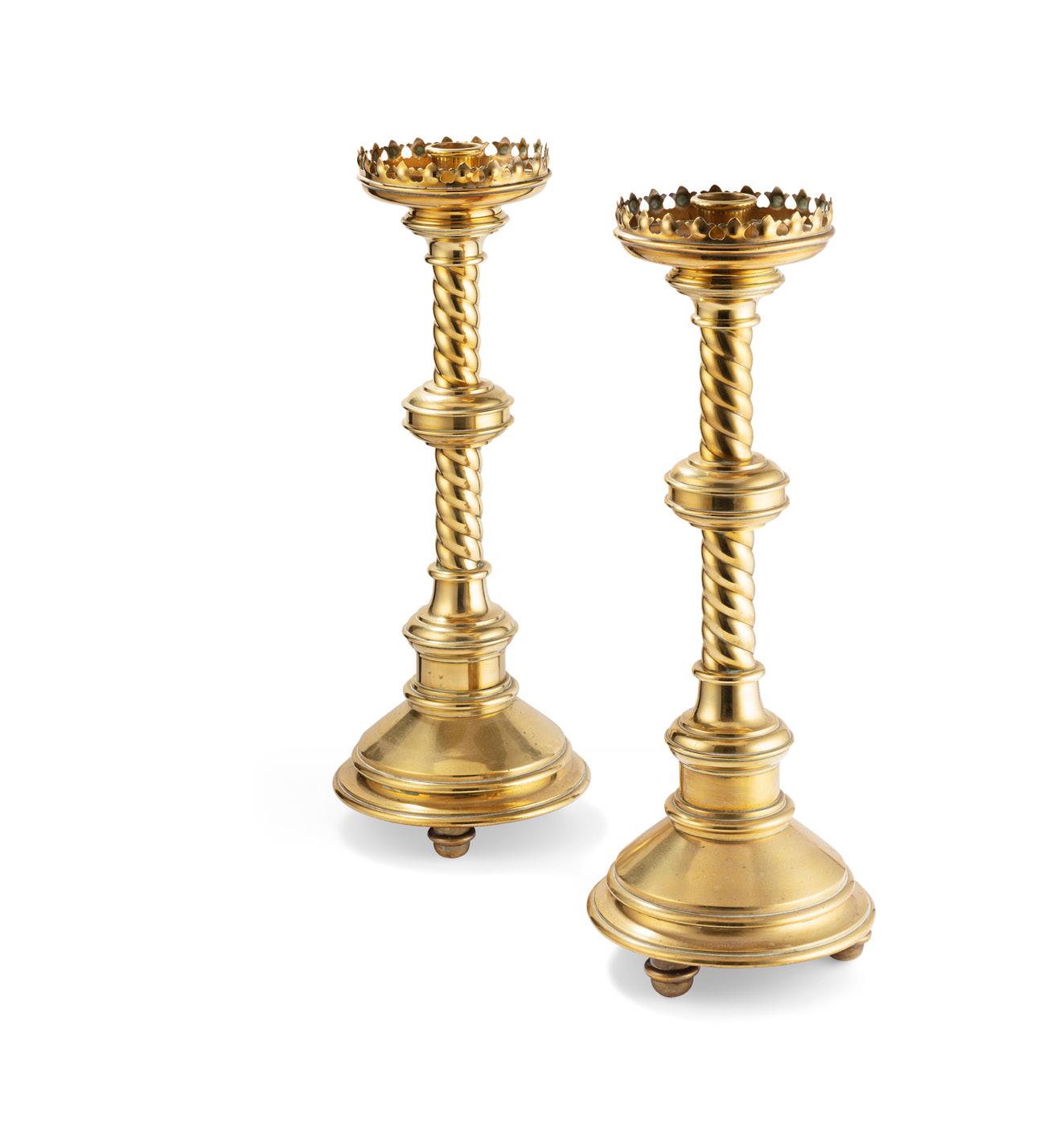
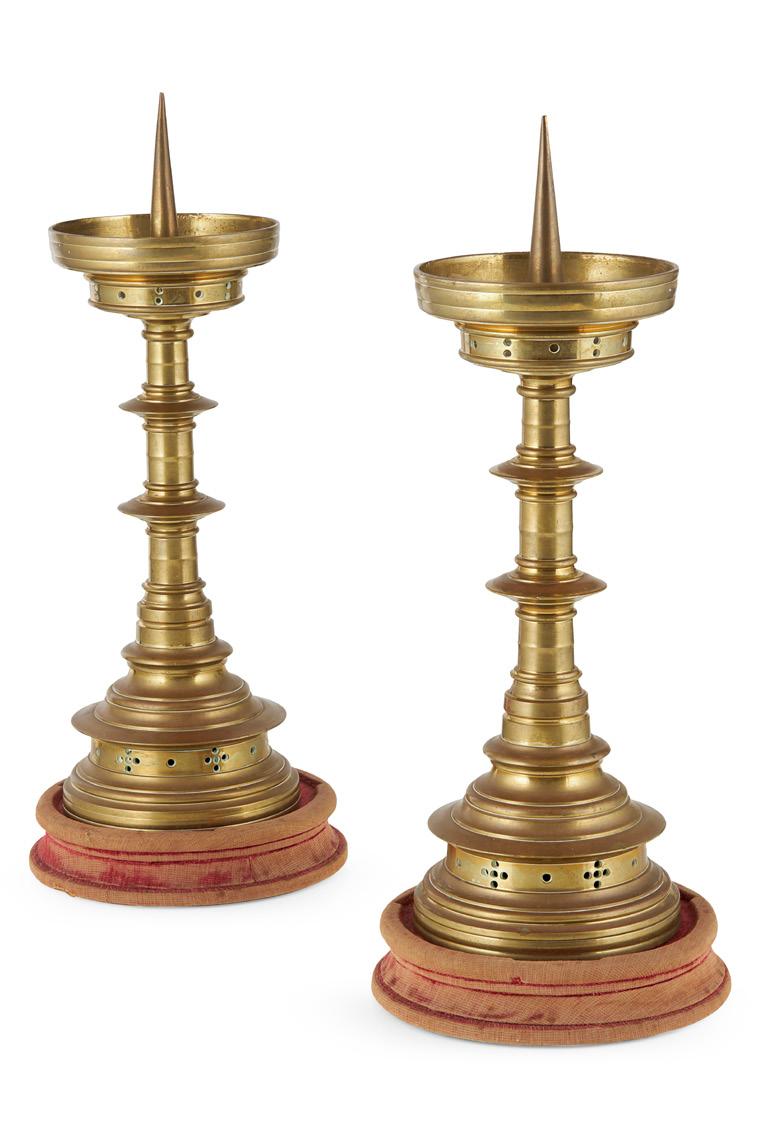
brass, with associated velvet covered plinths (2) 36cm high excluding plinth; 39.5cm high including plinths
£400‑600
2
ENGLISH
PAIR OF GOTHIC REVIVAL ALTAR CANDLESTICKS, CIRCA 1890

cast brass (2)
78cm high
£300‑500
PAIR
brass each 50.5cm high
£400‑600
1
MANNER OF JAMES BROOKS
3
JOHN HARDMAN & CO., BIRMINGHAM (ATTRIBUTED MAKER)
OF GOTHIC REVIVAL CANDLESTICKS, CIRCA 1890
5 Other fees apply in addition to the hammer price: see the ‘Buyer’s Guide’ section on page 2
5
4
ENGLISH GOTHIC REVIVAL CORNER CUPBOARD, CIRCA 1890
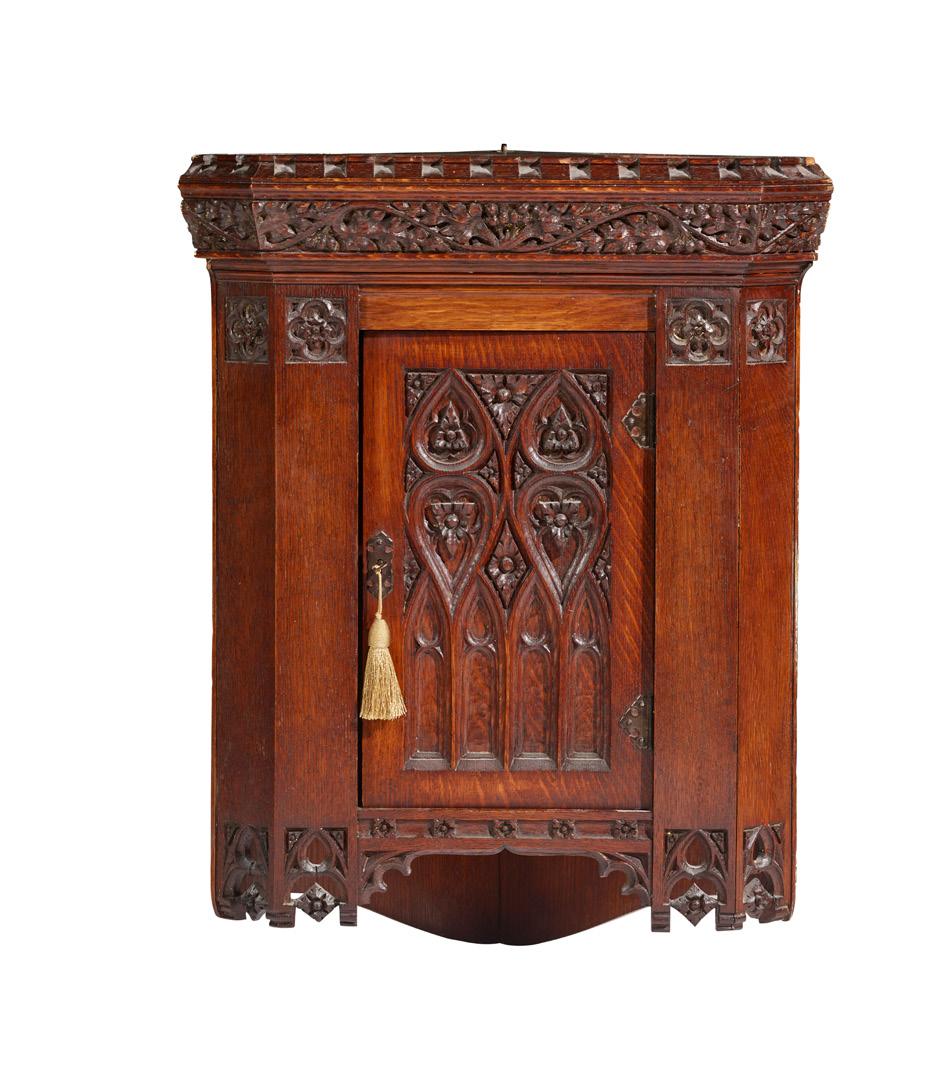
oak, with patinated metal fittings
54cm wide, 69cm high, 31cm deep £300‑500
GOTHIC REVIVAL ALMS DISH, CIRCA 1890 brass and white metal 51cm diameter £300‑500

6
PAIR OF SIDE CHAIRS, CIRCA 1870

walnut, with later close‑nailed velvet upholstery (2) 46cm wide, 86cm high, 48cm deep
Literature: Shutler P.A. Furniture for the Granville Hotel, DAS Journal No. 42, 2018, p. 19, pl. 23 where a similar chair but with cantilever base is illustrated.
Note: These chairs were designed for the Dining Room at The Granville Hotel, Ramsgate, Kent. £400‑600
E.W. PUGIN (1834‑1875)
6 Other fees apply in addition to the hammer price: see the ‘Buyer’s Guide’ section on page 2
ENGLISH REFORMED GOTHIC MANTEL CLOCK, CIRCA 1880 the single train movement with engraved brass dial, within carved oak case
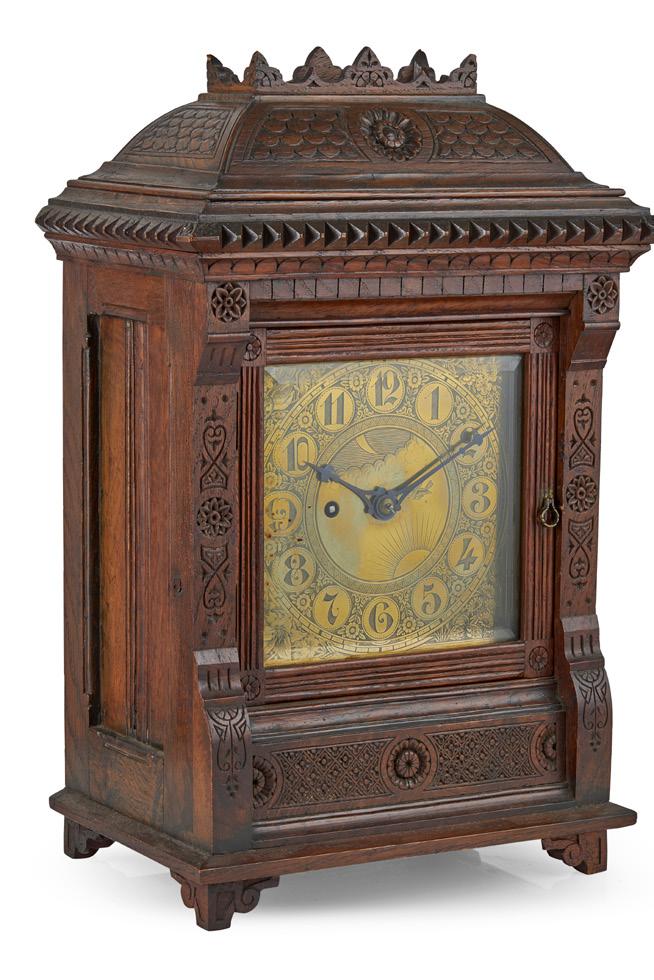
49cm high
£600‑800
8
ENGLISH PAIR OF GOTHIC REVIVAL CANDLESTICKS, CIRCA 1870

brass (2)
25cm high
9
ENGLISH, MANNER OF JOHN HARDMAN & CO., BIRMINGHAM
PAIR OF CANDELABRA, CIRCA 1870 plated metal, one stamped 0/ 10, the other stamped 21/ 22 (2)
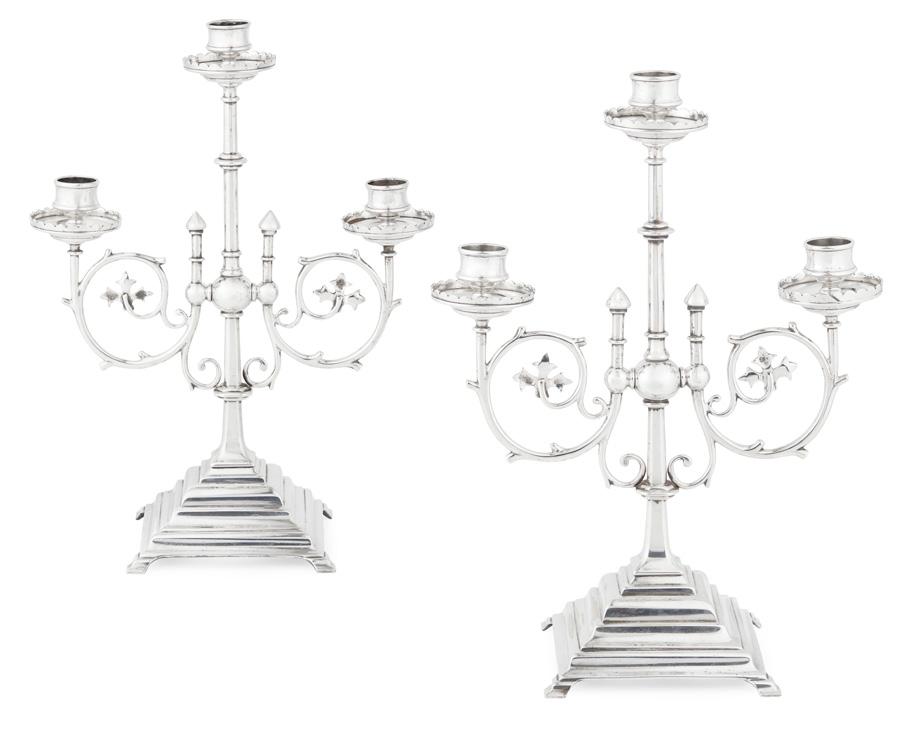
34cm high
£300‑500 11
£300‑500 10
E.W.
GOTHIC REVIVAL CANDELABRUM, CIRCA 1880

brass
50.5cm high
Literature: John Hardman & Co. catalogue 1875, where a similar design is illustrated.
£250‑350
ENGLISH GOTHIC REVIVAL LOW TABLE, CIRCA 1900

oak
74cm across, 61cm high
£400‑600
7
PUGIN (1834‑1875) (ATTRIBUTED DESIGNER) FOR JOHN HARDMAN & SONS
7
E.W. PUGIN (1834‑1875) (ATTRIBUTED DESIGNER)
GOTHIC REVIVAL TABLE, CIRCA 1870
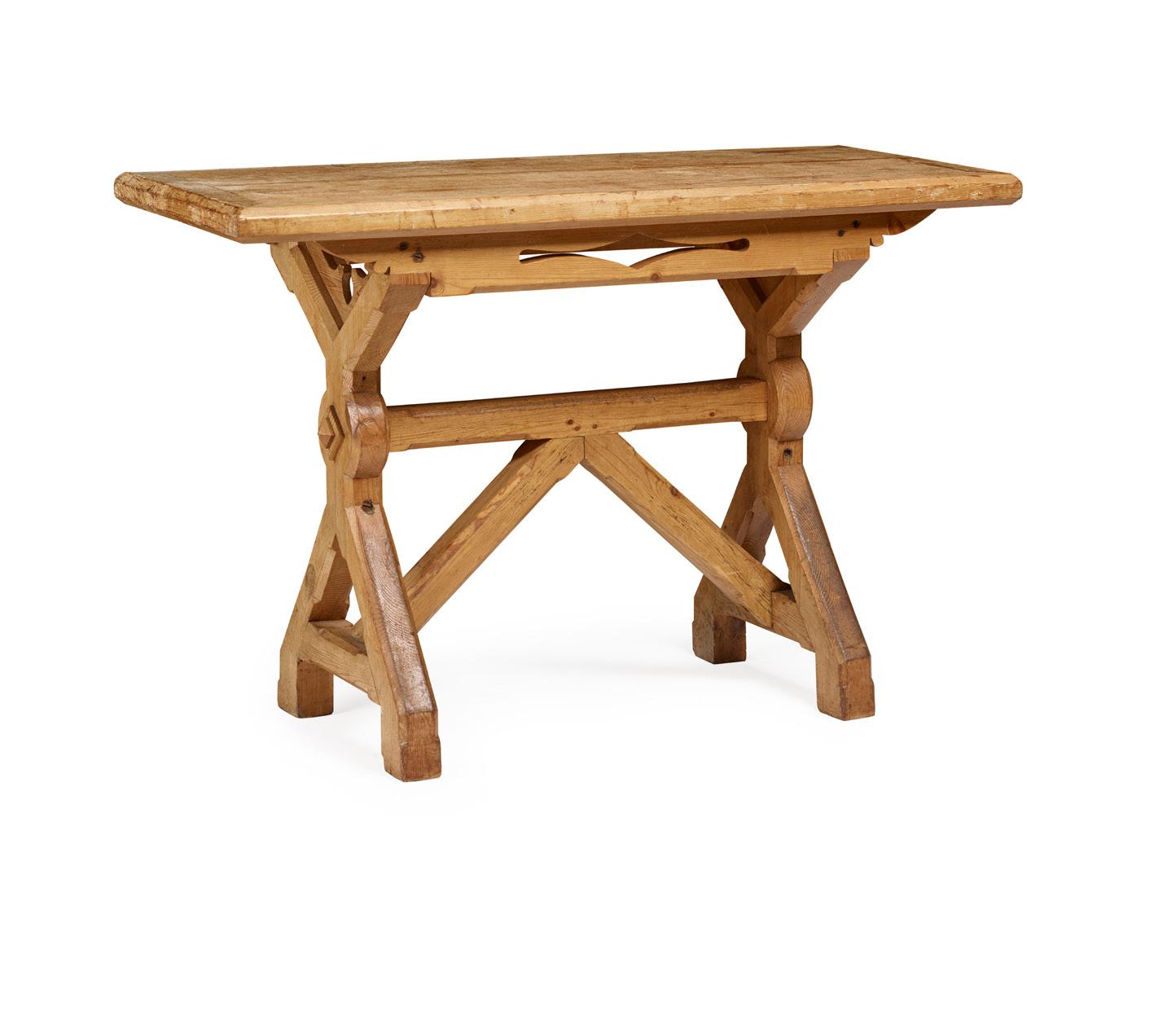
pine
121cm long, 81cm high, 53cm deep
Provenance: By repute The Cathedral Church of St Colman (Cobh Cathedral), County Cork £400‑600
13
A.W.N. PUGIN (1812‑1852) FOR MINTON, HOLLINS & CO., STOKE‑ON‑TRENT GROUP OF NINE GOTHIC REVIVAL TILES, CIRCA 1860 glazed earthenware, moulded marks verso (9)
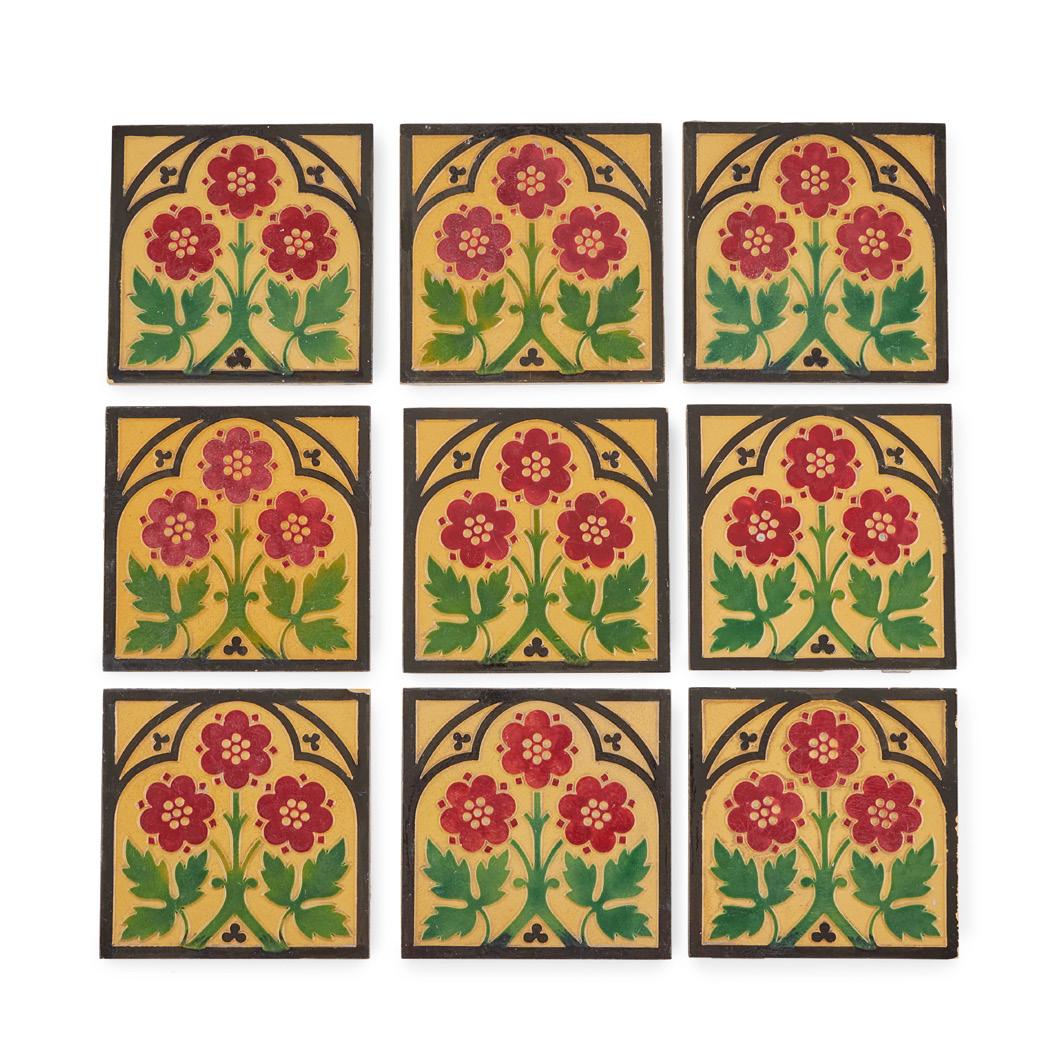
each tile 15.2cm square £400‑600
14
ENGLISH
GOTHIC REVIVAL GONG, CIRCA 1900
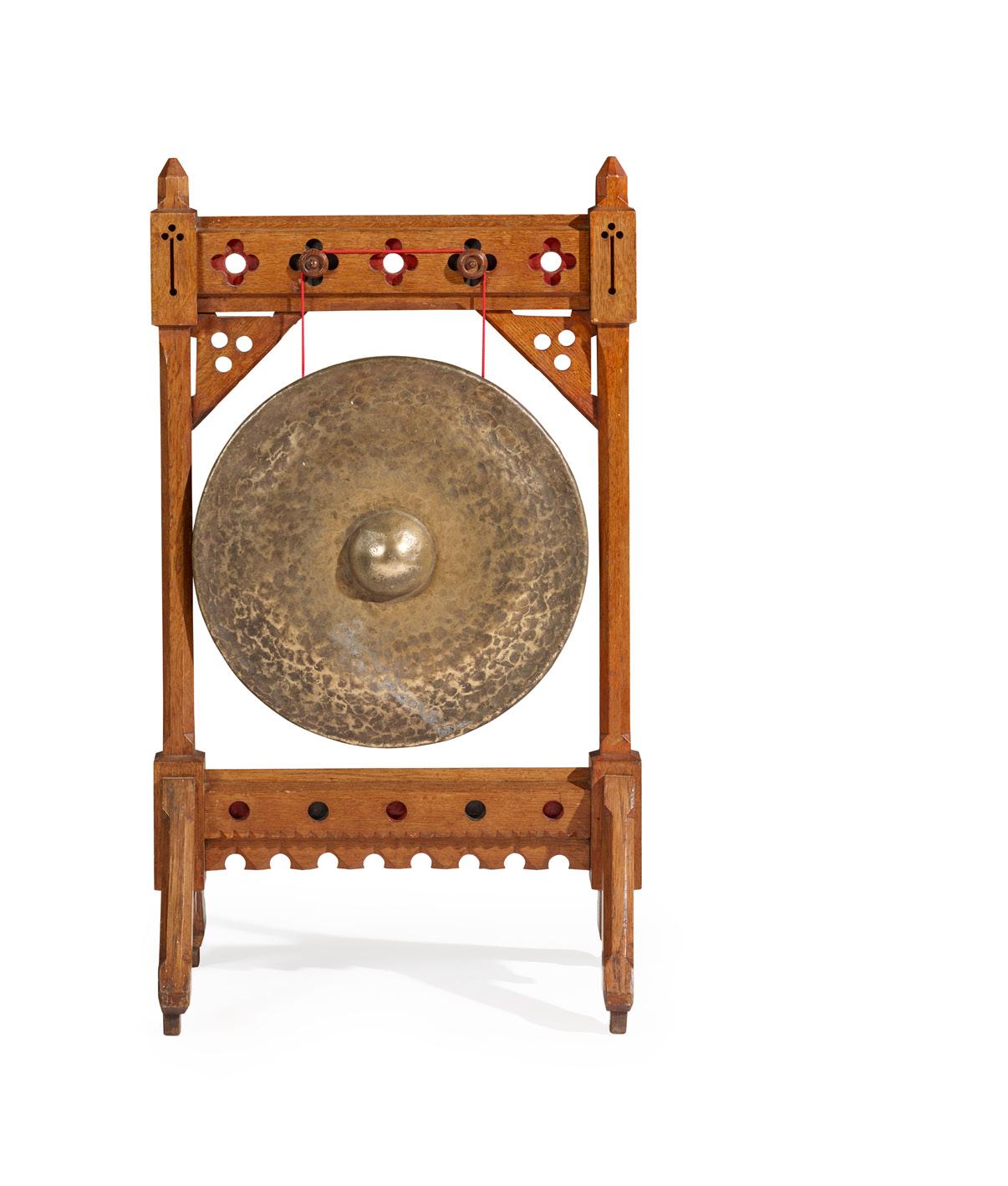
oak, with brass gong and polychrome decoration
61cm wide, 109cm high, 39cm deep £400‑600
15
GEORGE EDMUND STREET (1824‑1881)
SIDE CHAIR, CIRCA 1880

oak, with original close‑nailed leather upholstered seat, branded marks
47cm wide, 89cm high, 49cm deep
Note: Street designed these chairs for the Law Courts (now the Royal Courts of Justice) which he also designed, and which were opened by Queen Victoria in 1882.
£300‑500
16
ENGLISH
VICTORIAN INKSTAND, CIRCA 1850 electroplated metal 23.5cm across £200‑300
12
8 Other fees apply in addition to the hammer price: see the ‘Buyer’s Guide’ section on page 2
AFTER RICHARD WESTMACOTT THE YOUNGER
‘BLUEBELL’; PAIR OF OVAL PANELS, CIRCA 1850 plaster, within glazed overpainted frames (2) panels 44cm x 34cm £300‑500
18
HENRY ALFRED PEGRAM (1862‑1937)
PORTRAIT OF MILLICENT MARGARET FISHER, CIRCA 1897 plaster relief panel, within the period oak frame, relief moulded inscription MILLICENT MARGARET FISHER/ HENRY ALFRED PEGRAM FECIT panel 34.5cm x 19cm £300‑500
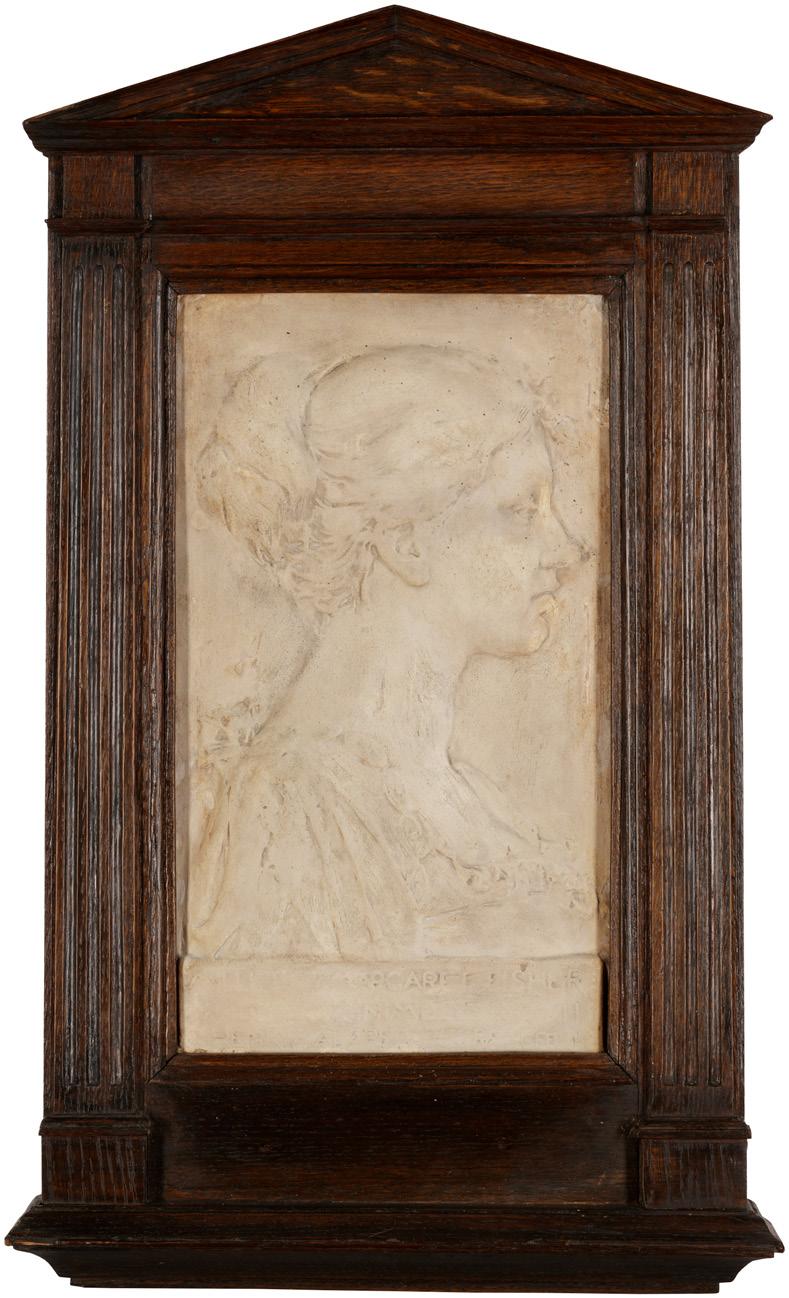


19

F. DAVIES AND SONS, NEWCASTLE UPON TYNE
‘ULYSSES FOLLOWING THE CAR OF NAUSICAA’ glazed and printed ceramic, later frame 29.5cm square £300‑500
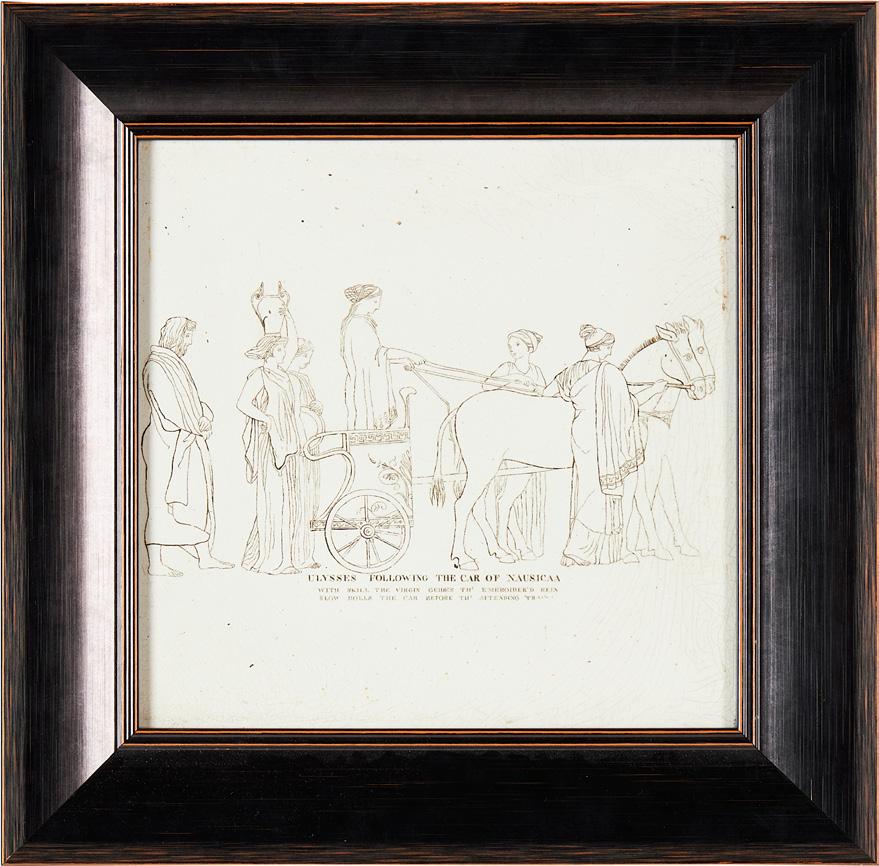
17
9
21
BRUCE J. TALBERT (1838‑1881) (ATTRIBUTED DESIGNER) AESTHETIC MOVEMENT SIDE TABLE, CIRCA 1870

oak
115cm wide, 77cm high, 61cm deep £400‑600
ENGLISH, MANNER OF BRUCE TALBERT PAIR OF AESTHETIC MOVEMENT CANDLE SCONCES, CIRCA 1880
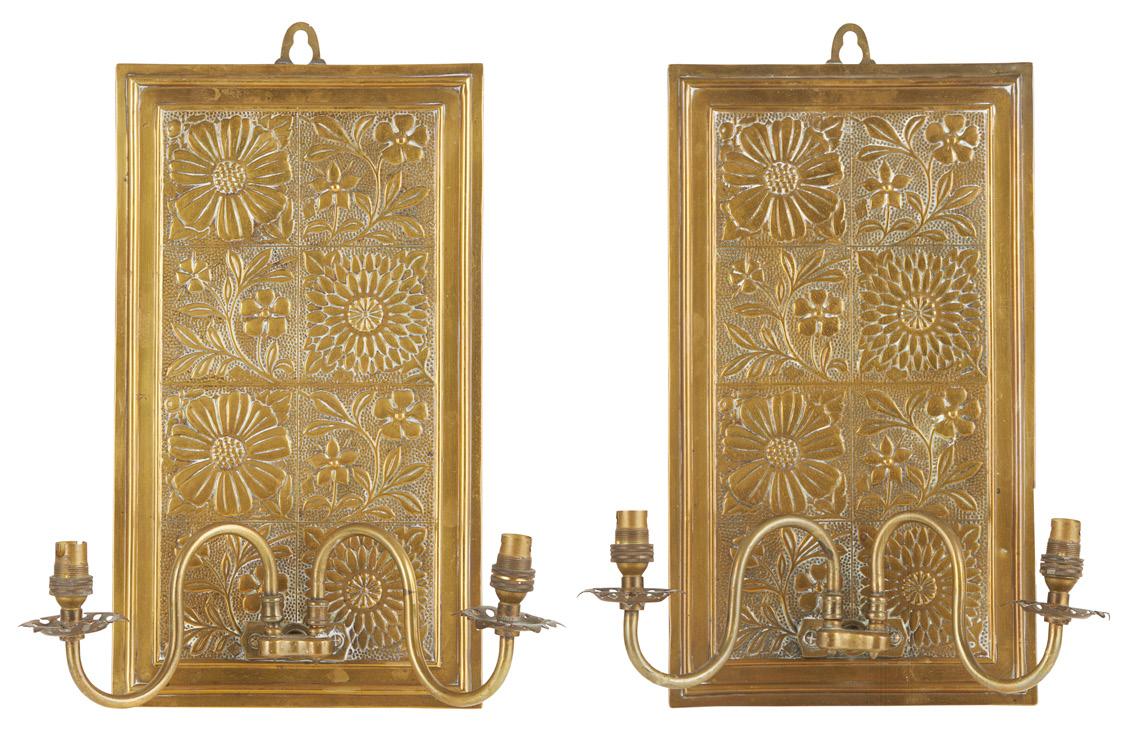
embossed and cast brass (2)
20.5cm wide, 36cm high, 16cm deep approx. £600‑800
22
BRUCE TALBERT (1838‑1881)
AESTHETIC MOVEMENT LIBRARY TABLE, CIRCA 1880

carved oak
168cm long, 74cm high, 80cm deep £1,000‑1,500
20
10 Other fees apply in addition to the hammer price: see the ‘Buyer’s Guide’ section on page 2
AESTHETIC MOVEMENT BUREAU BOOKCASE, CIRCA 1875 mahogany, with brass fittings, the sloping fall opening to reveal a fitted interior, stamped 9551 147cm wide, 198cm high, 61.5cm deep
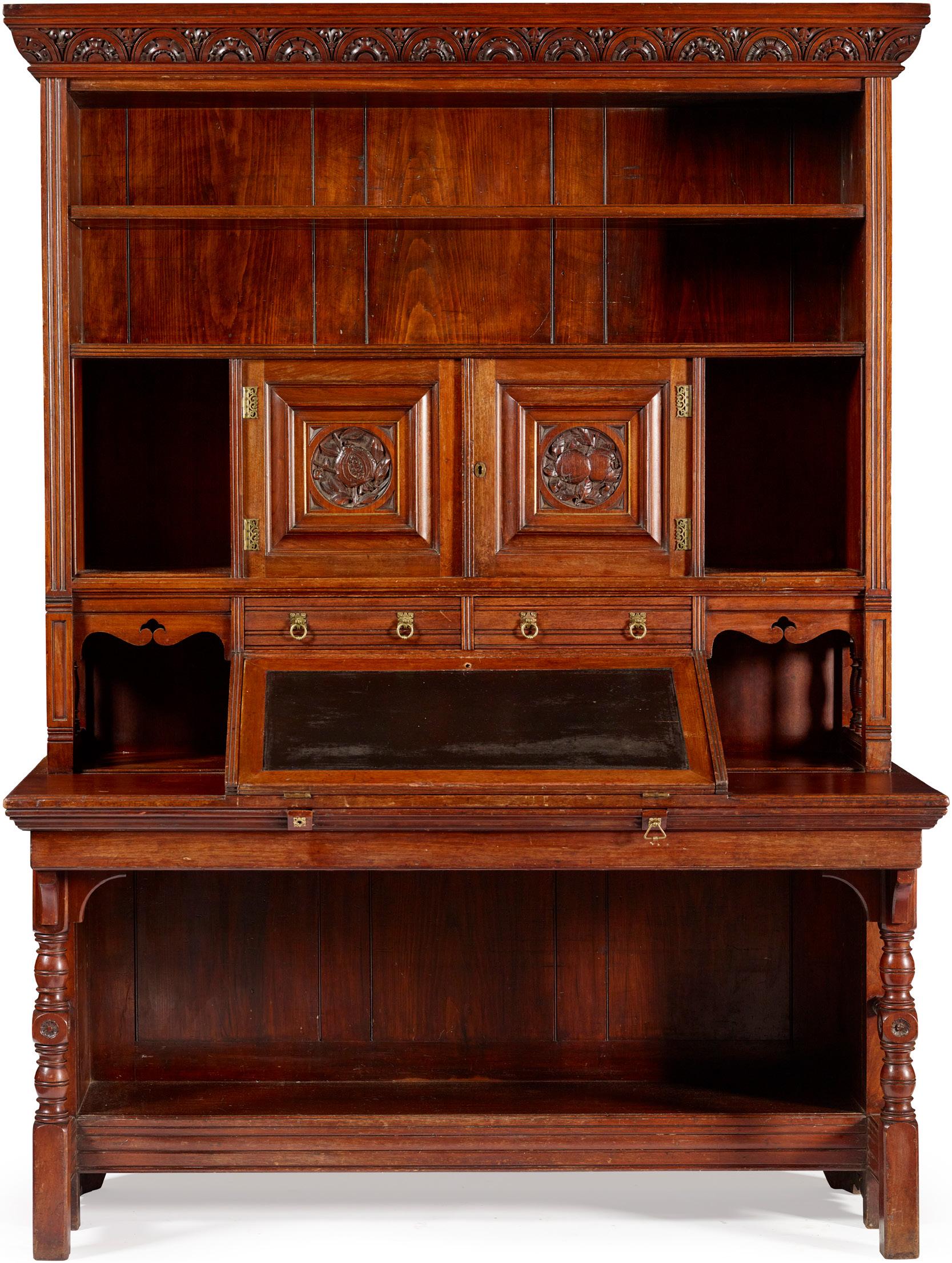
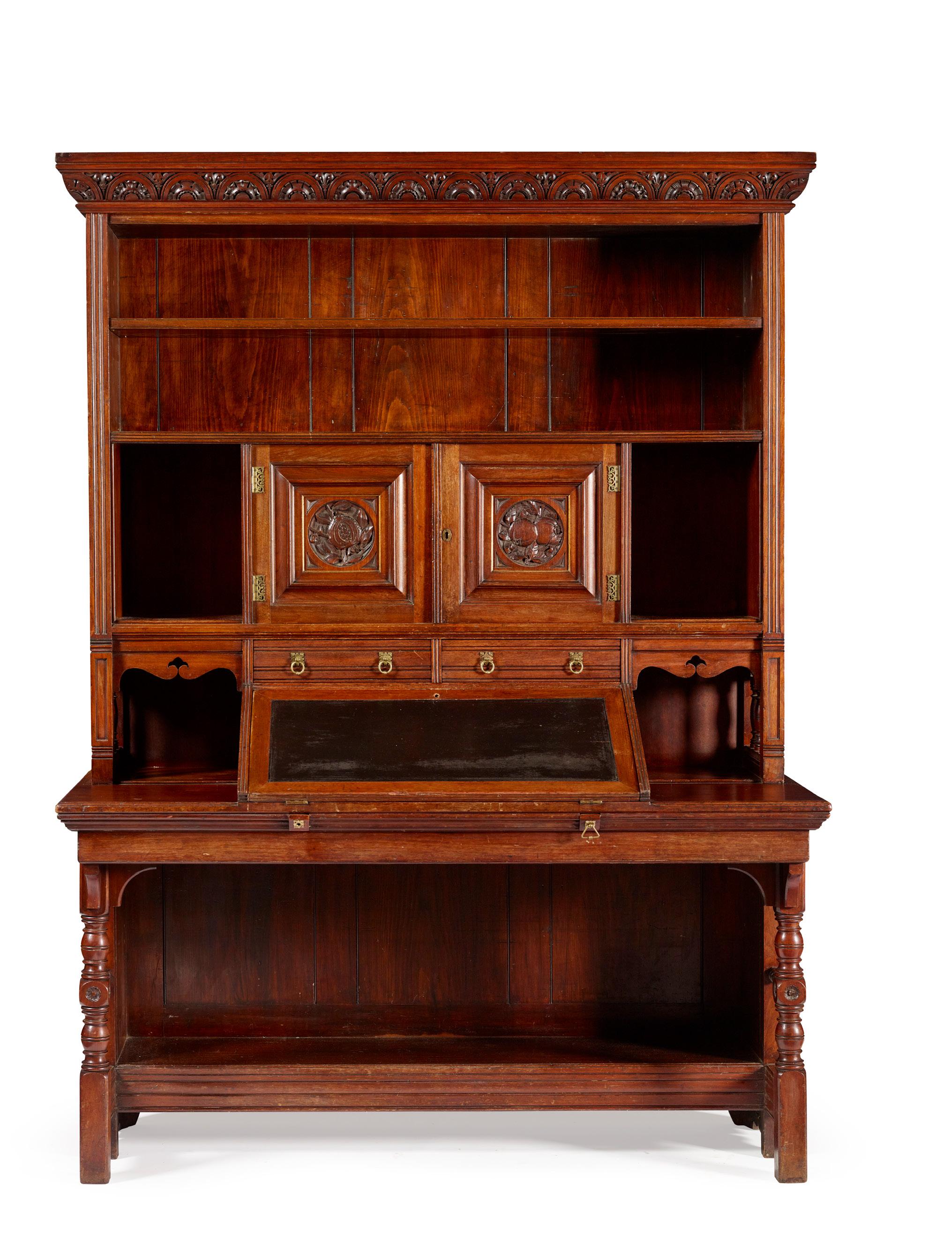
£2,000‑3,000
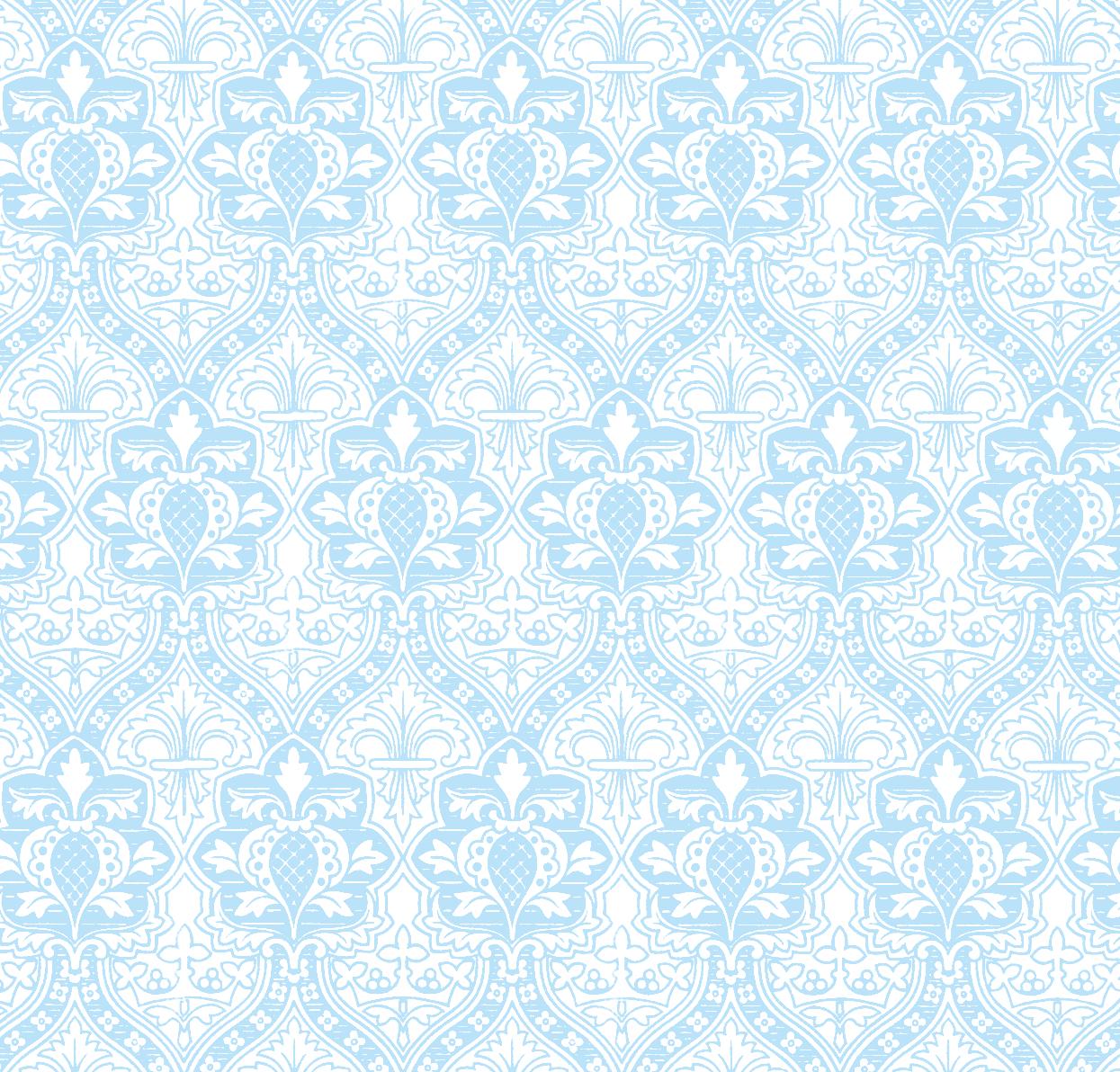
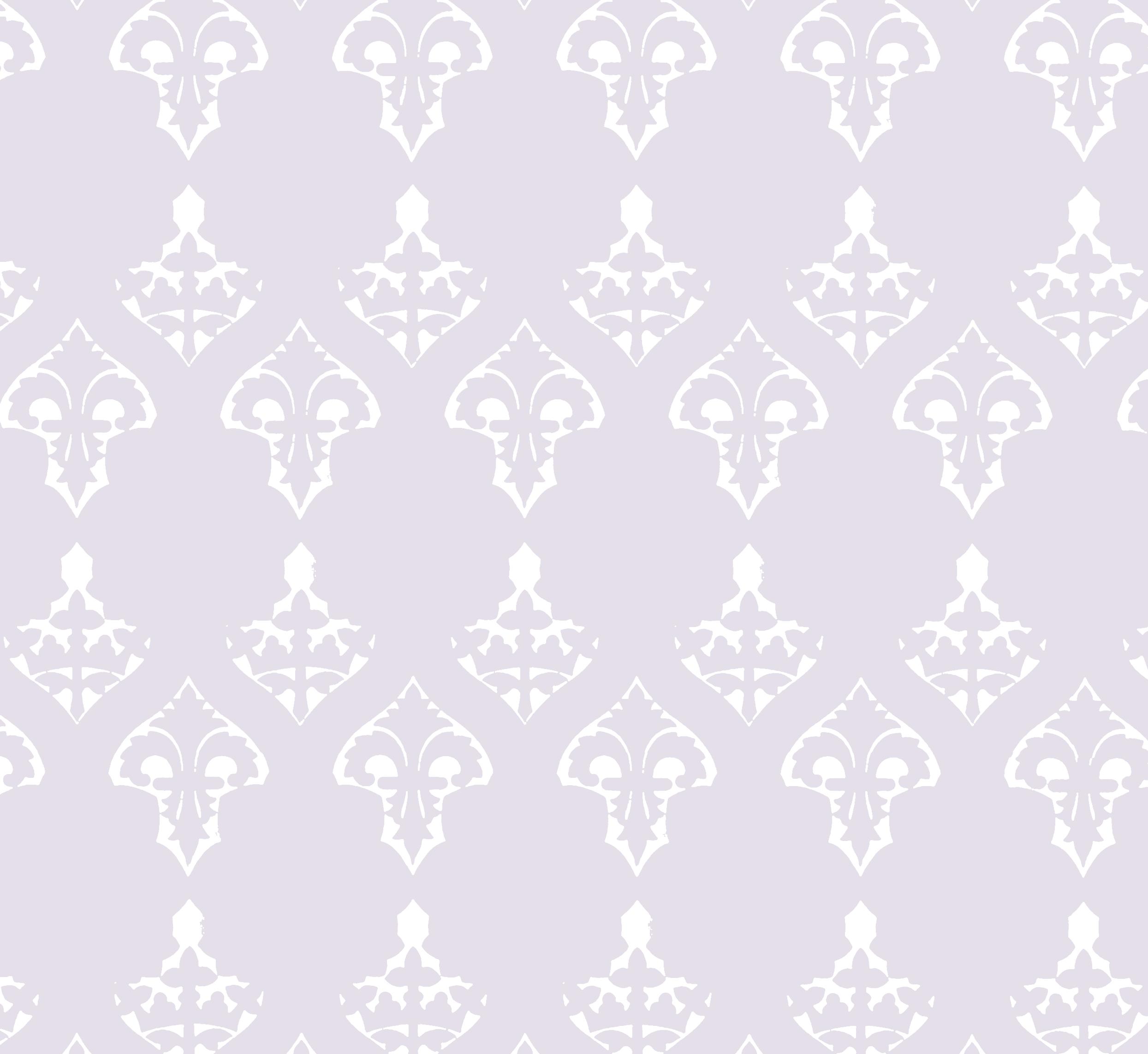

11

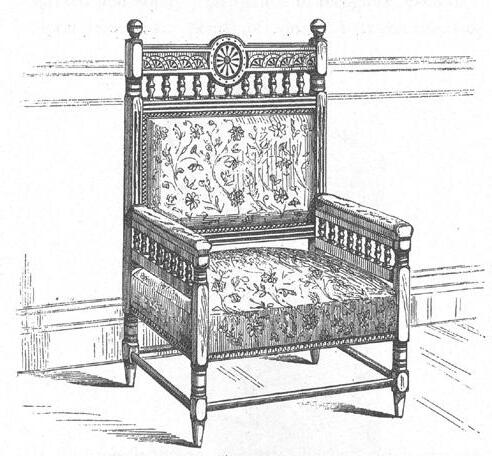
12
CHARLES LOCKE EASTLAKE (1836‑1906) (DESIGNER), JACKSON & GRAHAM (MAKER)
AESTHETIC MOVEMENT SETTEE, CIRCA 1878
ebonised and gilded mahogany, with later felt upholstery
150cm wide, 97cm high, 69cm deep
Literature: Eastlake, Charles L. Hints on Household Taste, Longmans, Green & Co., 1878, where a drawing for the matching armchair is illustrated.
Edwards C. The Firm of Jackson & Graham Furniture History Society, Vol. 34 (1998), pp. 238‑265
Note: One of the contributing factors to the prominence of Jackson & Graham among 19th‑century furniture makers was their employment of superior designers including Owen Jones, Bruce Talbert and Christopher Dresser. Some of Eastlake’s designs were made under licence by the firm, including this settee. Eastlake was not a commercial designer and earned his living as Keeper of the National Gallery.
£5,000‑8,000
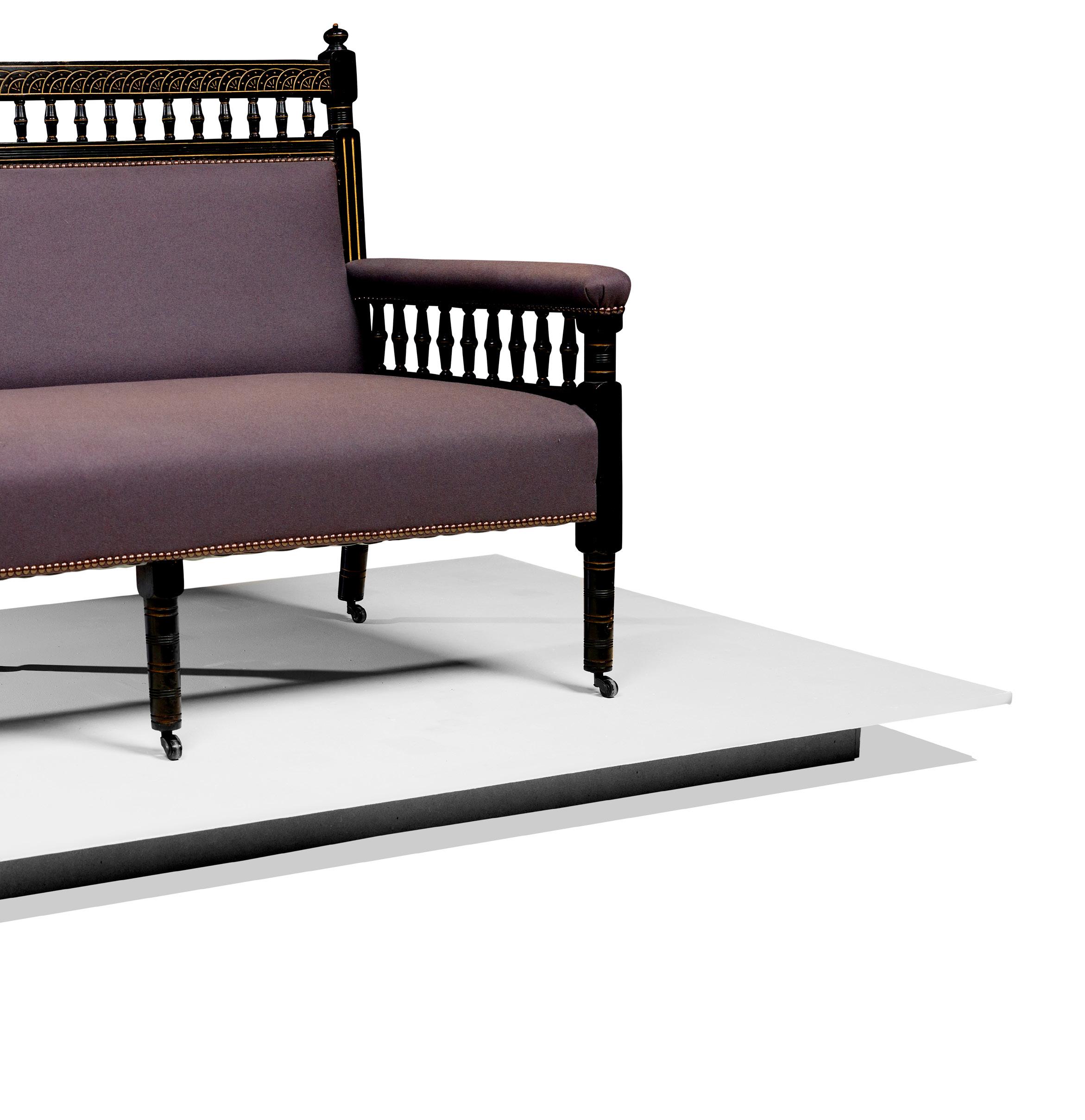
24
13 Other fees apply in addition to the hammer price: see the ‘Buyer’s Guide’ section on page 2
W. LAMBERT FOR HOWELL, JAMES & CO., LONDON
‘THE UNDERWORLD’
painted earthenware, later frame painted number verso 652 and later applied plaque
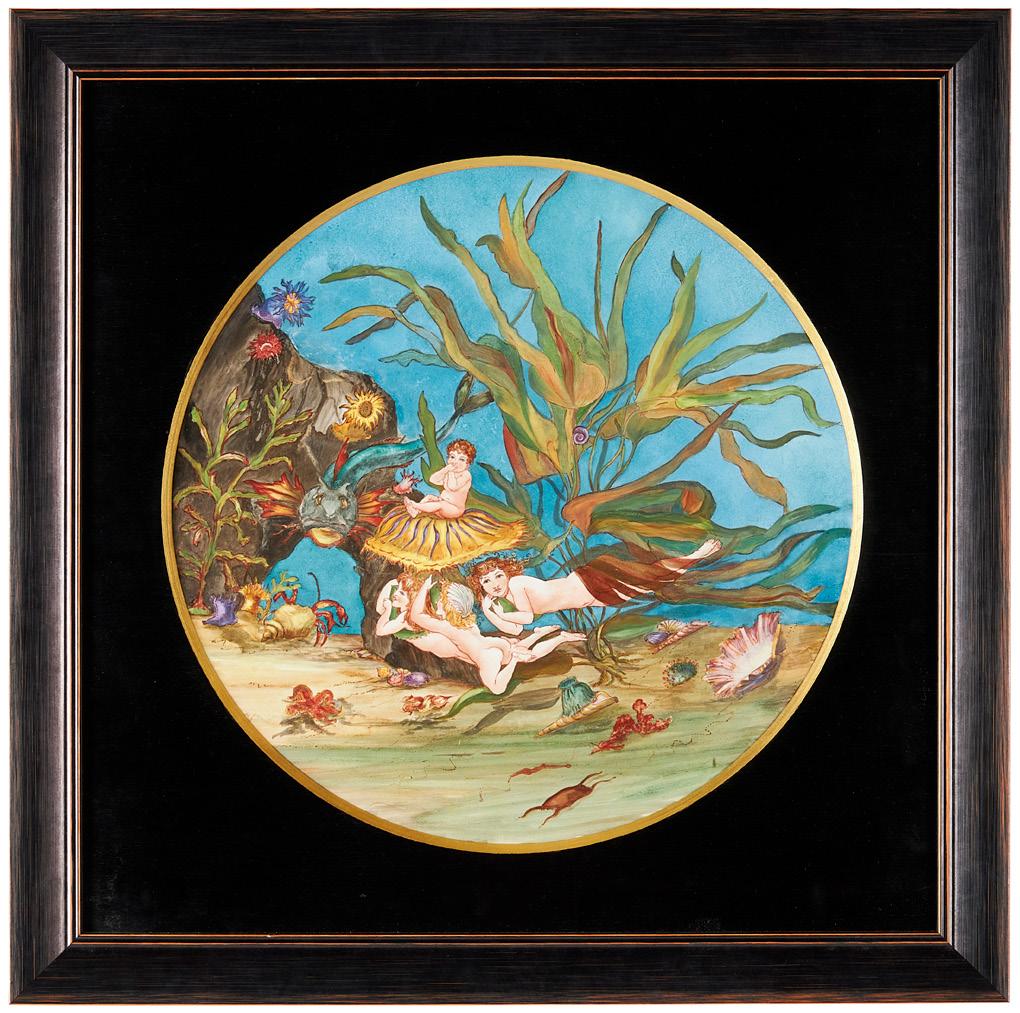
40cm diameter
£600‑800
26
MANNER OF COTTIER & CO.
AESTHETIC MOVEMENT STAINED GLASS PANEL, CIRCA 1880

stained, leaded and painted glass, mounted within a timber frame, glazed to each side
panel 121cm x 39, frame 140cm x 54.5cm
£500‑800
27
MANNER OF DANIEL COTTIER
AESTHETIC MOVEMENT
FIRESCREEN CIRCA 1880
ebonised and gilded wood, double‑sided framed and glazed embroidered silk panel, silk threads on a silk ground
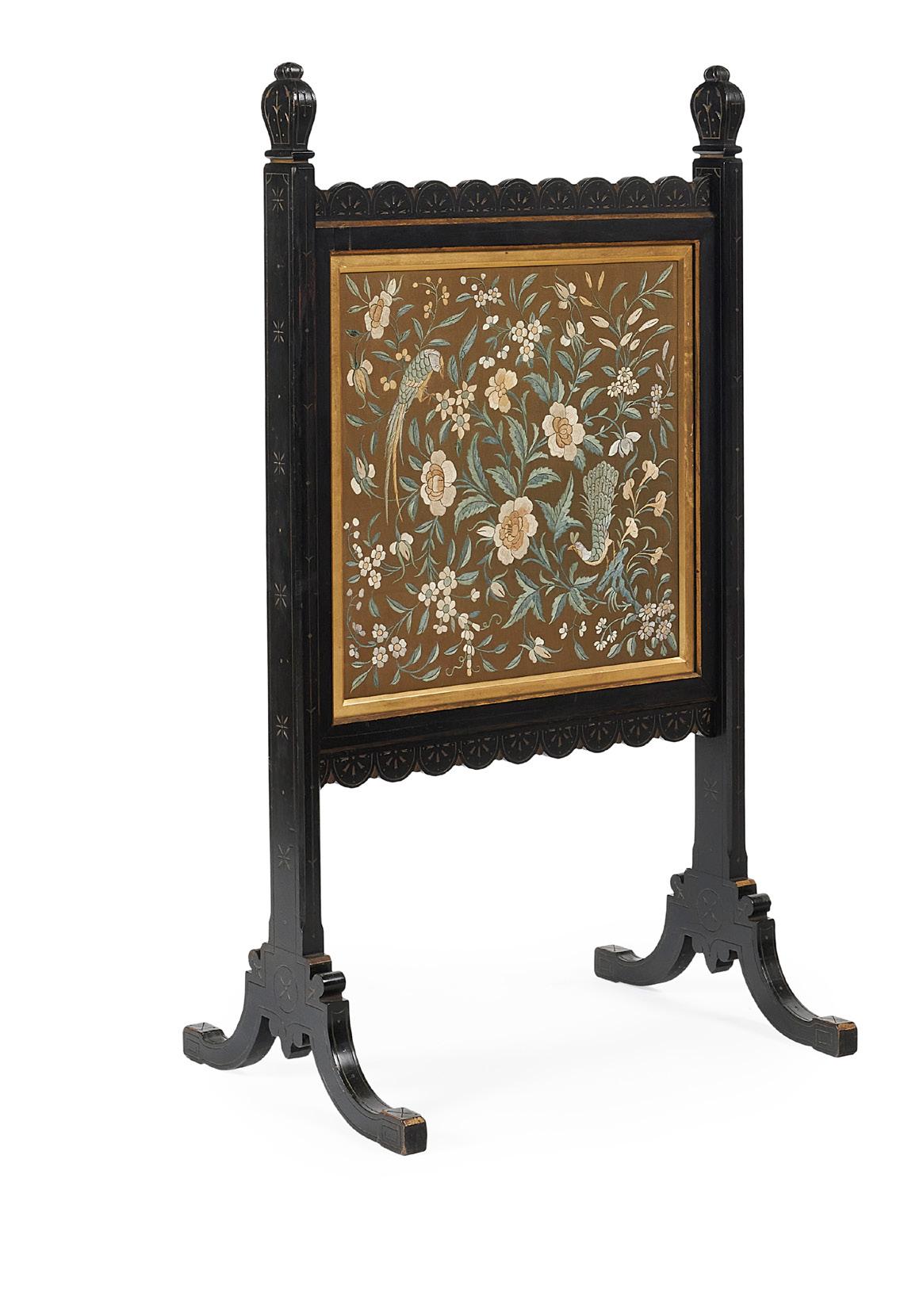
55.5cm wide, 101.5cm high, 41cm deep
£500‑800
28
BRUCE J. TALBERT (1838‑1881), POSSIBLY FOR GILLOW & CO.
AESTHETIC MOVEMENT
MUSIC CABINET, CIRCA 1870
oak, with brass fittings and glazed cupboard door
66cm wide, 110cm high, 44.5cm deep
£300‑500
25
14
29
DANIEL COTTIER (1837‑1891)
COURT CUPBOARD, CIRCA 1873
stained and carved oak, inset with gilded and painted panels, carved 1873 to frieze 184cm wide, 193cm high, 62cm deep


Literature: Cooper, J., Victorian & Edwardian Furniture & Interiors, Thames & Hudson, London, 1987, p.152, fig. 391 for a cabinet with similar carved decoration.
£1,500‑2,500

15 Other fees apply in addition to the hammer price: see the ‘Buyer’s Guide’ section on page 2
ENGLISH AESTHETIC MOVEMENT DISPLAY CABINET, CIRCA 1880 ebonised and gilded wood, with velvet‑lined interior 191cm wide, 191cm high, 48cm deep £800‑1,200

31 §

THOMAS JAMES CLIFF (1873‑1958) FOUR PANELS, CIRCA 1900 bronzed plaster, variously inscribed VER; AESTAS; AUCTUMNUS; HEMS, each signed T J CLIFF, framed each panel 15cm square, frame 21cm x 74cm £250‑350
MANNER OF WALTER CRANE EMBROIDERED PANEL, CIRCA 1910 coloured silks and wool on a lace ground, later framed and mounted
19.5cm x 119cm
£200‑300
ENGLISH PAIR OF CANDLESTICKS, CIRCA 1880 silver‑plate metal, with opalescent and enamelled glass shades, indistinctly marked to base (2)
42.5cm high
£300‑500
ENGLISH, MANNER OF A.W.N. PUGIN GOTHIC REVIVAL ARMCHAIR, CIRCA 1860 oak, with velvet upholstered arm rail 63cm wide, 74cm high, 59cm deep
£250‑350
30
32
33
34
16
GEORGE TINWORTH (1843‑1913)
FOR DOULTON & CO., LAMBETH
HAMAN LEADING MORDECAI
THROUGH THE STREETS OF PERSIA, DATED 1884
terracotta relief, within an ebonized wood and gilded frame, incised G. TINWORTH 1884/ DOULTON &CO/ LAMBETH, bearing an inscription from Psalms 2, Chapter 4 23cm x 56cm approx.
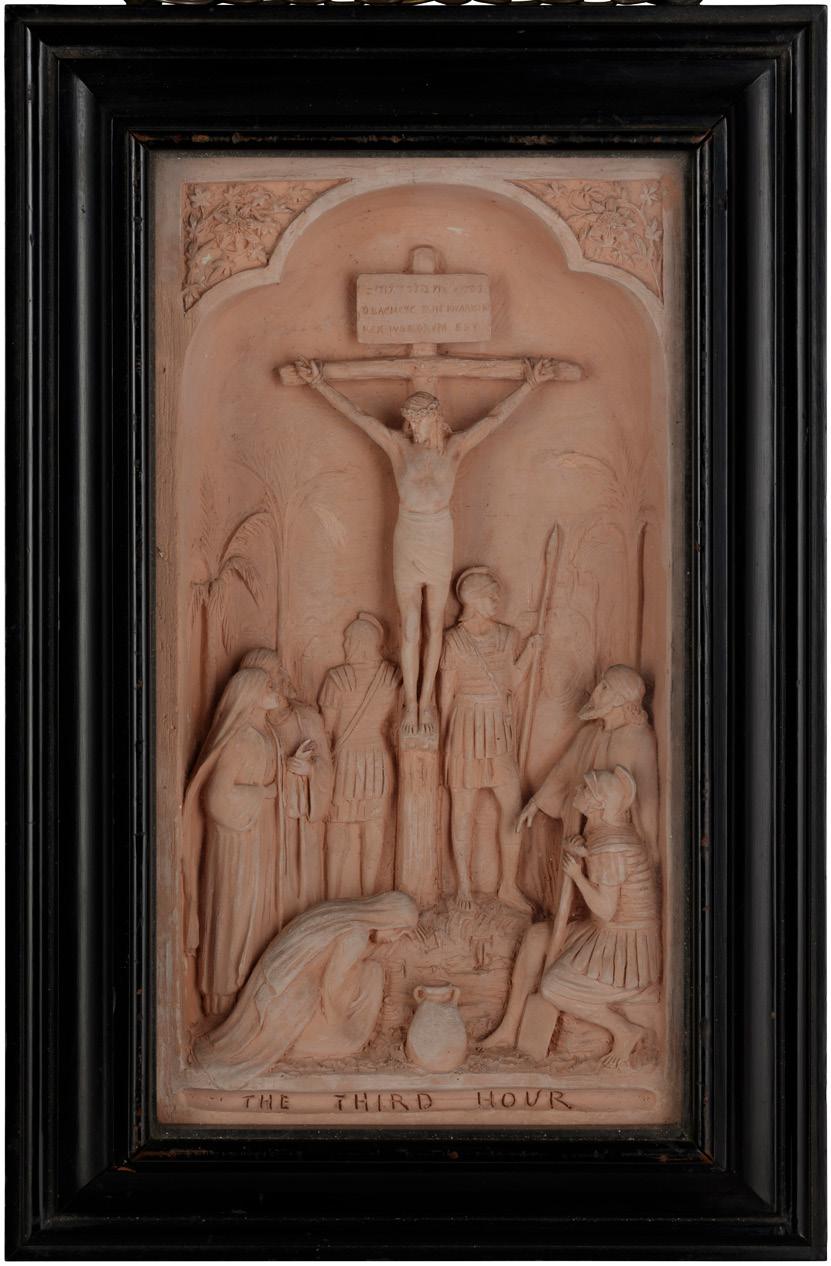

Literature: Rose P. George Tinworth: Harriman‑Judd Collection Volume 1, 1982, p. 171
Note: This terracotta panel of 1884 is based on the bible story in Esther Chapter VI. Haman is shown leading the King’s horse, with Mordecai seated on it, through the city street. Onlookers, attracted by Haman’s proclamation, appear from all directions displaying reactions of wonder, envy or gladness.
£800‑1,200 36
GEORGE TINWORTH (1843‑1913)
FOR DOULTON & CO., LAMBETH

THE THIRD HOUR, 1907
terracotta relief, within ebonised wood and gilded frame, incised THE THIRD HOUR 35cm x 19cm
Literature: Rose P. George Tinworth: Harriman‑Judd Collection Volume 1, 1982, pp. 185‑6
Note: This terracotta panel is one of a series of 14 panels started by Tinworth in 1902 and completed in 1907.
£300‑500
35
17
37

HOLLAND & SONS, LONDON
DISPLAY CABINET, CIRCA 1890

oak, with glazed doors and velvet‑lined interior, patinated metal fittings, opening to a fitted interior with tooled leather skiver, stamped to cupboard door HOLLAND & SONS/ MOUNT STREET/ LONDON
144cm wide, 189cm high, 46cm deep

Note: For a desk by Holland & Sons with similar characteristics see Sotheby’s, London The Best of British: Design from the 19th and 20th Centuries, 20th March 2008, Lot 106.
£3,000‑5,000
18 Other fees apply in addition to the hammer price: see the ‘Buyer’s Guide’ section on page 2
ENGLISH, MANNER OF BRUCE TALBERT PAIR OF AESTHETIC MOVEMENT CANDLE SCONCES, CIRCA 1880

embossed and cast brass (2)
38.5cm x 23cm
£600‑800
39
ENGLISH AESTHETIC MOVEMENT TABLE CLOCK, CIRCA 1870 the twin‑train movement with engraved brass dial, within carved mahogany case with brass fittings with handle 42cm high £1,000‑1,500
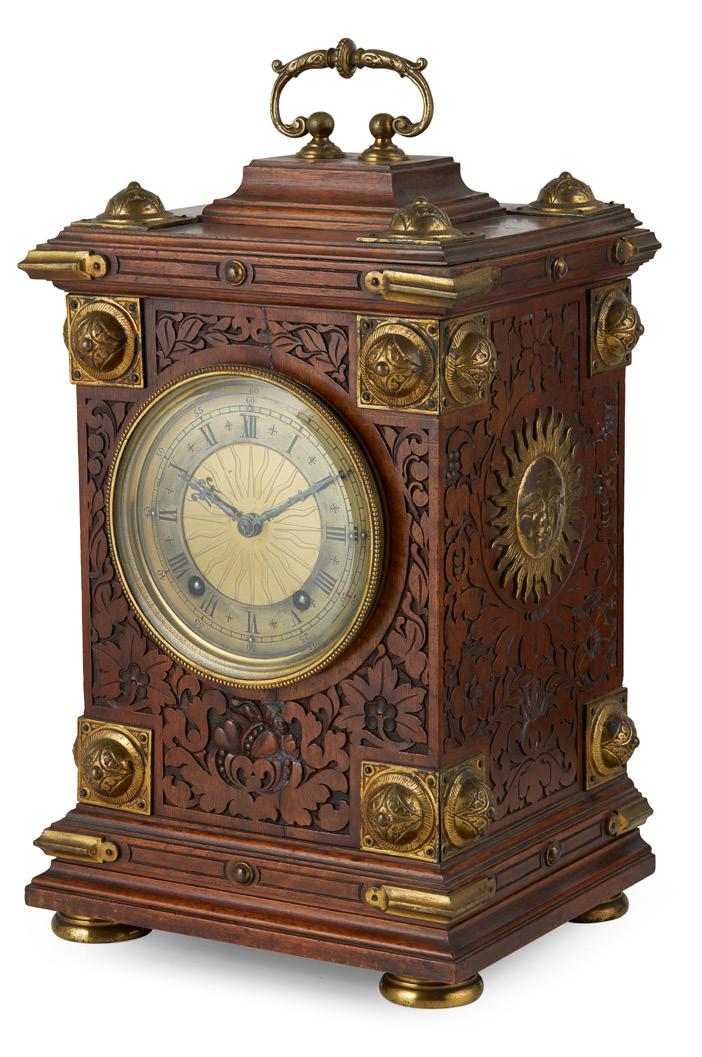
40
WILLIAM STEPHEN COLEMAN (1829‑1904) FOR MINTON & CO.
AESTHETIC MOVEMENT TILE, 1870

glazed earthenware, moulded maker’s marks and date lozenge, printed maker’s marks, 20.7cm square; together with THREE BROWN ‑ WESTHEAD, MOORE & CO. TILES, the designs attributed to Pierre Mallet, moulded maker’s marks, 20.2cm square (4)
£300‑500
41
ENGLISH, MANNER OF WILLIAM BURGES GOTHIC REVIVAL FIRE GRATE, CIRCA 1860 cast iron and ceramic fire brick 86cm wide, 54cm high, 46cm deep
£500‑800

38
19
HENRY HOLIDAY (1839‑1927)
STUDY FOR THE FIGURE OF VIRTUE black and white chalk on buff paper 50cm x 25cm

Provenance: Moss Gallery, London
Note: This study is thought to be for the stained glass window Henry Holiday designed for St. Salvator’s Chapel in St. Andrews. The window he provided for St Salvator’s is in the pre‑Raphaelite style popularised by Morris & Co. Commissioned as a memorial to Principal Shairp, the window bears the figures of Virtue, Faith and Knowledge of which the current lot is a study for the figure of Virtue.
£600‑800
AFTER SIR EDWARD BURNE‑JONES
DAYS OF CREATION, DAY ONE AND DAY FIVE, CIRCA 1900
fine pyrography and ink on timber, later framed (2) 65cm x 24cm
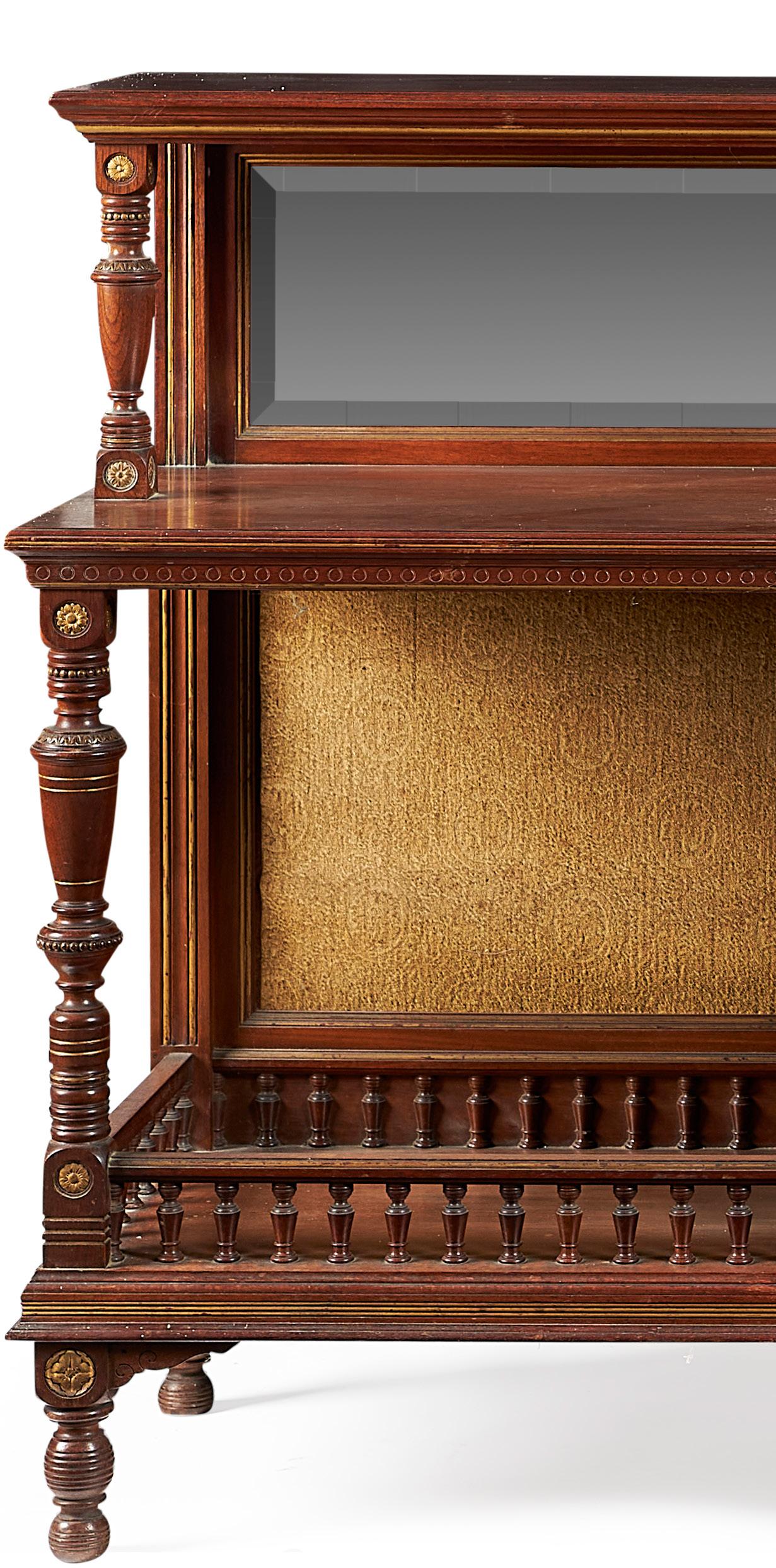
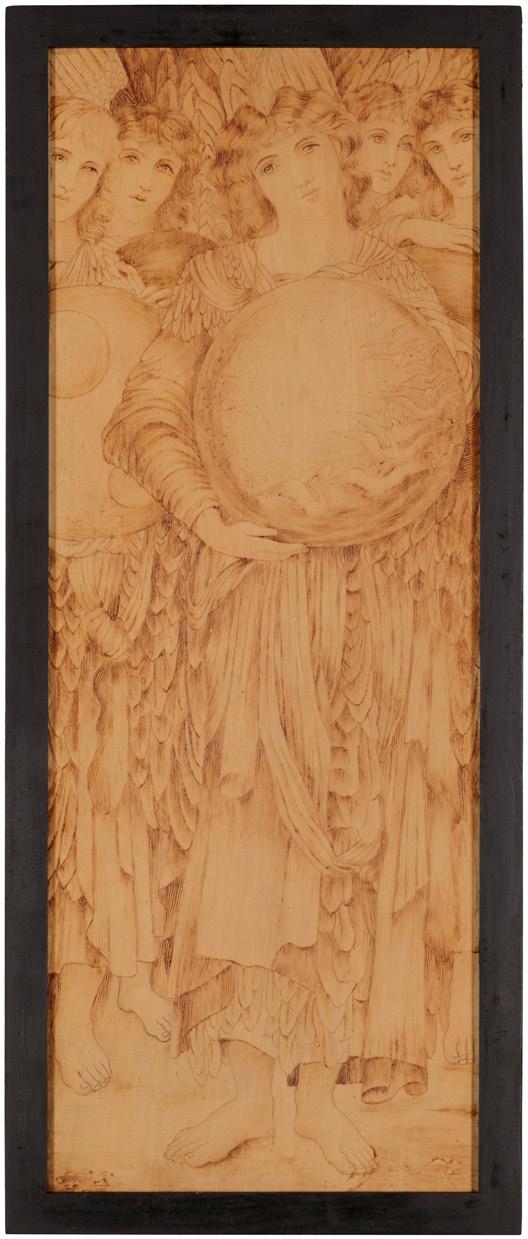
£600‑800

43
42
20
COLLINSON & LOCK, LONDON
AESTHETIC MOVEMENT DRAWING
ROOM CABINET, CIRCA 1880
mahogany with gilded highlights, inset with a painted panel after Walter Crane, embossed velvet panels and mirrored glass
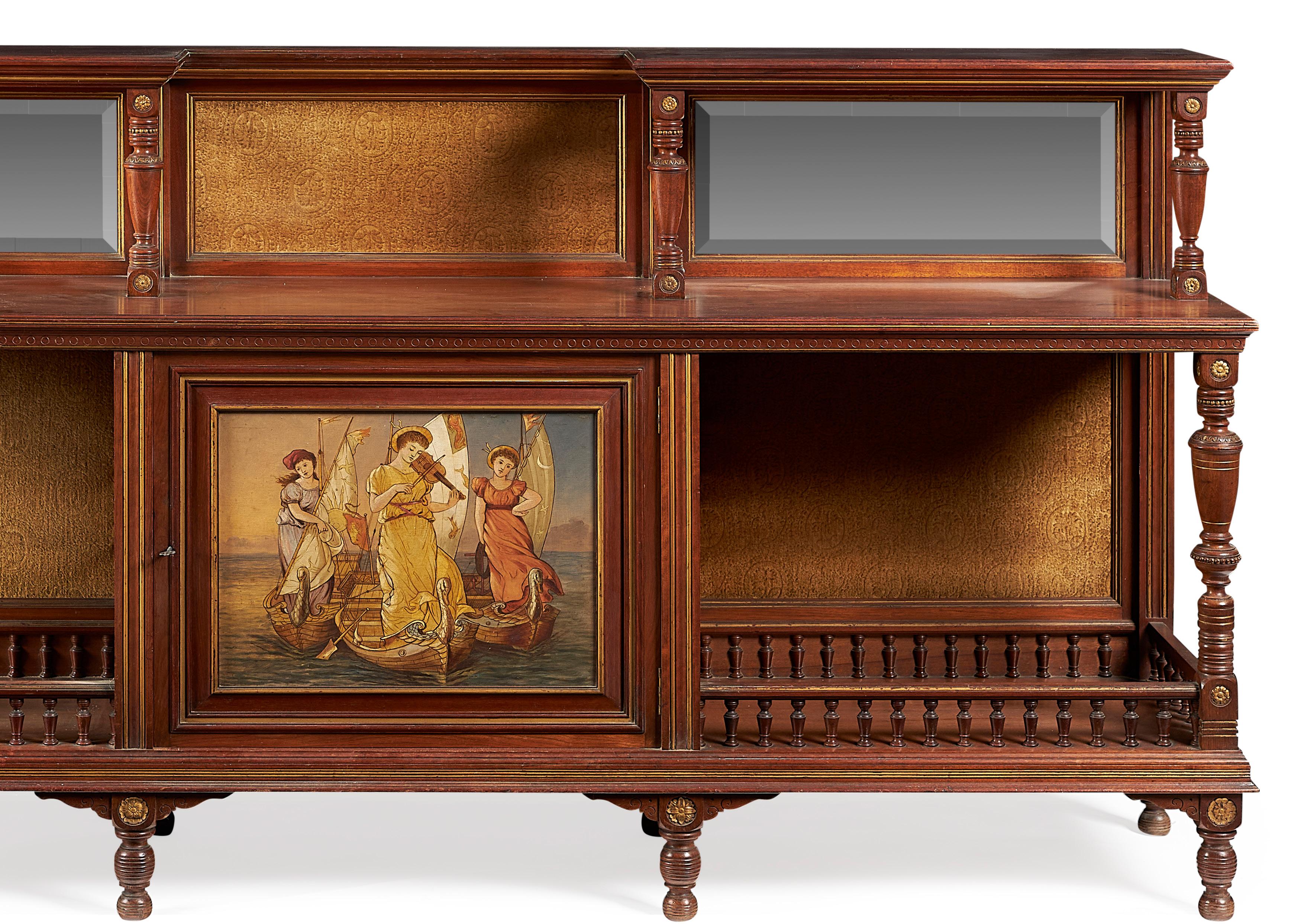
203.5cm wide, 107cm high, 41.5cm deep
Note: The central painted panel in this cabinet is based on I saw three ships by Walter Crane (1845‑1915), the original illustration appeared in Baby’s Opera published by Messrs. George Routledge & Sons, Ltd. in 1877.
£800‑1,200
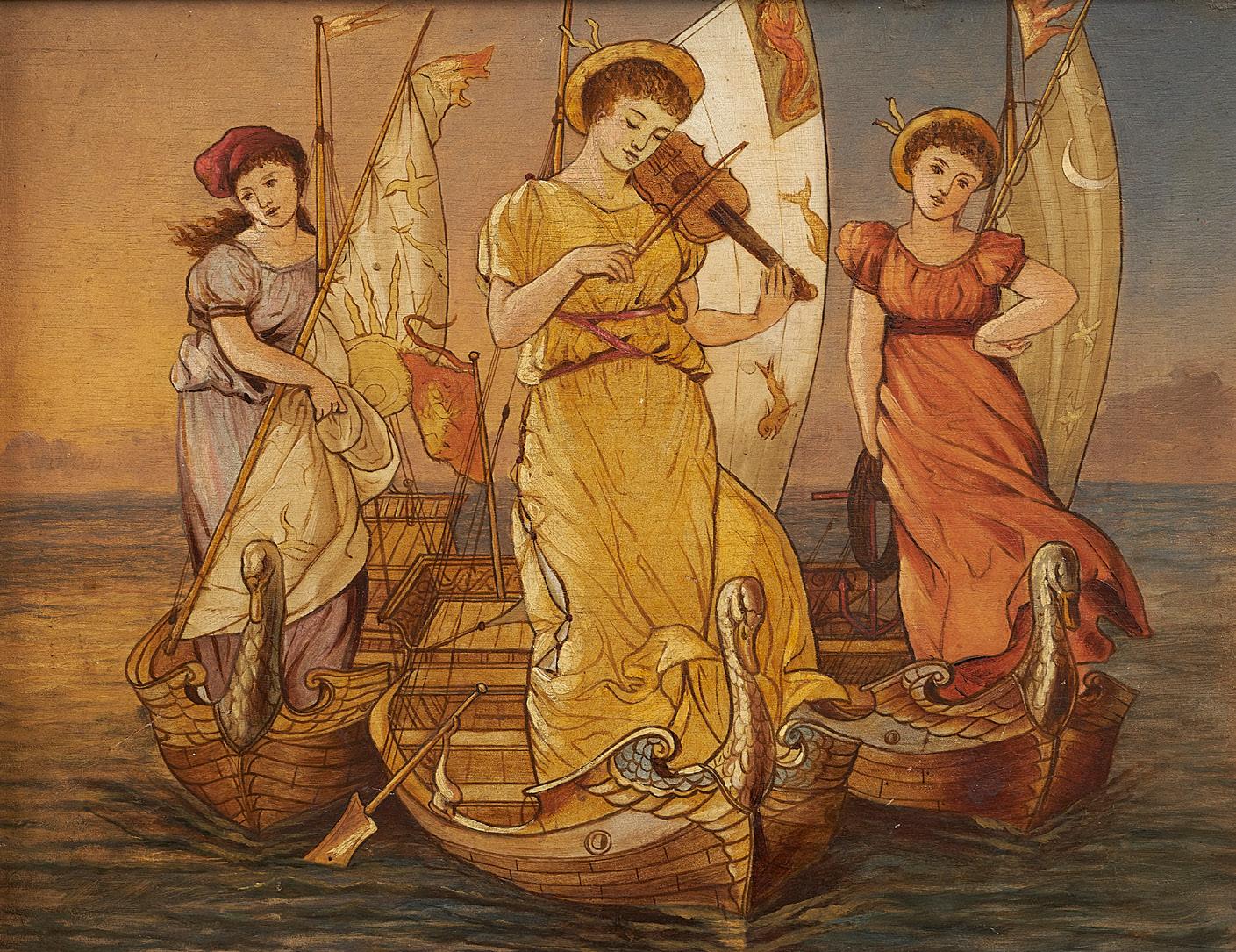
44
21 Other fees apply in addition to the hammer price: see the ‘Buyer’s Guide’ section on page 2
45
LEWIS FOREMAN DAY (1845‑1910) FOR HOWELL & JAMES, LONDON
AESTHETIC MOVEMENT MANTEL CLOCK, CIRCA 1880

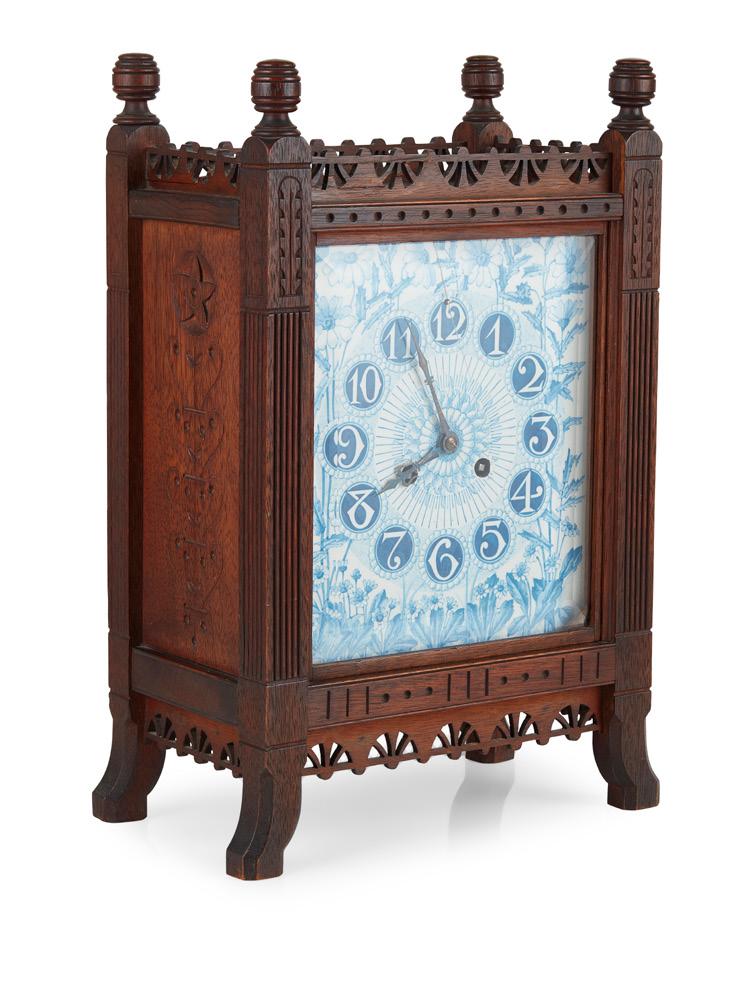
painted porcelain dial, within carved and pierced mahogany case
24.2cm wide, 36cm high, 13.7cm deep
Literature: For an almost identical clock marked ‘Howell & James’, please see V&A collection, accession no. CIRC.662‑1972
Note: Lewis Day was a teacher and prolific designer within the South Kensington circle, whose books frequently included Japanese examples. Although the design elements of this clock do not conform to traditional Japanese decoration, they would have suggested the Japanese taste to Day’s contemporaries in Britain.
£300‑500
46
MINTON & CO.
GROUP OF EIGHT AESTHETIC MOVEMENT TILES, CIRCA 1880 painted and glazed earthenware, moulded factory marks verso painted monogram TS 0169/11/131 (8)
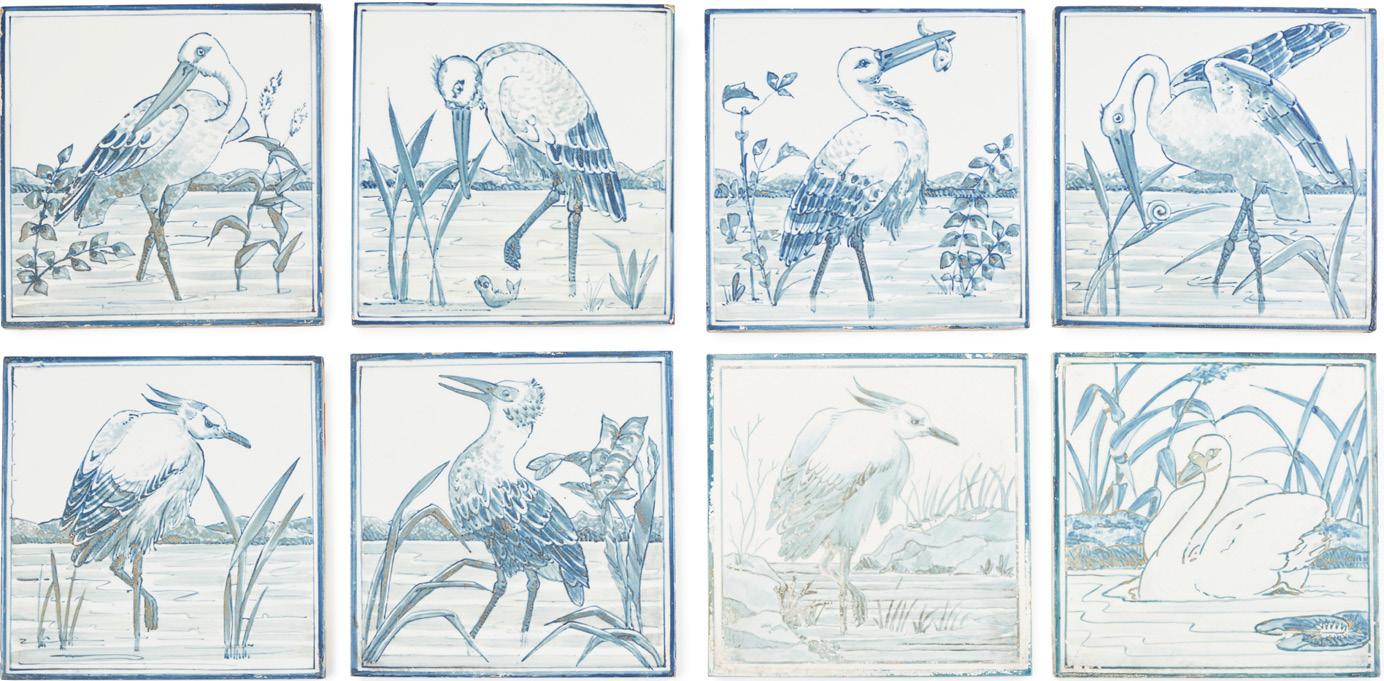

15.5cm square
£500‑800
47
ENGLISH, MANNER OF THE CENTURY GUILD SIDE TABLE, CIRCA 1900


mahogany, inset with woven silk panel
75.5cm wide, 72cm high, 50cm deep
£600‑800
22
WILLIAM EDEN NESFIELD (1835‑1888) (DESIGNER), JAMES FORSYTH (1827‑1910) (MAKER)
AESTHETIC MOVEMENT HALL SETTLE, CIRCA 1868
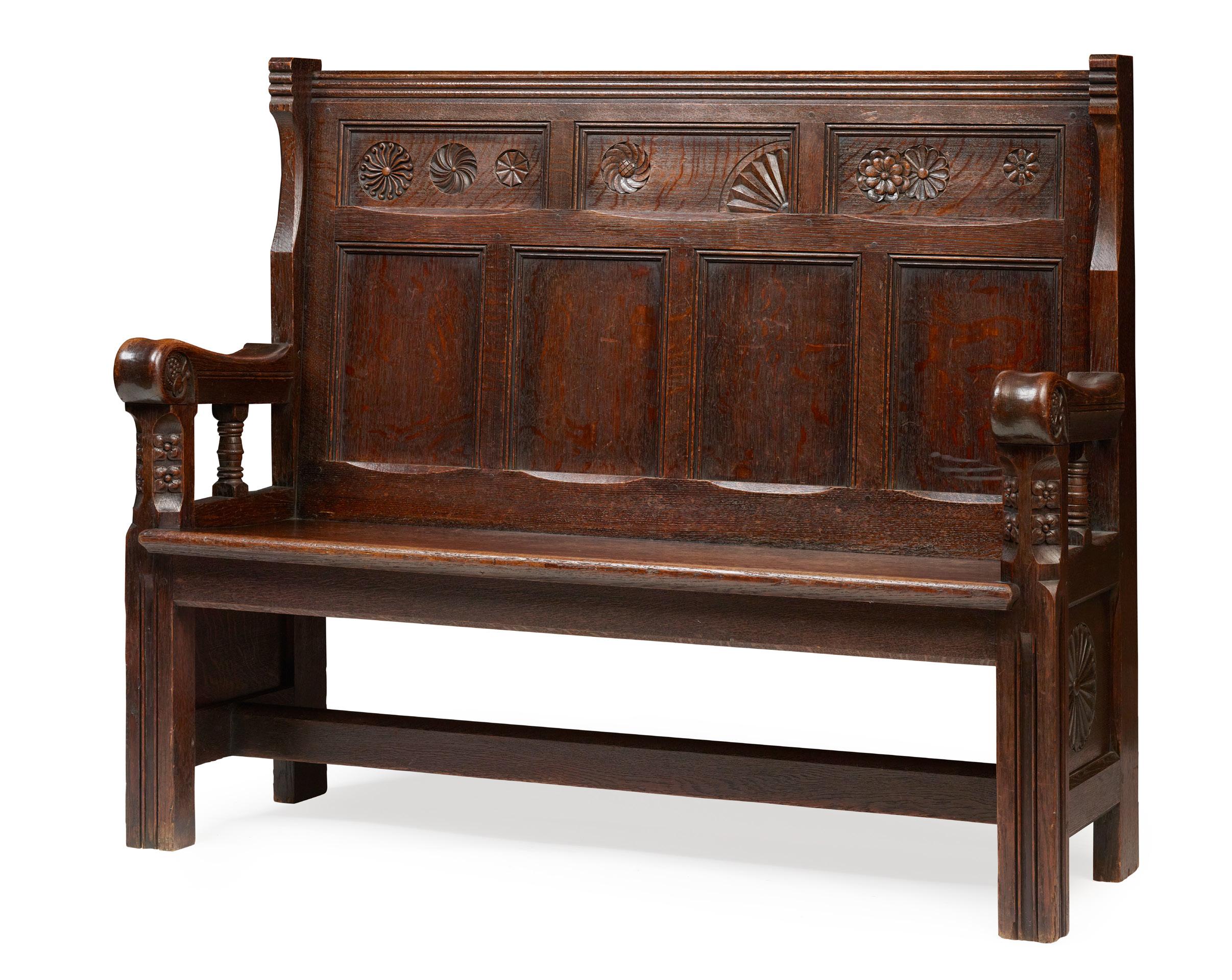
oak
129cm wide, 110cm high, 49cm deep £1,000‑1,500
Provenance: Designed for Henry Vallance, Farnham Park, Farnham Royal, Buckinghamshire (contents sold 1905)
John Bevill Fortescue, Dropmore Park, Burnham, Buckinghamshire
James Gomer Berry, 1st Viscount Kemsley, Dropmore Park, Burnham, Buckinghamshire
Sold Sotheby’s, 18th March 1969, ‘The Valuable Contents of Dropmore’
Holloway Auctioneers, Banbury, Oxfordshire, 2nd December 2014, lot 526
Literature: Eastlake C.L. History of the Gothic Revival, 1872, where an in‑situ line drawing is illustrated.
Cooper, J., Victorian & Edwardian Furniture & Interiors, Thames & Hudson, London, 1987, p. 133, pl. 304 where the above line drawing is also illustrated; and p. 134, pl. 306 where the comparable settle at Cragside is illustrated (in a painting by H.H. Emmerson).
Note: Nesfield designed a similar pair of settles for the dining room at Cragside, William George Armstrong’s country house in Rothbury, Northumberland, which he extended, with Richard Norman Shaw, in 1870‑1872. These are the only other settles of this style known to have been made.
48
23 Other fees apply in addition to the hammer price: see the ‘Buyer’s Guide’ section on page 2
ENGLISH
AESTHETIC MOVEMENT BRASS CANDLE SCONCE, CIRCA 1890
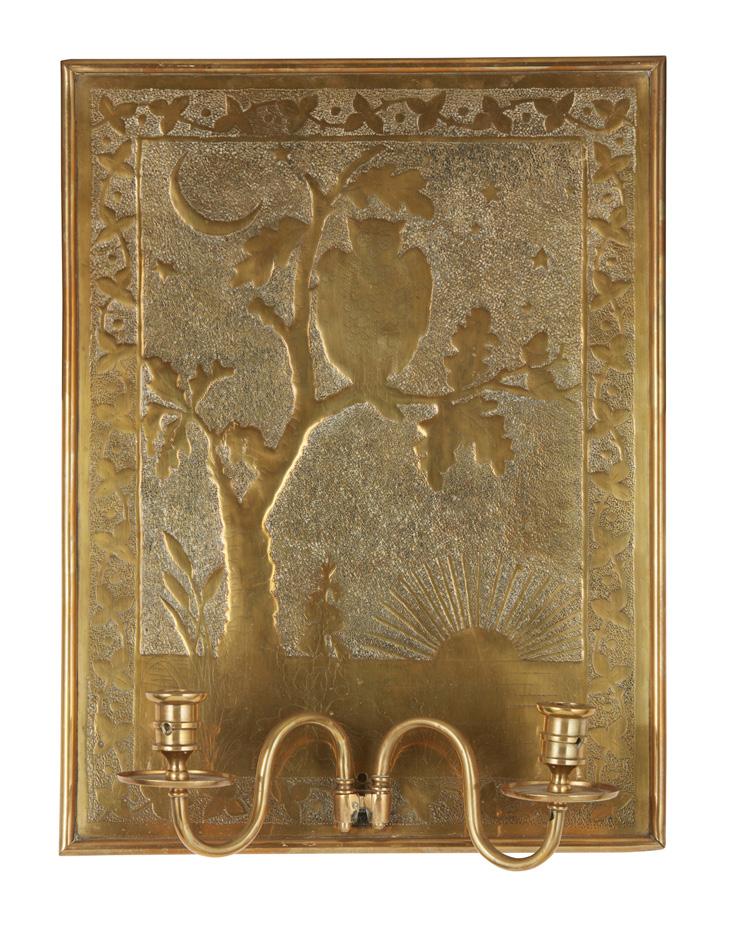
embossed and cast brass
41cm x 31cm
£300‑500
50
JAMES POWELL & SONS, WHITEFRIARS
THREE LIQUEUR GLASSES, CIRCA 1906
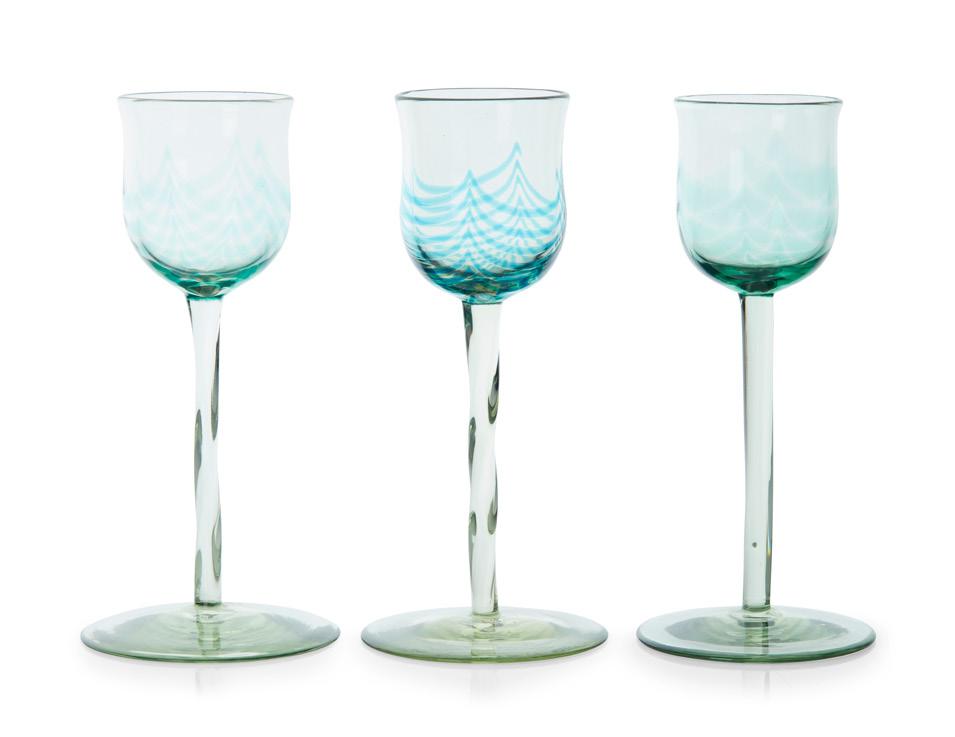
pale green glass with pulled decoration (3)
12cm high
Note: Probably part of the service made for the Italian diplomat Count Minerbi in 1906
£200‑300
51
ENGLISH
AESTHETIC MOVEMENT FIREPLACE, CIRCA 1871
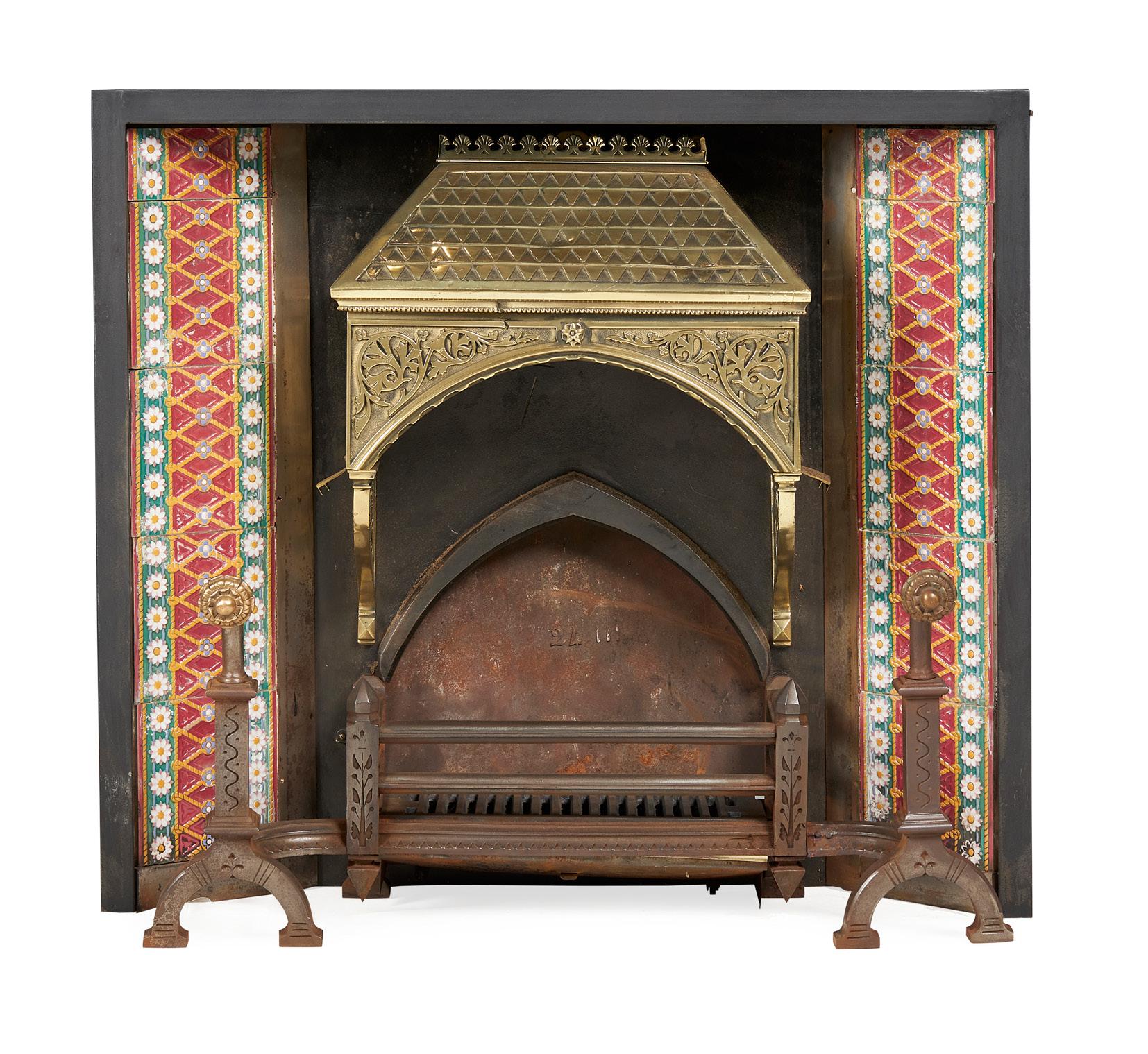
cast iron, cast brass, inset with glazed earthenware tiles, with cast registration lozenge (twice) for 1871
External 108.5cm wide, 97.5cm high; grate 99cm wide, 44cm high, 43cm deep
£700‑1,000
52
FREDERICK HOLLYER (1838‑1933) AFTER GEORGE FREDERIC WATTS
‘HOPE’, print, hand coloured with watercolour, framed 42cm x 34.5cm
£300‑500
49
24
AESTHETIC MOVEMENT
THE MESSAGE
pen and ink, framed 40cm x 20cm
£300‑500
54
S. GIBBS & MOORE, LONDON
TWO RARE FRAMED TILE PANELS, CIRCA 1880
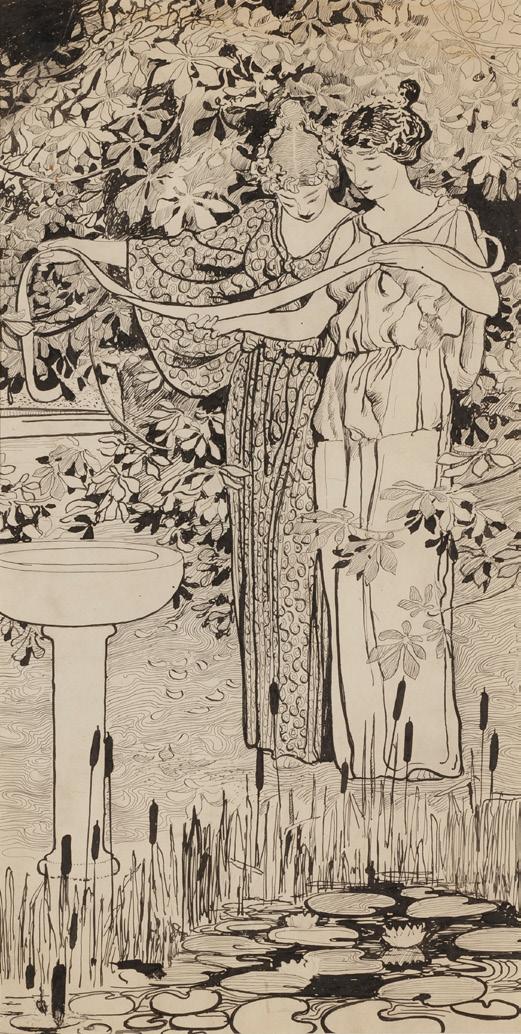
hand‑painted on Minton blanks, depicting stylised birds and fish, moulded Minton marks and stamped maker’s marks to each (2) each tile 15.5cm square, framed 20cm x 51cm
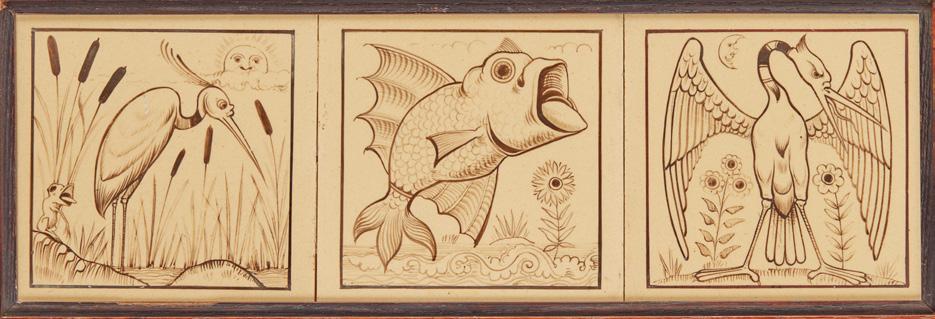
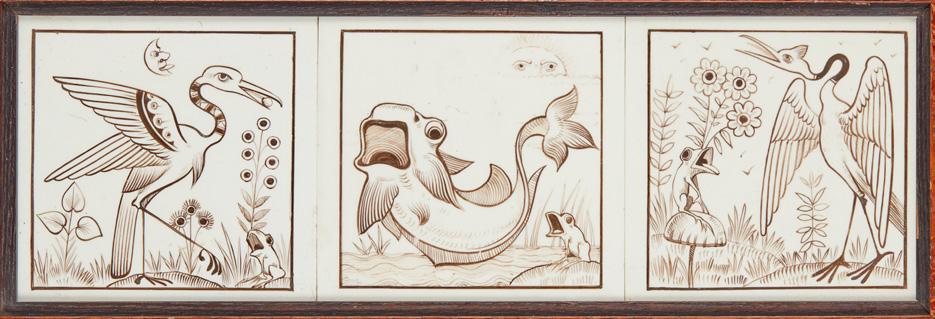
£500‑800
55
ENGLISH AESTHETIC MOVEMENT FREESTANDING
BUREAU CABINET, CIRCA 1875
oak, marquetry inlaid with burr oak, the drop‑down fall enclosing a fitted interior, with tooled leather skiver

96.5cm wide, 111cm high, 45cm deep
£800‑1,200
53
25 Other fees apply in addition to the hammer price: see the ‘Buyer’s Guide’ section on page 2
ENGLISH
AESTHETIC MOVEMENT HALL TABLE CLOCK, CIRCA 1880
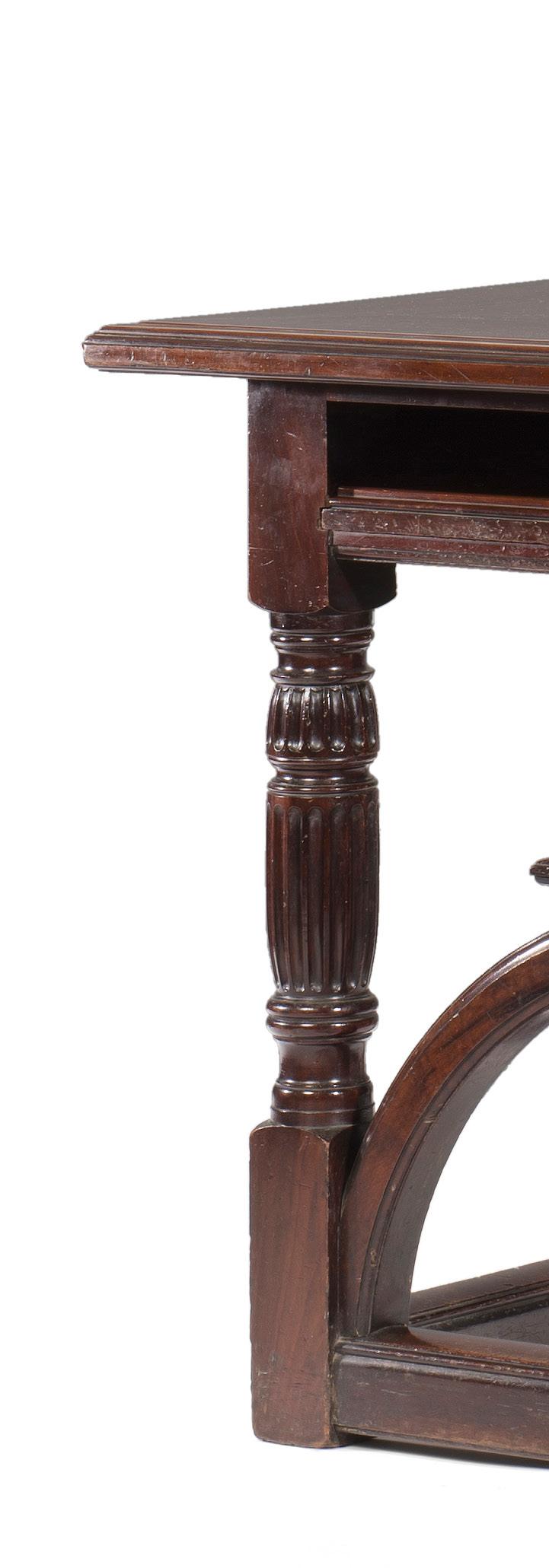
glazed earthenware dial within an oak case, fitted with a brass letterbox

18cm wide, 48cm high, 15.5cm deep £800‑1,200
57
WILLIAM TONKS & SONS, MANNER OF THOMAS JECKYLL
GROUP OF AESTHETIC MOVEMENT DOOR
FURNITURE, CIRCA 1880
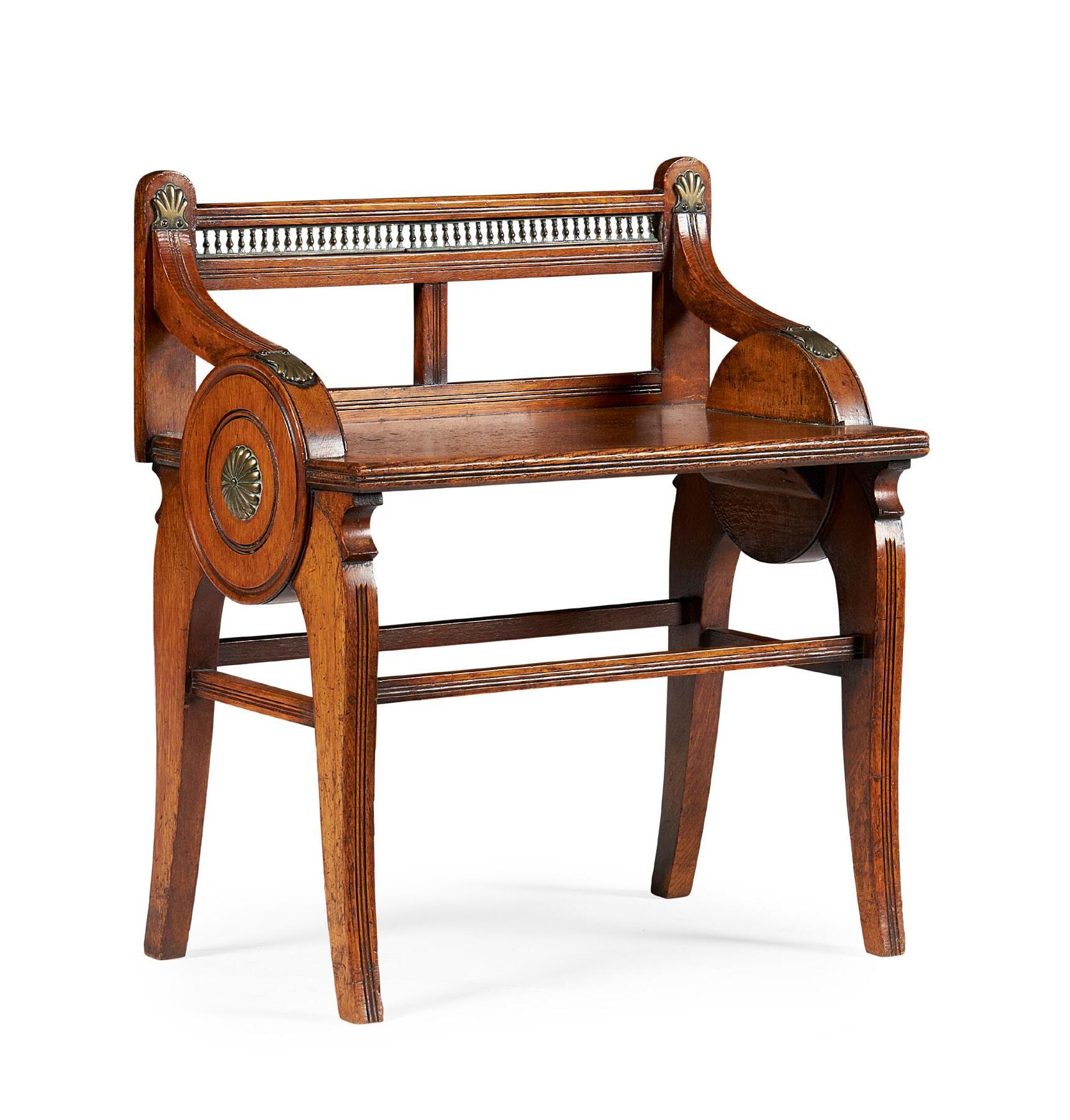
comprising FOUR FINGERPLATES, 28cm long; FOUR DOOR HANDLES, 5.5cm diameter; and FOUR ESCUTCHEONS, 6cm long, fingerplates with stamped manufacturer’s mark WT&S (12) £400‑600

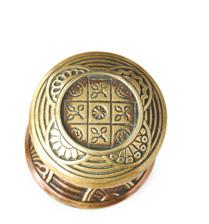

58
JAMES SHOOLBRED & CO.
AESTHETIC MOVEMENT STOOL, 1883
oak, with brass mounts, stamped Victorian lozenge mark (twice) for 1883
55cm wide, 61cm high, 30cm deep £600‑800
56
26 Other fees apply in addition to the hammer price: see the ‘Buyer’s Guide’ section on page 2
GEORGE FAULKNER ARMITAGE (1849‑1937) FOR THE FINE ART SOCIETY, LONDON DRAWING, PRINT AND FOLIO TABLE, 1888
mahogany
153cm long, 76cm high, 92cm deep
Provenance: Acquired by The Fine Art Society directly from George Faulkner Armitage in 1888 as part of an overall scheme by the designer for the Entrance Gallery at 148 New Bond Street.
Exhibited: Huddersfield, Huddersfield Technical School, Fine Art and Industrial Exhibition, 1883.
Literature: The Cabinet Maker & Art Furnisher, 1 September 1883, vol. IV, p.42, illus.The Editor, ‘Pen & Ink Notes’
The British Architect, 2 January 1891, p.5 Illustrated in a drawing by T. Raffles Davison published as ‘Rambling Drawing no.171’, ‘The Fine Art Society’s Gallery Anteroom’ £10,000‑15,000
Note: Armitage started his career as a woodcarver and his workshop and design studio were in his home, Stamford House. Carvers in his studio in the 1880s included Arthur Simpson (1857‑1922) who later set up his own studio in Kendal. In 1888 Armitage was commissioned to remodel the front section of the interior of The Fine Art Society, the front of its New Bond Street building having been remodelled in 1881 by E. W. Godwin. The walls were panelled in mahogany and the commission also included furniture, of which the current lot was prominently featured in the scheme.

59
27

28
60
E. W. GODWIN (1833‑1886), PROBABLY MADE BY WILLIAM WATT
AESTHETIC MOVEMENT HANGING CORNER CABINET, CIRCA 1872
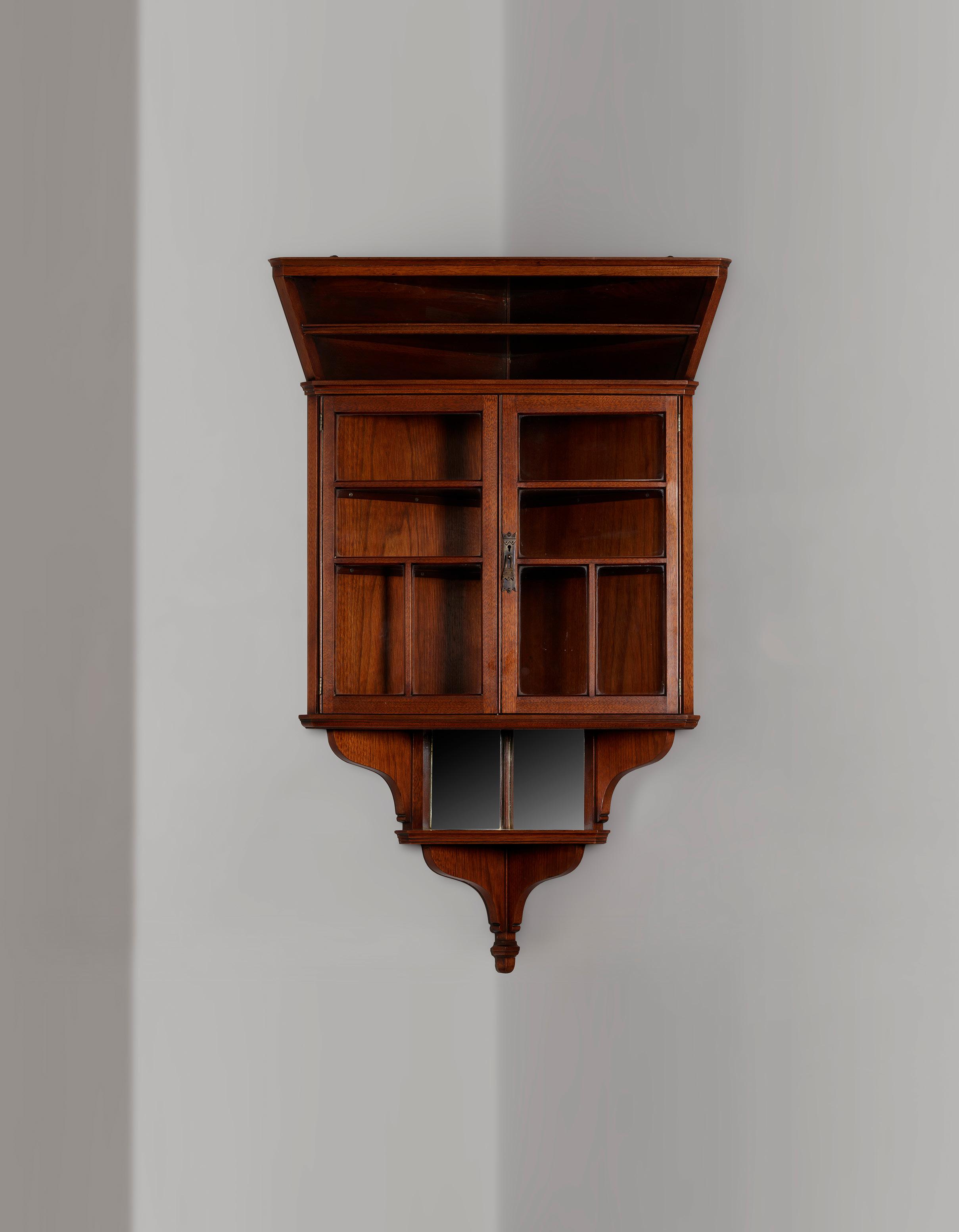
mahogany, mirrored glass with patinated brass fitting 69cm wide, 108cm high, 36cm deep
Literature: Soros, Susan Weber, The Secular Furniture of E.W. Godwin, New York, 1999, p. 203, pl. 324.
Note: The original drawing by Godwin for an identical cabinet, with an additional shelf on top, dated November 1872, is in the collection of the Victoria & Albert Museum, London (PD E.229‑1963, fol. 75).
£5,000‑8,000
29
61
ENGLISH, MANNER OF E. W. GODWIN
AESTHETIC MOVEMENT HANGING WALL SHELVES, CIRCA 1890
mahogany with bevelled glass panel and mirrored back 56cm wide, 76.5cm high, 18cm deep
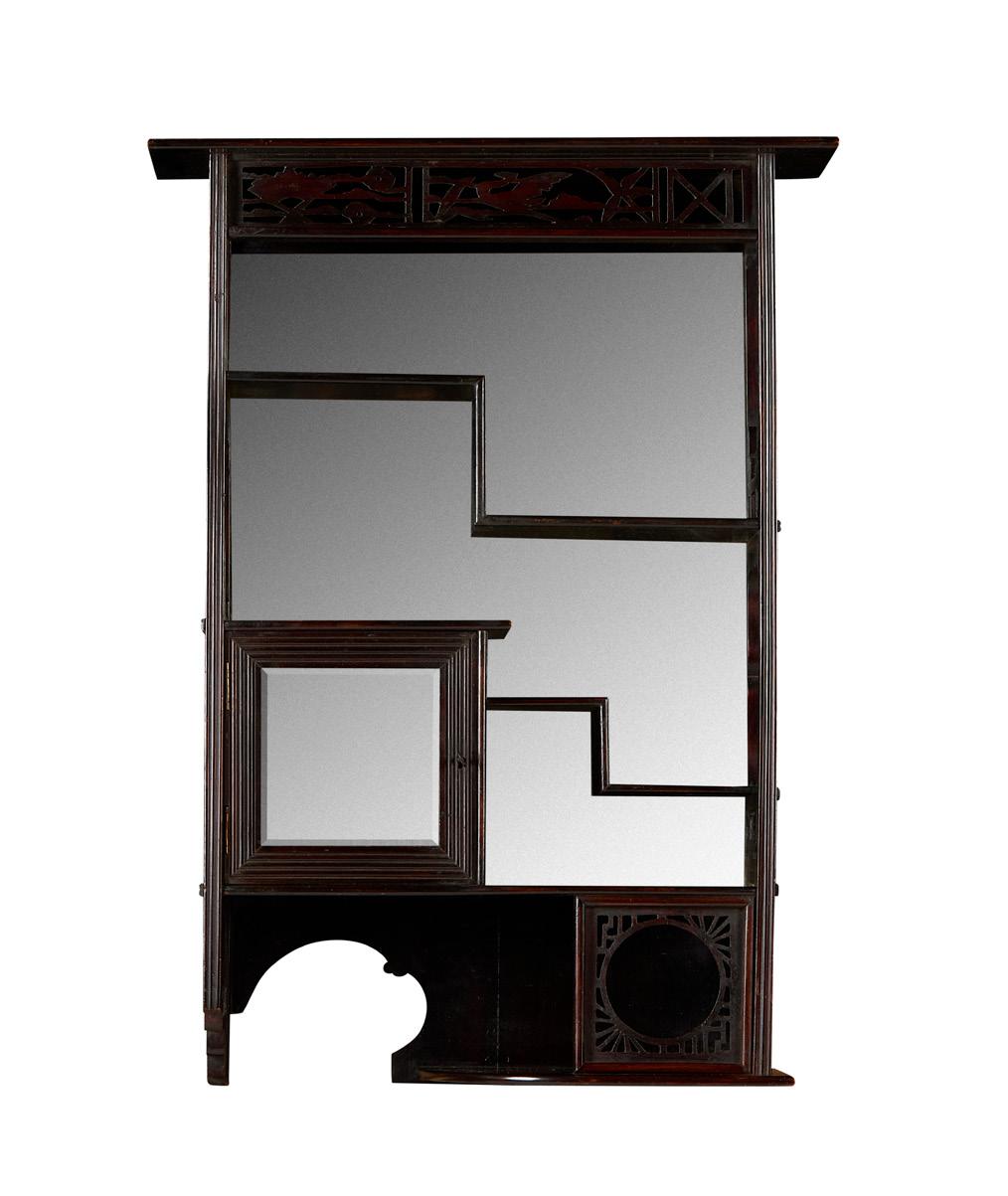
£400‑600
62
MINTONS LTD
AESTHETIC MOVEMENT PLATE, CIRCA 1890

painted and glazed earthenware, impressed MINTON 25cm diameter
£200‑300
63
E. W. GODWIN (1833‑1886)
AESTHETIC MOVEMENT
‘JACOBEAN’ ARMCHAIR, CIRCA 1880
ebonised wood with later upholstered seat

52cm wide, 88cm high, 51cm deep £400‑600
64
AFTER E. W. GODWIN
AESTHETIC MOVEMENT ‘COFFEE’ TABLE, CIRCA 1880
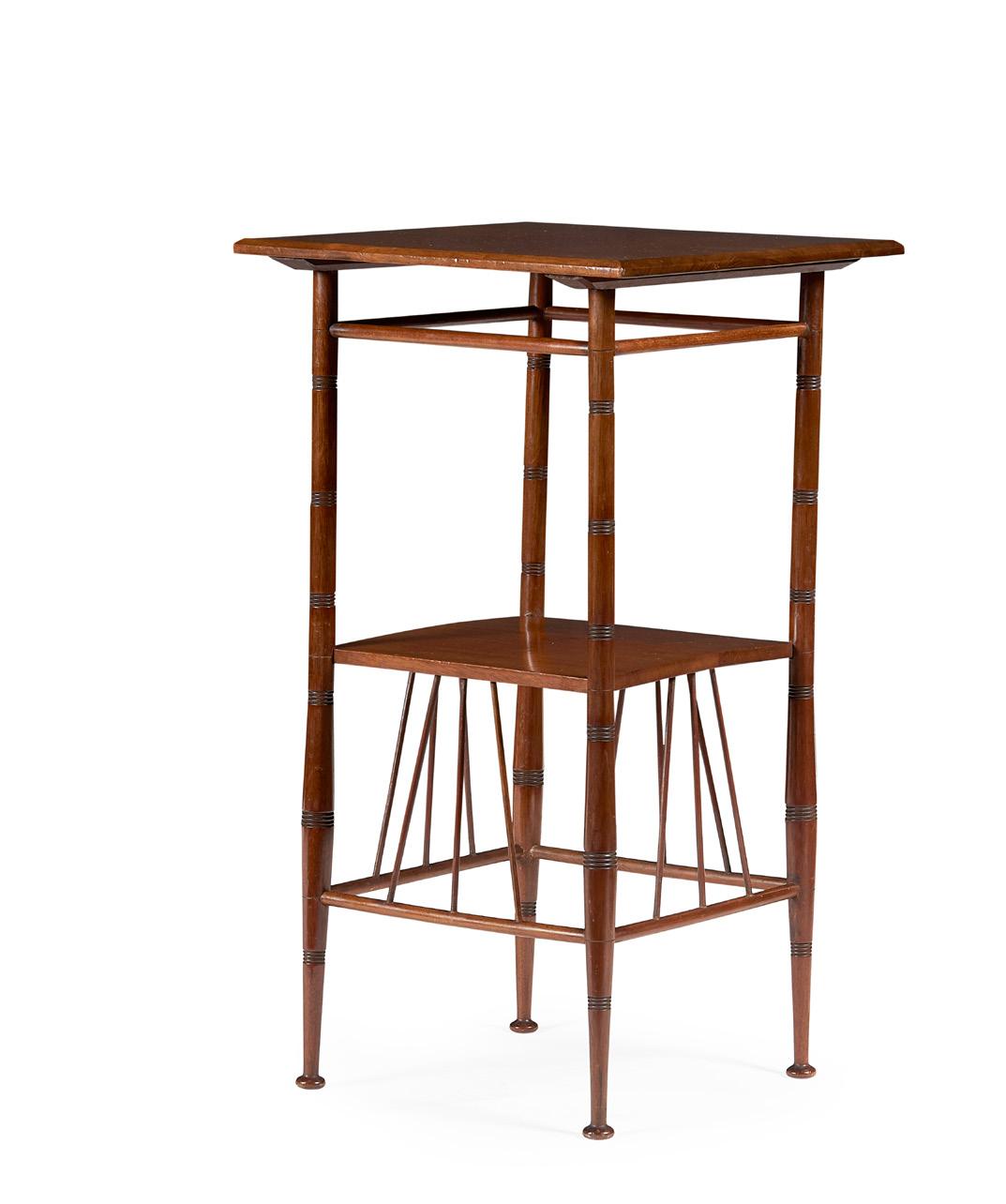
mahogany
39.5cm square, 70cm high £300‑500
30
MANNER OF E. W. GODWIN
AESTHETIC MOVEMENT OCCASIONAL TABLE, CIRCA 1880
oak, brass mounted legs, inset with glazed earthenware tiles
46cm square, 43cm high
£400‑600
66
MANNER OF E. W. GODWIN
AESTHETIC MOVEMENT SIDE CHAIR, CIRCA 1880
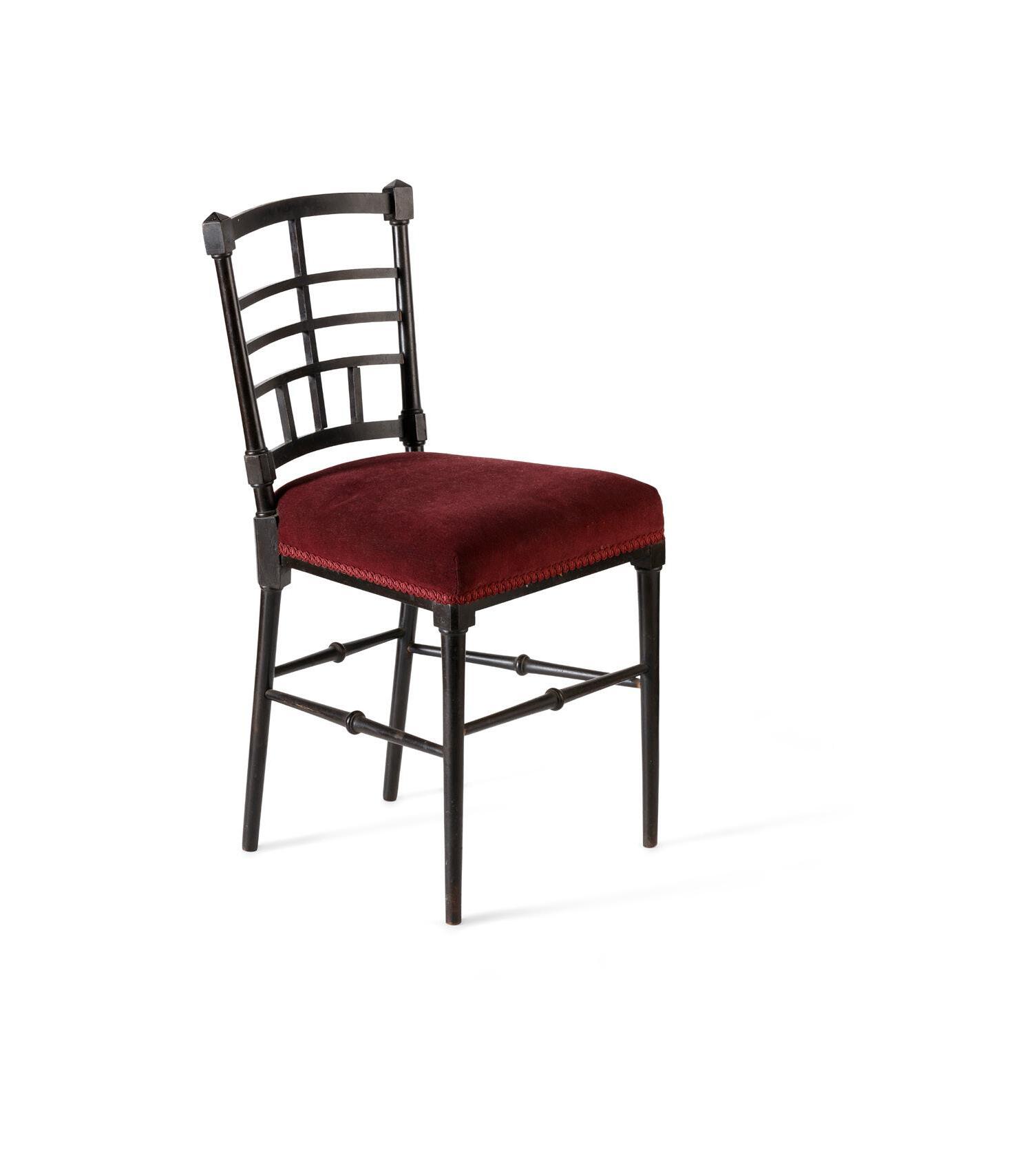
ebonised wood, with later but period velvet upholstered seat
41cm wide, 81cm high, 36.7cm deep £300‑500
67
ALEXANDER MORTON & CO. PAIR OF ‘MADRAS MUSLIN’ CURTAINS, CIRCA 1880
woven cotton and silk leno (gauze) (2)

314cm drop, 133cm wide £300‑500
68
MANNER OF E. W. GODWIN
AESTHETIC MOVEMENT OCCASIONAL TABLE, CIRCA 1880
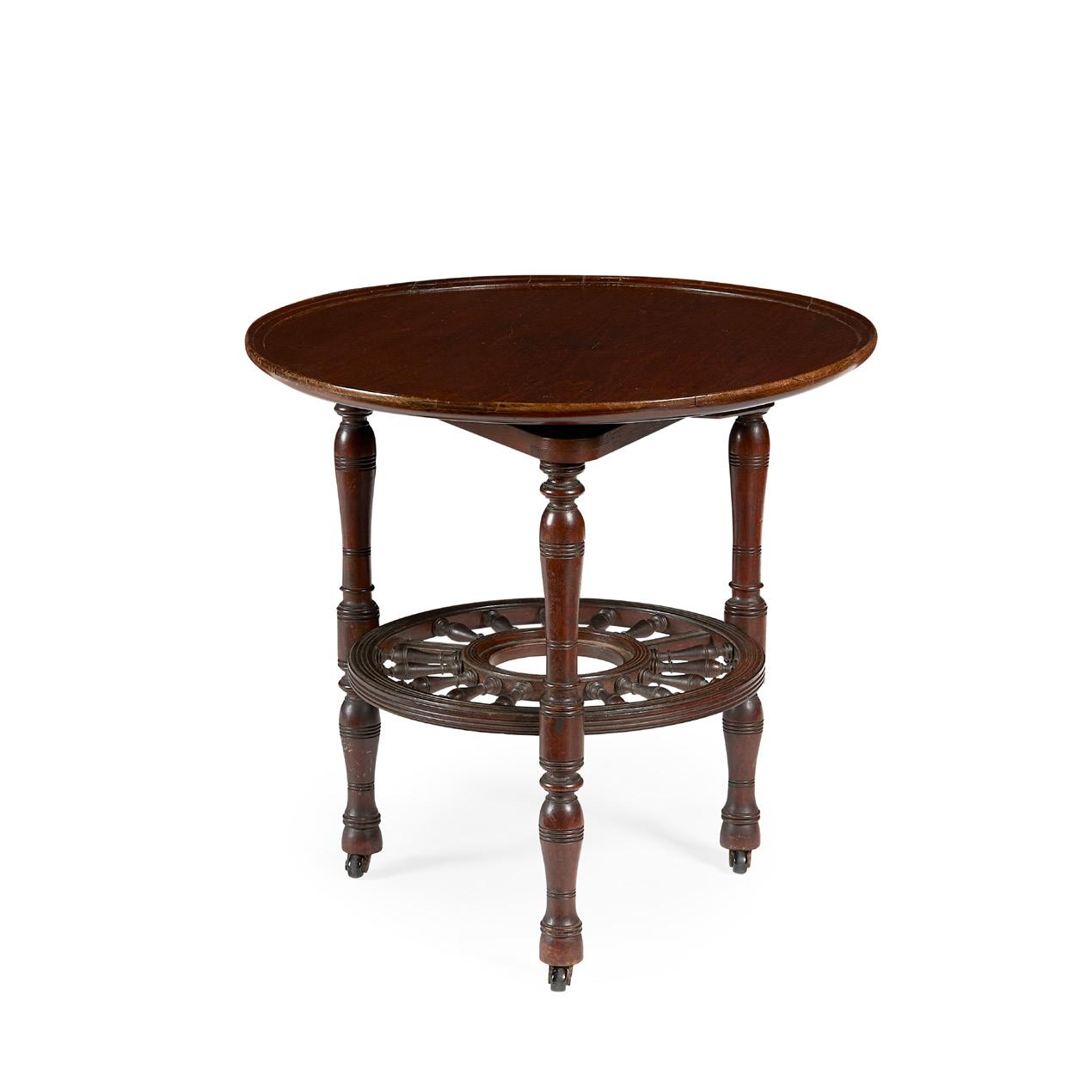

mahogany
61cm diameter, 66cm high
£400‑600
69
AFTER E. W. GODWIN
AESTHETIC MOVEMENT ‘COFFEE’ TABLE, CIRCA 1890
walnut
41cm square, 69cm high £250‑350
65
31 Other fees apply in addition to the hammer price: see the ‘Buyer’s Guide’ section on page 2
70
CHRISTOPHER DRESSER (1834‑1904) (PANEL DESIGNER)

AESTHETIC MOVEMENT CORNER CABINET, CIRCA 1880 ebonised and gilded wood, with a polychrome‑painted panel and mirrored glass
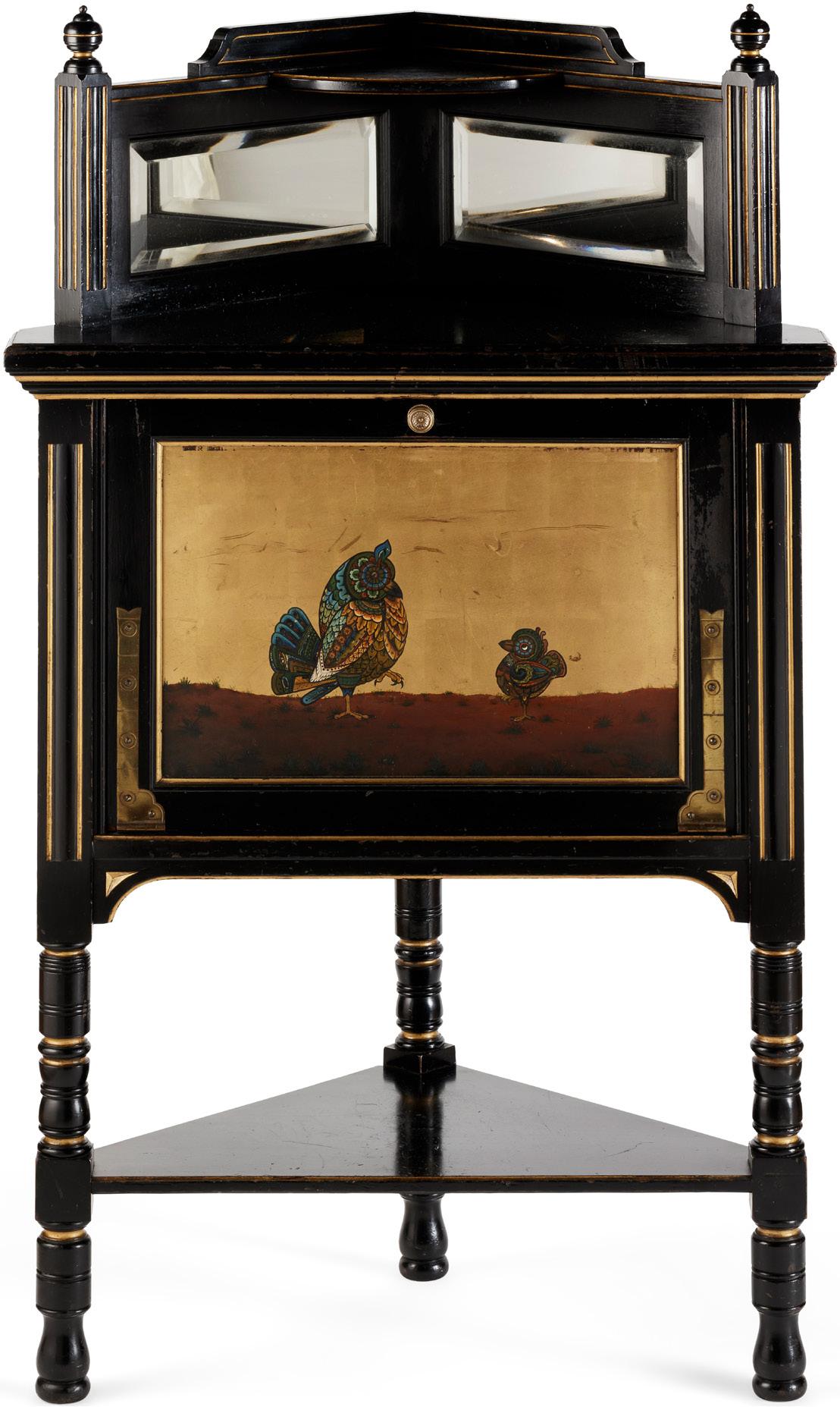

70.2cm wide, 120.5cm high, 43cm deep, panel 28.5cm x 43.5cm
Literature: Dresser C. Studies in Design, Cassel Petter & Galpin, London, the plates by A. Goater, Nottingham, 1876, plate II illus. V&A Collection accession no. W.3‑2015, for a related hand screen, decorated with an adaptation of the painted design. Note: This cabinet is a rare example of an object decorated after a published design in Dresser’s most important works, Studies in Design of 1876. Plate II shows two owls standing upright and is captioned “Parental advice”. Dresser wrote in the caption text that the design ‘may be painted on the panel of a door, on the door of a cabinet, or in any recess in a wall, especially suited to a smoking‑room or nursery.” Elsewhere in the text he states that “the sense of humour finds expression in grotesque forms. Plates II (etc…) are illustrations”.
It may be that this corner cabinet was decorated under Dresser’s direction for the Art Furnishers’ Alliance Co. The Art Furnisher’s Alliance was the association of art manufacturers established by Christopher Dresser (1834‑1904) in 1880. The key objective of the alliance was to buy and sell high‑class goods of artistic design and to “complete artistic furnishing of a house”. George Hayter Chubb was appointed as Chairman, and Dresser was the ‘Art Manager’ heading designs for furniture, pottery, glass and metal, aided by Holme and Arthur Liberty.
In his preface to Studies in Design, Dresser hoped that the work would assist to “bring about a better style of decoration” and “aid the designer and the manufacturer of decorated objects, by suggesting to them useful ideas”. Whether or not the current lot was made directly under his instruction, the panel inset into the door of this cabinet was undoubtedly the sort of effect on a design Dresser envisaged when he published Studies in Design
£800‑1,200
32 Other fees apply in addition to the hammer price: see the ‘Buyer’s Guide’ section on page 2
CHRISTOPHER DRESSER (1834‑1904) FOR HUKIN
& HEATH, LONDON
GLASS CARRIER, CIRCA 1880
electroplated metal, glass, stamped H&H/ 2268/ DESIGNED BY DR C. DRESSER, with registration lozenge

21cm across, 15cm high
Literature: Whiteway M. Christopher Dresser 1834‑1904 Skira Editore S.p.A., Milan 2001, p. 86, pl. 60 where a similar example is illustrated.
£2,000‑3,000

71
33
CHRISTOPHER DRESSER (1834‑1904) FOR JAMES COUPER & SONS, GLASGOW
’CLUTHA’ VASE, CIRCA 1890
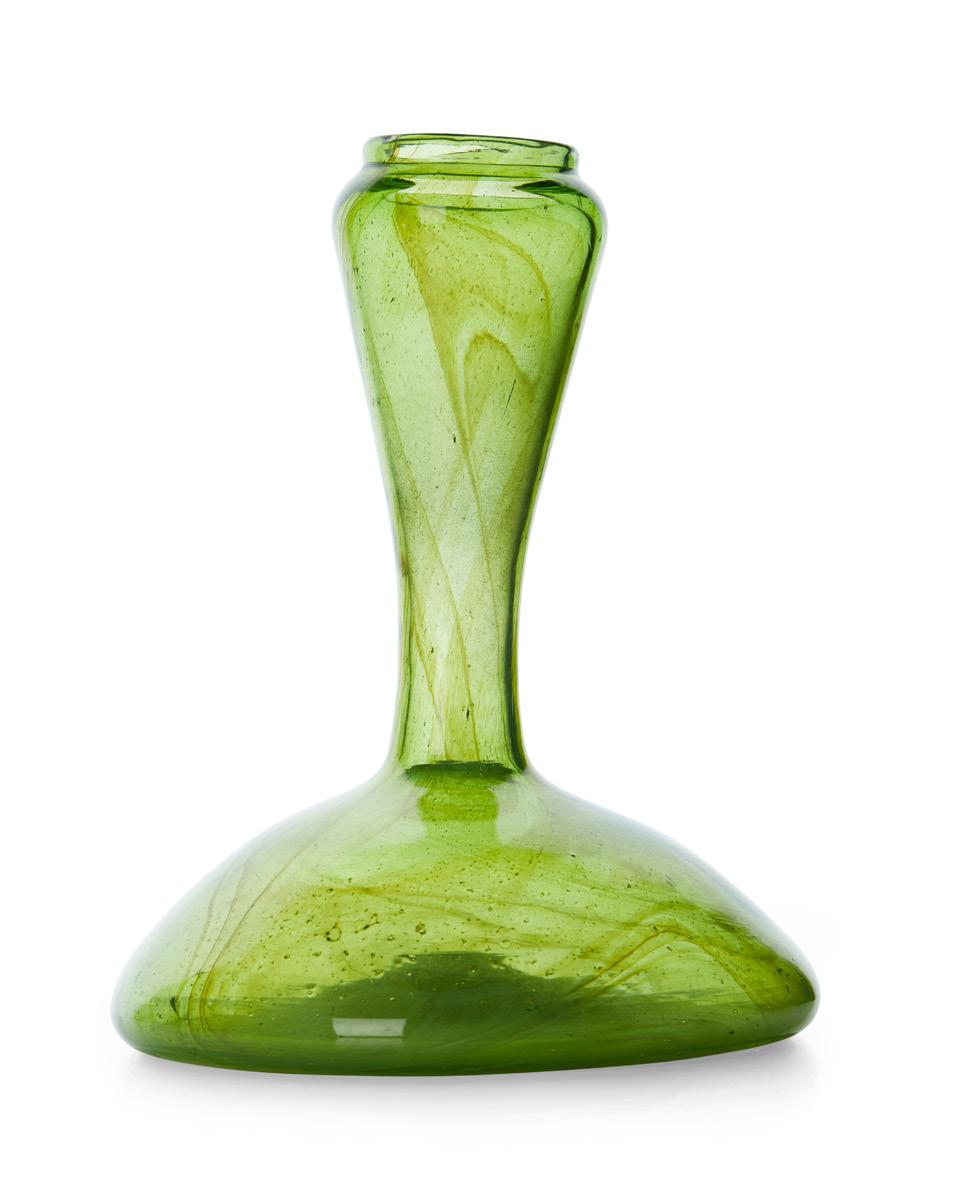
glass, etched to base CLUTHA/ DESIGNED BY CD/ REGISTERED
19.5cm high
Literature: See Lyons H. Christopher Dresser: The People’s Designer, 1834‑1904, Woodbridge, 2004, p.164‑5, pl. 313 where similar signed examples are illustrated.
£600‑800
73
CHRISTOPHER DRESSER (1834‑1904) (ATTRIBUTED DESIGNER) FOR HUKIN & HEATH LTD
CLARET JUG, BIRMINGHAM 1909
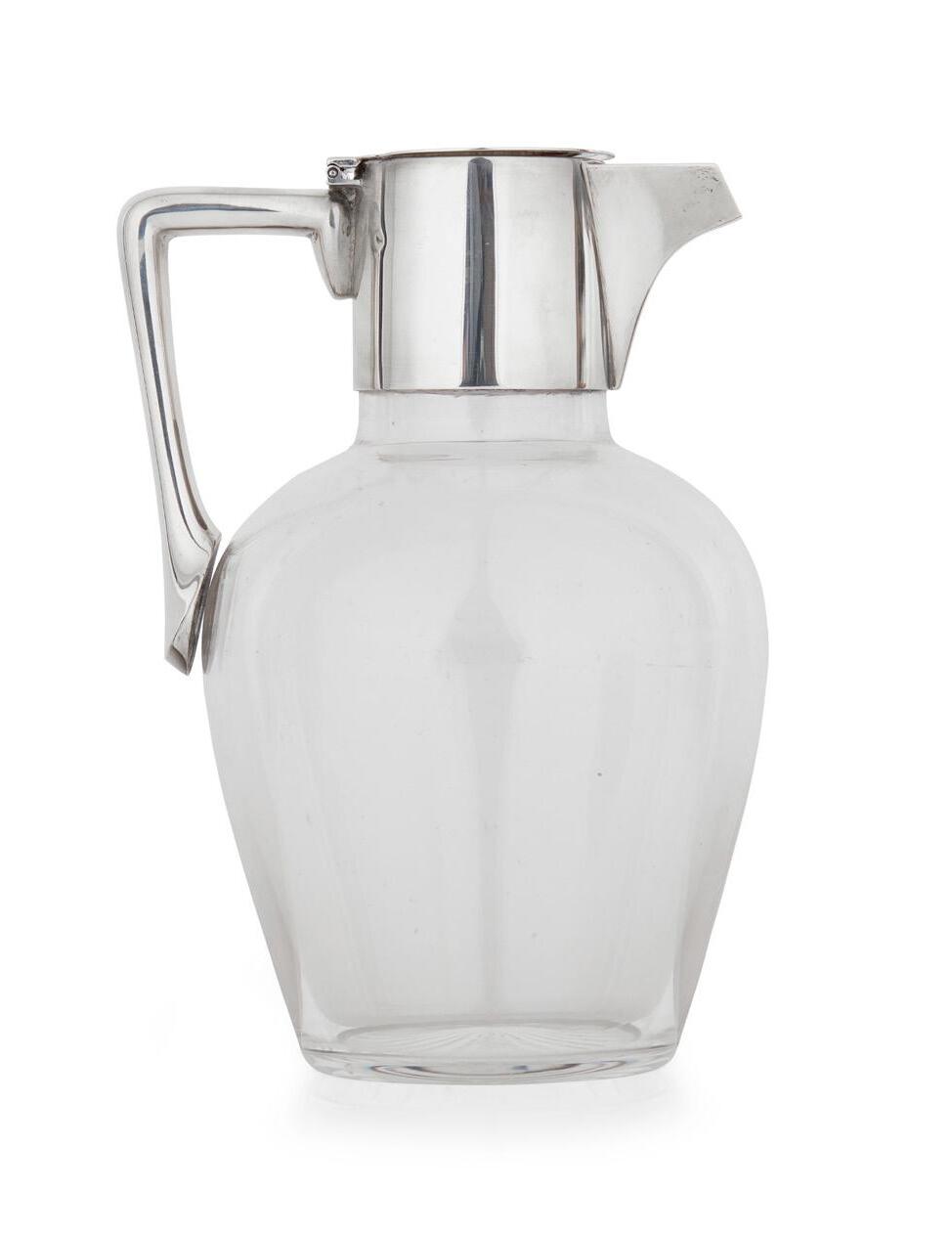
silver and glass, lid stamped 2521/ 1/ S, hallmarked Birmingham 1909, 20cm high
£300‑500
74
CHRISTOPHER DRESSER (1834‑1904) FOR HUKIN & HEATH, LONDON
PICNIC SET, CIRCA 1880
silver plate, comprising: a kettle and cover, 9cm high; a teapot and cover, 8cm high, the teapot and kettle inscribed NELLIE; a tea caddy and cover incorporating paraffin burner and stand; a sugar bowl; a milk flask and cover; two teaspoons; a pair of sugar tongs; each bears crest, stamped marks ‘H & H 2110’ also with retailers mark ‘Leuchars & Son, London and Paris’, and two blue and white Royal Worcester cups and saucers, contained within a leather‑covered fitted case, inscribed HELEN BRAND case 29cm wide, 19cm high, 15.5cm deep
£1,000‑1,500

72
34 Other fees apply in addition to the hammer price: see the ‘Buyer’s Guide’ section on page 2
CHRISTOPHER DRESSER (1834‑1904) FOR BENHAM & FROUD, LONDON
AESTHETIC
MOVEMENT
FLASK, CIRCA 1885
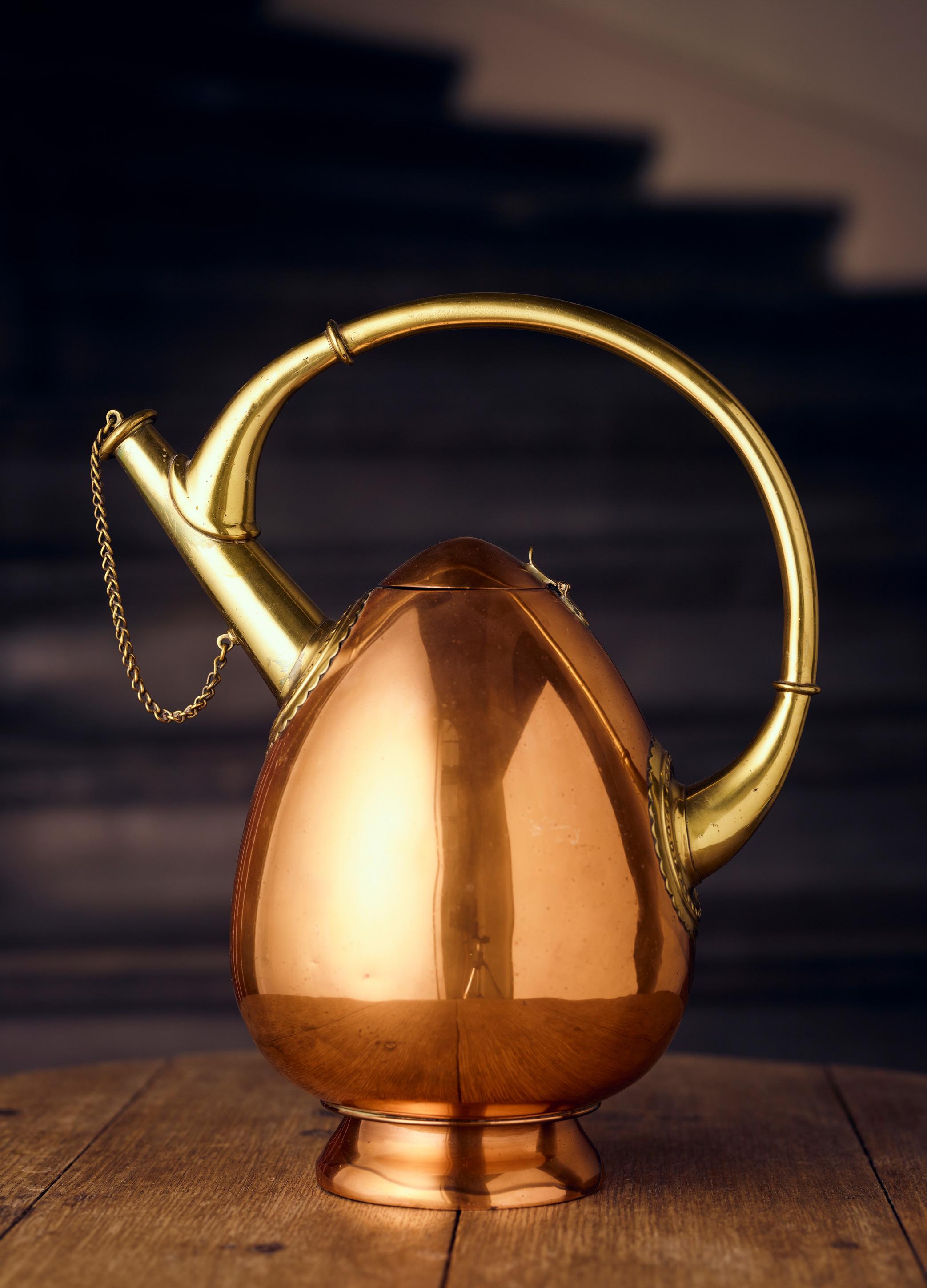
brass and copper, with original cork stopper and chain, stamped manufacturer’s mark
32.5cm high
Literature: Whiteway M. ed., Christopher Dresser: Design Revolution, London, 2004, pl. 240 where a similar example of this kettle is illustrated. Note: For another known example of this rare model, lacking the stopper and chain, see An Aesthetic Odyssey: The Peter Rose and Albert Gallichan Collection, Christie’s, London September 2021, lot 82. £2,000‑3,000
75
35
CHRISTOPHER DRESSER (1834‑1904) (ATTRIBUTED DESIGNER)

ORIGINAL DESIGN FOR A FRIEZE, CIRCA 1870
pen & ink and gouache, with traces of graphite 20cm x 19.5cm
£300‑500
77
CHRISTOPHER DRESSER (1834‑1904) FOR LINTHORPE ART POTTERY TWO VASES, CIRCA 1880

glazed earthenware, one with polychrome streaked glaze, impressed mark LINTHORPE/ HT (Henry Tooth)/ 180 and with facsimile signature CHR. DRESSER, 23cm high; the other with banded decoration, stamped to base 146, 26cm high (2)
£300‑500
78
CHRISTOPHER DRESSER (1834‑1904) FOR LINTHORPE ART POTTERY
TWIN‑HANDED VASE, CIRCA 1880
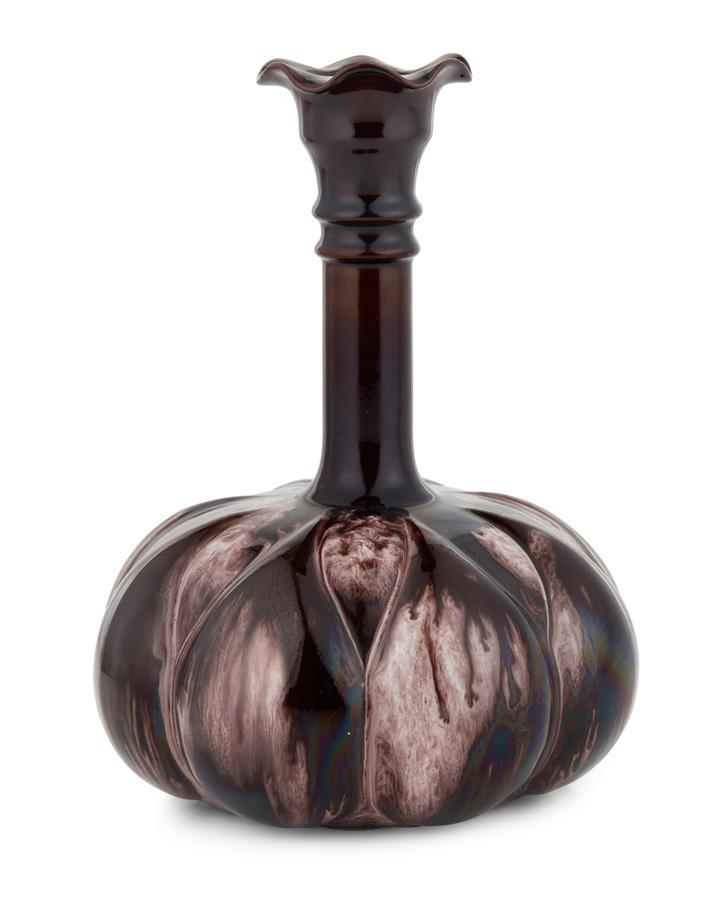

glazed earthenware, impressed to base LINTHORPE/ 336, with facsimile signature CHR. DRESSER
19.8cm high
£200‑300
79
CHRISTOPHER DRESSER (1834‑1904) FOR WILLIAM AULT & CO. VASE, CIRCA 1895
glazed earthenware, impressed facsimile signature CHR. DRESSER/ 323 22.3cm high
£200‑300
76
36 Other fees apply in addition to the hammer price: see the ‘Buyer’s Guide’ section on page 2
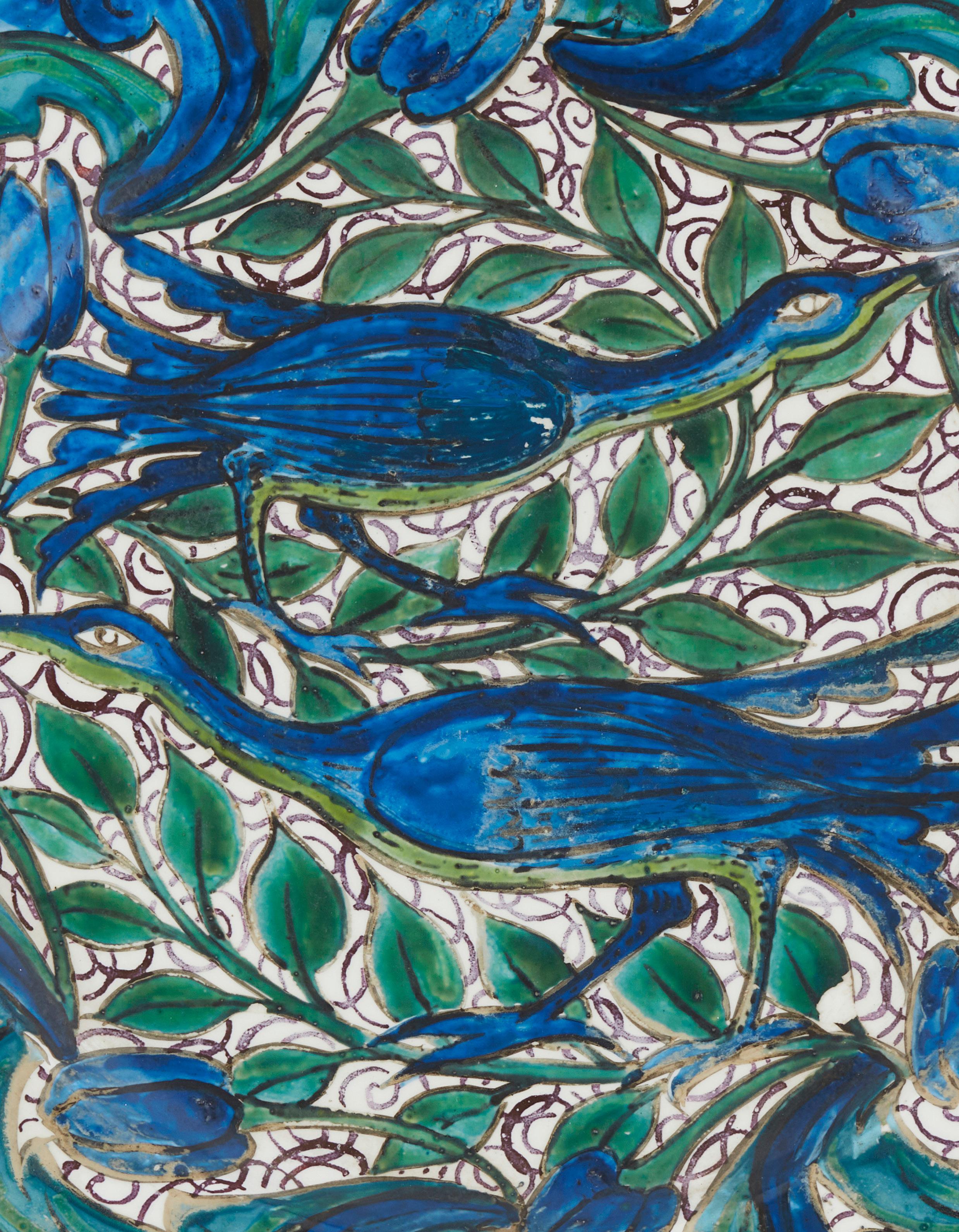
37
81
PLATE,
32.5cm diameter
£600‑800
80
BOWL, CIRCA 1900

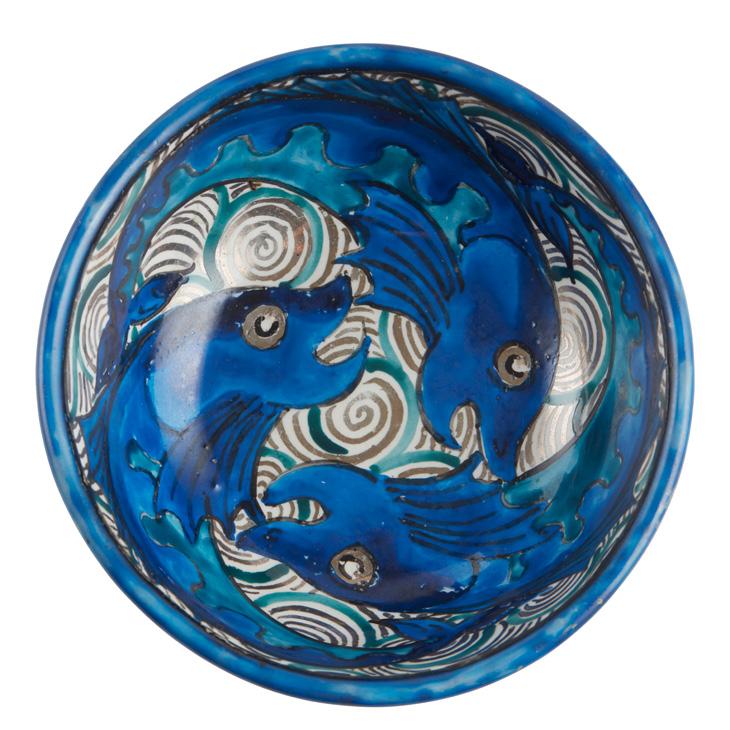
painted earthenware with lustre highlights, painted monogram and hourglass symbol
14.5cm diameter
£300‑500
83
BOOK
oak, with repoussé‑decorated copper panels

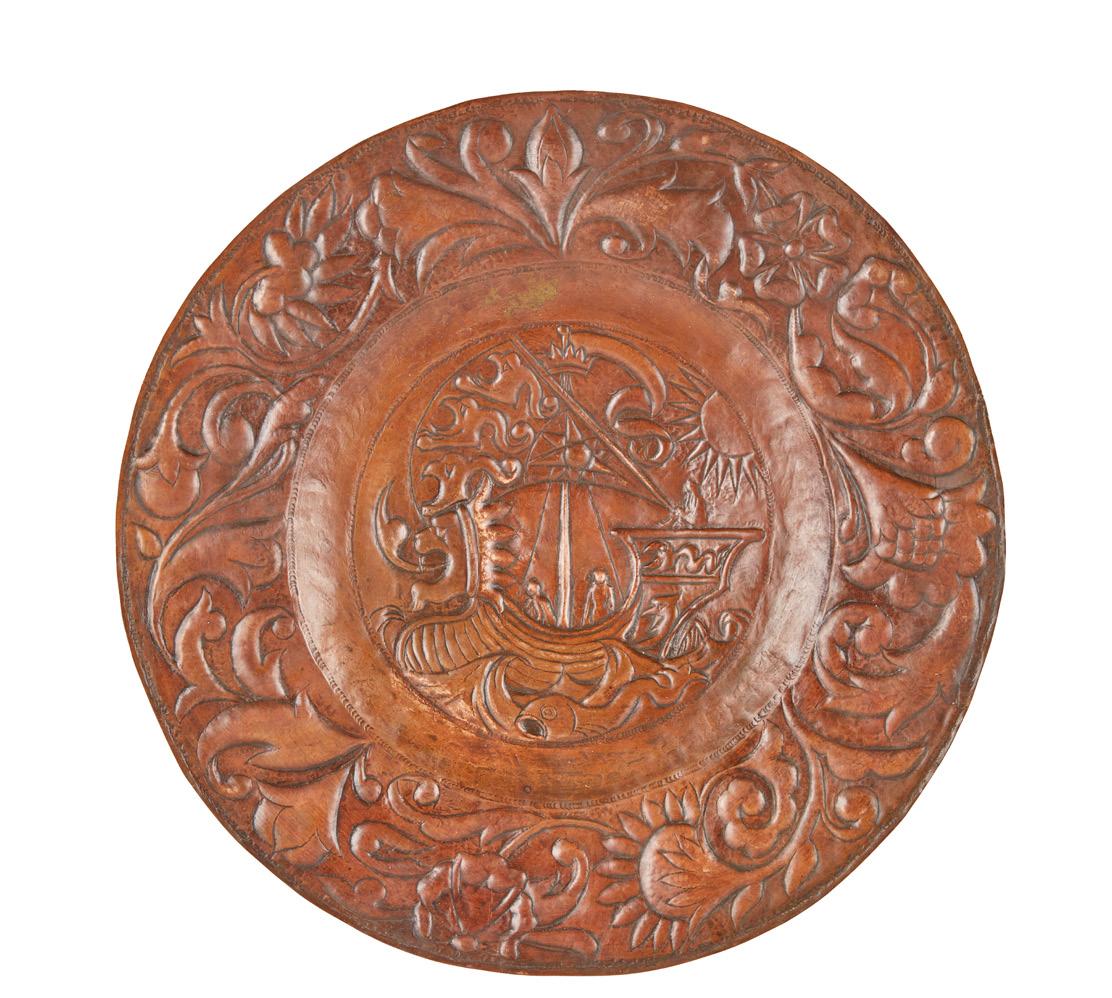
36cm wide, 9.8cm high, 14cm deep

£500‑800
82
repoussé‑decorated
38.3cm diameter
£300‑500
JOHN PEARSON (1859‑1930)
JOHN PEARSON (1859‑1930)
CIRCA 1900
painted earthenware, decorated verso with a pelican, fish and artist monogram
MANNER OF JOHN PEARSON ARTS & CRAFTS CHARGER, CIRCA 1900
copper, unmarked
JOHN PEARSON (1859‑1930)
TROUGH, CIRCA 1900
38
WILLIAM MORRIS (1834‑1896) FOR MORRIS & CO.
‘DOVE AND ROSE’ PATTERN FRAMED PANEL, CIRCA 1879

silk and wool double cloth
57cm x 90cm
Literature: Parry L. William Morris Textiles, V&A 1983, p.153, pl. 34
Note: This cloth was woven by Morris & Co. at Merton Abbey.
£400‑600
85
HENRY WOODYER (1816–1896)
ARTS & CRAFTS REFECTORY TABLE, CIRCA 1870
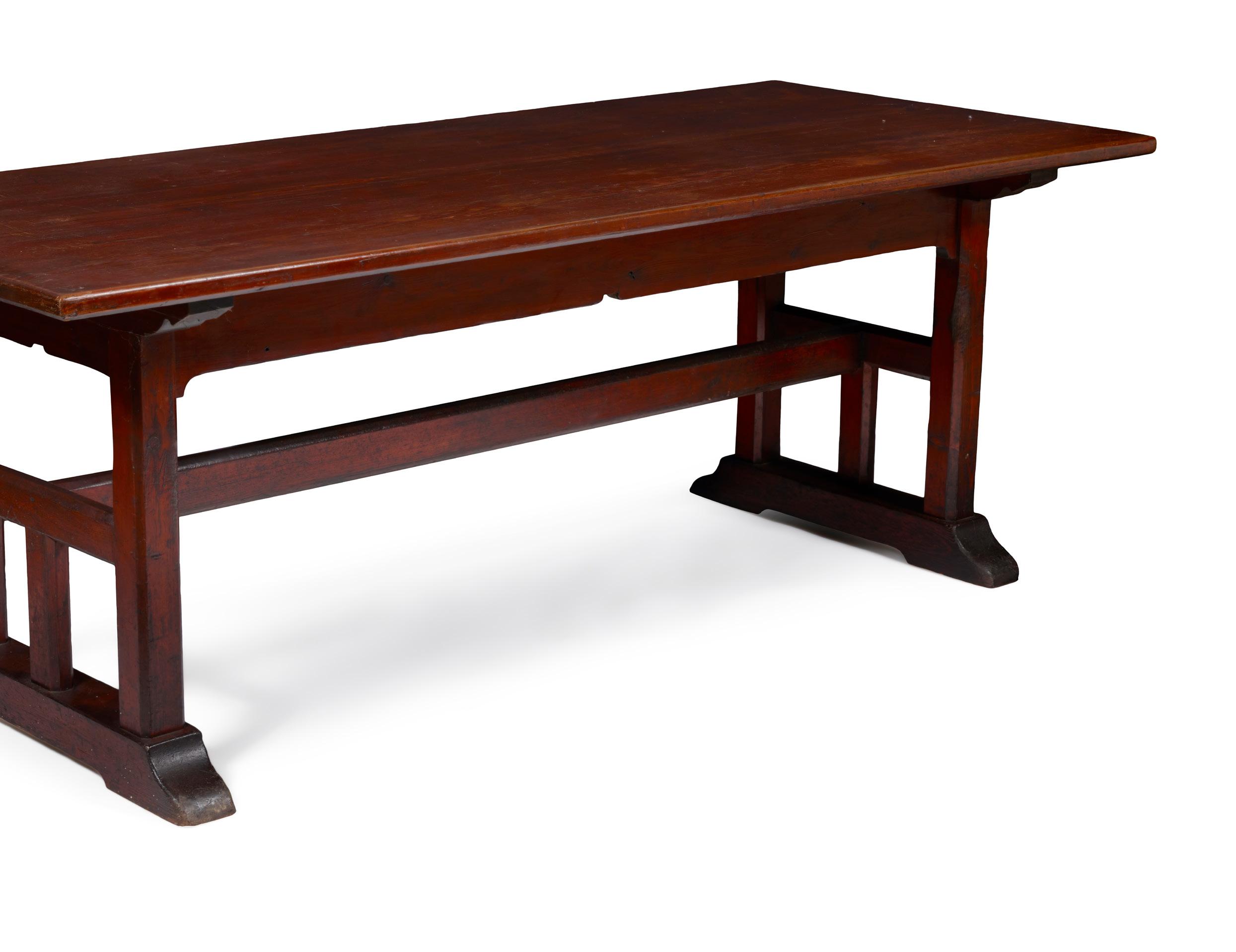
stained pine
215cm long, 76cm high, 89cm deep
Provenance: House of Mercy, Clewer, Berkshire
Note: Born into a wealthy family in Guildford in 1816, Henry Woodyer went on to become a prominent English architect of the nineteenth century. Devoutly religious, Woodyer’s work was primarily linked to the Anglican high church movement, and he restored or designed numerous churches and church interiors throughout his career as a means of serving them and established him as a major name of the Gothic Revival.
£600‑800
84
39 Other fees apply in addition to the hammer price: see the ‘Buyer’s Guide’ section on page 2
WILLIAM DE MORGAN (1839‑1917)
TWO‑TILE PANEL, CIRCA 1890
glazed earthenware, impressed Sands End mark verso, framed each 15.5cm square, frame 36cm x 20cm
£250‑350

87
WILLIAM DE MORGAN (1839‑1917)
TWO 6‑INCH TILES, CIRCA 1880

to include a DOUBLE CARNATION TILE, impressed Merton Abbey mark, 15.5cm square; and a FOLIATE TILE, impressed maker’s mark, 15.5cm square (2)
£300‑500
88
WILLIAM DE MORGAN (1839‑1917)
8‑INCH DOUBLE CARNATION TILE, LATE 1890S glazed earthenware, impressed Sands End mark 20.4cm square

£400‑600
89
WILLIAM DE MORGAN (1839‑1917)
6‑INCH ‘BBB’ CARNATION TILE, LATE 1890S


glazed earthenware, impressed Sands End mark 15.5cm square
£300‑500
86
40
MORRIS & CO.
DESIGN FOR A TILE, ‘THE MINSTREL’ pencil on tracing paper, framed 26cm x 12.5cm
Note: In the painted paper technique of tile decoration the design was drawn on tracing paper which was pasted onto a sheet of glass. On the other side of the glass, a square of thin paper was attached. The sheet of glass was set up in front of a window, so the lines of the pattern were easily visible on the thin paper. The painter then filled the design with pigment. The finished copy was placed face down on the surface of a tile blank, adhered with sodium silicate and sprinkled with powdered glaze before being placed in the kiln. In the kiln, the pigment fused with the glaze and
91
AFTER MORRIS & CO. SET OF EIGHT ‘SUSSEX’ ARMCHAIRS, CONTEMPORARY ebonised beech and oak, with rushed seats (8) 57cm wide, 90cm high, 44cm deep
£2,000‑3,000
ARTS & CRAFTS FIRE GRATE, CIRCA 1900
cast and wrought iron, with later ceramic fire brick backing
88cm wide, 76cm high, 48cm deep
Literature: The Studio Magazine Yearbook, 1896, p. 106 where a fireplace with similar characteristics is illustrated.
Dog‑Grates, a George Wright & Co. catalogue, circa 1900, where this example is illustrated no. 847
£800‑1,200
93
DANTE GABRIEL ROSETTI (BRITISH 1828‑1882) (ATTRIBUTED DESIGNER)

FOR MORRIS & CO.
‘SUSSEX’ SIDE CHAIR, CIRCA 1880 ebonised wood, with rush seat, applied retailer’s label under seat


43cm wide 84cm high, 41cm deep
£250‑350
94
ENGLISH, MANNER OF MORRIS & CO. GROUP OF EIGHT ARTS & CRAFTS STYLE ‘SUSSEX’ CHAIRS, EARLY 20TH CENTURY ebonised wood with rush seats, comprising FIVE CARVERS, 51cm wide, 110cm high, 39cm deep, and THREE SIDE CHAIRS, 43.5cm wide, 109cm high, 38cm deep (8)
£300‑500
90
41 Other fees apply in addition to the hammer price: see the ‘Buyer’s Guide’ section on page 2
WALTER CRANE (1845‑1915) (ATTRIBUTED DESIGNER) FOR THE ROYAL SCHOOL OF NEEDLEWORK
EMBROIDERED PANEL CIRCA 1890
coloured silks and gold thread with applied beads, later frame
35.5cm x 34cm
Note: The original drawing for this design is in the collection of The Royal School of Needlework, RSN Archive D1/29
See also V&A collection accession no. T.774 to D‑1972 where a screen of 1876 demonstrated similar design characteristics.
£500‑700
WILLIAM MORRIS (1834‑1896) FOR MORRIS & CO. ‘THE APPLE TREE’ EMBROIDERED PANEL, CIRCA 1890 coloured silk threads, presented in a later frame 58cm x 57cm
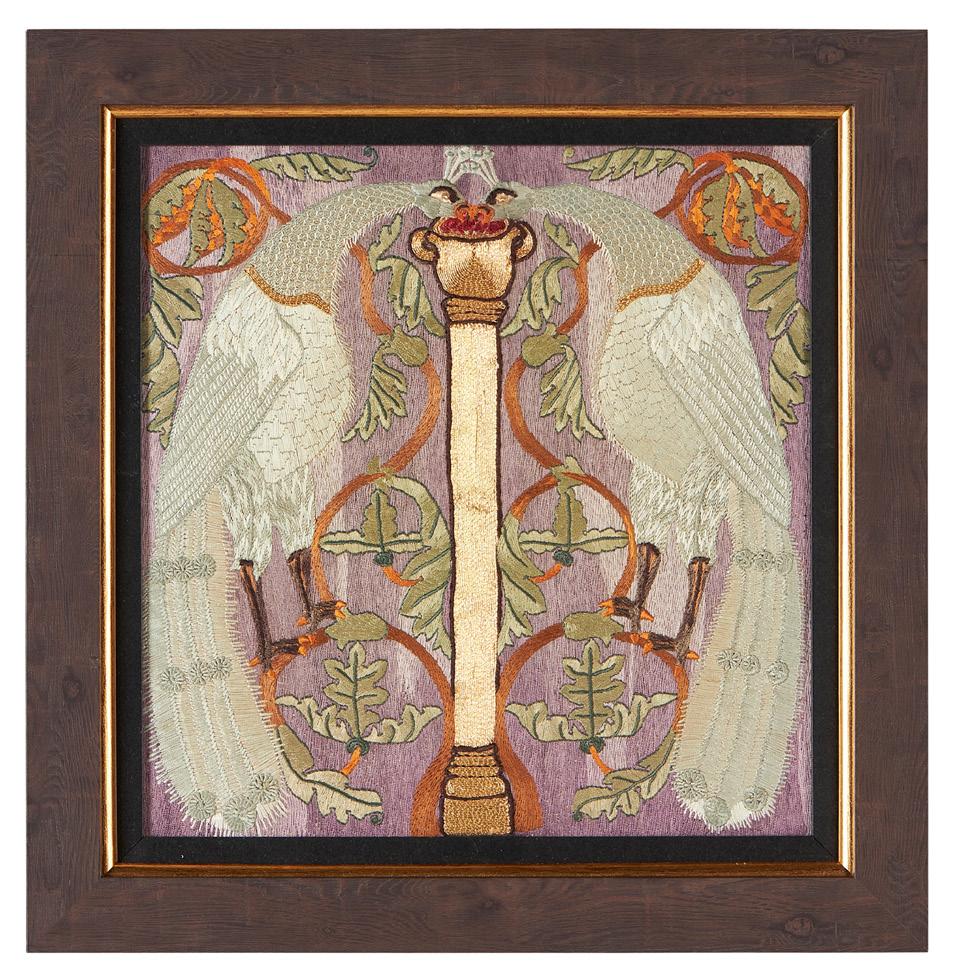
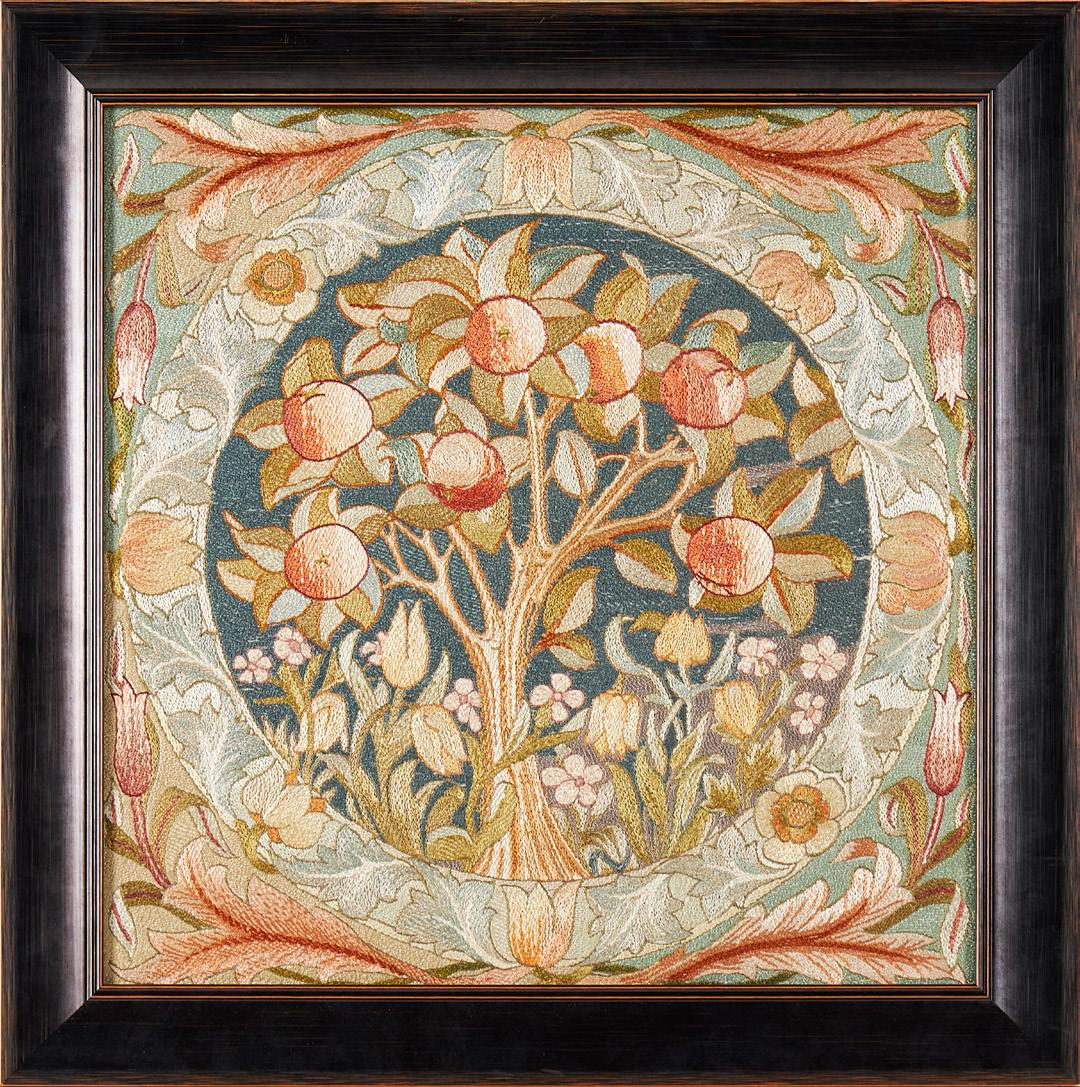
Literature: Parry L. William Morris Textiles, 1983, p. 28 where a similar design for embroidery is illustrated.
£1,500‑2,000 96
W. A. S. BENSON (1854‑1924) EXTENDING STANDARD LAMP CIRCA 1900
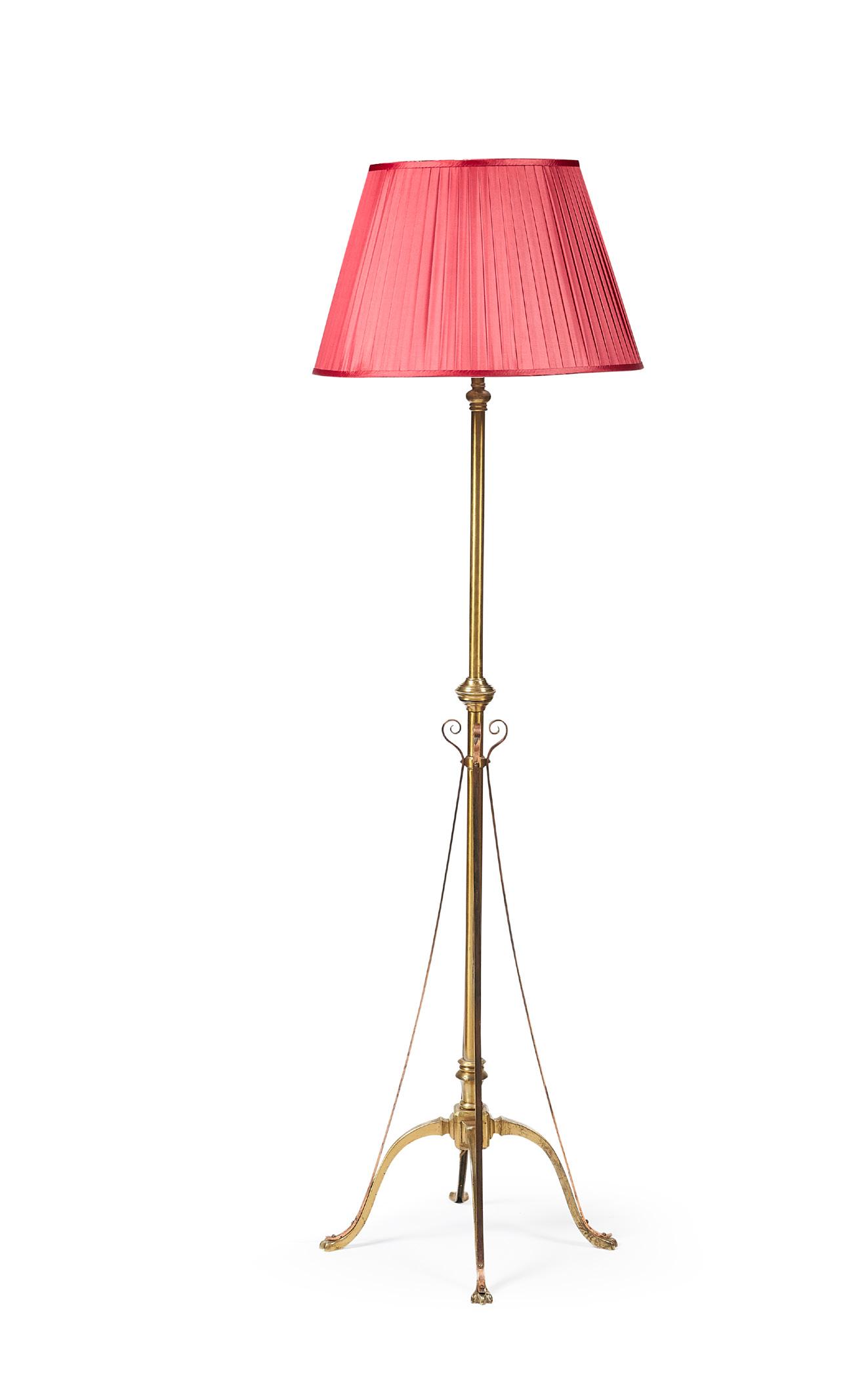
brass and copper, stamped to base W.A.S. BENSON, later pleated silk shade
Approx 120cm to fitting closed, 155cm high extended to fitting
Literature: Hamerton, I. (ed.), W. A. S. Benson: Arts and Crafts Luminary and Pioneer of Modern Design, Woodbridge, 2005, p. 259, pl. 20 where a similar lamp is illustrated.
£800‑1,200
ENGLISH ARTS & CRAFTS MIRROR, CIRCA 1900 repoussé‑decorated copper, with bevelled mirror plate 45.5cm x 30.5cm
£200‑300
95
98
97
42 Other fees apply in addition to the hammer price: see the ‘Buyer’s Guide’ section on page 2
MACKAY HUGH BAILLIE SCOTT (1865‑1945) FOR JOHN BROADWOOD & SONS, LONDON
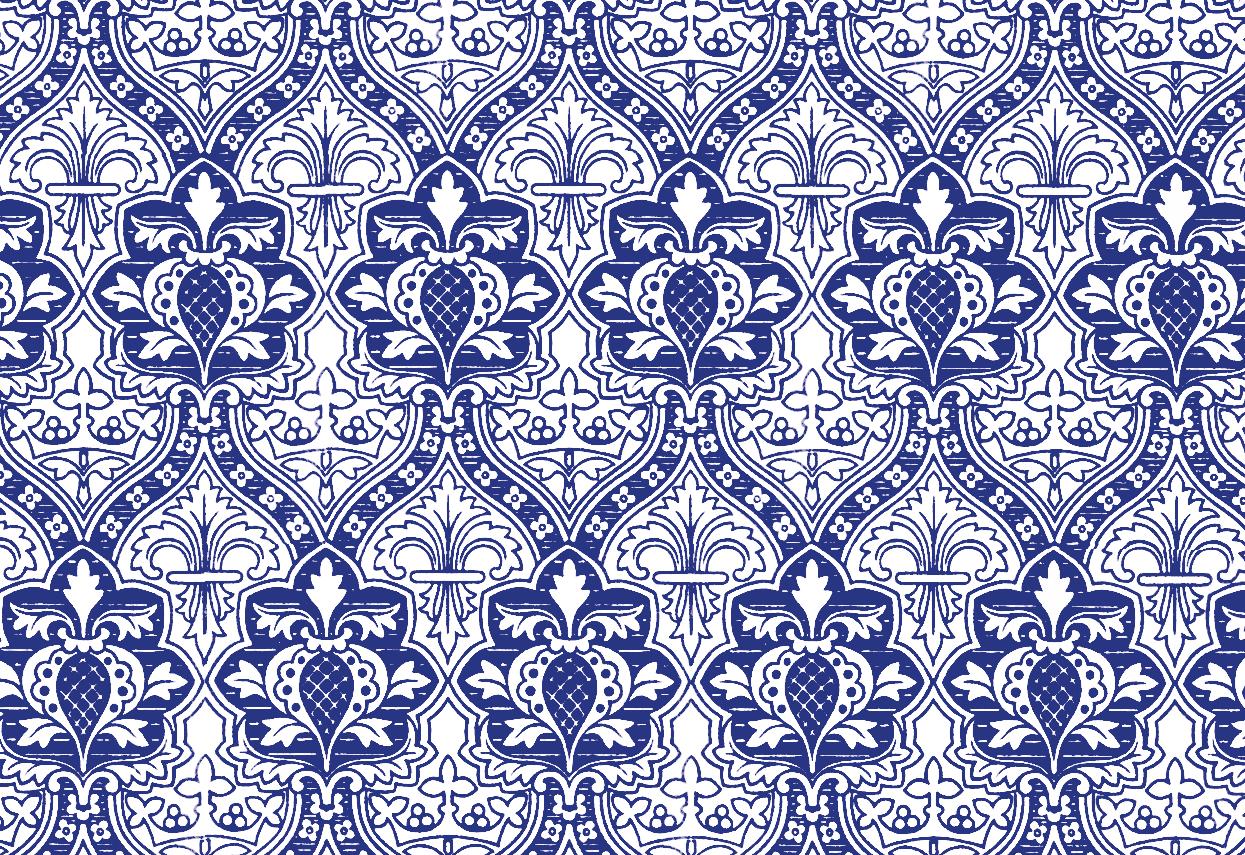

ARTS & CRAFTS ‘MANXMAN’ PIANO AND STOOL, CIRCA 1904
oak, ebonised and ivory keys, brass and wrought steel candle sconces, with STOOL, oak with brass hinges and later but period upholstered seat, bears ivorine label for LIBERTY & CO
piano 148cm wide, 124cm high, 72cm deep, stool 93cm wide, 57cm high, 39cm deep
Provenance: Collection of Gary Kemp, London
Note: Upright pianos were generally perceived as ungainly and over‑complicated designs and it wasn’t until the mid‑1890s that design reformers attempted to reimagine the form. M.H. Baillie Scott’s innovation, thought to derive from the form of an Elizabethan strongbox, was to enclose the keyboard, music stand and candleholders behind broad doors that rationalised the shape of the instrument. The result was a piece of drawing room furniture that is both cleverly functional and aesthetically pleasing. Baillie Scott first exhibited the piano at the Arts & Crafts exhibition of 1896. He moved to the Isle of Man in 1889 and hence this form of the piano is known as the ‘Manxman’. This example has been recently refurbished.


Note: Sold in compliance with UK Government and APHA regulations, with (non‑transferable) exemption registration reference ST7V3G8N.
£3,000‑5,000
99Y
43
100

ARTHUR J. GASKIN (1862‑1928) AND GEORGIE GASKIN (1866‑1934) (ATTRIBUTED MAKER)
PENDANT NECKLACE, CIRCA 1900
white metal, enamel, set with a central mother of pearl cabochons, in a border of opals, turquoise, amethyst, garnet, peridot approx. 48cm long, main medallion 5cm tall £1,000‑1,500
101
ARTIFICERS GUILD (ATTRIBUTED TO)
TWO ARTS & CRAFTS BROOCHES, CIRCA 1900
comprising a BAR BROOCH, white metal set with moonstone and chrysoprase cabochons, 6.6cm long; and a PIN BROOCH, white metal set with moonstone and chrysoprase cabochons, 7.1cm long (2) £300‑500
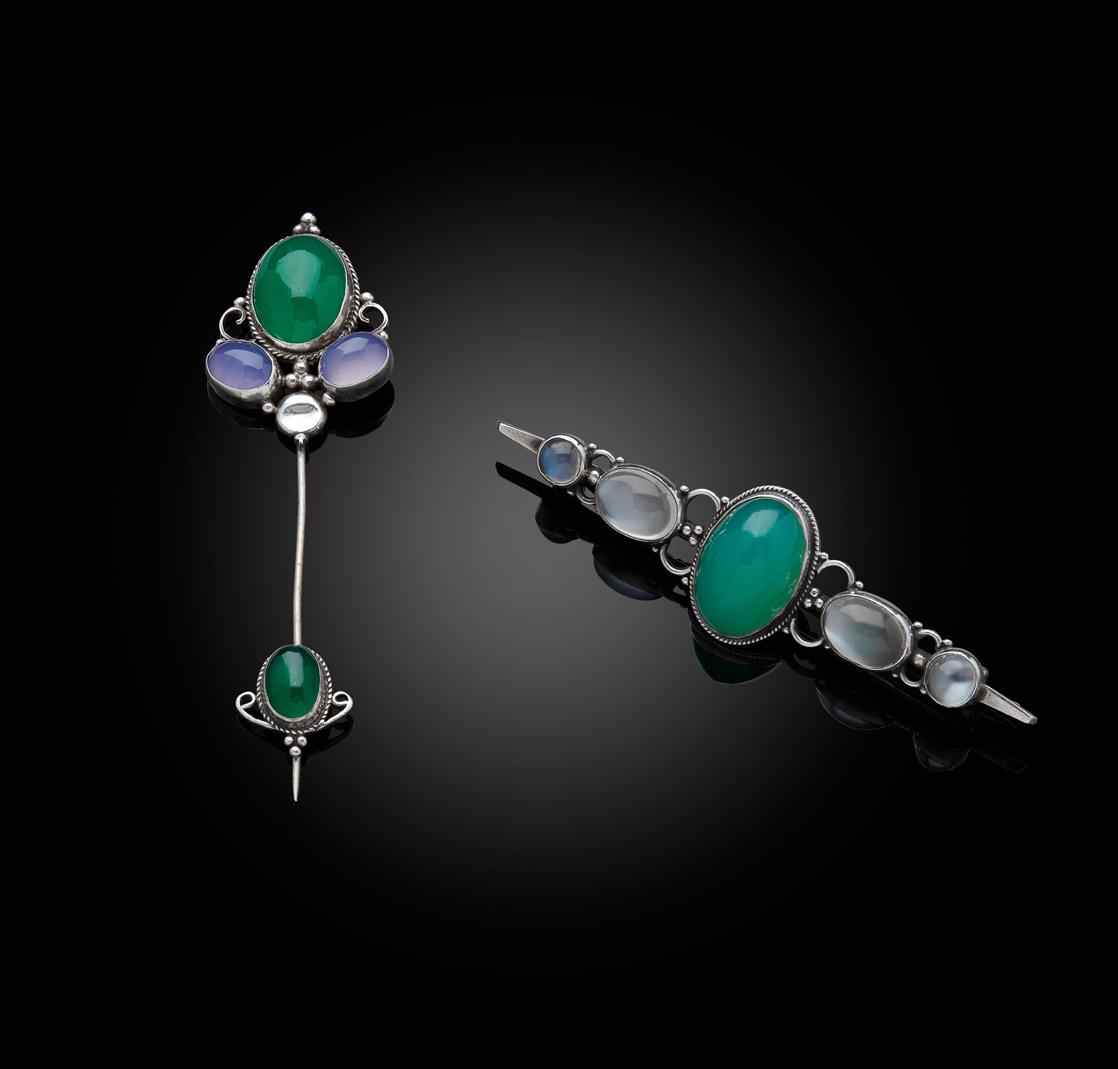
102
NEWLYN SCHOOL
PENDANT NECKLACE, CIRCA 1900

white metal, enamel and mother‑of‑pearl, with original hand‑crafted chain, stamped NEWLYN/ ENAMEL pendant 3.2cm long; chain 42.5cm £800‑1,200
103
EDWARD SPENCER (1873‑1938) FOR THE ARTIFICERS’ GUILD
ARTS & CRAFTS PRESERVE SPOON & PICKLE FORK, LONDON 1913
silver, with original fitted case, inscribed THE ARTIFICERS’ GUILD LTD. 4 CONDUIT STREET. LONDON. W., hallmarked London 1913 (2) approx. 16cm long £300‑500
104
ARTHUR J. GASKIN (1862‑1928) AND GEORGIE GASKIN (1866‑1934)
ARTS & CRAFTS PENDANT, CIRCA 1910
gold, set with green chalcedony, unmarked 4.5cm long
Note: This pendant is illustrated in a group of Gaskin jewellery from an undated article in Collectors Weekly £400‑600
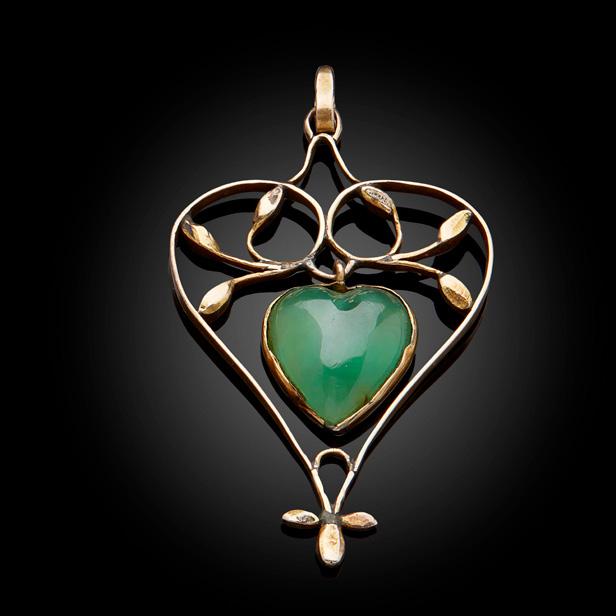

44
MADELINE WYNDHAM (1845–1920) (ATTRIBUTED MAKER)
THE ‘SOULS’ SPORTING MEDAL, 1902
enamel on copper, inscribed to front C/ EVAN, and inscribed verso CLOUDS/ EASTER 1902/ GOLF COMPETITION/ A.J. BALFOUR./ ELCHO. P.S.W./ O.LODGE.EGO/ EVAN, within the original silk‑lined leather box
6.5cm diameter
Literature: Dakers C. Clouds: Biography of a Country House, Yale University Press, 1993, pp. 143‑152
Note: The Souls, or ‘The Gang’ as they chose to call themselves before the name ‘Souls’ was coined in 1888 by Lord Charles Beresford, was initially made up of four aristocratic families; the Balfours, Lyttletons, Tennents and Wyndhams. Arthur Balfour was the leading light of the Souls, and as a set they rejected being grouped with other social cliques of the time such as The Marlborough House crowd, preferring rounds of golf and literary discussions to bridge and hunting.
One of these sporting weekends was held at Clouds, the home of Percy and Madeline Wyndham, at Easter in 1902 and is the subject of the current lot. Percy Wyndham bought the Clouds estate in 1876, and he and Madeline set about demolishing the existing late eighteenth‑century house and building a new one, designed by Philip Webb between 1881 and 1885 and decorated by Morris & Co. Madeline Wyndham was an artist in enamels, embroidery and watercolours, however from the mid‑1890s she concentrated on enamelling. Madeline was closely associated with the enamellist Alexander Fisher and became one of his most talented pupils; she also used her influence to further his career. It was an expensive hobby and appealed more to aristocratic women, some of whom installed furnaces in their homes. Indeed, Fisher procured a furnace for Madeline from a Parisian firm and had it installed at Clouds in 1901, where this medal was probably fired. The participants in the Golf Competition at Easter 1902 are inscribed verso on the current lot ‑ they are ‘A.J. Balfour’ (later to be Prime Minister); ‘Elcho’ (Lord Hugo Elcho, 11th Earl of Wemyss & March); P.S.W. (Percy Wyndham); ‘O. Lodge’ (Sir Oliver Lodge); ‘Ego’ (Lord Hugo Elcho) and ‘Evan’ (Evan Charteris, presumably the winner).
£400‑600
106
CLEMENT HEATON (1861‑1940)
ARTS & CRAFTS CHARGER, 1895‑1906
cloisonné copper and enamel, marked to reverse CHATOYANT ENAMEL

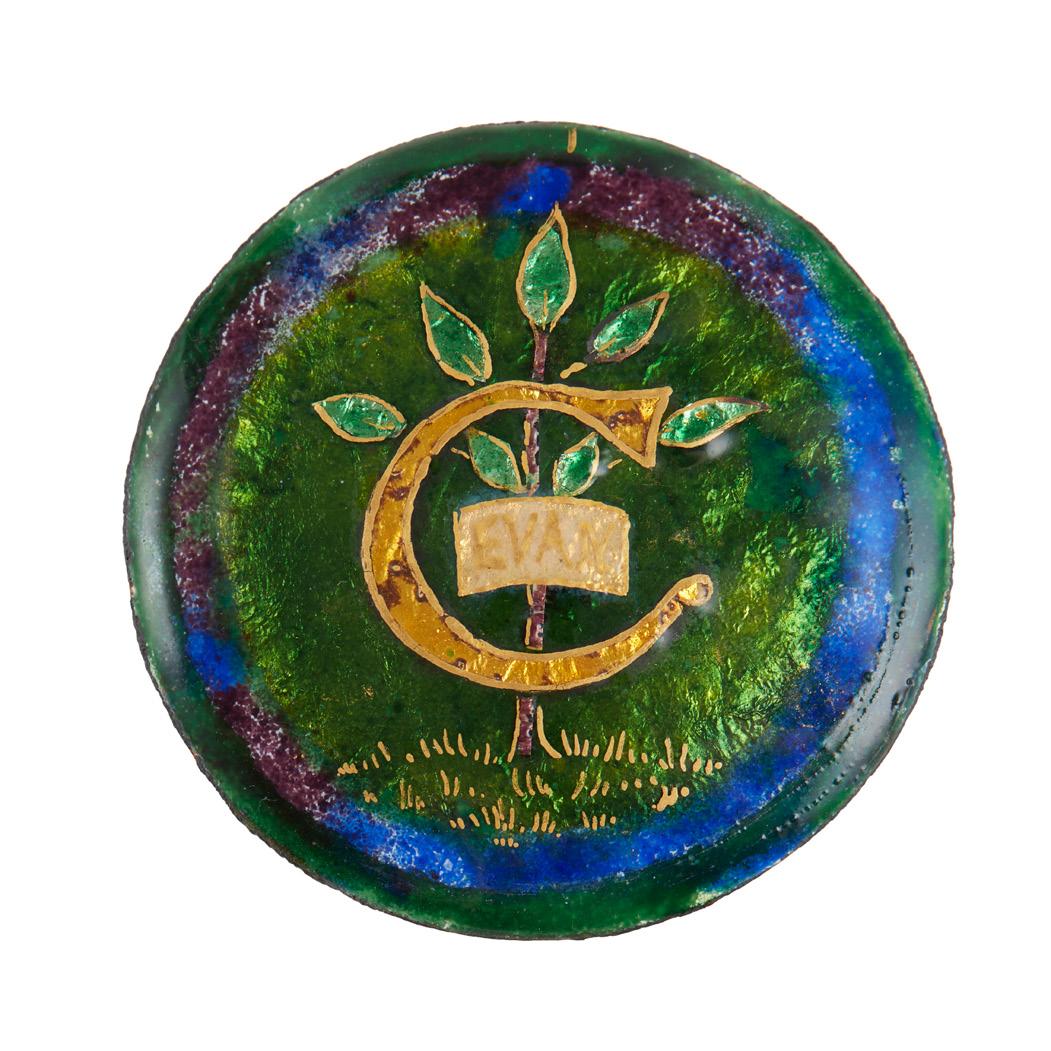
42.5cm diameter
Note: Clement Heaton, an early member of A.H. Mackmurdo’s Century Guild, set up his company Heatons Cloisonné‑Mosaic Ltd at 6 Berners Street, London in 1887, a year after selling his share in his father’s lucrative stained glass business Heaton, Butler & Bayne for £4,800. He patented his enamelling technique in 1886, inspired by medieval techniques that precluded the firing process and instead used coloured cements: a mixture of resin, beeswax, sulphur marble dust and coloured pigments. Hardening over time, these cements could be polished to give the soft matt finish characteristic of Heaton’s work.
£600‑800
107
CLEMENT HEATON (1861‑1940)
ARTS & CRAFTS JARDINIÈRE, CIRCA 1890 copper with applied cloisonné decoration

20cm high
£600‑800
105
45 Other fees apply in addition to the hammer price: see the ‘Buyer’s Guide’ section on page 2
109
ENGLISH, MANNER OF LIBERTY & CO., LONDON
ARTS & CRAFTS BOOKCASE, CIRCA 1900
oak, each shelf with hinged dust protectors

140cm wide, 145cm high, 35.5cm deep
£1,000‑1,500
108
CHARLES SPOONER (1862‑1938)
DESIGNS FOR A CHAPEL AT LETCHWORTH, HERTFORDSHIRE, CIRCA 1906

pen and ink, watercolour and graphite, inscribed to two CHARLES SPOONER F.R.I.B.A. ARCHITECT/ 23 OLD BUILDINGS LINCOLNS INN W.C. and to the third CHARLES SPOONER
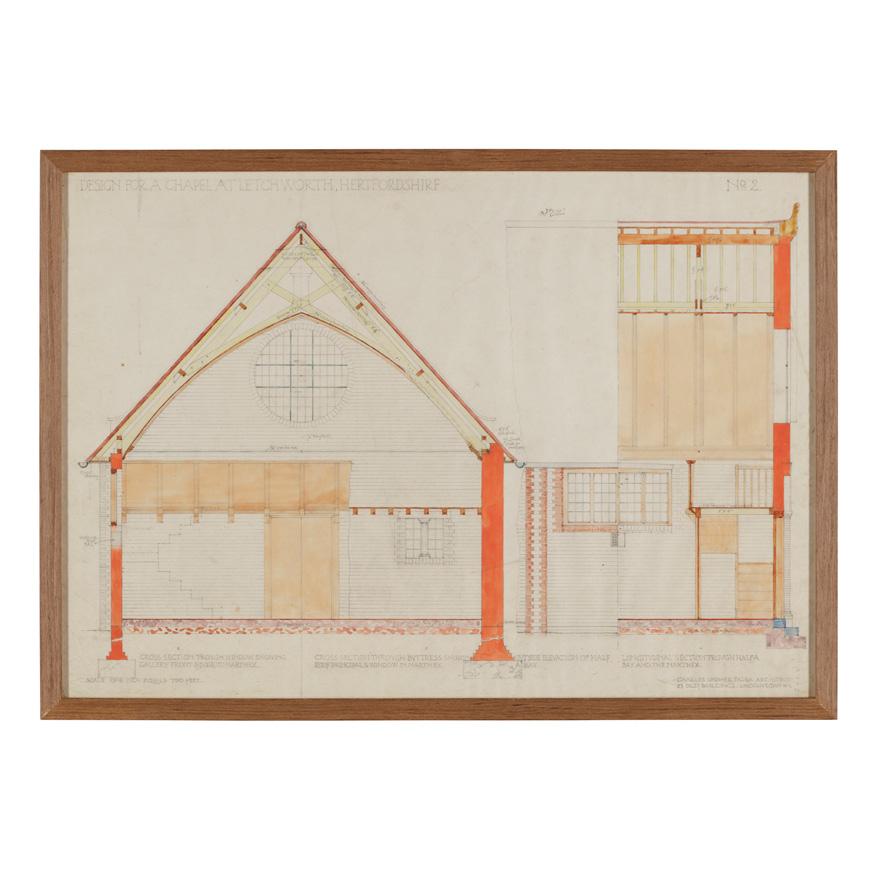
F.R.I.B.A. ARCHITECT/ 17 BEDFORD ROW LONDON W.C. (3)
46cm x 66cm
Note: These plans by Charles Spooner are designs for a church in Letchworth Garden City, St Hugh of Lincoln, 1907‑1908. Father Fortescue claimed it was the ‘only church worth looking at West of Constantinople’. C. R. Ashbee thought that Spooner was one of the four great names of the Arts and Crafts Movement, the other three being W. R. Lethaby, Sidney Barnsley and Ernest Gimson.
£800‑1,200

46
ENGLISH, MANNER OF SILVER STUDIO
DESIGN FOR WALLPAPER, 1897
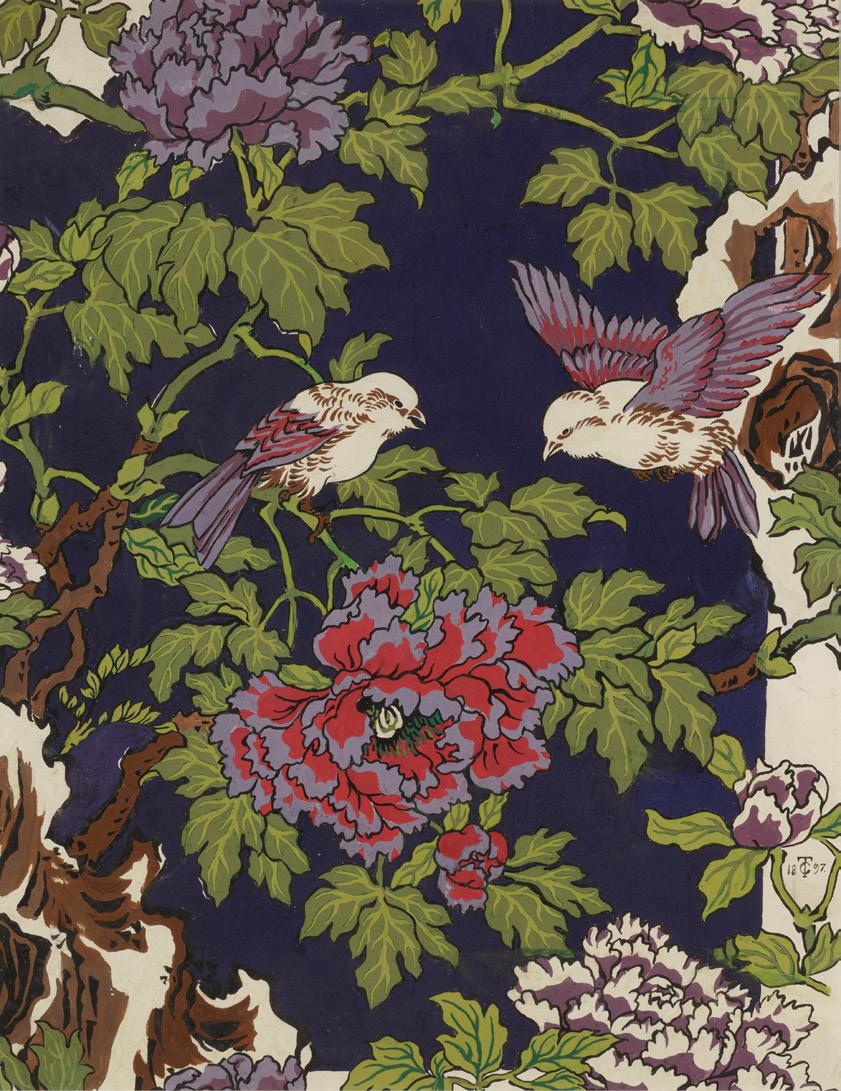
watercolour and bodycolour, signed and dated lower right TC/ 1897
50cm x 39cm
£300‑500
111
MARTIN BROTHERS
VASE, CIRCA 1905
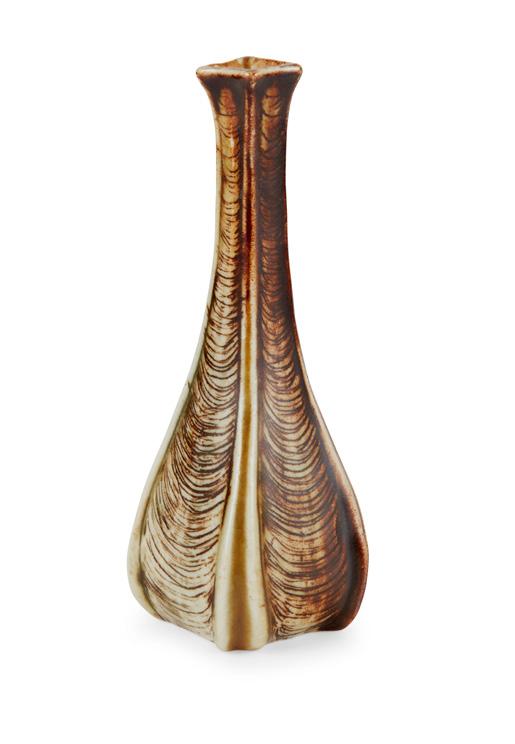
glazed stoneware, incised R.W. MARTIN & BROS./ LONDON & SOUTHALL
15.5cm high
£300‑500
112
MARTIN BROTHERS
MINIATURE VASE, DATED 1907
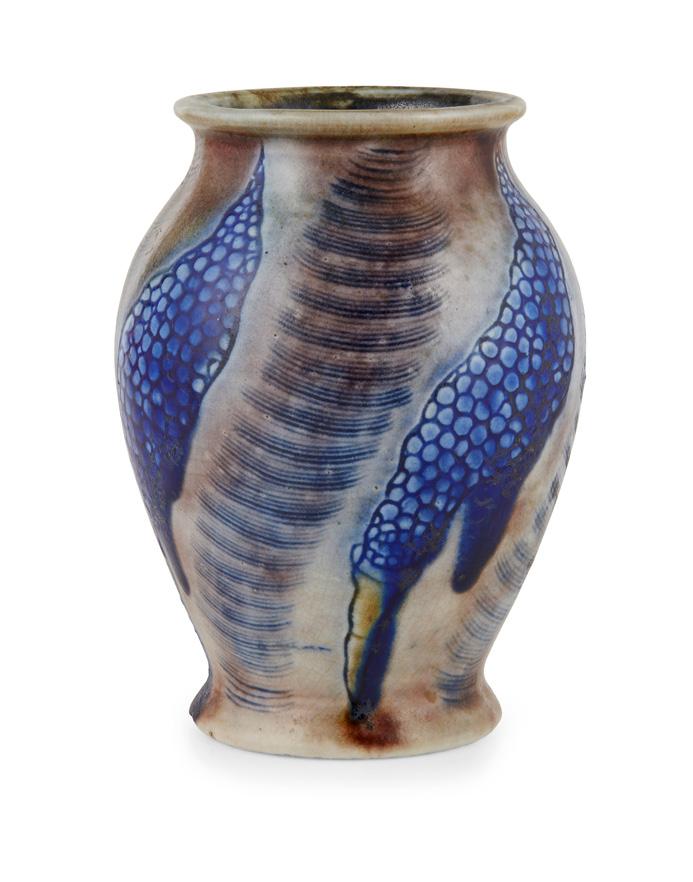
glazed stoneware, incised MARTIN BROS/ LONDON & SOUTHALL/ 7‑1907
12cm high
£600‑800
113
CASSANDRA ANNIE WALKER (1875‑1957) FOR DELLA ROBBIA POTTERY, BIRKENHEAD PLATE, 1897

glazed earthenware, incised DR/ 1897/ C.A.W.
20cm diameter
£500‑700
114
ENGLISH ARTS & CRAFTS DINING TABLE, CIRCA 1900
oak
137cm across, 74cm high, 76cm deep
£500‑800
115
RICHARD NORMAN SHAW (1831‑1912) (ATTRIBUTED DESIGNER) FOR MORRIS & CO.
ARTS & CRAFTS ‘TABARD’ ARMCHAIR, CIRCA 1900
mahogany, with later upholstered drop‑in seat, bears retailer’s ivorine label under seat rail, P. E. GANE/ COLLEGE STREET/ BRISTOL
64cm wide, 116cm high, 44cm deep
£300‑500
110
47 Other fees apply in addition to the hammer price: see the ‘Buyer’s Guide’ section on page 2
116
EDWARD SPENCER (1873‑1938) FOR THE ARTIFICERS’ GUILD CANDLE SCONCE, CIRCA 1910


electroplated metal
38cm tall, 31cm wide, 16cm deep £1,500‑2,000
117
W.A.S. BENSON (1854‑1924) FOR MORRIS & CO. DRAWING ROOM CABINET, CIRCA 1900

mahogany, satinwood, with verde antico marble, gilt brass mounts and glazed doors
135cm wide, 111cm high, 56cm deep
Literature: Morris & Co catalogue, Specimens of Furniture, Upholstery and Interior Decoration, circa 1900, p. 23, no.140 illus.
Hamerton I. W. A. S. Benson: Arts and Crafts Luminary and Pioneer of Modern Design, AAC 2005, p.159, pl.140‑142A where a similar cabinet is illustrated.
Note: Most of Benson’s furniture designs were made and retailed by Morris & Co. He became a director of Morris & Co. in 1896, following the death of his friend William Morris, and then became chairman in 1905. His furniture designs for Morris & Co. included desks and tables in oak, cabinets with marquetry inlay, and more expensive metal‑mounted tables and cabinets. These more flamboyant pieces used rare and expensive timbers and enabled the designer to showcase his skill in decorative metalwork. £10,000‑15,000
48

49 Other fees apply in addition to the hammer price: see the ‘Buyer’s Guide’ section on page 2
118
ENGLISH ARTS & CRAFTS EMBROIDERED PANEL CIRCA 1900 coloured silks on a silk woven ground
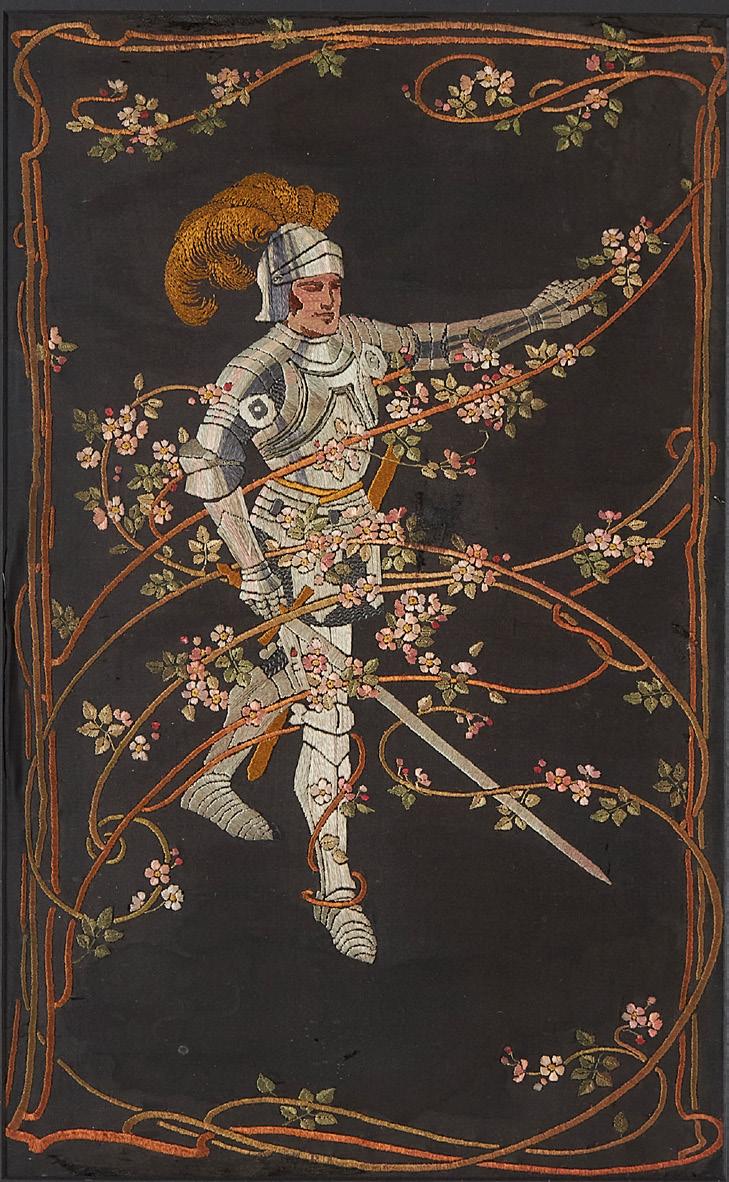
37.5cm x 23cm
£500‑700
119
C.R. ASHBEE (1863‑1942) FOR THE GUILD OF HANDICRAFT LTD. ARTS & CRAFTS PRESERVE SPOON, LONDON 1901 silver, set with chrysoprase, stamped maker’s mark, hallmarked London 1901

12cm long
£600‑800
120
C.R. ASHBEE (1863‑1942) FOR THE GUILD OF HANDICRAFT LTD. BUTTER KNIFE, LONDON 1900

silver, set with agate cabochon, rubbed maker’s marks, hallmarked London 1900
13.5cm long
£1,000‑1,500

50
121
JOHN PAUL COOPER (BRITISH 1869‑1933)
ARTS & CRAFTS CASKET, CIRCA 1907

silver metal and shagreen, wood‑lined interior
22cm wide, 8cm high, 10cm deep
£1,500‑2,000
122
CHARLES CUNDALL (1890‑1971)
FOR PILKINGTON TILE & POTTERY CO. LUSTRE VASE, DATED 1910

lustre‑glazed earthenware, painted artist’s monogram and date cypher, impressed factory mark
20cm high
£300‑500
123
WILLIAM S. MYCOCK (1872‑1950) FOR PILKINGTON’S TILE & POTTERY CO.
ROYAL LANCASTRIAN LUSTRE VASE, DATED 1927 lustre‑glazed earthenware, painted artist’s marks, impressed maker’s mark
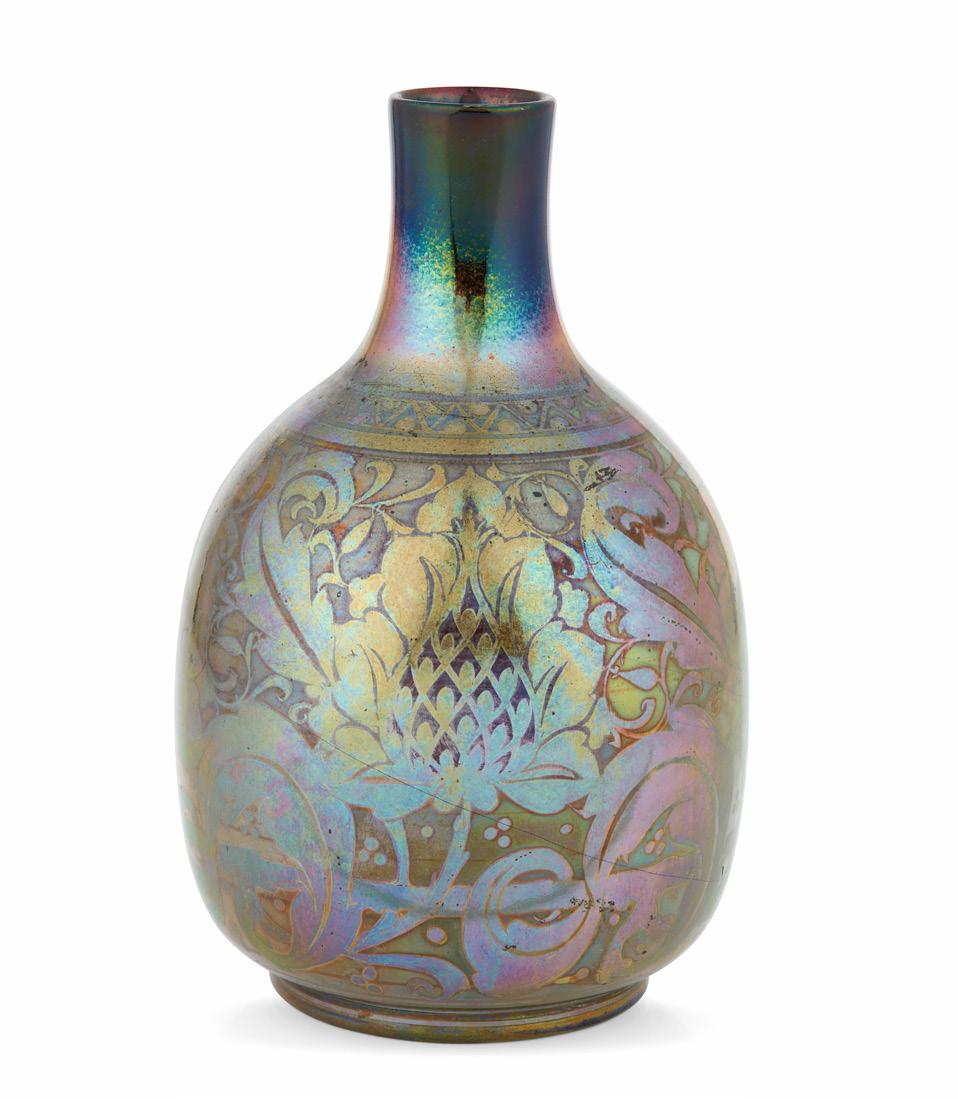
12cm high
£300‑500
124
W. A. S. BENSON (1854‑1924)
CHAMBERSTICK, CIRCA 1900
copper and brass, the repoussé engraved design by Heywood Sumner

22.5cm high
Literature: Hamerton I., W.A.S. Benson, Arts & Crafts Luminary & Pioneer of Modern Design, Woodbridge 2005, p.253, pl.23 and p.125 illus.
£300‑500
51 Other fees apply in addition to the hammer price: see the ‘Buyer’s Guide’ section on page 2
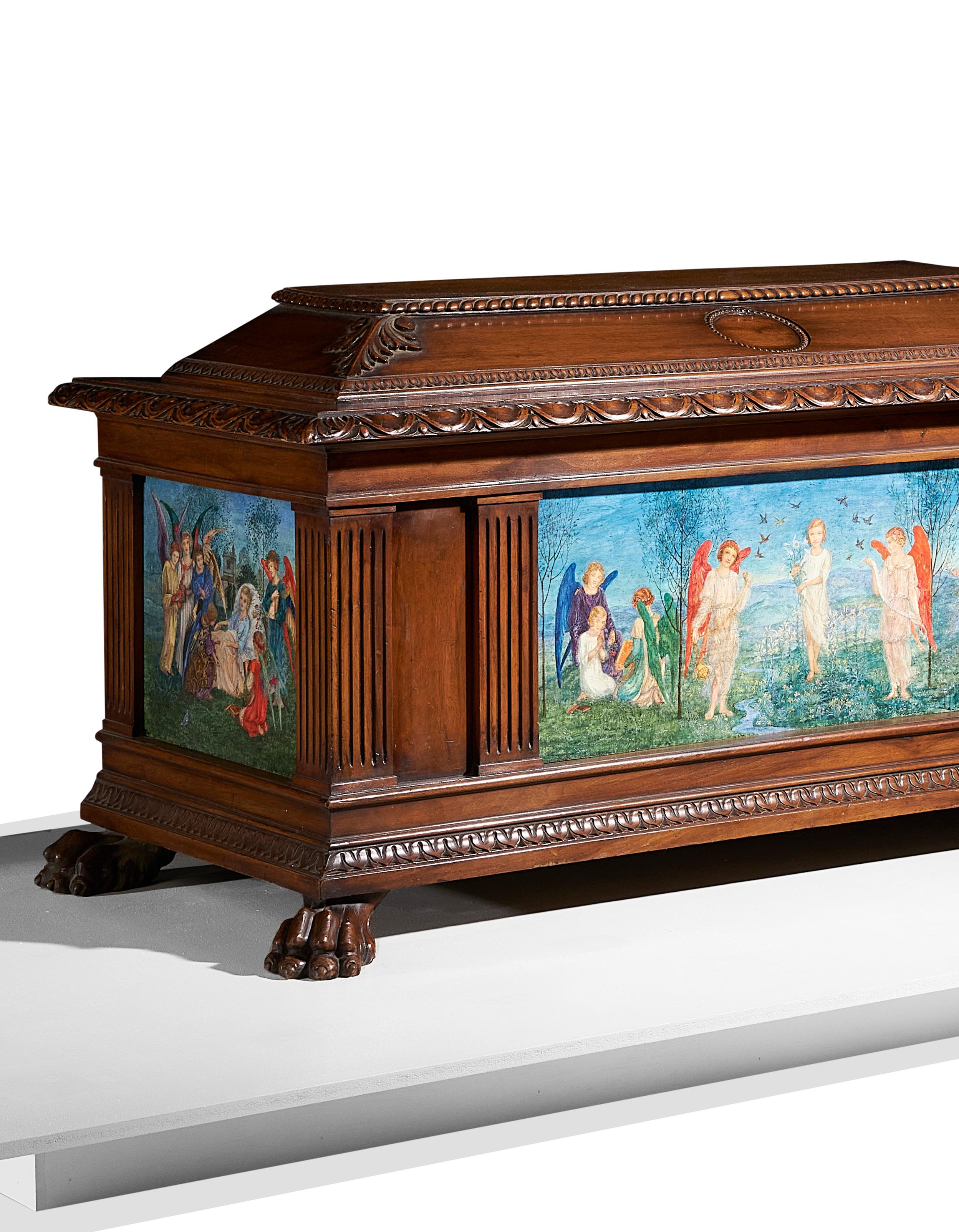

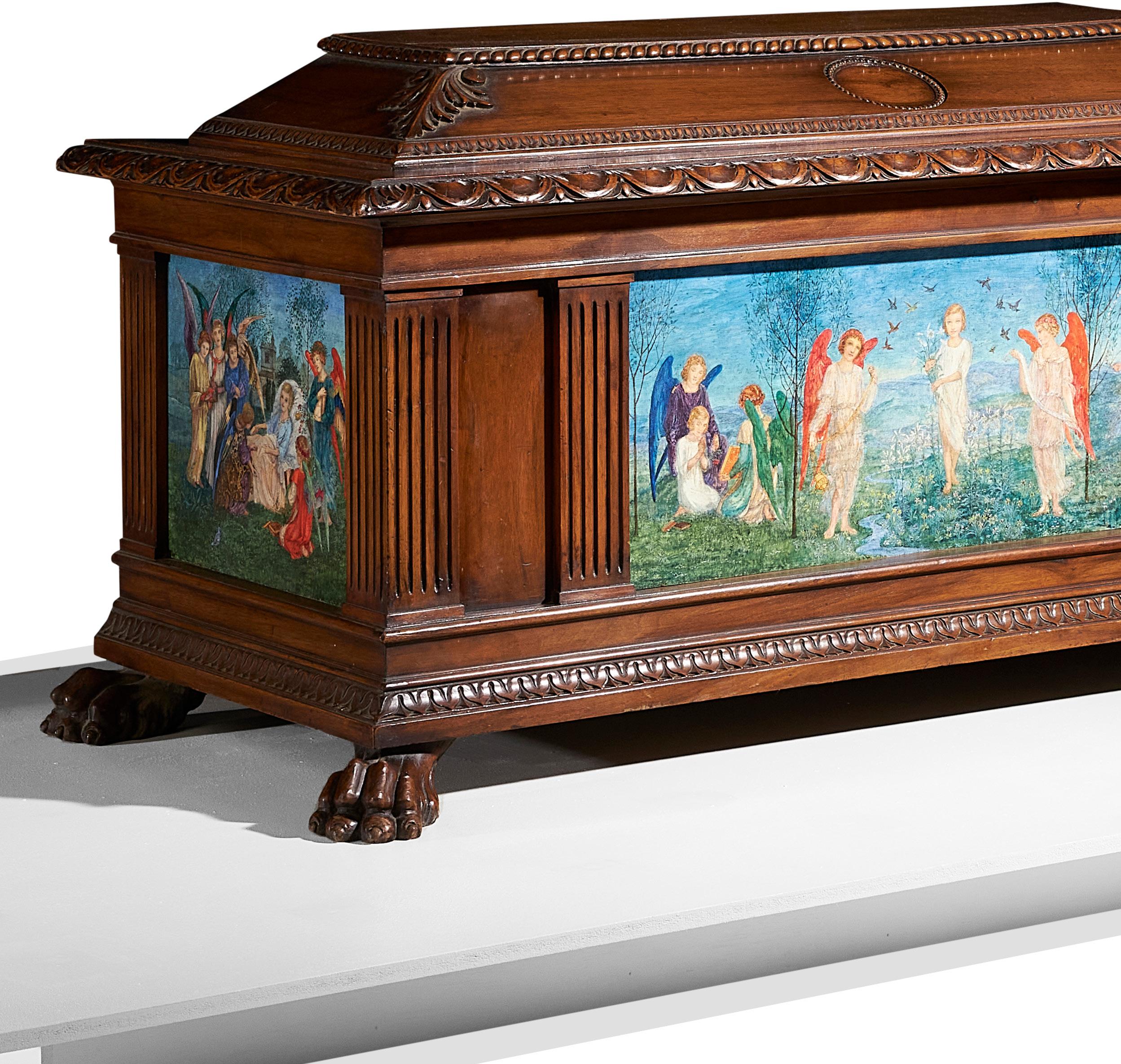
52
DAPHNE ALLEN (1899‑1985)
ARTS & CRAFTS CASSONE, CIRCA 1920
walnut, inset with allegorical panels, Visited by Angels, Gathering Spring Flowers, and Among Children, oil on board, the front panel signed DAPHNE ALLEN
The cassone 143cm wide, 66cm high, 60cm deep; the central panel 29.2cm x 72.4cm, the side panels each 29.2cm x 35.5cm

Note: Daphne Allen was the daughter of Hugh Allen, and possibly the granddaughter of Ruskin’s publisher George Allen. She was educated at Streatham College for Girls and continued to live in that area of South London into adulthood. While still a child, Allen produced watercolours inspired by the New Testament, published in 1912 by George Allen as A Child’s Visions. The same year, they were exhibited as A Child’s Visions and Fancies at the Dudley Galleries. In 1913, a second group was published as The Birth of the Opal; A Child’s Fancies, and again exhibited at the Dudley Galleries.
Through her teens, Allen illustrated volumes by other authors for Headley Brothers: John Oxenham’s The Cradle of Our Lord (1916), A Garden of Love from Herrick & the Other Poets of the 17th Century (1917), and Janet Dykes and Christine Standing’s
The Man Who Chose Poverty – The Story of St Francis (1917). She also exhibited alongside Annie French and others at the Burlington Gallery in December 1919. Later exhibitions include one of ‘landscapes and imaginative watercolours’ at B F Stevens & Brown (1928) and another of paintings at the Little Burlington Gallery (1937).
Her further activities included painting memorials (including one for Christ Church, Newcastle, New South Wales), designing stained glass (for Scotby Church, Northumberland), and producing drawings for the Illustrated London News (at least until the end of 1952).
£10,000‑15,000
125 §
53 Other fees apply in addition to the hammer price: see the ‘Buyer’s Guide’ section on page 2
ENGLISH SCHOOL
‘YESTREEN I GATHERED ROSES THREE...’ pen and ink, watercolour and graphite on vellum, signed lower right with initials DMW 26cm x 18.5cm
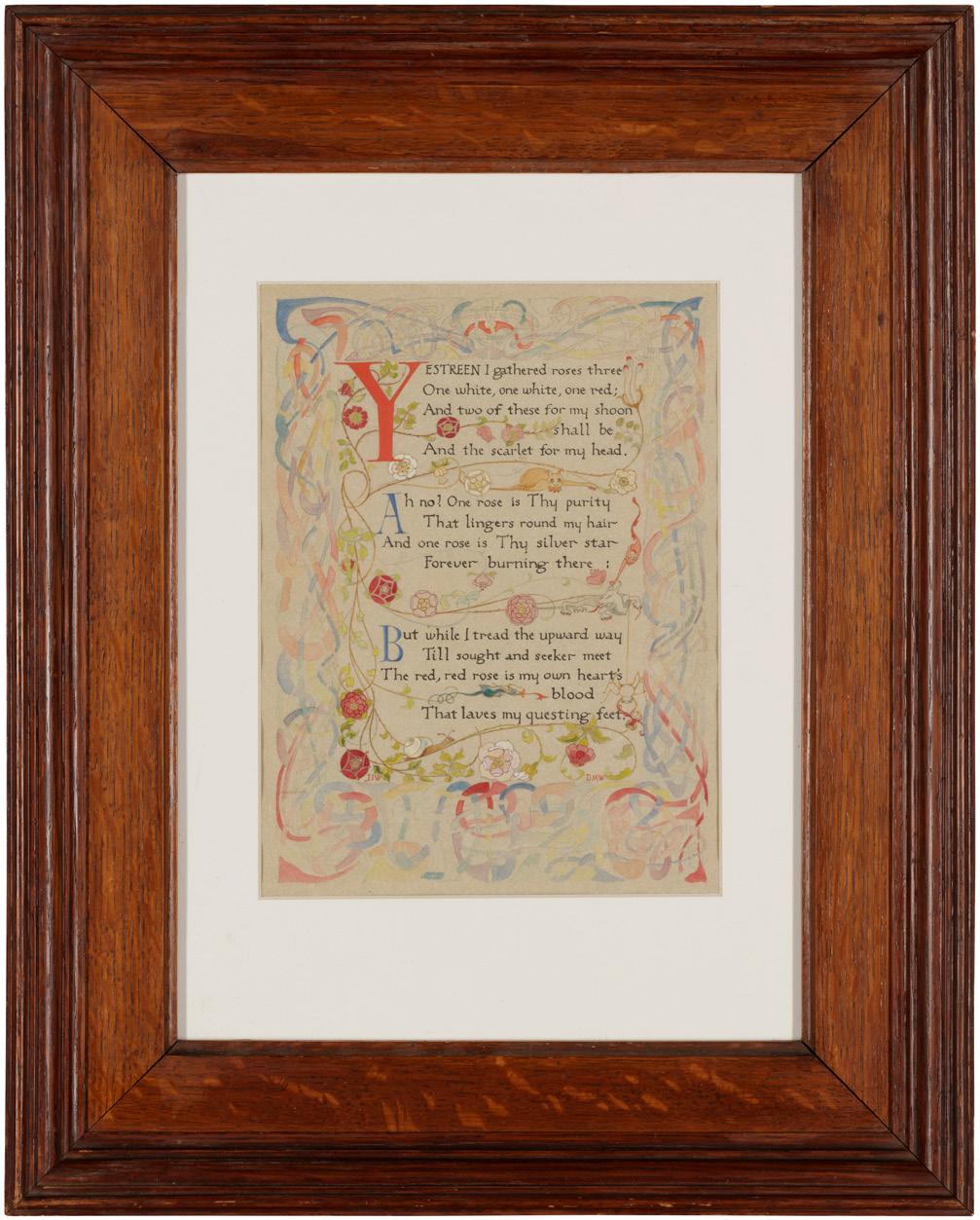

127
ENGLISH ARTS & CRAFTS ‘GALLEON’ CENTREPIECE, CIRCA 1910 white metal, enamel, shell, coloured stones
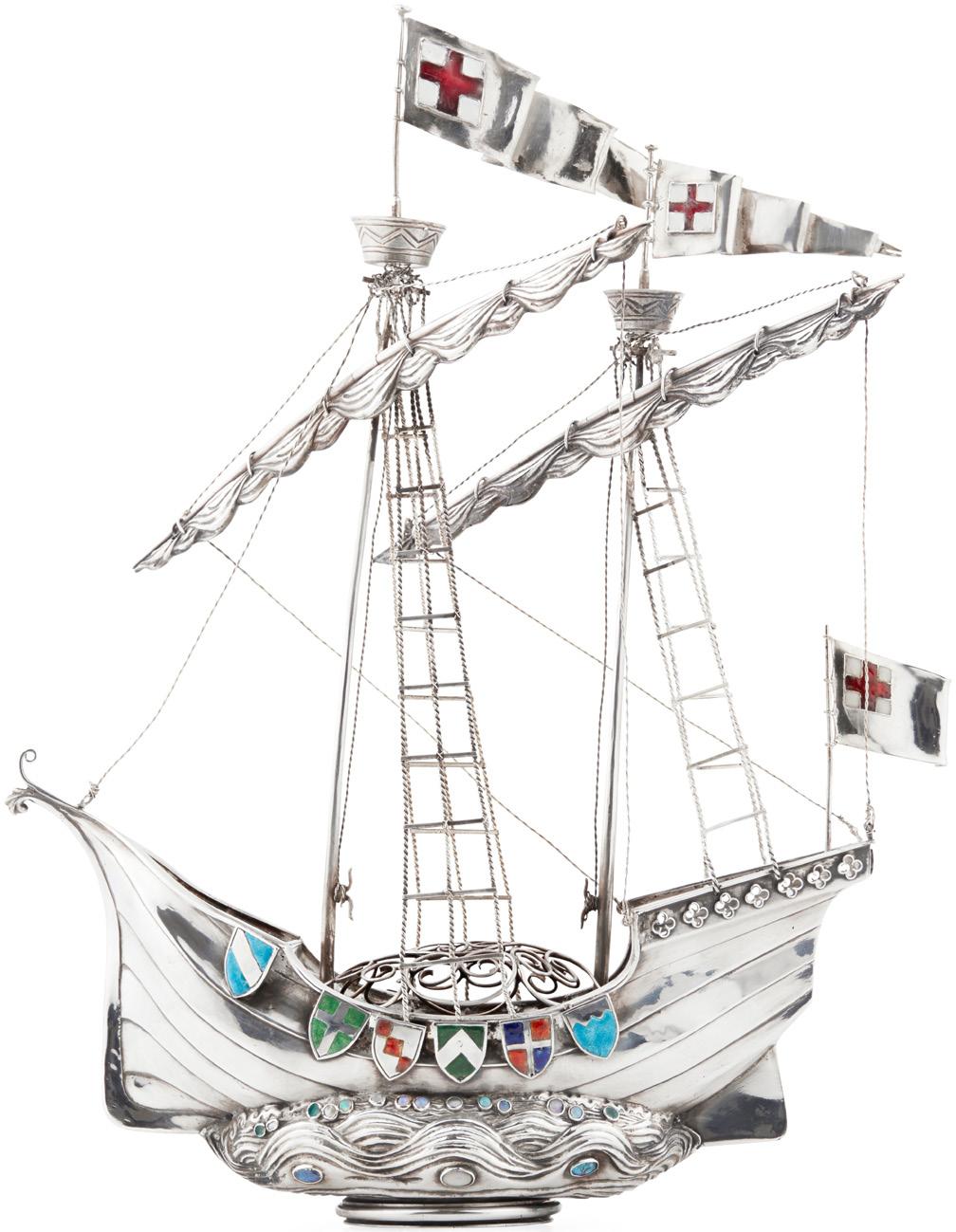
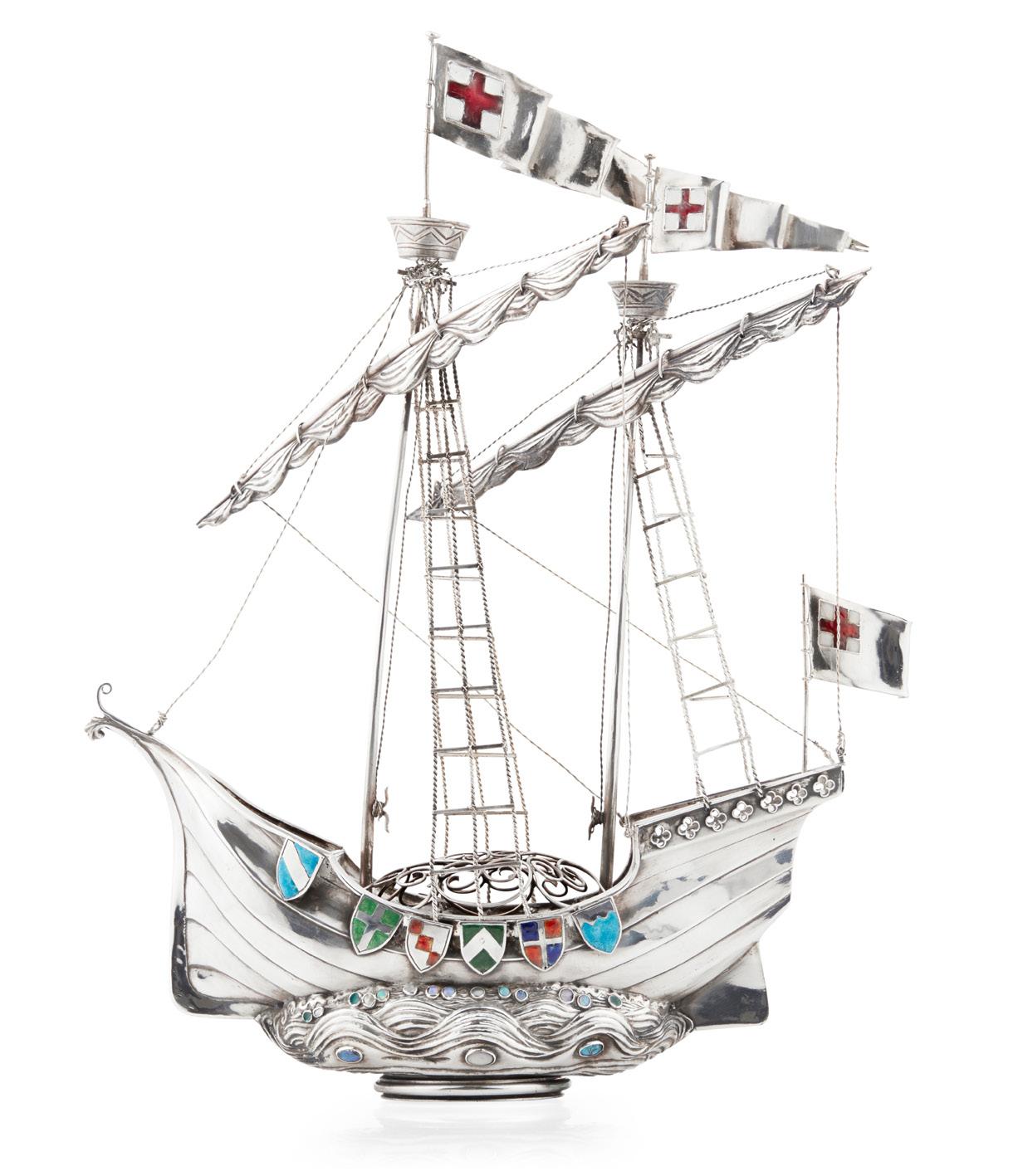
40cm high
£2,000‑3,000
128
MANNER OF HEAL & SON
ARTS & CRAFTS CENTRE TABLE, CIRCA 1920 oak
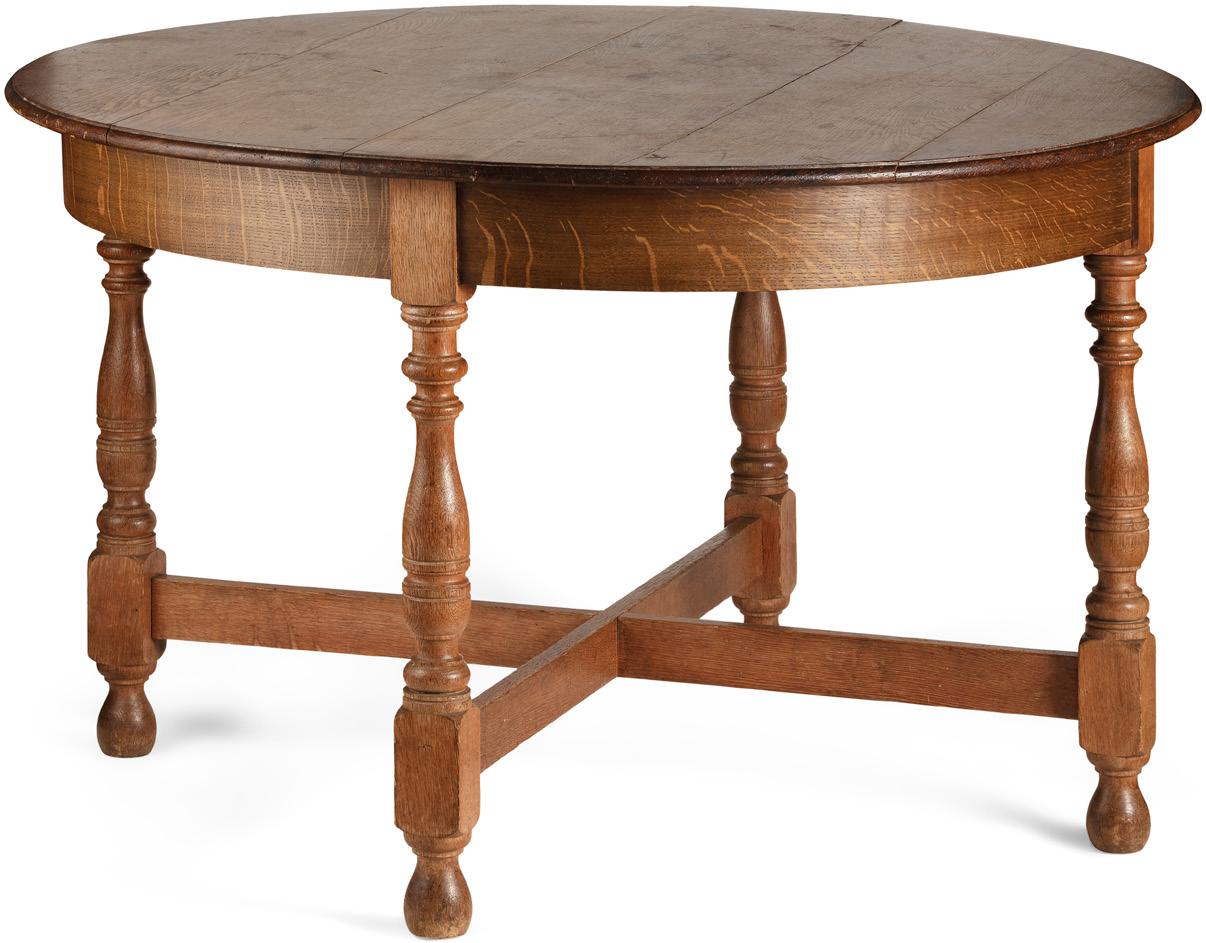

121cm diameter, 76cm high
£500‑800
54
129
ENGLISH
ARTS & CRAFTS EMBROIDERED PANEL CIRCA 1900 coloured silks on an unbleached linen ground, presented in a period frame

17.5cm x 132cm
£500‑800
ENGLISH
ARTS & CRAFTS
‘CAMBRIDGE UNIVERSITY’ BOOKCASE, CIRCA 1910 oak, fitted with cast metal shield and later‑adapted glazed door

59.5cm wide, 120cm high, 30cm deep
£400‑600
130
MARY R. PERCY (DESIGNER)
ARTS & CRAFTS WALL SHELVES, DATED 1904 carved oak, 99cm wide, 67.5cm high, 12cm deep; together with a NORTHUMBERLAND HANDICRAFTS GUILD MEDALLION 1905‑07, silvered metal, within original case, inscribed MARY R. PERCY 1905‑07, 5cm diameter, and a PHOTOGRAPH OF THE MAKER

£300‑500
132
ENGLISH THREE PAIRS OF ARTS & CRAFTS CURTAINS, CIRCA 1900 printed velvet, lined (6) each panel approx. 324cm x 152cm
£500‑800
133
ENGLISH TWO PAIRS OF ARTS & CRAFTS CURTAINS, CIRCA 1900

woven cotton, with applied braid, lined (2)
254cm drop, 171cm wide
£500‑800
55 Other fees apply in addition to the hammer price: see the ‘Buyer’s Guide’ section on page 2
135
ENGLISH
ARTS & CRAFTS OVERMANTEL MIRROR, CIRCA 1910

oak, with bevelled mirror plate, carved inscription TOIL COMES WITH THE MORNING AND REST WITH THE NIGHT
137cm wide, 76cm high, 14cm deep
£300‑500
137
ENGLISH, MANNER OF MORRIS & CO. ARTS & CRAFTS EMBROIDERED PANEL, DATED 1888
silk threads on a cotton ground, silk satin border and backing, embroidered with inscription VGG/ 1888 in silk and gold threads
panel 88.5cm x 144cm, total 123cm x 179cm
£300‑500
JESSON, BIRCKETT & CO
ARTS & CRAFTS WALL LIGHT, CIRCA 1900
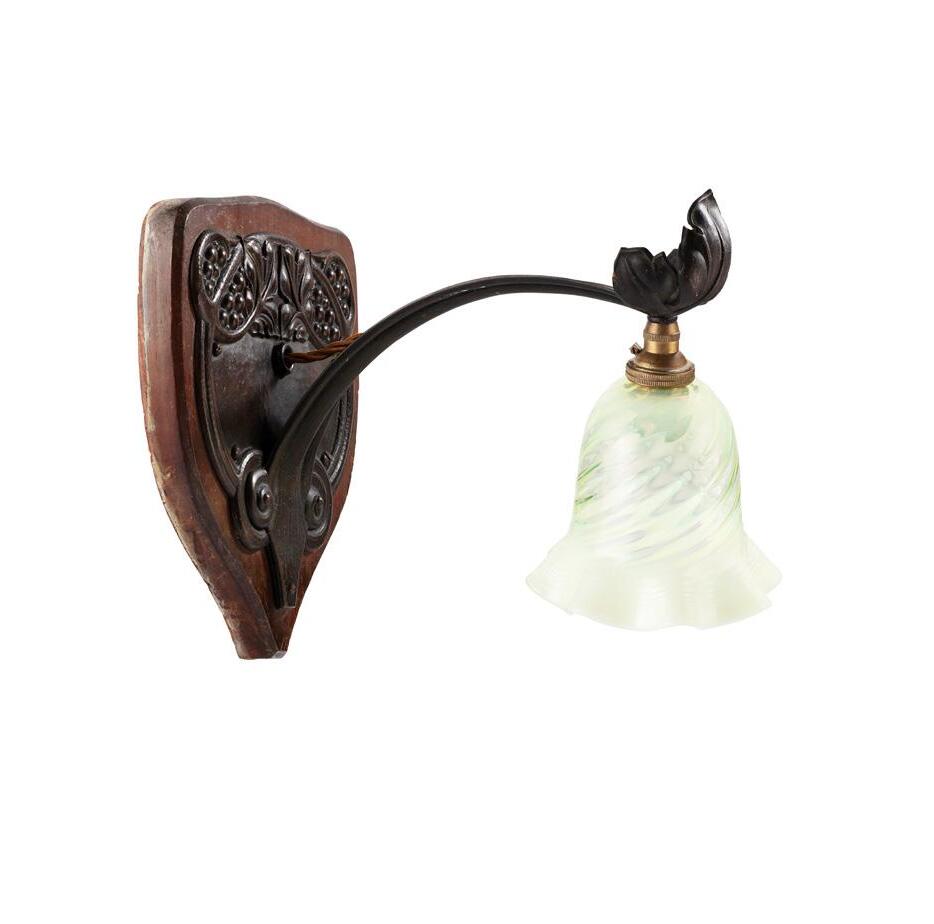
patinated copper, on a stained pine back plate, with associated but period opalescent glass shade back plate 22cm tall, 28cm deep approx.
£400‑600
136
ENGLISH
ARTS & CRAFTS TRIPTYCH, DATED 1912

embossed and coloured leather, within walnut frame, bears paper label verso Property of A. Neville‑Rolfe, Lt. 5th Gurkhas/ Leather panel by Ada Neville‑Rolfe/ Beacham, Norfolk/ Framed by The Sandringham
Workshops 1912
with frame 91cm x 131.5cm
Note: The Sandringham workshops were established by Princess Alexandra, later Queen Alexandra, following her marriage in 1863 to Edward, Prince of Wales, later Edward VII. Originally intended as a ‘Technical School of Woodwork’ for the children of the Estate workers, it later became Her Majesty Queen Mary’s ‘Carving School’ for ex‑servicemen and local workers. Items produced were retailed at Sandringham and through various London department stores and shown at the Ideal Home Exhibitions.
£300‑500
138 §
ROBIN TANNER (1904‑1988)
MARTIN’S HOVEL
Etching, 13/50, signed and numbered in pencil, unframed
30cm x 34cm
Provenance: Mallams, Oxford, 8th December 2016, lot 614.
Note: From the edition published by the Penn Print Room in 1974.
£200‑300
139
ENGLISH ARTS & CRAFTS
FIREPLACE
SURROUND, CIRCA 1900
repoussé‑decorated brass
exterior 69cm x 97cm, interior 40cm x 65cm
£500‑700
140
ENGLISH, MANNER OF W. A. S. BENSON
TWO ARTS & CRAFTS
TABLE LAMPS, CIRCA 1900
brass and patinated metal, each with associated opalescent glass shades (2)
47cm and 37cm high
£300‑500
134
56 Other fees apply in addition to the hammer price: see the ‘Buyer’s Guide’ section on page 2

57
141
C.F.A. VOYSEY (1857‑1941) FOR PILKINGTON’S TILE & POTTERY CO. ARTS & CRAFTS TILE, CIRCA 1920
glazed earthenware
15.5cm square
Literature: Blanchett C. 20th Century British Tiles, Schiffer Publishing 2006, p. 455 where a similar tile is illustrated. Livingstone K. et al C.F.A. Voysey Arts and Crafts Designer, V&A Publishing, p. 292, pl. 385 where designs for related tiles are illustrated.
£1,000‑1,500
142
C.F.A. VOYSEY (1857‑1941) FOR PILKINGTON’S TILE & POTTERY CO.
ARTS & CRAFTS TILE, CIRCA 1920
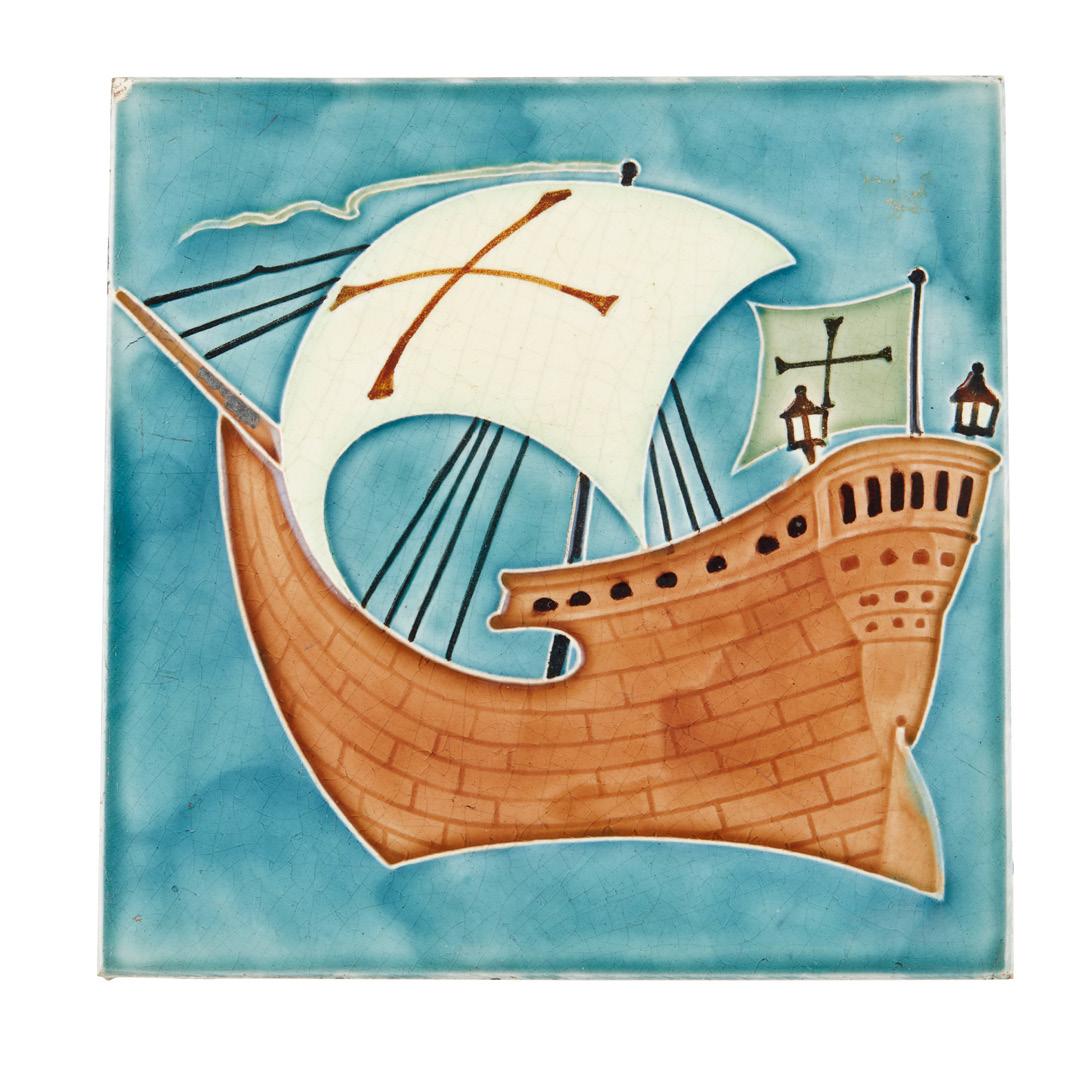

glazed earthenware
15.5cm square
£600‑800
143
C.F.A. VOYSEY (1857‑1941) FOR PILKINGTON’S TILE & POTTERY CO. ARTS & CRAFTS TILE, CIRCA 1920

glazed earthenware
15.5cm square
£600‑800
58 Other fees apply in addition to the hammer price: see the ‘Buyer’s Guide’ section on page 2
144
C.F.A. VOYSEY (1857‑1941) (DESIGNER), ARTHUR W. SIMPSON (1857‑1922) (ATTRIBUTED MAKER)
ARTS & CRAFTS MIRROR, CIRCA 1906

oak, glass, patinated brass 58cm wide, 55.5cm high, 19.3cm deep
Provenance: The Essex & Suffolk Equitable Insurance Company, Capel House, New Broad Street, London (for whom made)
E. H. Brooks Esq.
The Victorian Society Private Collection
Exhibited: 1. C.F.A. Voysey: architect and designer 1857‑1941, Brighton Art Gallery & Museum, 11th July‑3rd September 1978; Wolverhampton Art Gallery, 8th January ‑ 12th February 1979; Glasgow City Art Gallery, 5th April
‑ 27th May 1979, exhibit no. C7
2. From Arts and Crafts to the Bauhaus, Bröhan‑Museum, Berlin, 24th January ‑ 5th May 2019, exhibit no. 27
Literature: Decorative Kunst, volume I, 1897, p. 258
The Artist, volume XXVI, 1899, p. 178
The Studio, volume XVIII, 1899, p. 45
Livingston, K., Max Donnelly, M., Parry, L. C.F.A. Voysey, Arts and Crafts designer V&A 2016, p. 178
Note: This mirror formed part of the furnishings designed for the offices of The Essex & Suffolk Equitable Insurance Company commissioned from Voysey in 1906 by General Manager Sydney Claridge‑Turner. Voysey also designed ‘The Homestead’ and Frinton‑on‑Sea for Turner in 1905 and the mirror may have first been used there. The insurance company offices were taken over by stockbroker Chase, Henderson and Tennant who retained the furnishings and fittings. When some Voysey furnishings were stripped out of the premises in the 1960s, one of the partners, E.H. Brooks, found suitable homes for as many pieces as possible. Recipients included Charles and Lavinia Handley‑Read, the Victoria & Albert Museum and the William Morris Gallery. The Victorian Society received a side table and the mirror being sold in this lot.
Original drawings for this mirror in the RIBA collections are dated 1906 and 1908 (versions with one and two knobs on each drawer) and include examples with mouldings around the drawers, as in the current lot, which has a RIBA reference SB116/VOY [392]. This mirror matches another example illustrated in the bedroom of Holly Mount, a house designed by Voysey in Buckinghamshire, and photographed in 1907. Contemporary photographs in The Studio and Decorative Kunst show examples of mirrors in other styles made in the 1890s.
£5,000‑7,000
59


Lot 145 60
C. F. A. VOYSEY (1857‑1941) FOR TOMKINSON & ADAM LTD., KIDDERMINSTER
FRAMED DESIGN FOR A CARPET, DATED 1900
watercolour on four conjoined sheets of squared paper, depicting garden flowers in a repeat pattern, each sheet signed verso C. F. A. VOYSEY ARCHITECT/ 6 CARLTON HILL N.W. and with printed Tomkinsons Carpets Ltd. stamp
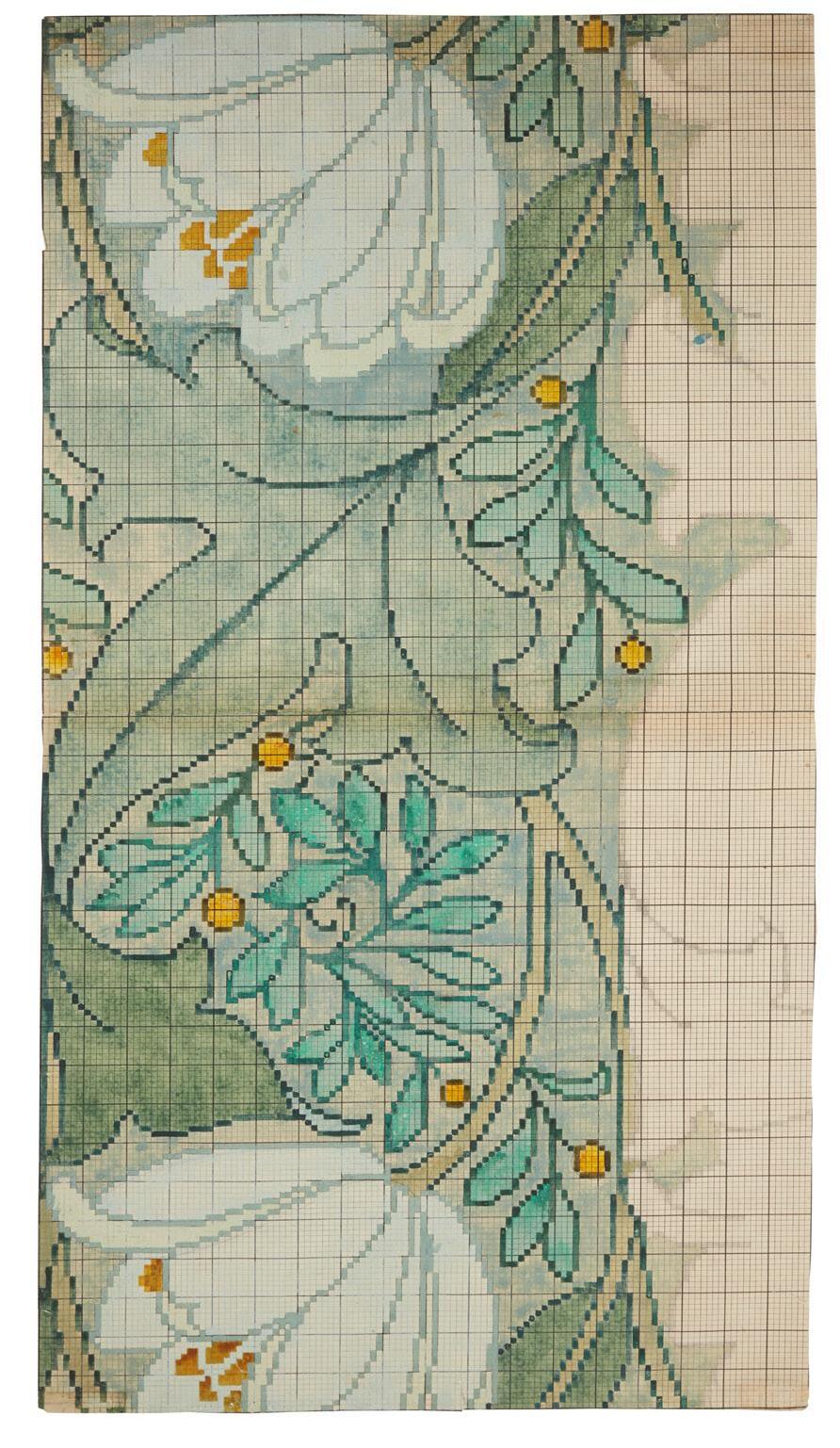
77.5cm x 67.5cm
Exhibited: The Fine Art Society et al, London C.F.A. Voysey: Designs for Tomkinson & Adam Carpets, 2013, no. 31 (‘Garden Design (Four Sheets)’)
Literature: Durant S. The Decorative Designs of C.F.A. Voysey, Lutterworth Press 2017, p. XX, no. 56 illus.
Note: Carpet designs by Voysey for Tomkinsons were designed to set up a Jacquard weaving machine. The colour sequence would have been transferred to a sequence of punched cards by a technician, who would use, in this instance, 14 strands of different coloured wools to produce the design shown. Each minute square represents a single carpet tuft.
£10,000‑15,000
Illustrated left.
146
C. F. A. VOYSEY (1857‑1941) FOR TOMKINSON & ADAM LTD., KIDDERMINSTER
DESIGN FOR A CARPET, 1899
watercolour and graphite on two conjoined sheets of squared paper, depicting a floral repeat design, signed and dated in ink verso C. F. A. VOYSEY/23 YORK PLACE/ BAKER ST./ W NOV 3 1899, bears printed Tomkinsons Carpets Ltd. stamp
46cm x 92cm
Exhibited: The Fine Art Society, et al, London C.F.A. Voysey: Designs for Tomkinson & Adam Carpets, 2013, no. 14 (‘Floral Design’)
£3,000‑5,000
147
C. F. A. VOYSEY (1857‑1941) FOR TOMKINSON & ADAM LTD., KIDDERMINSTER
‘THE SWALLOW’, DESIGN FOR A CARPET, 1898
watercolour and graphite on squared paper, depicting a bird on a branch, signed and inscribed in ink C. F. A. VOYSEY/ ARCHT/ 6. CARLTON HILL. N.W./ THE SWALLOW, JULY 15, 1898 and with inscribed colour key, bears printed Tomkinsons Carpets Ltd. stamp verso
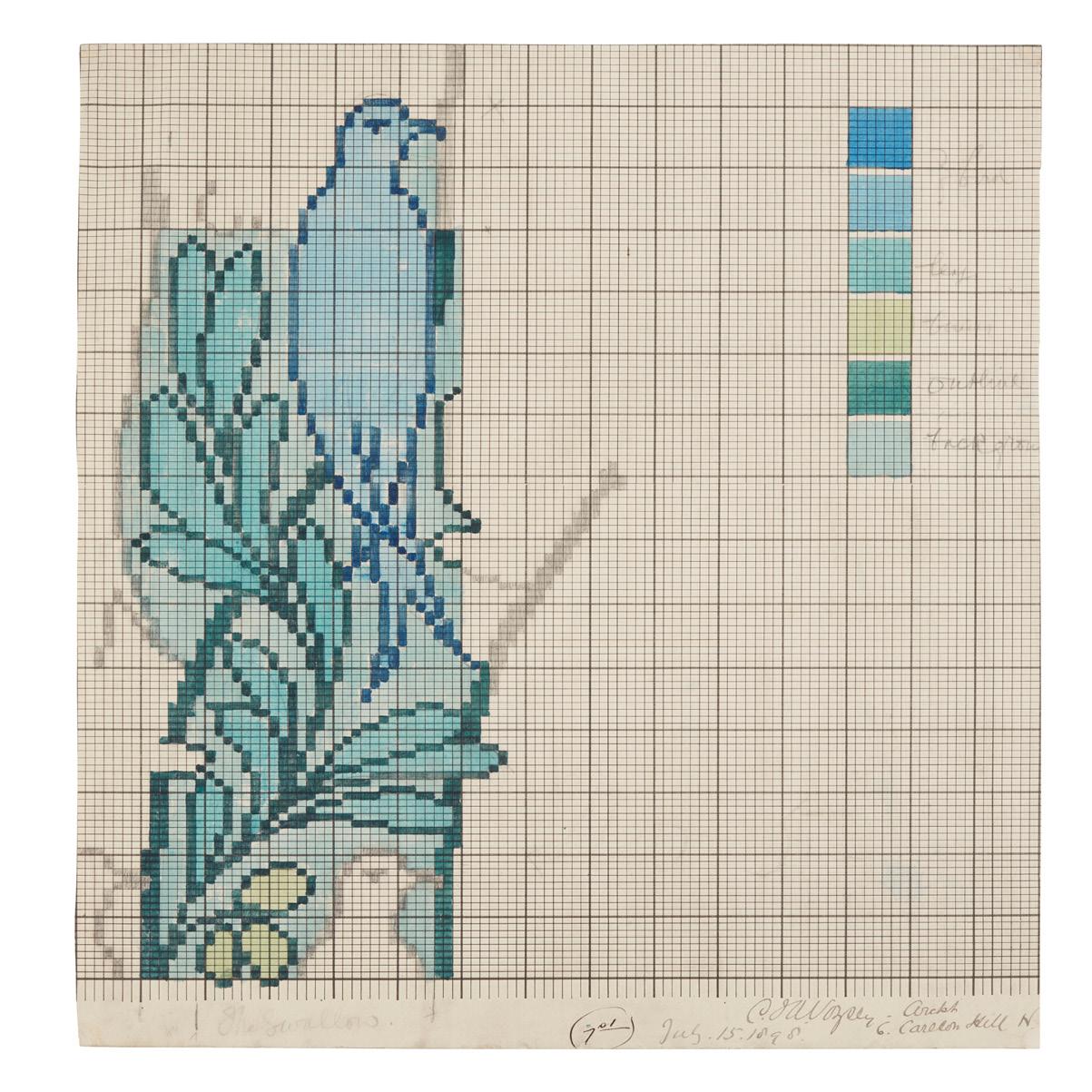
41cm x 38cm
Exhibited: The Fine Art Society et al, London C.F.A. Voysey: Designs for Tomkinson & Adam Carpets, 2013, no. 8 (‘Dove and Olive Branch’)
£2,000‑3,000
145
61 Other fees apply in addition to the hammer price: see the ‘Buyer’s Guide’ section on page 2
148
C. F. A. VOYSEY (1857‑1941) (ATTRIBUTED DESIGNER)
FURNISHING FABRIC PANEL, CIRCA 1890
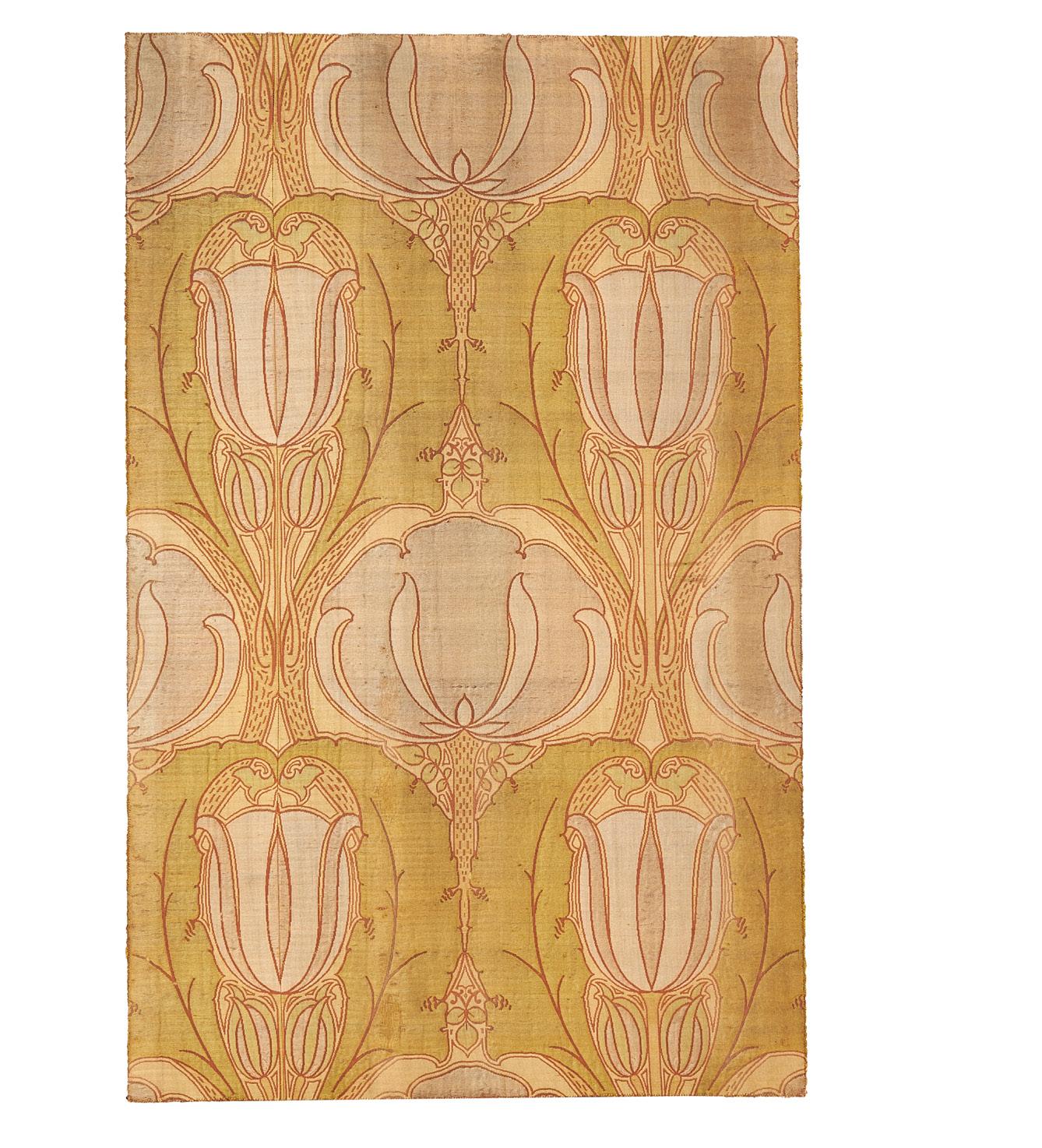
woven cotton, stitched onto board with later fabric backing, unframed 114cm x 72cm
£400‑600
151
C.F.A. VOYSEY (1857‑1941) FOR PILKINGTON’S TILE & POTTERY CO.
PAIR OF ARTS & CRAFTS TILES, CIRCA 1920
glazed earthenware, moulded P to reverse (2) each 15.5cm square
£200‑300
149
C.F.A. VOYSEY (1857‑1941) FOR THOMAS ELSLEY & CO. HANDLE, CIRCA 1900
brass, stamped ELSLEYS
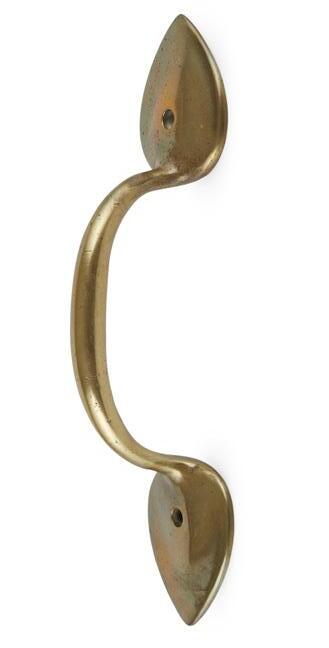
21.5cm long
£300‑500
150
SILVER STUDIOS (ATTRIBUTED TO)
PAIR OF ARTS & CRAFTS CUSHIONS, THE MATERIAL CIRCA 1900
woven wool with later linen backing and stuffing (2) each 39cm x 57cm
£300‑500
152
SILVER STUDIO (ATTRIBUTED TO)
PAIR OF ARTS & CRAFTS CUSHIONS, THE MATERIAL CIRCA 1900
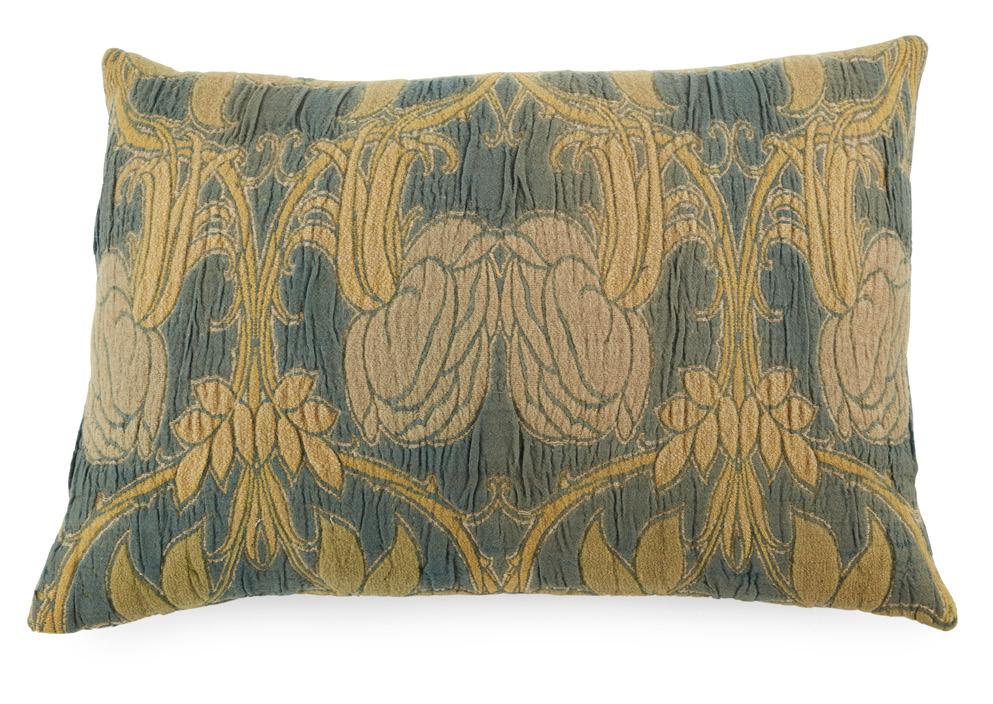
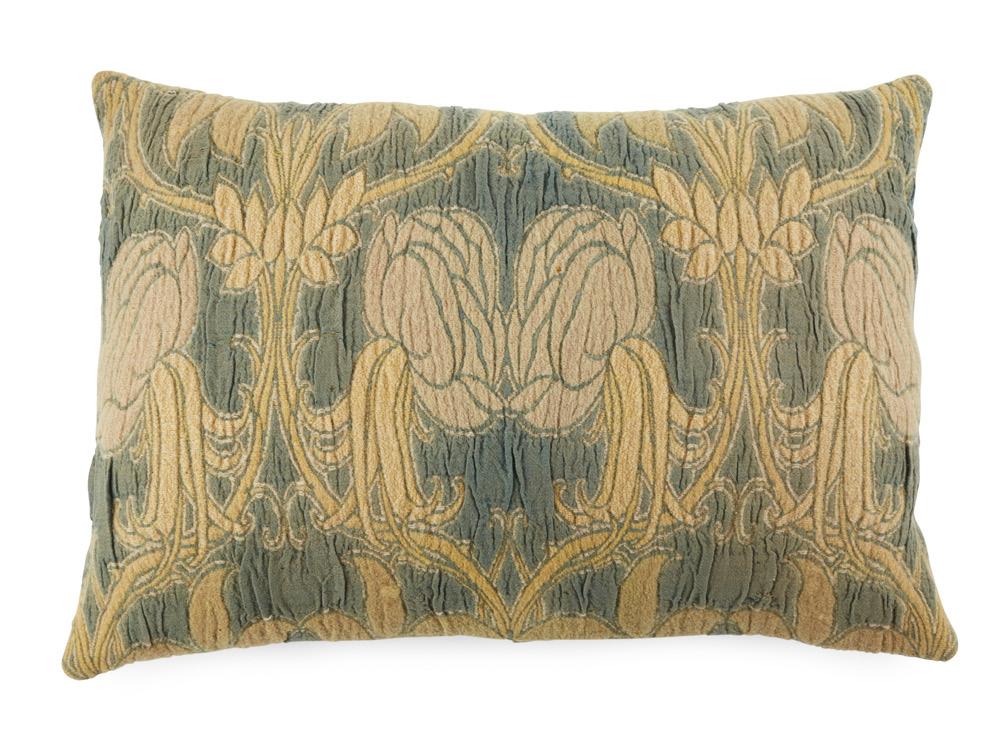
woven wool with later linen backing and stuffing (2) each 39cm x 57cm
£300‑500
62 Other fees apply in addition to the hammer price: see the ‘Buyer’s Guide’ section on page 2
C. F. A. VOYSEY (1857‑1941) FOR ARTHUR H. LEE & SONS, BIRKENHEAD
RARE FABRIC PANEL, CIRCA 1890

woven wool, later frame
29cm x 61cm
£300‑500 154
C.F.A. VOYSEY (1857‑1941) (DESIGNER), F. C. NIELSON, LONDON (ATTRIBUTED MAKER) ARTS & CRAFTS ARMCHAIR, CIRCA 1905 oak, with drop‑in rush seat 61.3cm wide, 98.5cm high, 51cm deep


Literature: Livingstone K., Donnelly M., and Parry L
C.F.A. Voysey, Arts & Crafts Designer V&A 2016, pp.194‑5, plates 248 and 249 where similar examples of this chair are illustrated.
£2,000‑3,000
153
63
ARTHUR W. SIMPSON (1857‑1922), KENDAL ARTS & CRAFTS ARMCHAIR, CIRCA 1910
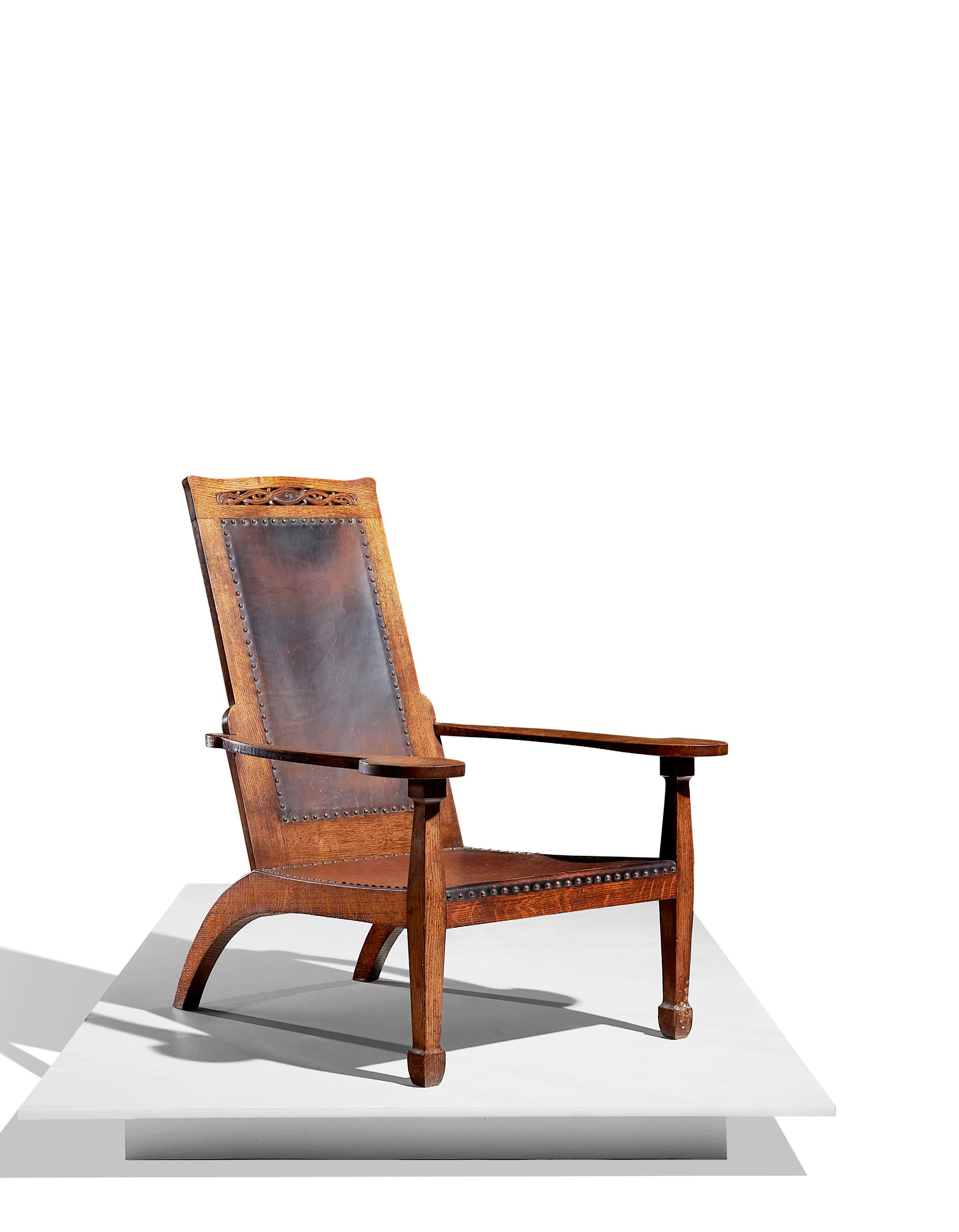
oak, with close‑nailed leather upholstery, together with the book The Simpsons of Kendal: Craftsmen in Wood 1885‑1952, by Eleanor Davidson, published University of Lancaster 1978 (2)
73cm wide, 98cm high, 54cm deep
Provenance: Inherited by the current vendor from Barbara Henderson, the niece of Arthur Simpson.
Literature: Davidson E. The Simpsons of Kendal: Craftsmen in Wood 1885‑1952, University of Lancaster 1978, p. 72, fig. 11 where a view of the 1st‑floor showroom, circa 1912, appears to show an example of the current lot in the display.
Note: After honing his skills during an early apprenticeship with Gillows of Lancaster, Arthur Simpson worked in a number of workshops until setting up his own in Kendal in 1885, known as the Handicrafts. Simpson secured a large volume of ecclesiastical as well as domestic commissions for furniture, and while he often catered to client tastes, his furniture designs follow a distinctive elegant aesthetic.
Locally sourced, high‑quality woods are used to form bold yet simple structures with practicality at the heart of their design. Shelving units were often fitted with dust flaps, cleverly concealing variations in book height for a well‑proportioned and clean‑cut appearance. Simpson’s chair designs often showcase sleek curved forms for comfort, outstretched armrests terminate with broad surfaces to serve as a drink or book rest when relaxing. Carving is usually crisp but is used sparingly to create a striking balance for the eye to appreciate the simplicity of form and the elegance of the decoration applied across his designs.
Simpson exhibited widely and in 1889 an example of his work was accepted by the Arts and Crafts Exhibition Society. It was there that he would meet the architect Charles Voysey who became a great influence; over time his designs became more architectural and simpler with less carving. By 1912, Simpson was exhibiting alongside Voysey and Walton in the Ideal Home Exhibition at Olympia. His entire stand was sold to one client. Later, he was commissioned to carve panels for Blackwell House, designed by Baillie Scott for Sir Edward Holt and such was his skill he was entrusted by Voysey to make a number of furniture commissions.
Whilst primarily a wood carver and cabinet‑maker, Simpson was also a lecturer and taught classes at his summer home in Windemere, in a bid to further promote the importance of the Arts & Crafts ideology as an effective approach to design. Pupils included Richard Rathbone, Ann Macbeth and Harry Stabler.
Although some designs were readily available, such as kettle stands and small stools, other pieces are far less common and were made on request, slightly differing in their design or shape. The following lots wonderfully showcase the exquisite carvings and simple, distinctive forms that have come to characterise Simpson’s work. With a focus on high‑quality craftsmanship, it is not surprising that Simpson’s work continues to be popular amongst collectors today.
£700‑1,000

155
64
156
ARTHUR W. SIMPSON (1857‑1922), KENDAL ARTS & CRAFTS WALL‑MOUNTED BOOKSHELF, CIRCA 1910
oak, applied makers label verso and stamped serial number 6927
77cm wide, 33.5cm high, 17cm deep
Provenance: Inherited by the current vendor from Barbara Henderson, the niece of Arthur Simpson. £400‑600
158
ARTHUR W. SIMPSON (1857‑1922), KENDAL ARTS & CRAFTS CHEST OF DRAWERS, CIRCA 1910


oak, with Rathbone handles, bears maker’s label to base 122cm wide, 99cm high, 68cm deep
Provenance: Inherited by the current vendor from Barbara Henderson, the niece of Arthur Simpson. £1,500‑2,500
157
ARTHUR W. SIMPSON (1857‑1922), KENDAL ARTS & CRAFTS HALLSTAND, CIRCA 1920


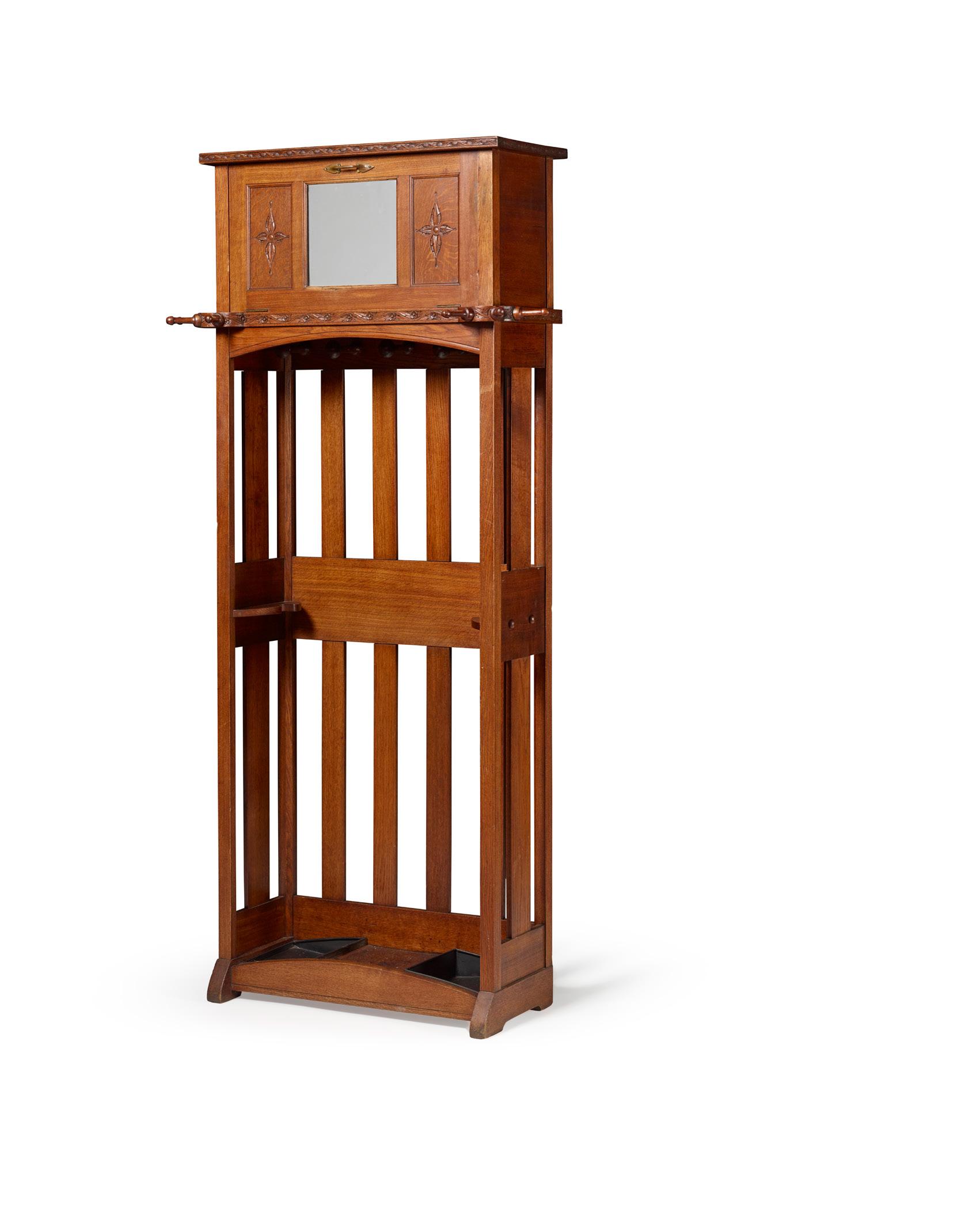
oak, with mirrored panel and Rathbone handle, the base with removable tole drip trays 87.5cm wide, 176cm high, 38cm deep £400‑600

65
159
ARTHUR W. SIMPSON (1857‑1922), KENDAL SET OF FOUR ARTS & CRAFTS SIDE CHAIRS, CIRCA 1910

oak, with close nailed leather seats, each with applied maker’s label (4)
44.2cm wide, 102cm high, 47.5cm deep
Provenance: Inherited by the current vendor from Barbara Henderson, the niece of Arthur Simpson.
£800‑1,200
160
ARTHUR W. SIMPSON (1857‑1922), KENDAL ARTS & CRAFTS TRIVET, CIRCA 1910
oak, inset with a riveted copper panel, stamped 7182
36.6cm x 21.3cm
Provenance: Inherited by the current vendor from Barbara Henderson, the niece of Arthur Simpson.
£300‑500
161
ARTHUR W. SIMPSON (1857‑1922), KENDAL ARTS & CRAFTS EXTENDING DINING TABLE, CIRCA 1910
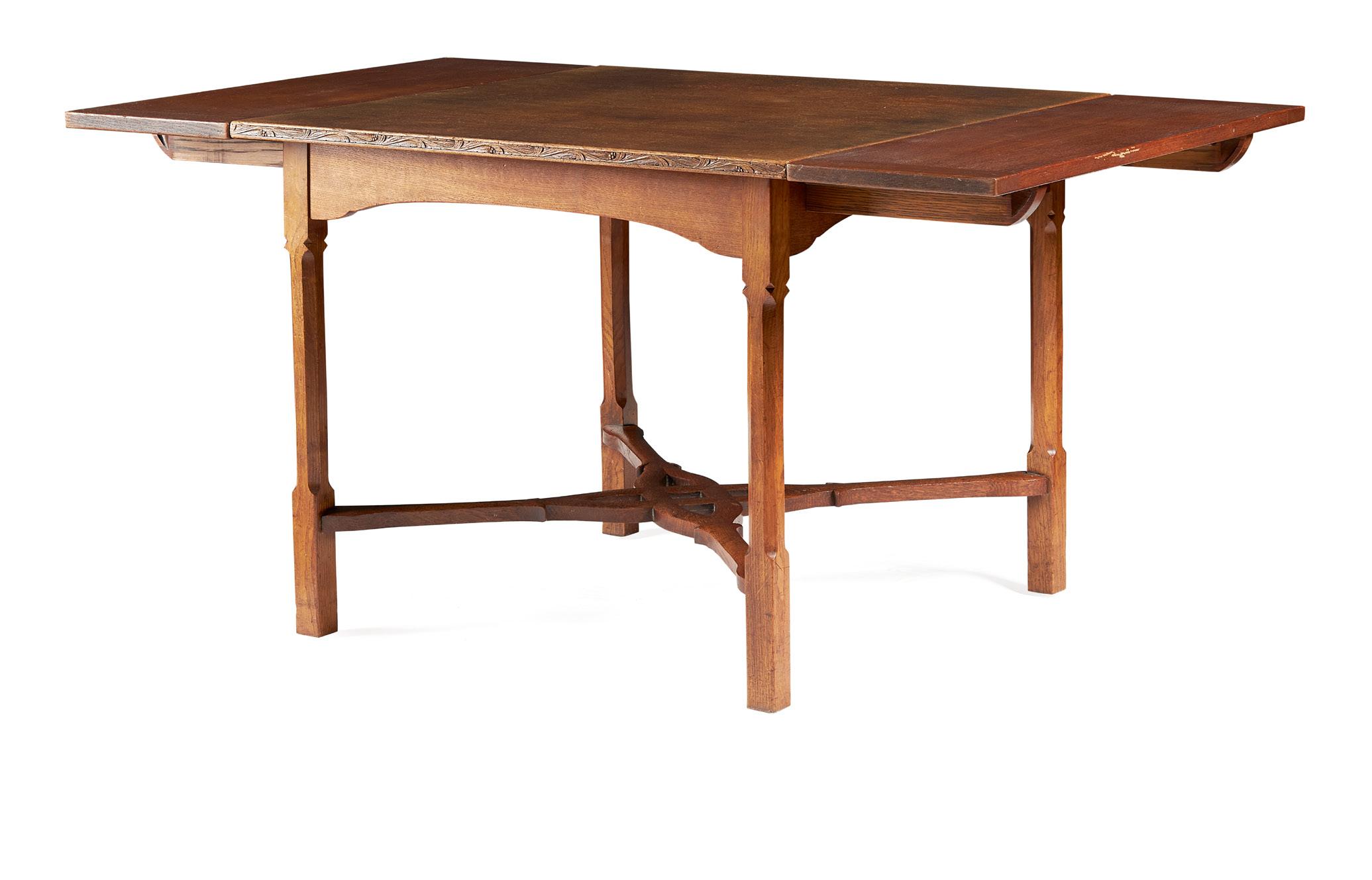
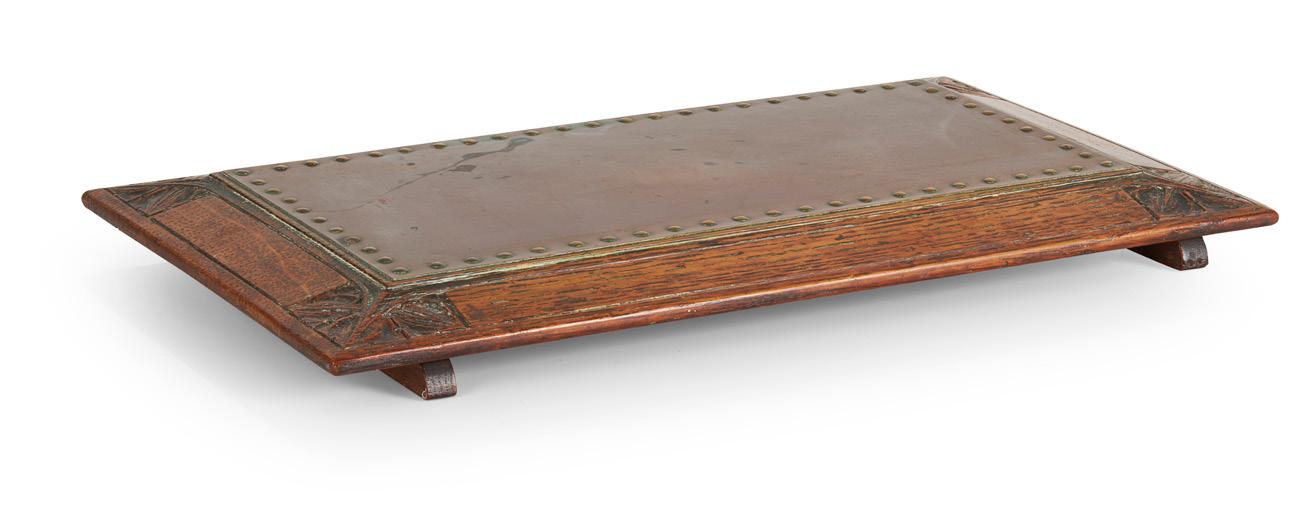
oak
91cm square, 75cm high; extended 152cm long, 75cm high, 91cm wide
Provenance: Inherited by the current vendor from Barbara Henderson, the niece of Arthur Simpson.
£1,000‑1,500
66
162
LARGE ARTS & CRAFTS
WALL‑MOUNTED BOOKSHELF, CIRCA 1910

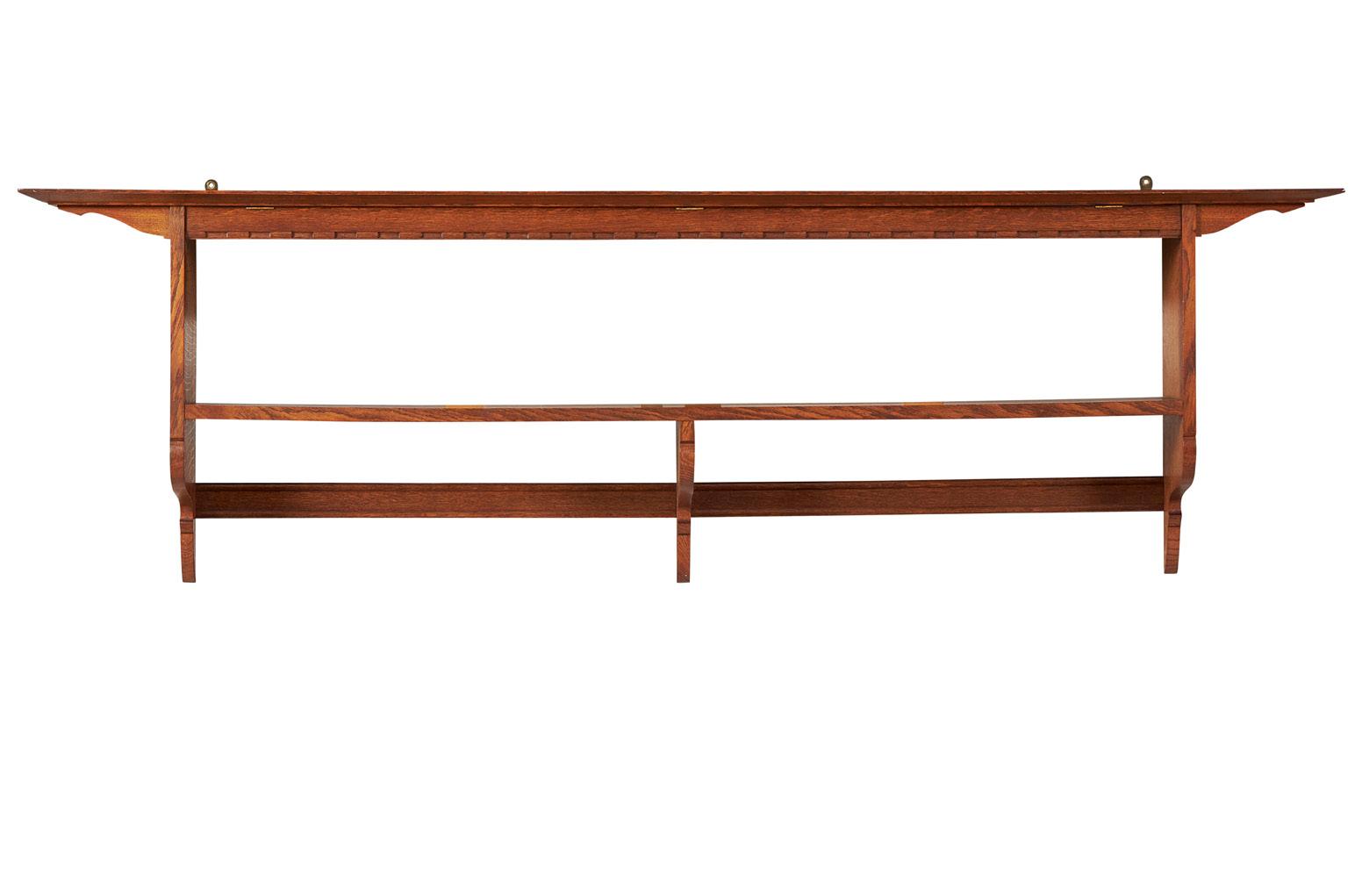
oak, with plate rack groove to top, applied maker’s label and stamped serial number 089
149cm wide, 45cm high, 20cm deep Provenance: Inherited by the current vendor from Barbara Henderson, the niece of Arthur Simpson.
£500‑700
163
DRESSER,
oak
142cm wide 200cm high, 53cm deep £1,000‑1,500
ARTHUR W. SIMPSON (1857‑1922), KENDAL
ARTHUR W. SIMPSON (1857‑1922), KENDAL ARTS & CRAFTS
CIRCA 1920
67 Other fees apply in addition to the hammer price: see the ‘Buyer’s Guide’ section on page 2
164
ARTHUR W. SIMPSON (1857‑1922), KENDAL
ARTS & CRAFTS WALL MIRROR, CIRCA 1910
oak frame, with bevelled mirror plate, applied makers label verso 113cm x 46cm
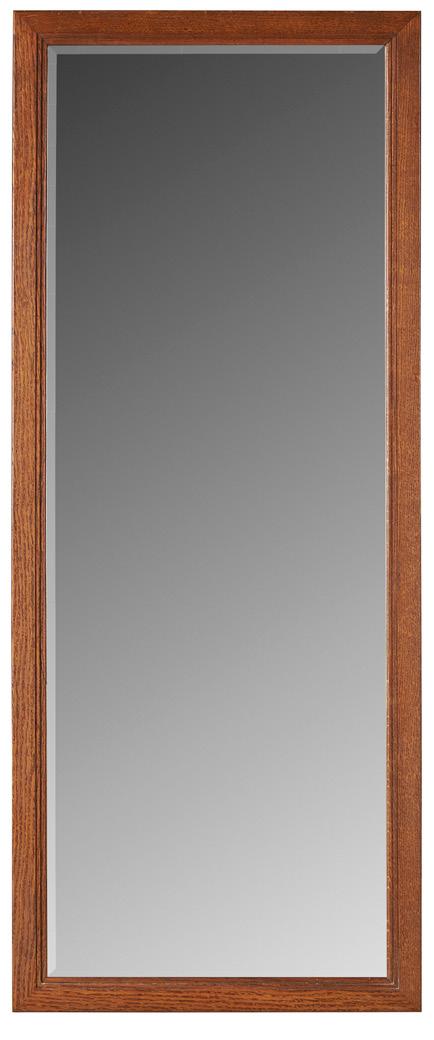
Provenance: Inherited by the current vendor from Barbara Henderson, the niece of Arthur Simpson.
£400‑600
165
ARTHUR W. SIMPSON (1857‑1922), KENDAL
ARTS & CRAFTS DRESSING TABLE, CIRCA 1910

oak, with bevelled mirror plate, Rathbone brass handles, applied maker’s label 106cm wide, 135cm high, 55cm deep
Provenance: Inherited by the current vendor from Barbara Henderson, the niece of Arthur Simpson.
£600‑800
166
ARTHUR W. SIMPSON (1857‑1922), KENDAL
ARTS & CRAFTS BED, CIRCA 1910
oak, with applied maker’s label to headboard, stamped 7558
Headboard 117.5cm wide, 124cm high, 202cm long
Provenance: Inherited by the current vendor from Barbara Henderson, the niece of Arthur Simpson.
£1,000‑1,500
167
ARTHUR W. SIMPSON (1857‑1922), KENDAL ARTS & CRAFTS FREESTANDING BED, CIRCA 1920

oak, with applied maker’s label to footboard
137cm wide 103cm high, 202cm long
Provenance: Inherited by the current vendor from Barbara Henderson, the niece of Arthur Simpson.
£400‑600
168
ARTHUR W. SIMPSON (1857‑1922), KENDAL WARDROBE, CIRCA 1930
oak
88cm wide 175cm high, 50cm deep
Provenance: Inherited by the current vendor from Barbara Henderson, the niece of Arthur Simpson.
£400‑600
68 Other fees apply in addition to the hammer price: see the ‘Buyer’s Guide’ section on page 2

69
170
BATH CABINETMAKERS
ARTS & CRAFTS SIDEBOARD, CIRCA 1900
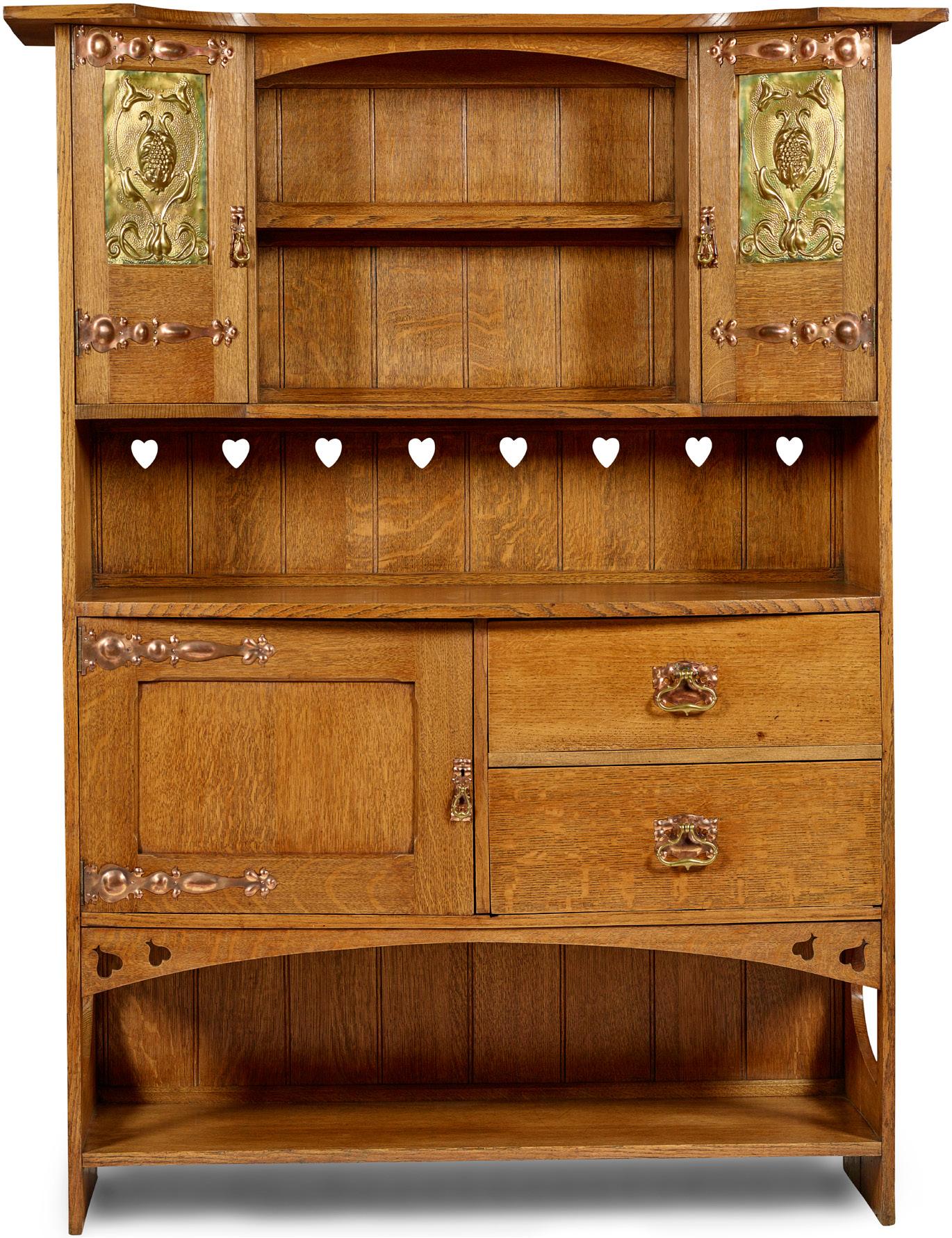
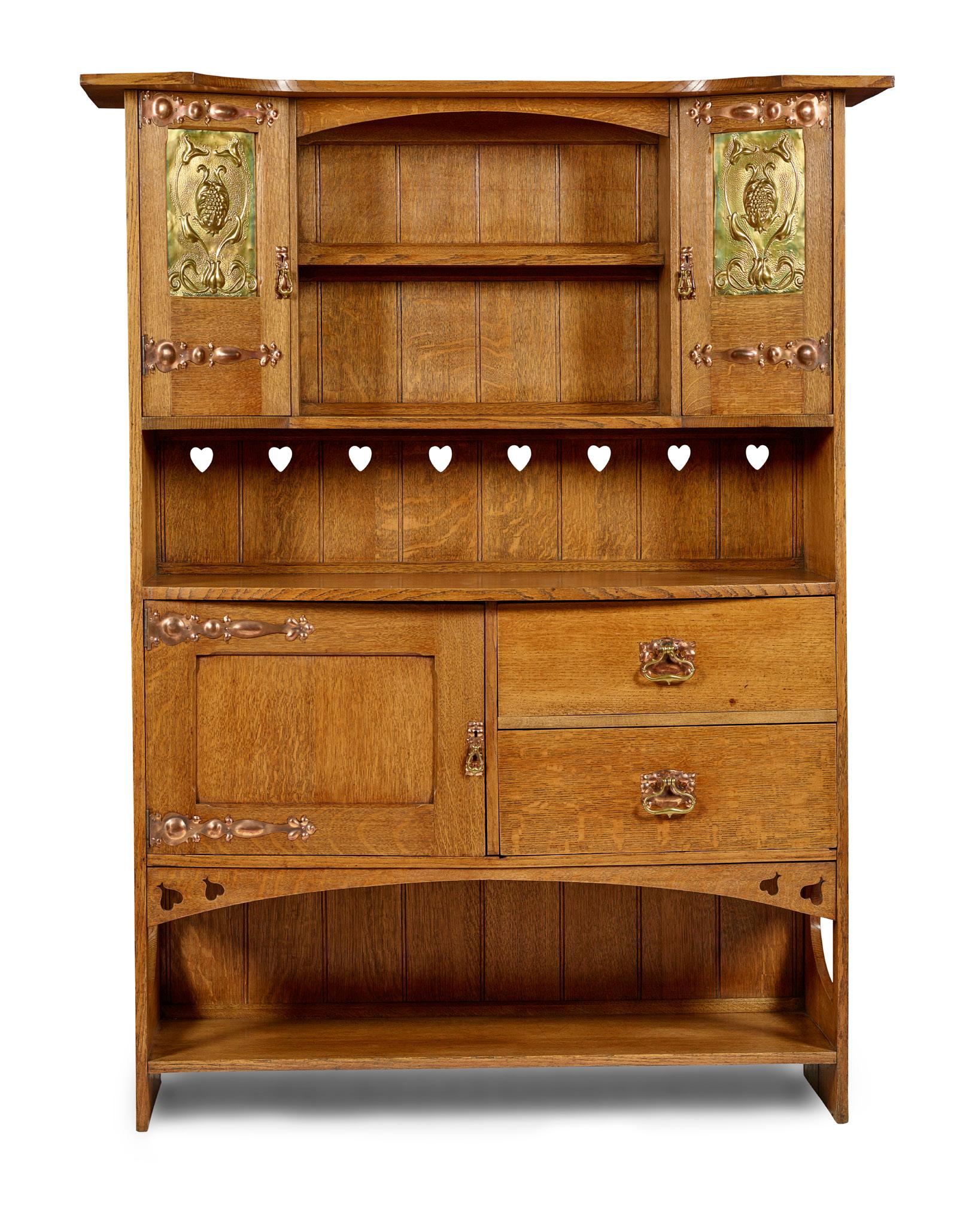
oak, with brass and copper fittings
144.5cm wide, 190cm high, 55.5cm deep £1,800‑2,200
169
ENGLISH
ARTS & CRAFTS WALL MIRROR, CIRCA 1900
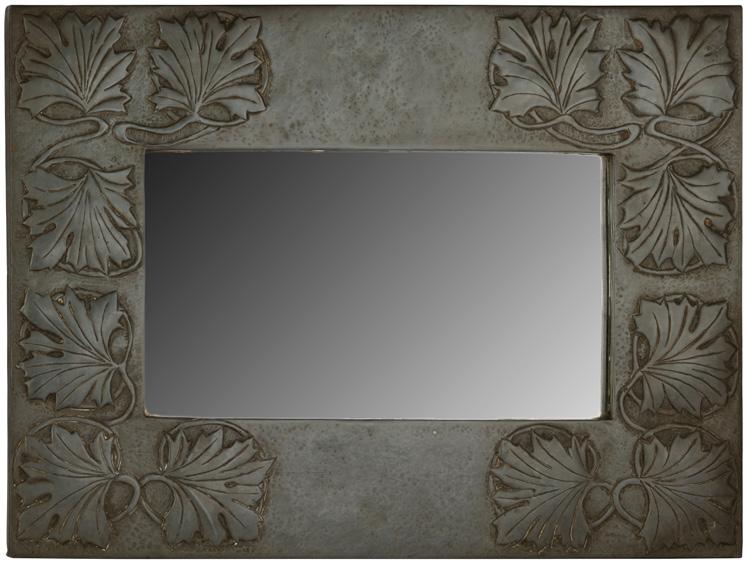

repoussé‑decorated pewter, with mirror plate
64.5cm x 46.5cm
£300‑500
171
MAW & CO.
NINE‑TILE PANEL, CIRCA 1900
glazed earthenware, framed each tile 15.2cm square
£300‑500
See illustration on previous page.
172
CRAVEN DUNNILL
NINE‑TILE PANEL, CIRCA 1900
glazed earthenware, framed each tile 15.3cm square £250‑350
173
A. E. JONES (1878‑1954)
TWIN‑HANDLED FOOTED BOWL, BIRMINGHAM 1919
silver, hallmarked Birmingham 1919
24cm across including handles
£300‑500
70
175
CHARLES L. HARTWELL R.A. (1873‑1951)
THE CALL OF THE SEA, 1920 verdigris bronze, on an ebonised plinth, signed in the bronze HARTWELL **
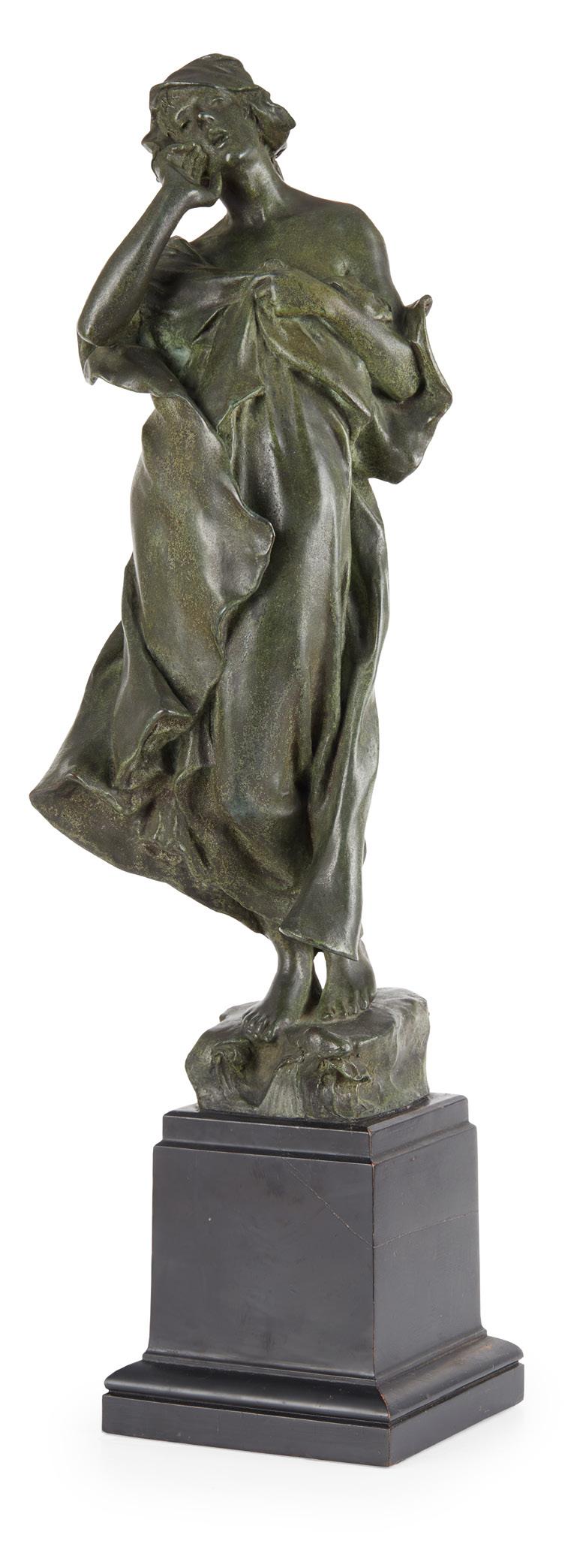
39cm high; including base 50cm high £800‑1,200
174
GEORGE DUNCAN MACDOUGALD (1880‑1945)
MOTHER AND CHILD
bronze, signed and dated in the bronze 1922, raised on an ebonised wood plinth 10.5cm high excluding base, 12cm high including base £400‑600


176
ENGLISH SCHOOL RESURRECTION
bronze, mid‑brown patina, associated wooden base 28cm high, 35cm high including base £400‑600
71 Other fees apply in addition to the hammer price: see the ‘Buyer’s Guide’ section on page 2
177
GEORGE WALTON (1867‑1933) (ATTRIBUTED DESIGNER) FOR J.S. HENRY, LONDON
THREE‑PIECE PARLOUR SUITE, CIRCA 1910
inlaid mahogany, with original close‑nailed upholstered seats, comprising a SETTEE 103cm wide, 97cm high, 46cm deep; and TWO ARMCHAIRS, 58cm wide, 99cm high, 49cm deep (3)

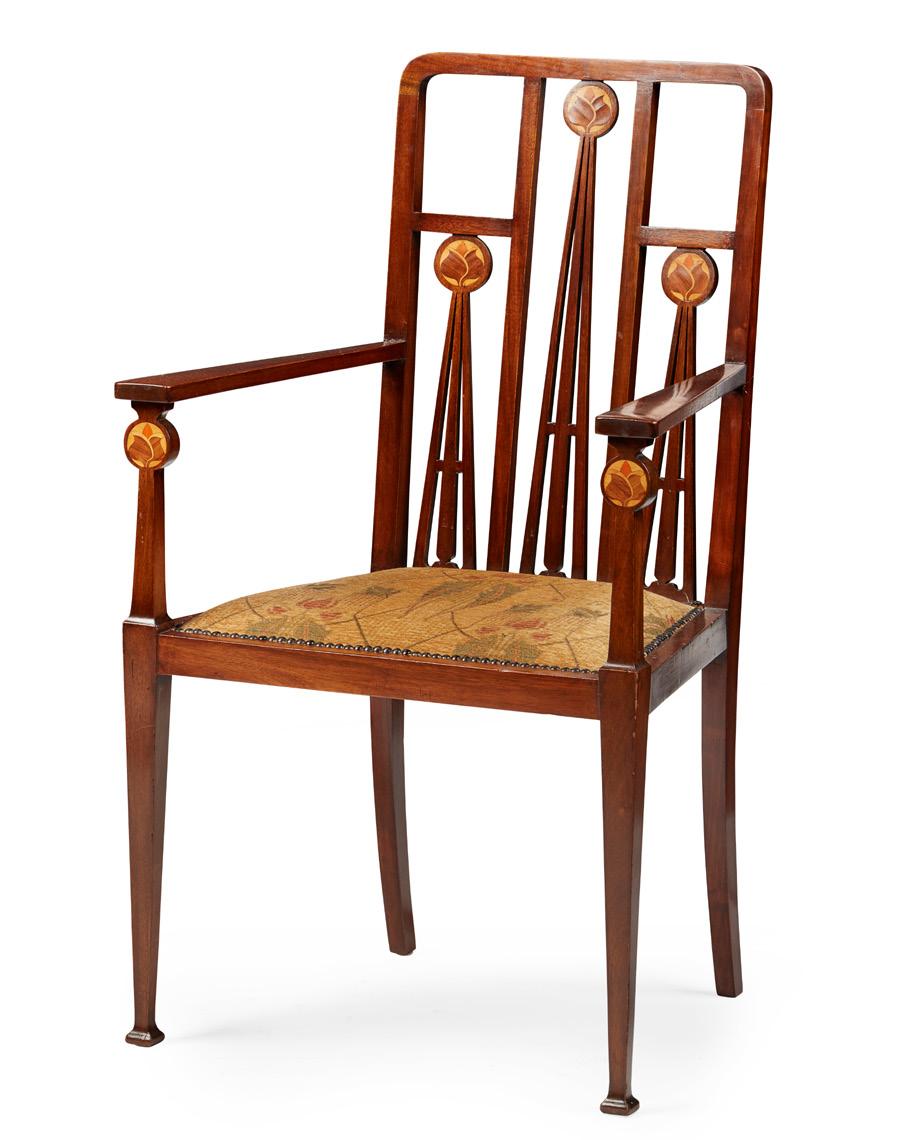

Literature: Cooper, J., Victorian & Edwardian Furniture & Interiors, Thames & Hudson, London, 1987, p. 233, pls. 634 and 635
Note: Walton designed the 1903 Arts & Crafts Exhibition Society stand for J.S. Henry, and, it is thought, this parlour suite.
£1,500‑2,000
72 Other fees apply in addition to the hammer price: see the ‘Buyer’s Guide’ section on page 2
178

ENGLISH SCHOOL
THE SEASONS, FOUR ARTS & CRAFTS EMBROIDERED PANELS, CIRCA 1900 coloured silks and watercolour, reserved on an unbleached linen ground, variously inscribed SPRING; SUMMER; AUTUMN; WINTER, framed (4) each 37cm x 18cm £1,000‑1,500



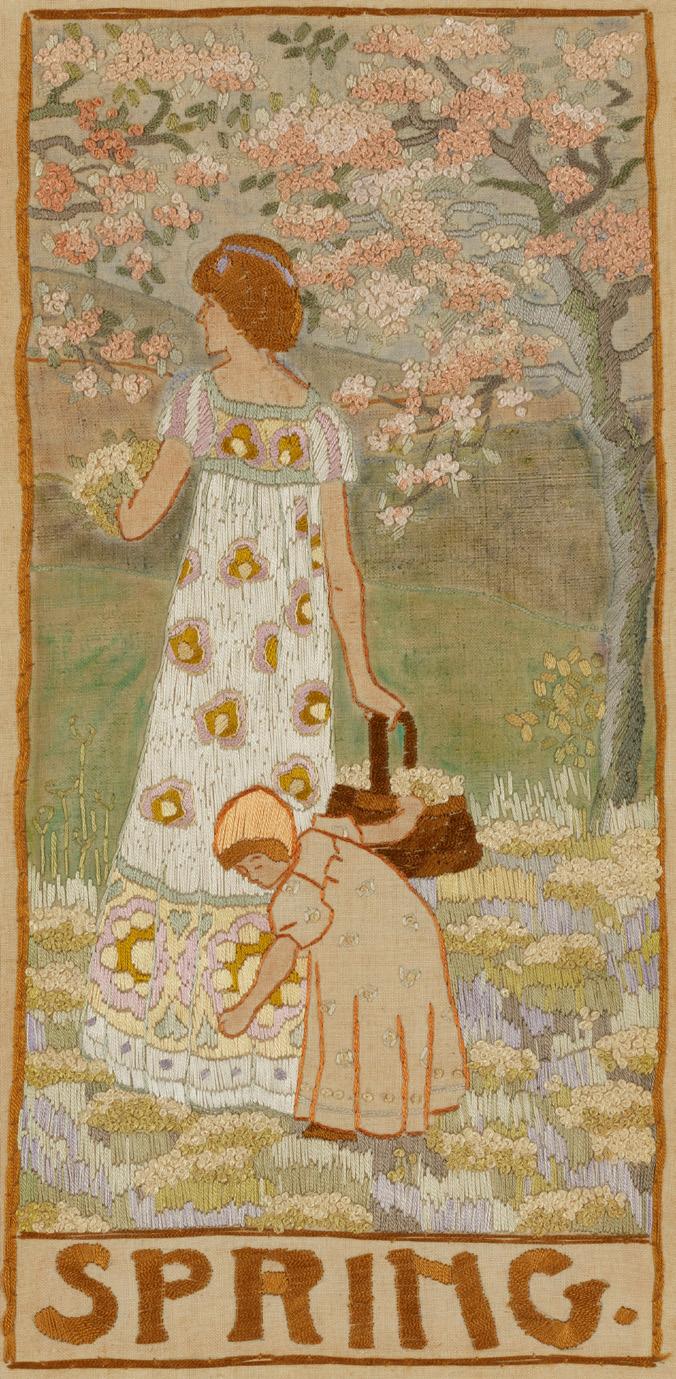
73
179
MCVITIE & PRICE
BISCUIT BOX, CIRCA 1910
brass and copper, with Ruskin ceramic roundels, stamped MCVITIE & PRICE/ LONDON AND EDINBURGH
18cm across
£300‑400
180
J. S. HENRY, LONDON
ART NOUVEAU ARMCHAIR, CIRCA 1910
carved oak, with velvet upholstered seat and arm rest
64cm wide, 121cm high, 49cm deep
Note: This celebrated chair shows distinct characteristics of the designs of the Century Guild with its linear Art Nouveau lines and swollen square section uprights.
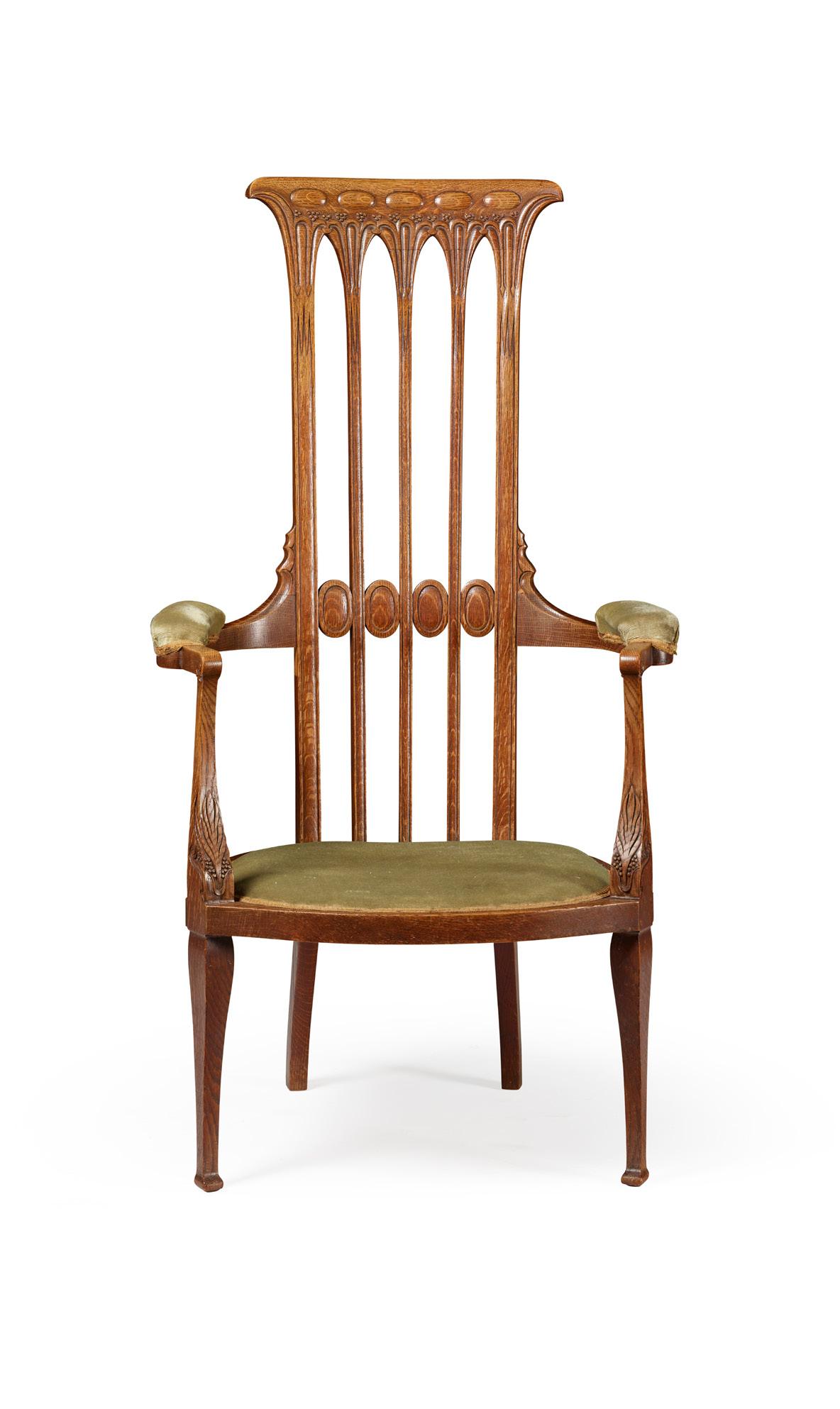
J.S. Henry was a wholesale manufacturer of Art Furniture based in Old Street, London and was established circa 1880. Most of their furniture output was Art Nouveau in mahogany and satinwood with decorative inlay. At the Arts & Crafts Exhibition Society in 1903 the company showed designs by George Walton and W.A.S. Benson. G.M. Ellwood was their most prolific designer, and although they used designs by C.F.A. Voysey, E.G. Punnett and W.J. Neatby, few designers were named. Examples of this chair are held at the Kelvingrove Museum and Art Gallery in Glasgow and MAK Applied Arts Museum in Vienna.
£800‑1,200
181
GEORGE MONTAGUE ELLWOOD (1875‑1955) (ATTRIBUTED DESIGNER)
FOR J. S. HENRY, LONDON
ART NOUVEAU OCCASIONAL TABLE, CIRCA 1910
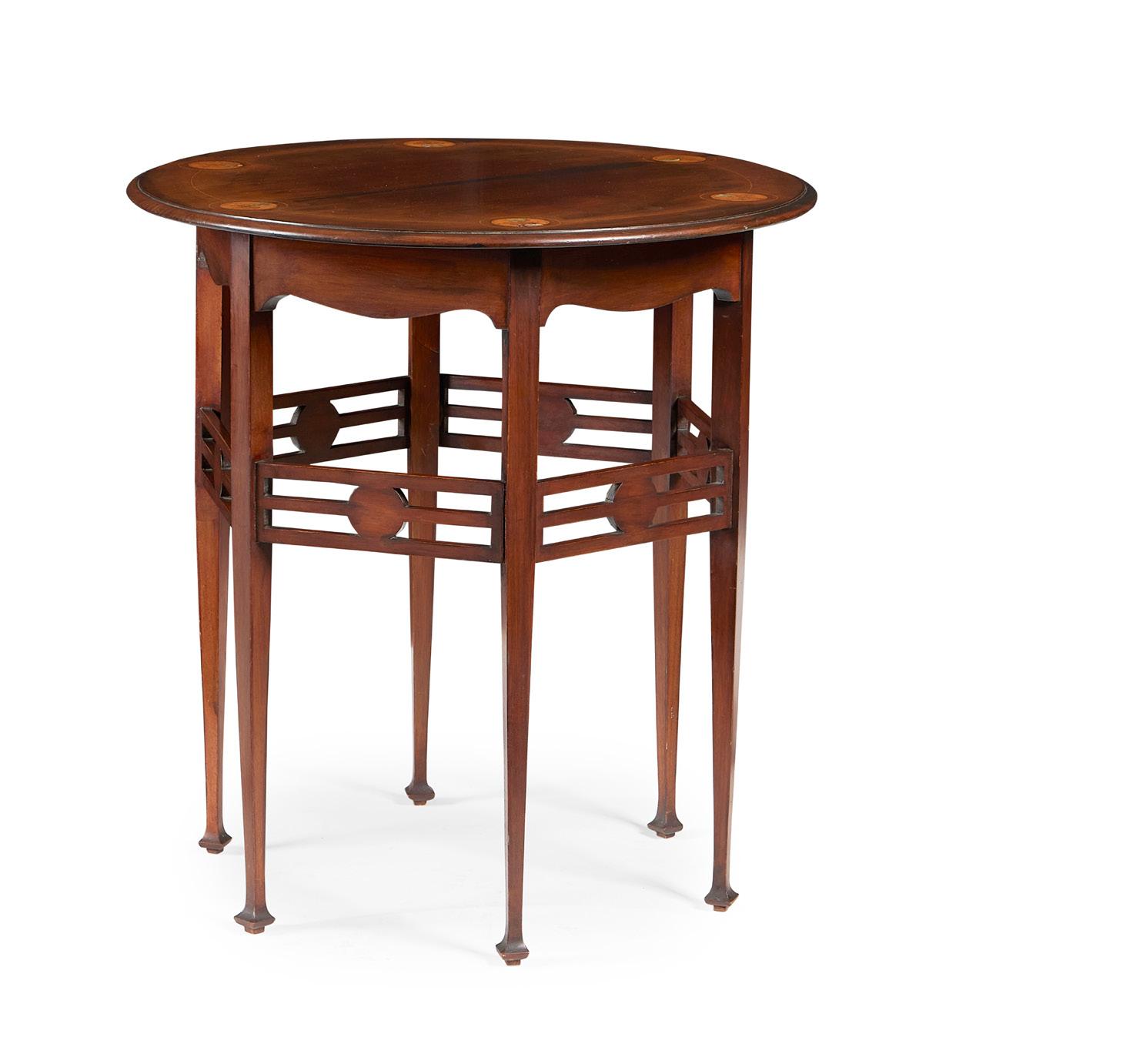

mahogany, inlaid with specimen woods and mother‑of‑pearl
68cm diameter, 71cm high
£600‑800
182
ENGLISH
TILE PANEL, CIRCA 1900
glazed ceramic, with tube‑lined monogram, the oak frame with copper plaques to the angles
tile 44.5cm x 14cm
£250‑350
74
186
183
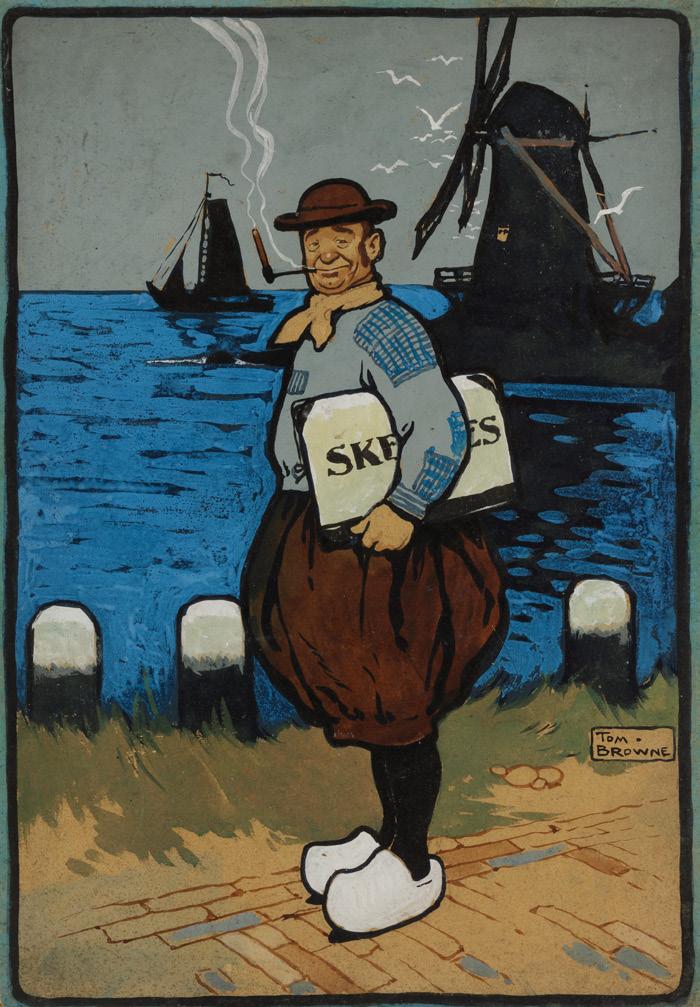
SHAPLAND AND PETTER, BARNSTAPLE
TRIPLE OVERMANTEL MIRROR, CIRCA 1900
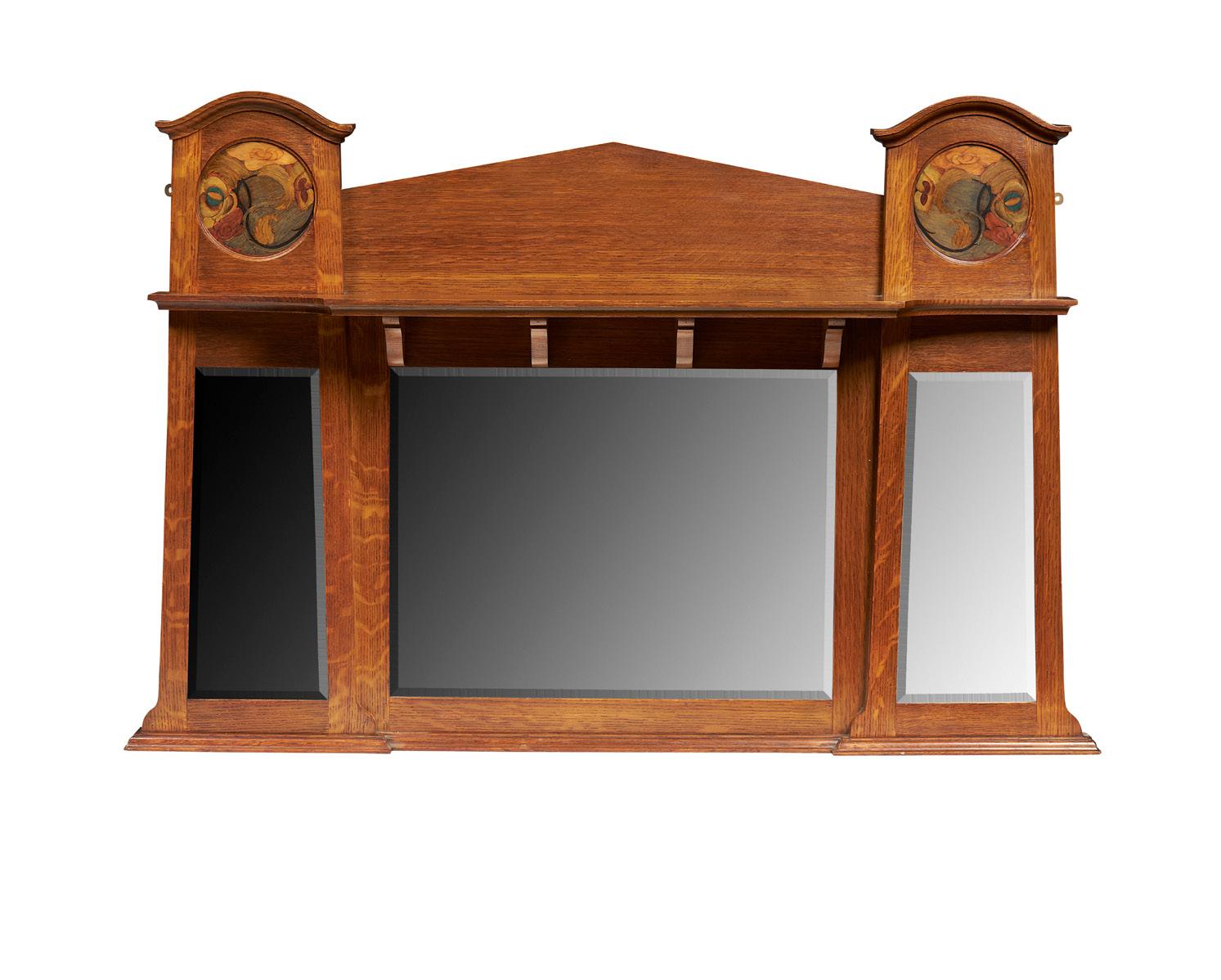
oak, inset with polychrome painted roundels with bevelled mirror plates
122cm wide, 88cm high
£800‑1,200
184
TOM BROWNE (1870‑1910) ‘SKETCHES’
watercolour and bodycolour, signed lower right TOM BROWNE, framed 56cm x 38cm
Note: Tom Browne was a member of the London Sketch Club along with artists such as John Hassall, Edmund Dulac, and W. H. Robinson. £300‑500
185
SHAPLAND & PETTER, BARNSTAPLE
ARTS & CRAFTS STICK STAND, CIRCA 1910

oak, with repoussé‑decorated copper panels and patinated metal tray
57cm wide, 105cm high 27cm deep £400‑600
ENGLISH
ARTS & CRAFTS MIRROR, CIRCA 1900
pewter, set with Ruskin ceramic cabochon and glass cabochons, with mirror plate 35cm x 30cm
£250‑350
75 Other fees apply in addition to the hammer price: see the ‘Buyer’s Guide’ section on page 2
188
GEORGE HEYWOOD SUMNER (1853‑1940) FOR THE FITZROY PICTURE SOCIETY ‘THE BEE GARDEN’
chromolithographic print, printed by James Ackerman, London 73cm x 66cm

£300‑500
187
JOHN MACALLAN SWAN (1847‑1910)
HEAD OF A BEAR bronze, mounted on an ebonised wood shield bronze 11cm long
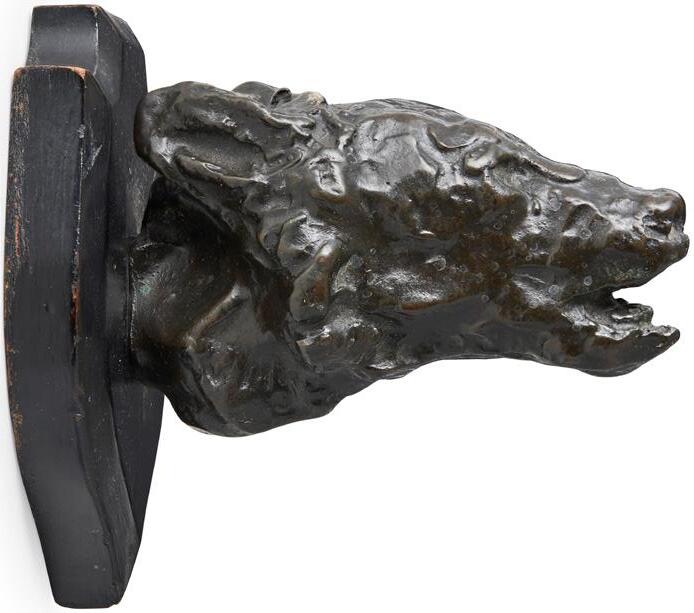
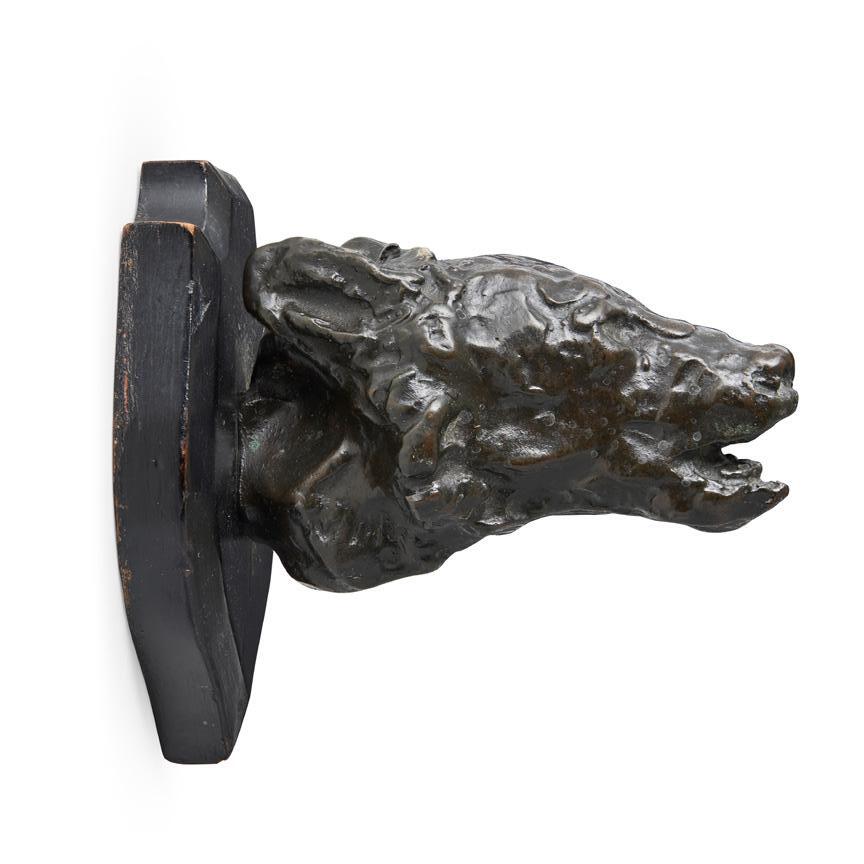
£500‑700
189
MANNER OF FLORENCE STEELE FOR FATTORINI & SONS LTD. OF BRADFORD MEDALLION PLAQUE, CIRCA 1910 bronze, in glazed frame, the mount inscribed MANUFACTURED BY FATTORINI & SONS LTD., BRA. medallion 24cm diameter

£300‑500
190
ENGLISH SCHOOL
‘POLYCHROME’ AND ‘MONOCHROME’, CIRCA 1900
watercolour design, examined South Kensington, ESK stamp, framed, polychrome 22.5cm diameter; monochrome 43cm x 19.5cm (2)
£400‑600
76
191
WILLIAM REYNOLDS‑STEPHENS (1862‑1943)
HEAD OF A GIRL
bronze, signed in the bronze, raised on a granite base 11cm high excluding base, 28.5cm high including base

£400‑600
192
G.H. CLARKSON (ACTIVE 1903 – 1923) (ATTRIBUTED TO)
BUST OF AN EGYPTIAN QUEEN, 1918 bronze, signed and dated in the bronze CLARKSON/ 1918
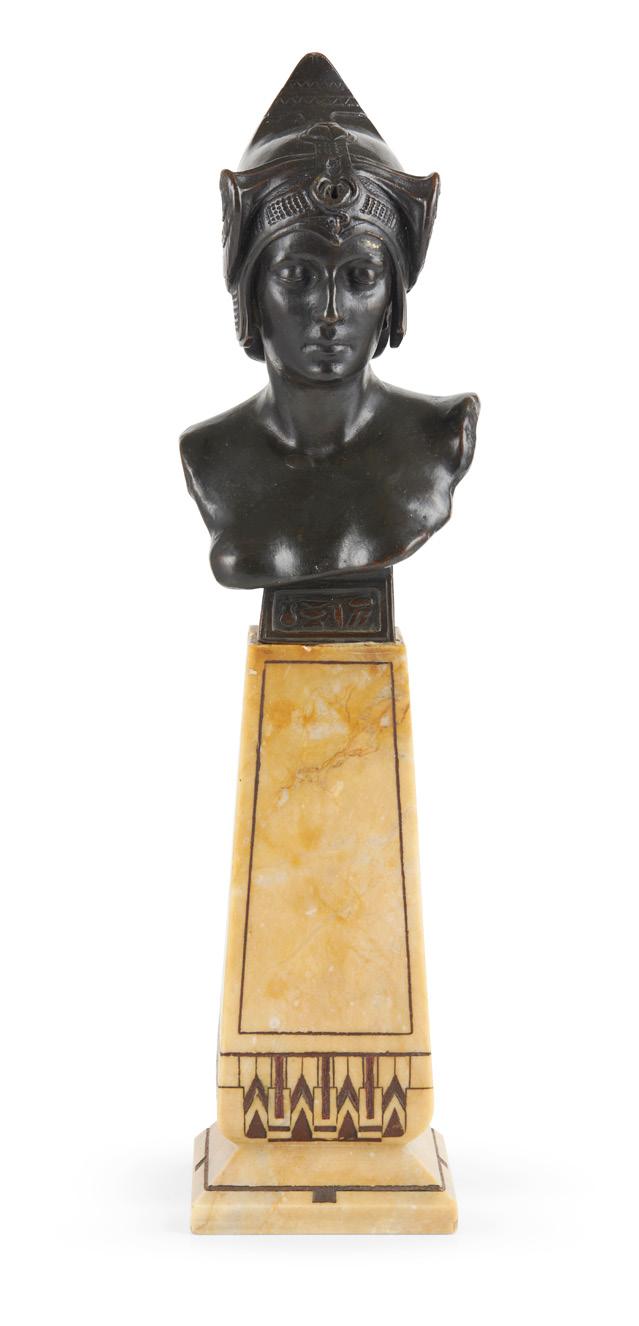
38cm high including plinth
£500‑700
193
DEXTER WEATHERPROOFS
ADVERTISING SIGN, CIRCA 1900 embossed and patinated metal frame, enclosing a lithographic print
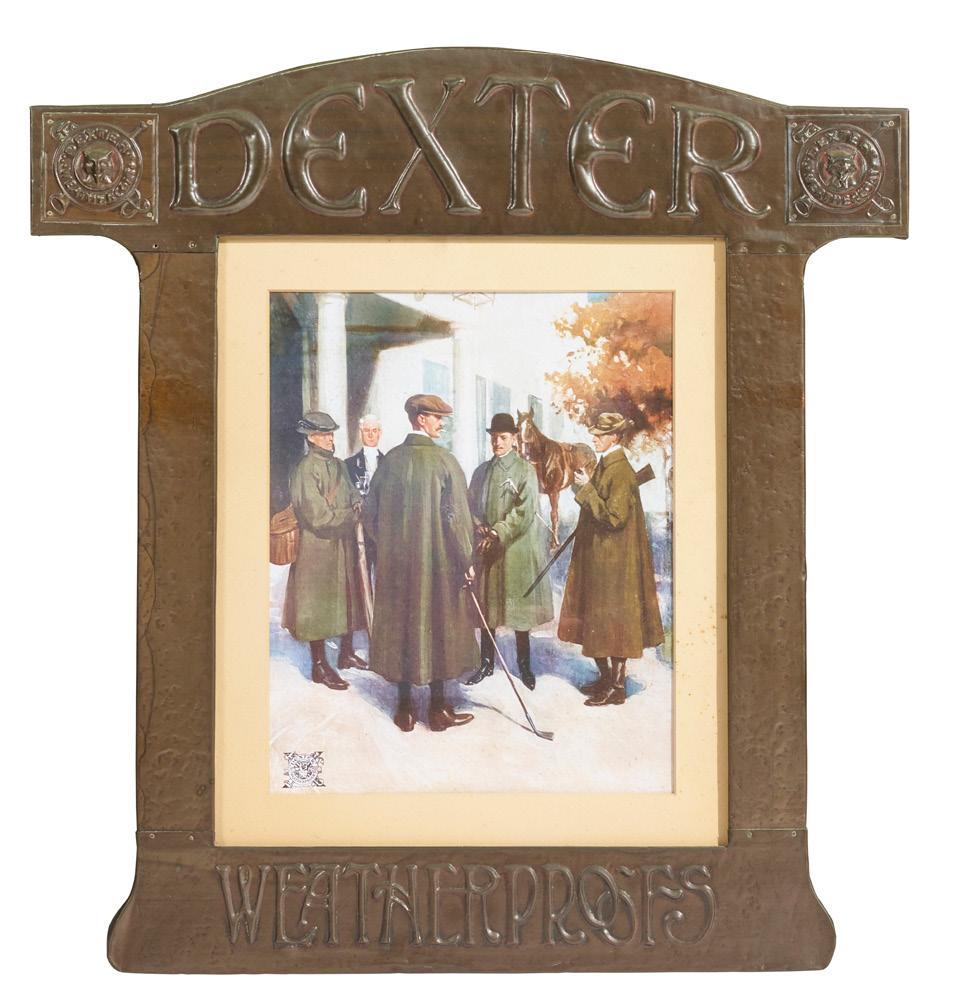
76cm x 72.5cm
£600‑800
194 §
ELYSE ASHE LORD (1900‑1971)
‘ARABIAN NIGHTS’
hand‑coloured etching, signed in pencil lower right and numbered 42/75
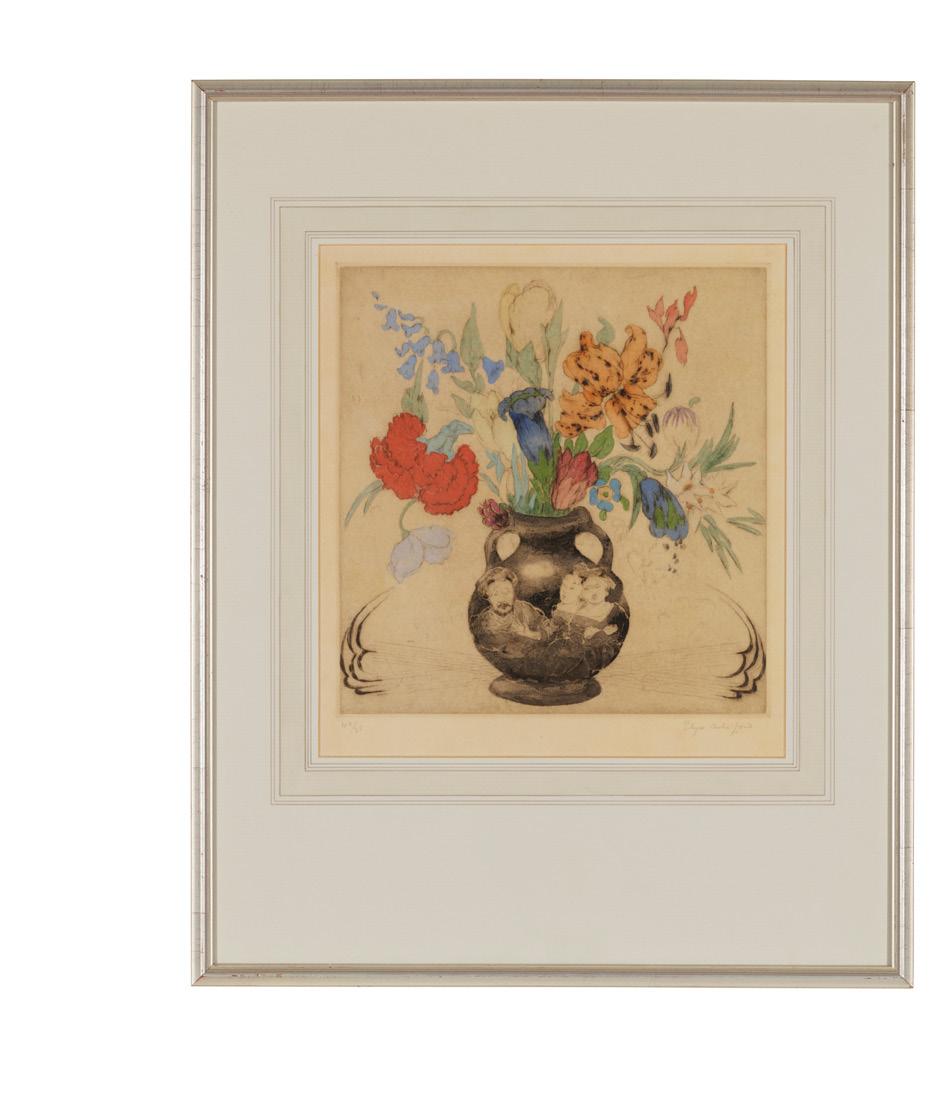
35cm x 32cm
£300‑500
77 Other fees apply in addition to the hammer price: see the ‘Buyer’s Guide’ section on page 2
white

2.7cm long
£300‑500
ART NOUVEAU PENDANT, CIRCA 1900
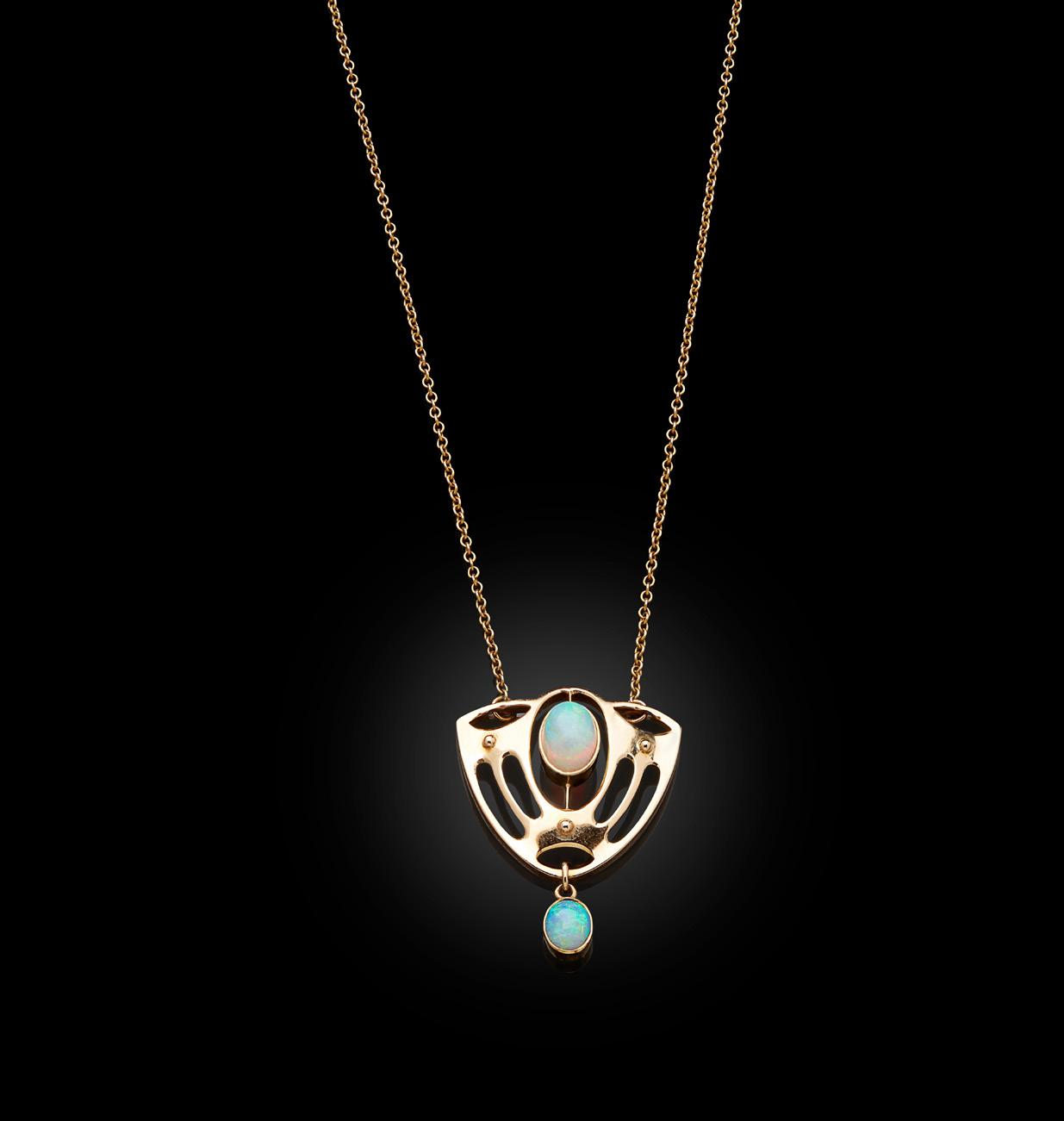
15ct gold, set with opal cabochons, stamped 15CT/ MB&CO pendant 3cm tall
£300‑500
BRACELET, CIRCA 1900
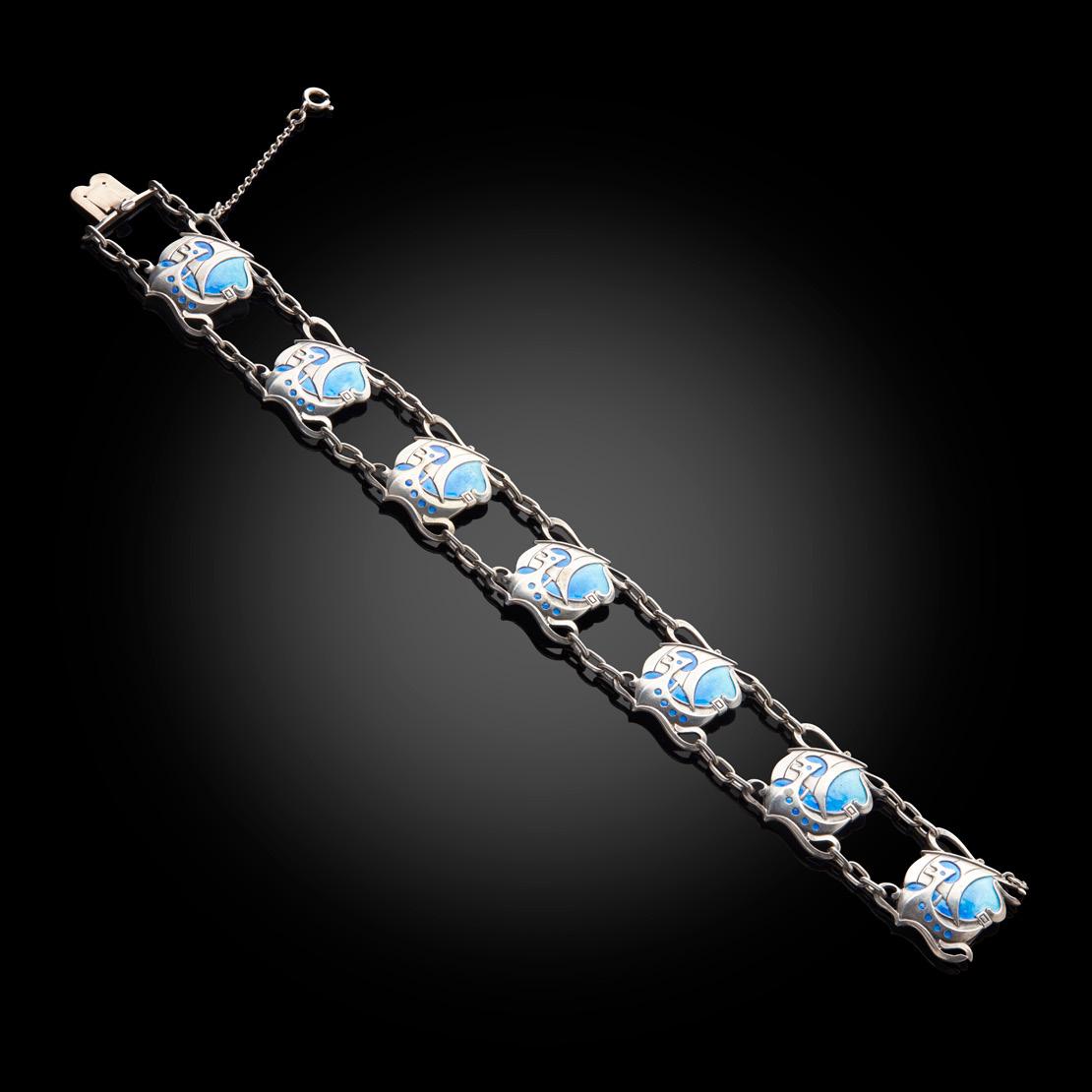
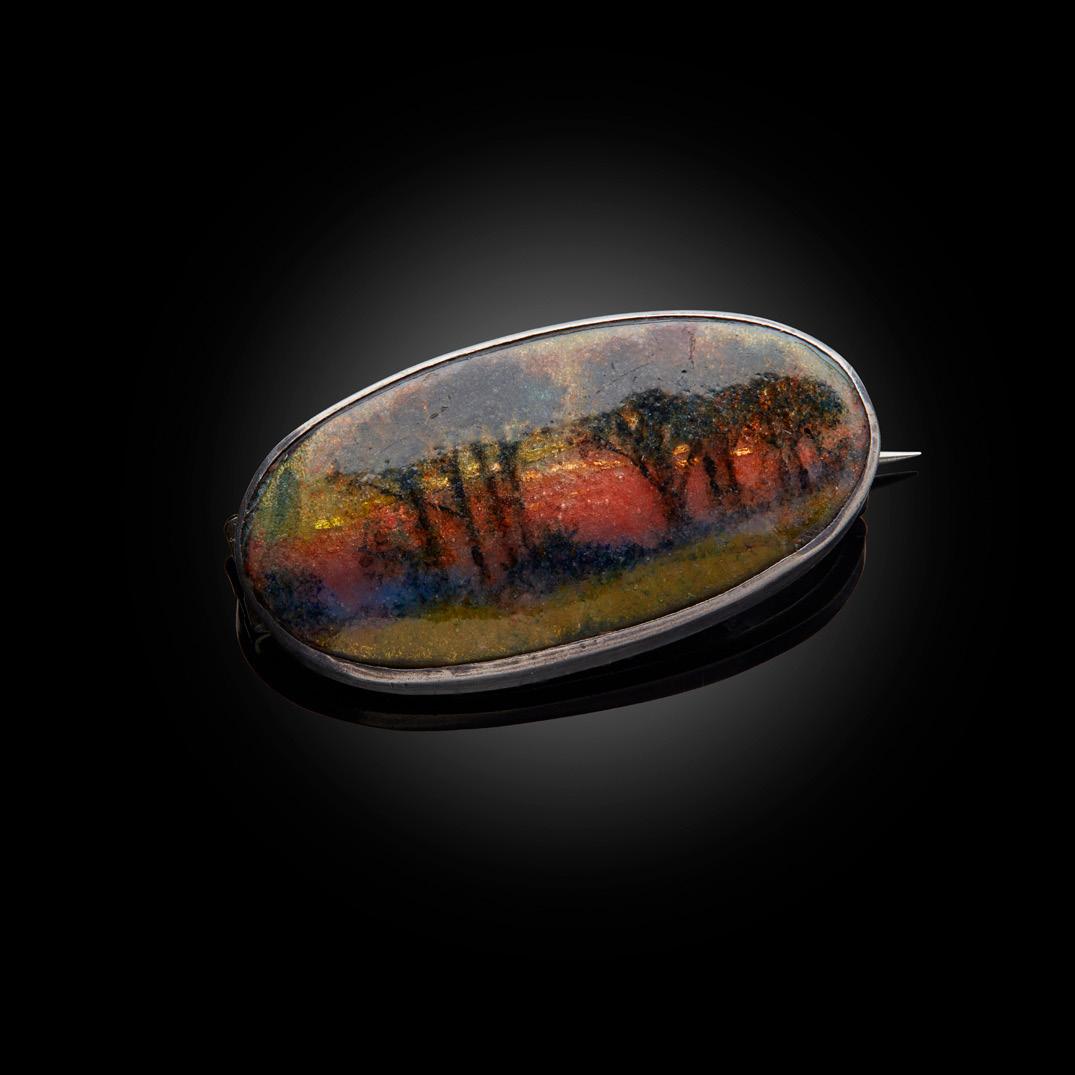
silver and enamel, stamped MBCO/ 950, within associated Liberty & Co lined box
19cm long
£600‑800
195
MURRLE, BENNETT & CO. LTD., LONDON
196 FLEETWOOD CHARLES VARLEY (1863‑1942) BROOCH, CIRCA 1910
metal and enamel, within Liberty & Co fitted box
197 MURRLE, BENNETT & CO. LTD., LONDON
78
KATE HARRIS SILVER
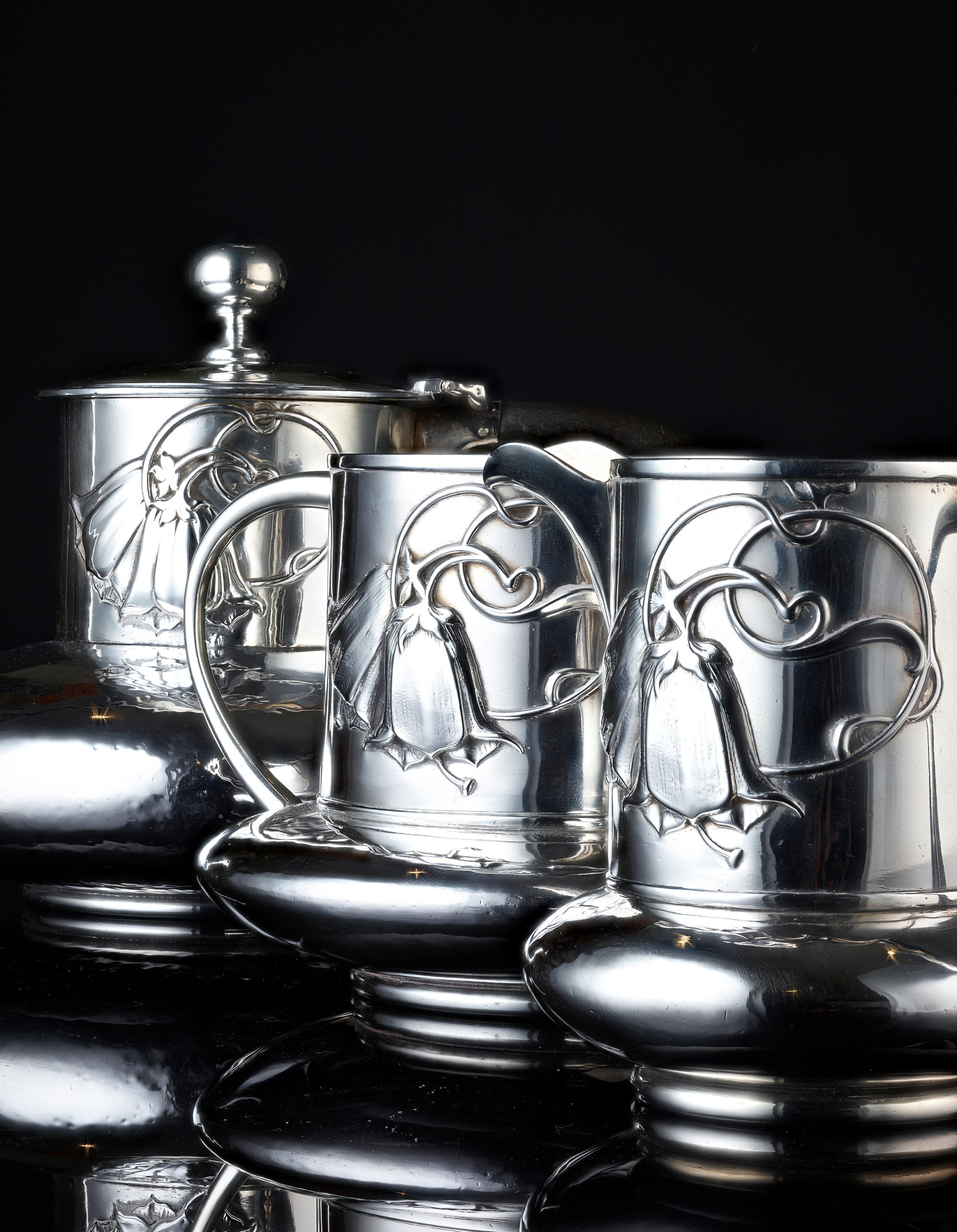
79
KATE, or Katie, Harris, is broadly considered one of the most important designers for the London‑based firm, William Hutton & Sons. From 1899 to around 1905, she produced exquisite designs for artistic silver. We are pleased to offer this wonderful selection of pieces, which demonstrate the exquisite breadth of work she produced for the firm, and which is still very much sought‑after by collectors.
Sinuous botanical motifs and enchanting organic forms dominate her work, serving both a decorative and structural purpose for the piece itself. Perhaps Harris’ best‑known designs, however, are those featuring a classically stylised figural form, typically austere in feeling and with fewer erotic overtones than Continental Art Nouveau counterparts. The skilled craftsmanship needed to bring these designs to life showcases the sheer elegance and simple beauty that is now synonymous with Harris’ work. The period between 1880 and 1914 offered fresh opportunities to women artists in training and employment, and there was a growing number of women artist‑designers’ names published in popular art magazines at the time. Harris gained critical acclaim after regularly featuring in The Studio Magazine; soon several companies began to retail her popular silverwares, including Goldsmiths and G. L. Connell. While Harris may have been one of Hutton & Sons brightest talents, it was commercial standard practice for designs to be attributed to the firm itself, and not the individual designer. As a consequence, even successful artists would remain largely anonymous and it became challenging, particularly for women, to forge a prosperous artistic career. Though her biography remains vague, her accomplishments in silverware design are continually recognised and reflected in the high prices her work commands in the art market today.

80
198
KATE HARRIS (1878‑1949) FOR WILLIAM HUTTON & SONS LTD.
CENTREPIECE, LONDON 1900
silver, with green glass liner, hallmarked London 1900, stamped MAPPIN & WEBB, incised 46587 48.5cm wide, 18.5cm high £3,000‑5,000
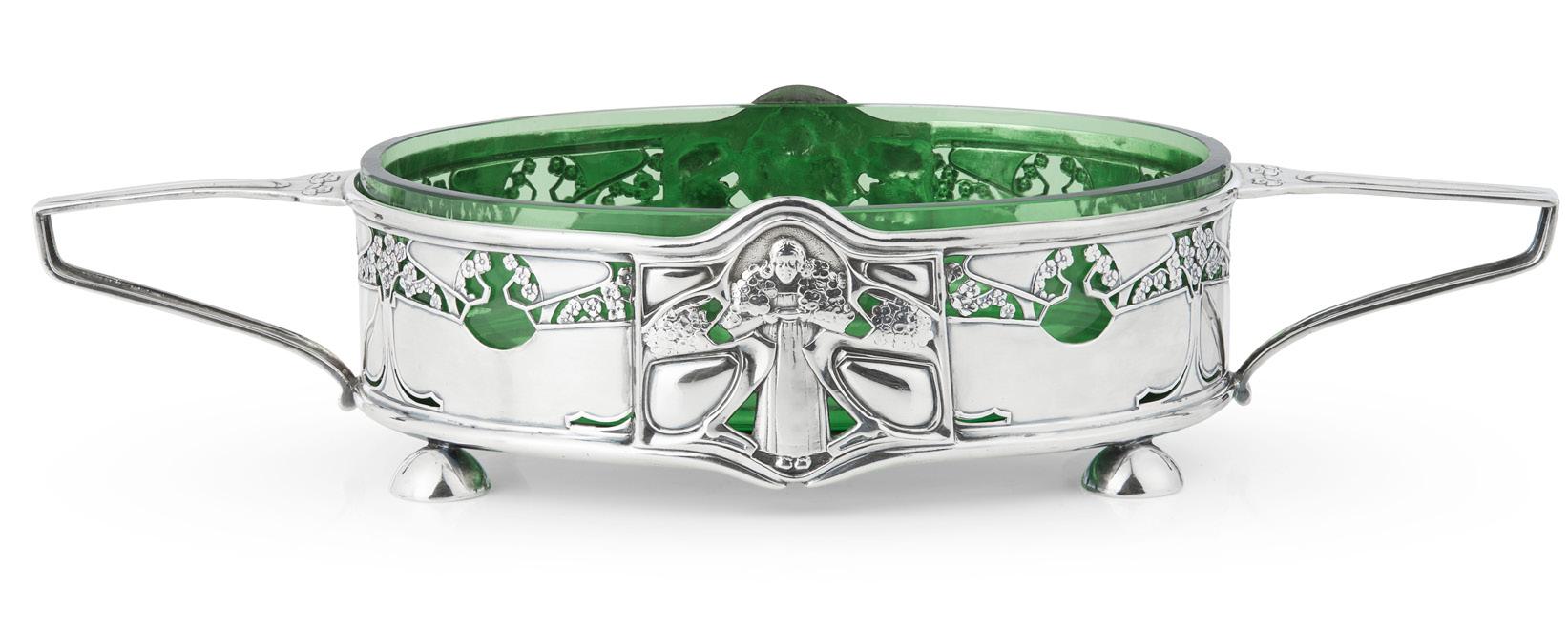
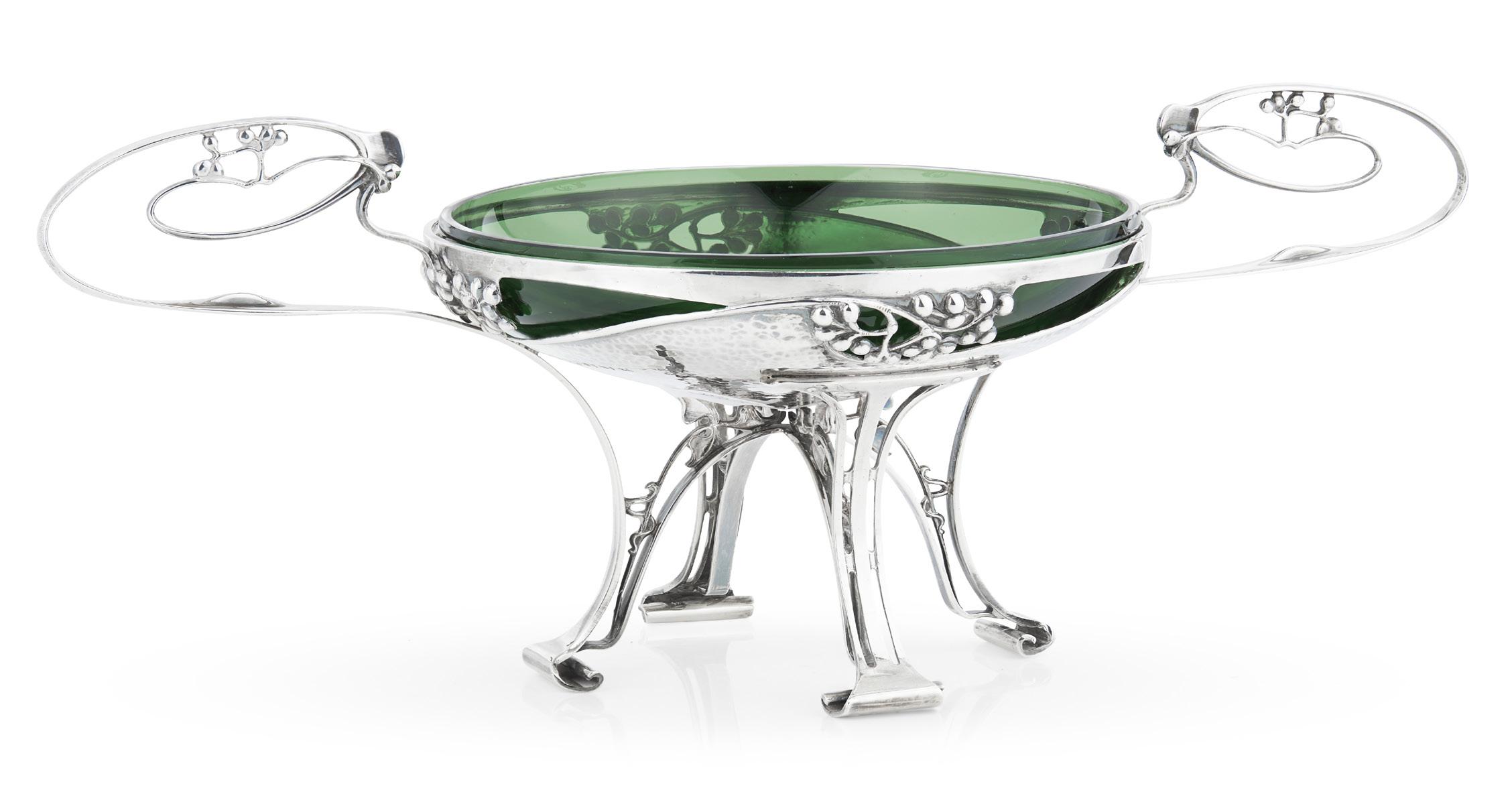
199
KATE HARRIS (1878‑1949) FOR R. H. HALFORD & SONS
TWIN‑HANDLED DISH, LONDON 1900
silver, with green glass liner, hallmarked London 1900 37cm across £1,000‑1,500
81 Other fees apply in addition to the hammer price: see the ‘Buyer’s Guide’ section on page 2
200

KATE HARRIS (1878‑1949) FOR G. L. CONNELL LTD., LONDON
THREE PIECE TEA SERVICE, LONDON 1902
silver, comprising a TEAPOT, with ebonised handle, 14cm high; a MILK JUG, 8cm high; and a TWIN‑HANDLED BOWL, 9cm high, all with stamped manufacturer’s mark and hallmarked LONDON 1902 (3) £5,000‑8,000
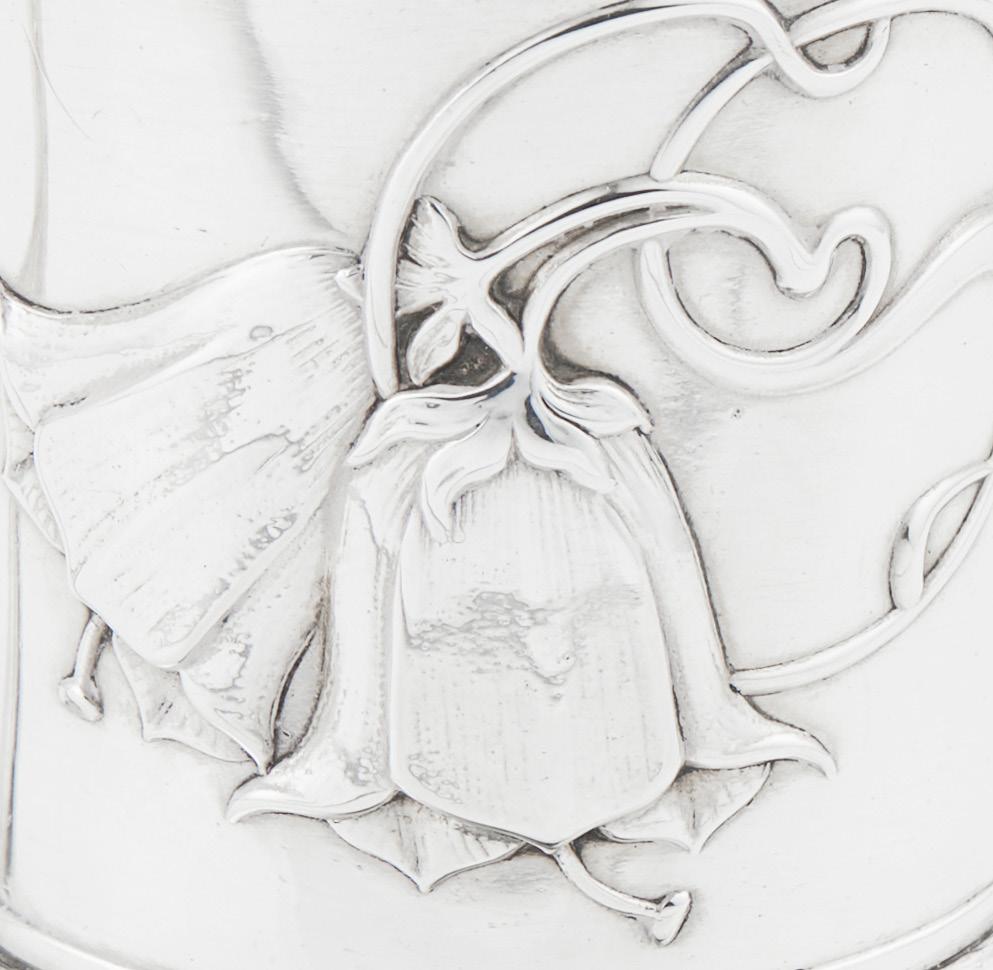

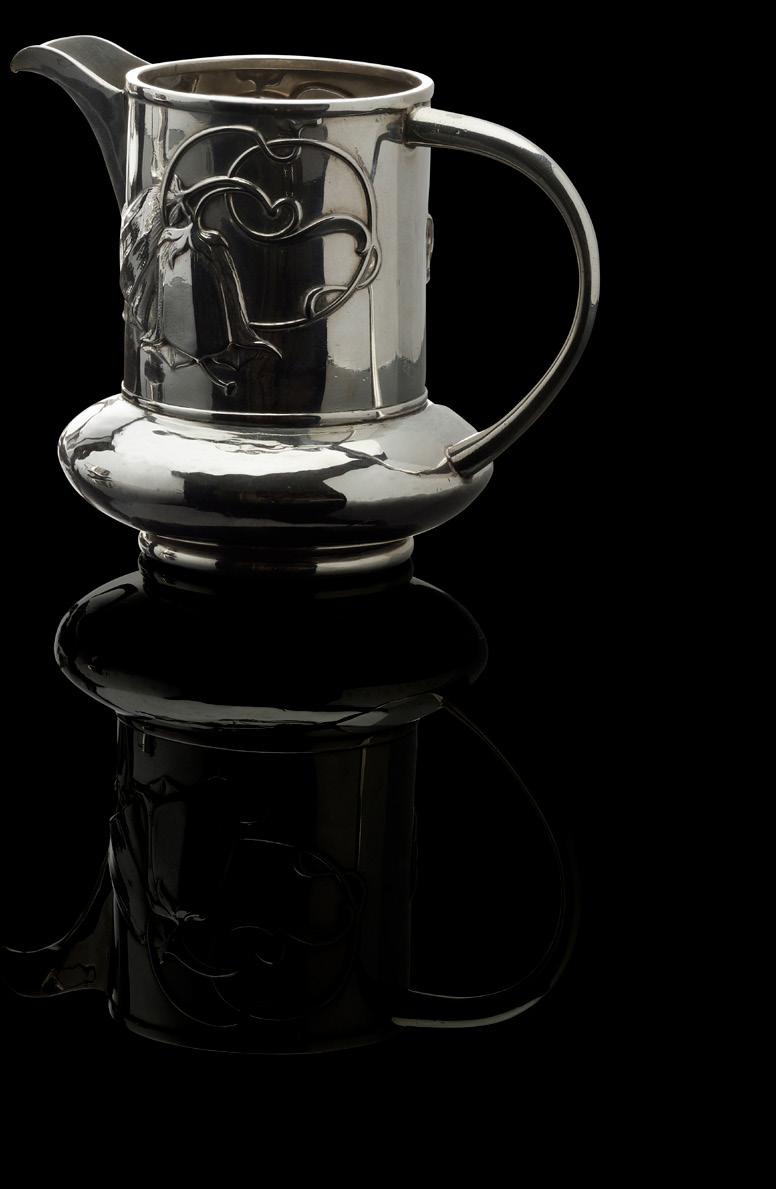

82
201
KATE HARRIS (1878‑1949)
FOR G. L. CONNELL LTD, LONDON
SERVING DISH, BIRMINGHAM 1911
silver, hallmarked Birmingham 1911
35.5cm diameter
£1,000‑1,500
203
KATE HARRIS (1878‑1949) FOR WILLIAM HUTTON & SONS LTD.
QUAICH, LONDON 1901
silver with blue glass liner, hallmarked London 1901

17.5cm across £600‑800
202
KATE HARRIS (1878‑1949)
FOR WILLIAM HUTTON & SONS LTD.
CIRCULAR CASKET, LONDON 1903
silver, with blue glass liner, hallmarked London 1903 16cm diameter

£2,000‑3,000
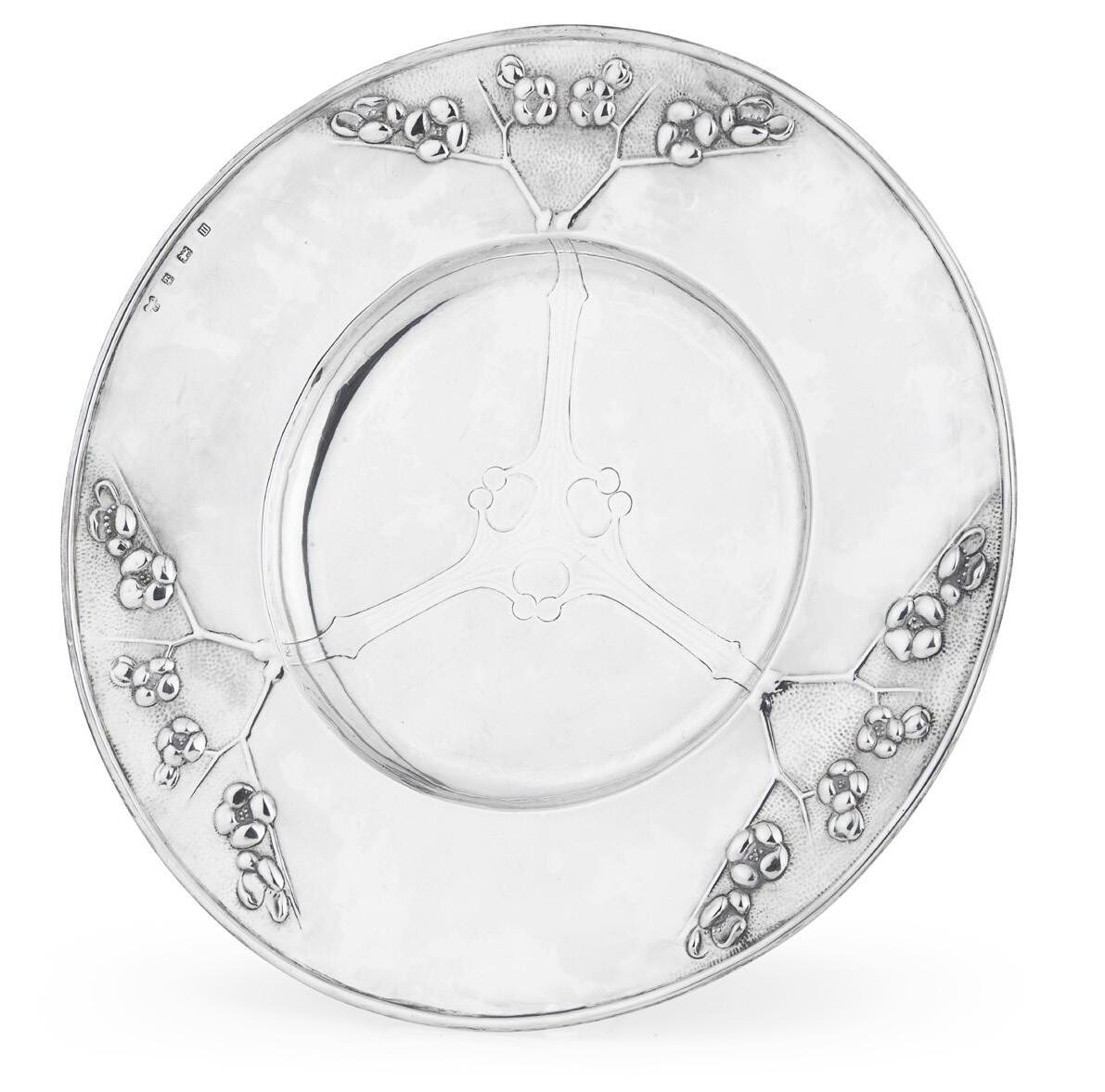
83 Other fees apply in addition to the hammer price: see the ‘Buyer’s Guide’ section on page 2
204
KATE HARRIS (1878‑1949) FOR WILLIAM HUTTON & SONS LTD.
MINIATURE PILL BOX, LONDON 1903
silver and enamel, hallmarked London 1903

5.7cm across £800‑1,200
205
KATE HARRIS (1878‑1949) FOR WILLIAM HUTTON & SONS LTD
SNUFF BOX, LONDON 1901
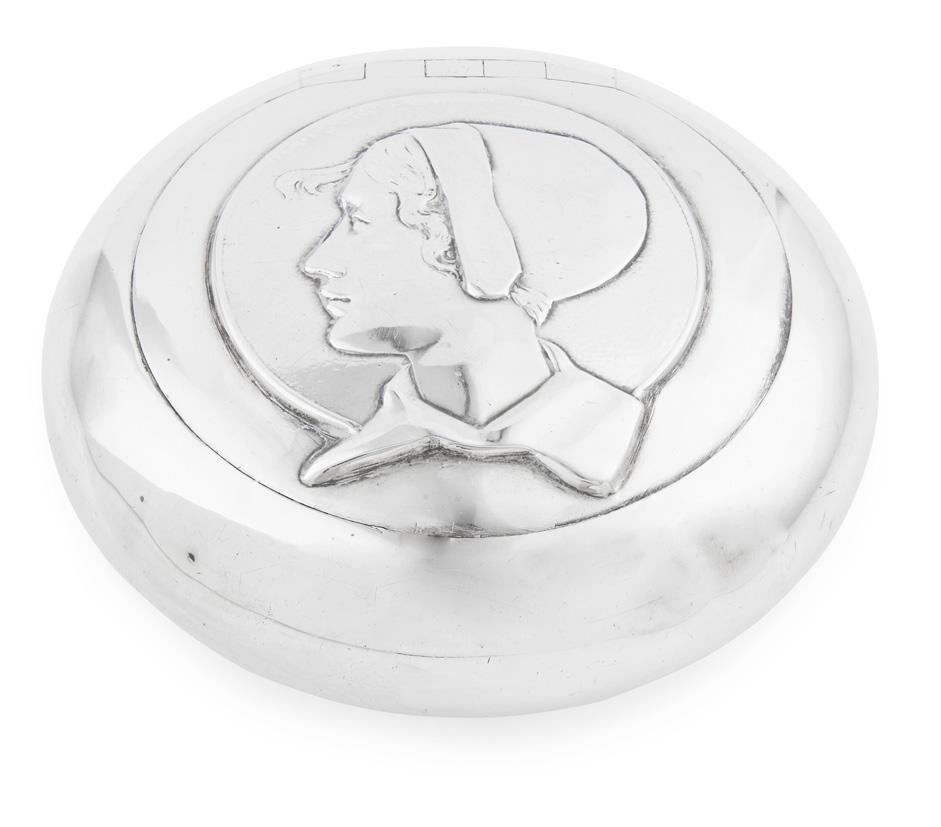
silver and silver‑gilt, hallmarked London 1901, engraved EM to base 7.5cm diameter £300‑500
206
KATE HARRIS (1878‑1949) FOR WILLIAM HUTTON & SONS LTD.
SMALL BOX, BIRMINGHAM 1906
silver and silver‑gilt, hallmarked Birmingham 1906 9cm across £700‑1,000
207
KATE HARRIS (1878‑1949)
FOR WILLIAM HUTTON & SONS LTD.
JEWELLERY CASKET, LONDON 1902

silver, and copper, with wood‑lined interior, stamped RD
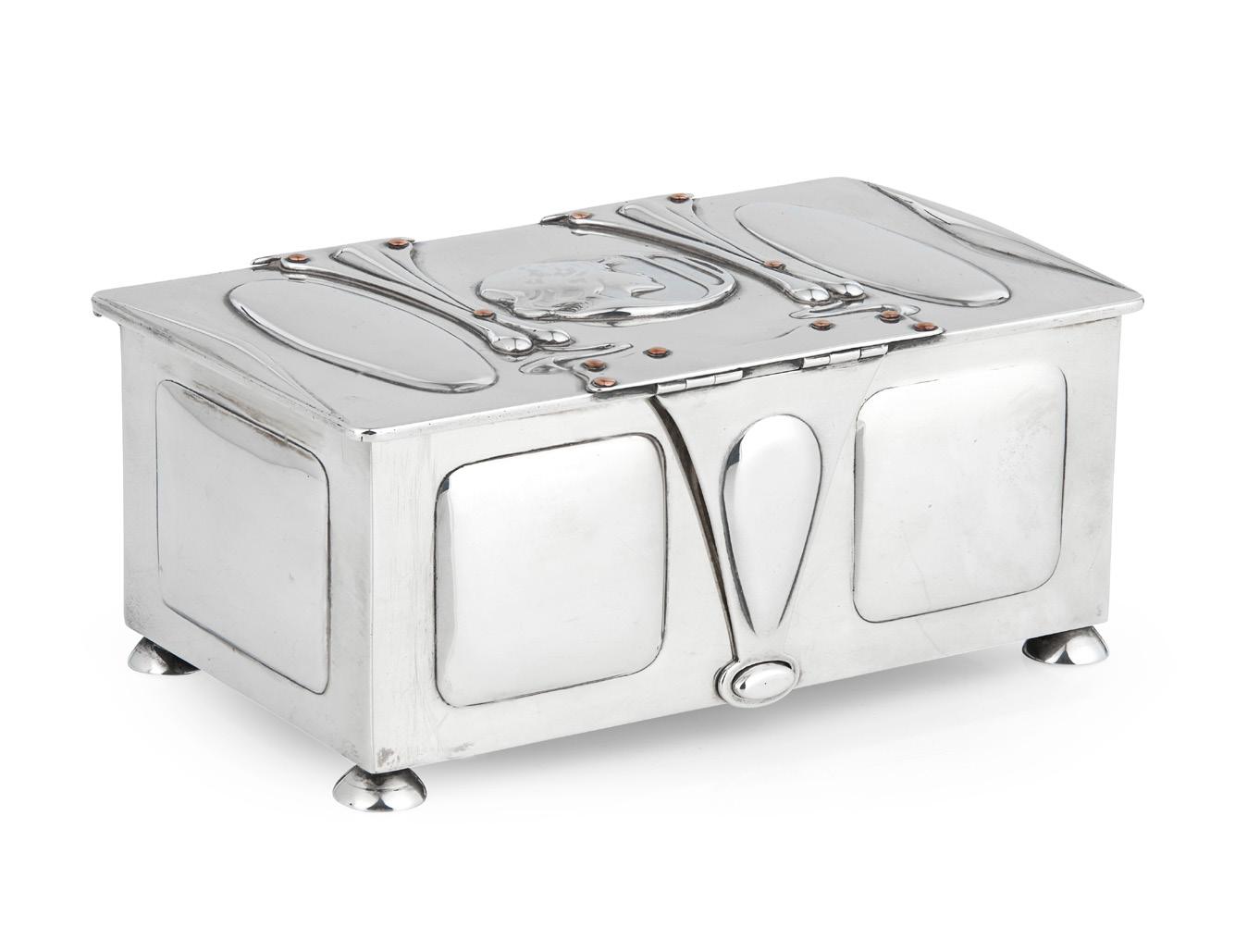
NO 343549, hallmarked London 1902
16cm wide, 7cm high, 9.7cm deep
£1,000‑1,500
84 Other fees apply in addition to the hammer price: see the ‘Buyer’s Guide’ section on page 2
208
KATE HARRIS (1878‑1949) FOR WILLIAM HUTTON & SONS LTD.
THREE‑PIECE COFFEE SET, LONDON 1902

silver, comprising a COFFEE POT, with mother‑of‑pearl handle, 18cm high; a TWIN‑HANDLED SUGAR BOWL, 16cm across including handles; and a MILK JUG, 7cm high, each hallmarked London 1902 and stamped RD352424 (3) £4,000‑6,000

85
212
KATE HARRIS (1878‑1949) FOR WILLIAM HUTTON & SONS LTD.
TWIN‑HANDLED JARDINIÈRE, CIRCA 1900

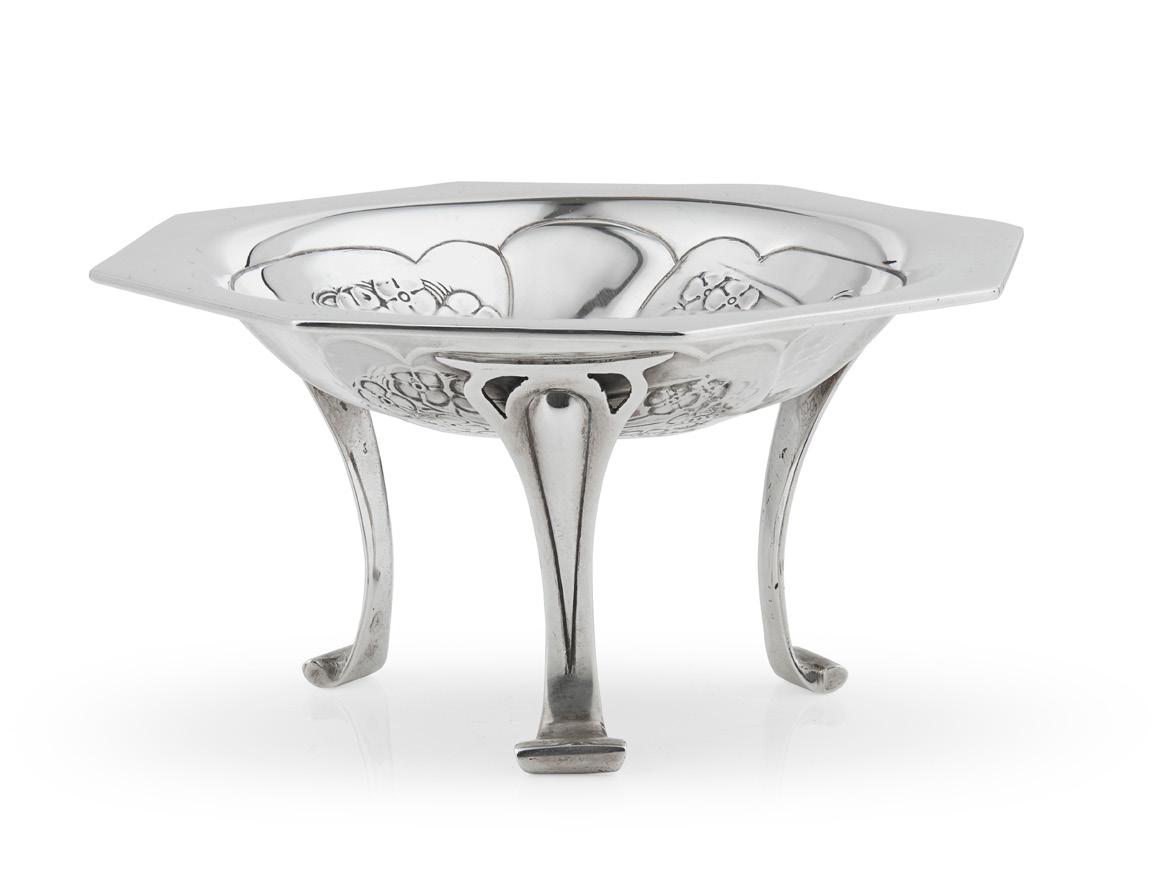
brass with clear glass liner, stamped BRITISH HUTTON MAKE/ W34184
33cm across including handles
£300‑500
209
KATE HARRIS (1878‑1949) FOR GOLDSMITHS & SILVERSMITHS CO. LTD., LONDON
PHOTOGRAPH FRAME, LONDON 1902
silver, with velvet‑lined backing, hallmarked London 1902, stamped GOLDSMITHS & SILVERSMITHS COMPANY LTD/ 112 REGENT ST LONDON, inscribed *lice
27.5cm x 16.2cm
£1,000‑1,500
210
KATE HARRIS (1878‑1949) FOR G. L. CONNELL LTD., LONDON
BON BON DISH, LONDON 1902
silver, stamped manufacturer’s marks and hallmarked London 1902 (indistinct)
13cm across, 7cm high
£200‑300
211
KATE HARRIS (1878‑1949) FOR WILLIAM HUTTON & SONS LTD.
INKWELL, LONDON 1903
cut glass with silver mount, hallmarked London 1903


6.5cm high
£300‑500
86
213
KATE HARRIS (1878‑1949) FOR G. L. CONNELL LTD., LONDON
TWIN‑HANDLED CHRISTENING BOWL, LONDON 1903
silver, with blue glass liner, inscribed THEODORE WATERHOUSE FEB 18TH


1904/ FROM HIS GODMOTHER MARY CREWDSON, hallmarked London 1903
25.5cm across
£1,500‑2,000 214
KATE HARRIS (1878‑1949) FOR WILLIAM HUTTON & SONS LTD
TRINKET BOX, LONDON 1900
silver, hallmarked London 1900
9.5cm wide, 5.5cm high, 5.5cm deep
£500‑800 215
KATE HARRIS (1878‑1949) FOR WILLIAM HUTTON & SONS LTD.
FLOWER VASE, LONDON 1901
silver, hallmarked London 1901

19cm high
£300‑500
87 Other fees apply in addition to the hammer price: see the ‘Buyer’s Guide’ section on page 2
217
ARCHIBALD KNOX (1864‑1933) FOR LIBERTY & CO., LONDON
‘TUDRIC’ TWIN‑HANDLED BOWL, CIRCA 1900
pewter, with green glass liner, stamped TUDRIC/
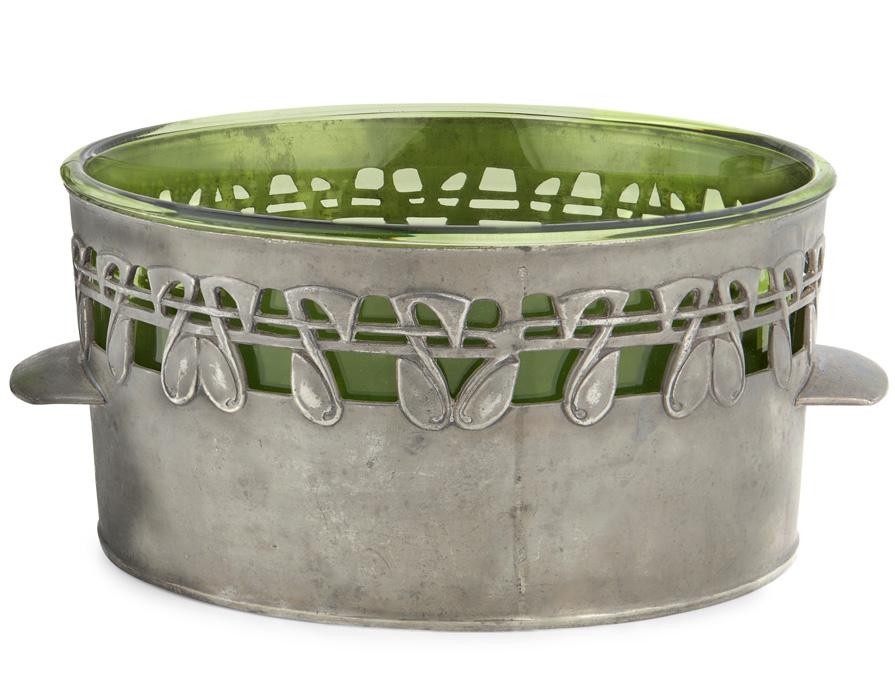
9/ MADE IN ENGLAND/ 0317R
22cm diameter
£300‑500
219
ARCHIBALD KNOX (1864‑1933)
‘MANNIN: A JOURNAL OF MATTERS PAST AND PRESENT RELATING TO MANN’
published by Ynches Haght, Gailckagh, The Manx Language Society, Peel, 1913 etc., with cover design and initial letters by Archibald Knox; Issue No. 7, May 1916 has an article on Knox with two black & white illustrations of his metalwork, ten issues and Index booklet (qty)
£200‑300
216
ARCHIBALD KNOX (1864–1933)
FOR LIBERTY & CO., LONDON
PAIR OF ‘TUDRIC’ CANDELABRA, CIRCA 1904 pewter, stamped MADE BY LIBERTY & CO/ MADE IN ENGLAND/ PEWTER/ 2/ TUDRIC/ 0530 (2)

28.2cm high
Literature: Martin, S. A., ‘Archibald Knox’, Art Media Press, 2001, p. 217 where a similar example of this model is illustrated
£2,500‑3,500
218
ARCHIBALD KNOX (1864‑1933) FOR LIBERTY & CO., LONDON
PAIR OF ‘TUDRIC’ BULLET CANDLESTICKS, CIRCA 1900

pewter, stamped MADE IN ENGLAND/ J/ ENGLISH PEWTER/ 0221/ P/ MADE BY LIBERTY & CO. (2)
16cm high
£300‑500
220
MANNER OF ARCHIBALD KNOX
UNUSUAL SET OF FOUR FURNITURE HANDLES, CIRCA 1910
patinated metal, stamped RD556263 (4)
9.3cm across
Literature: Martin, Stephen, Archibald Knox, Second Edition 2001, p.271, illustration of various buttons with matching characteristic Knox boss motif
£200‑300
88 Other fees apply in addition to the hammer price: see the ‘Buyer’s Guide’ section on page 2
ARCHIBALD KNOX (1864‑1933) FOR LIBERTY & CO., LONDON
‘TUDRIC’ CRUCIFORM CLOCK, CIRCA 1902
pewter, with abalone inlay, stamped TUDRIC/ 097
36cm high
Literature: Stephen A. Martin (ed.), Archibald Knox, London, 2001, p. 235
Note: Archibald Knox’s designs for Liberty & Co. are very well documented, especially his designs for their ‘Tudric’ and ‘Cymric’ ranges. Knox was known to have produced only a few very large clocks during his Liberty period and, at a towering 36cm, this is one such example.
His work draws on the rich cultural heritage of his native Isle of Man. As with many of the larger clocks that are known to exist, their monumental and minimalist forms are reminiscent of the standing Celtic stones which populate the island’s countryside and that Knox spent a lifetime exploring. The decoration on this example, stripped of superfluous ornament, incorporates abalone shell inlay as a repeating series of roundels; a stark and striking visual effect that signals a modernist approach to the design. This impressive clock fulfils Knox’s desire to bring together two worlds which he valued deeply: the ancient Celtic tradition and the new, modern world of design, which was undergoing the development of a new and innovative aesthetic.
£10,000‑15,000

221
89
222
JESSIE MARION KING (1875‑1949) FOR LIBERTY & CO., LONDON
ARTS & CRAFTS NECKLACE, CIRCA 1900
15 carat gold, enamel, seed pearls, stamped to clasp 15CT
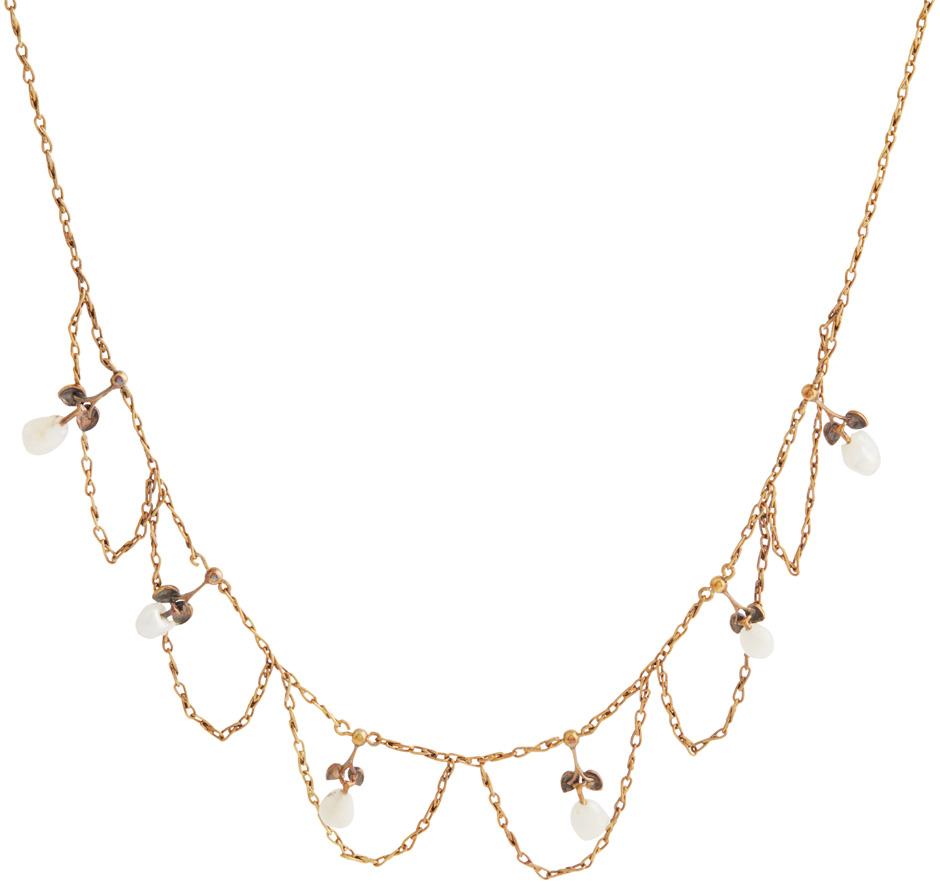

38cm long
£400‑600
223
ARCHIBALD KNOX (1864‑1933) FOR LIBERTY & CO., LONDON
‘CYMRIC’ NOTECASE HOLDER, LONDON 1899
silver and enamel, stamped maker’s marks and hallmarks for London 1899
5cm x 7cm
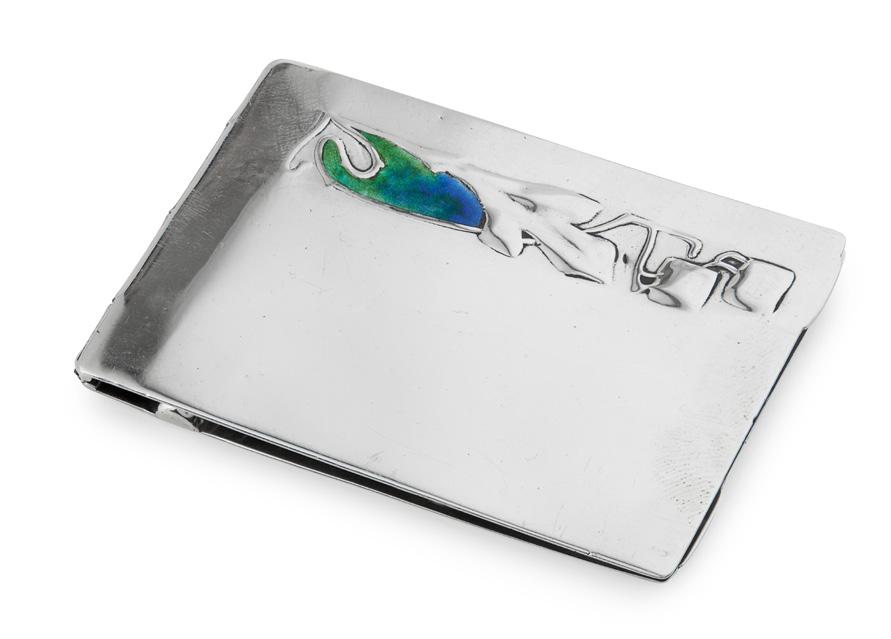
£300‑500
224
ARCHIBALD KNOX (1864‑1933) FOR LIBERTY & CO., LONDON
MUSTARD POT & SPOON, BIRMINGHAM 1917
silver, set with three turquoise cabochons, hallmarked Birmingham 1917, stamped 492
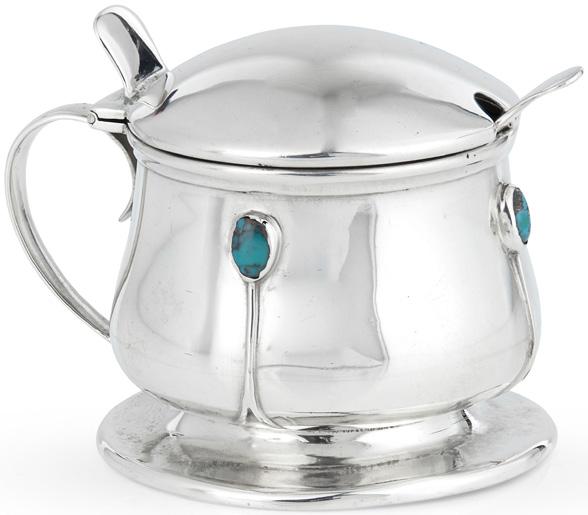

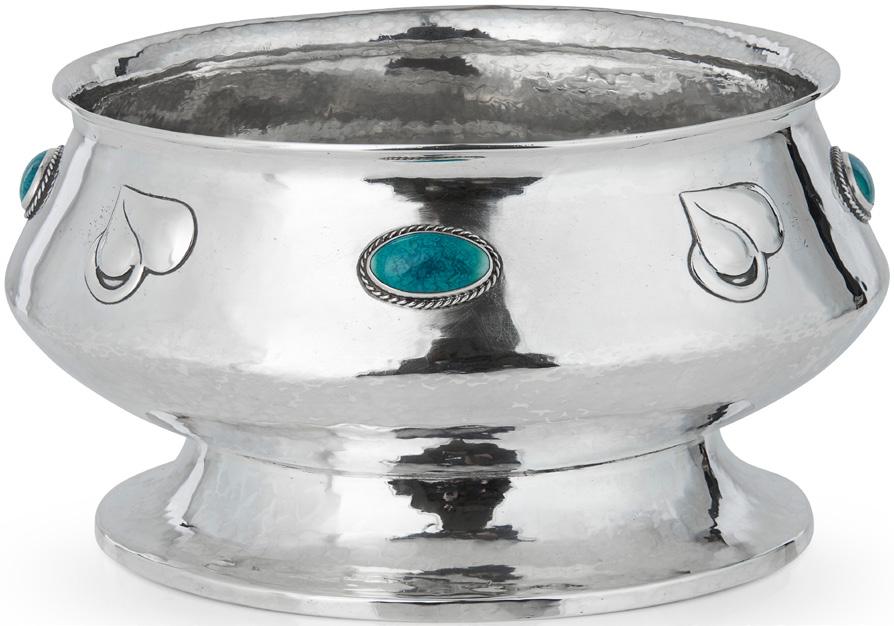
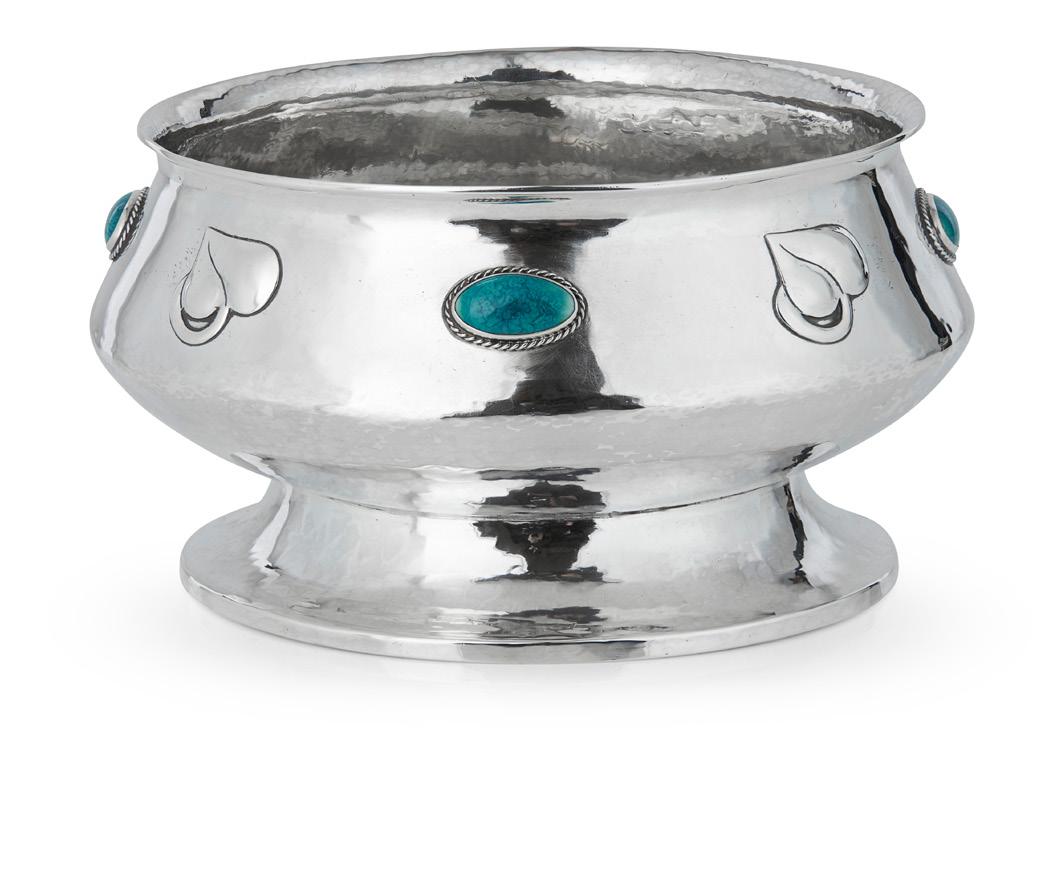
5.5cm high
£300‑500
225
A. E. JONES (1878‑1954)
ARTS & CRAFTS ROSE BOWL, BIRMINGHAM, 1903
silver, with four applied Ruskin pottery ovals, hallmarked

Birmingham 1903
16cm diameter
Literature: Illustrated in the Studio Yearbook, 1906
£1,000‑1,500
90
226
LIBERTY & CO., LONDON
‘KNIGHT’S CASTLE’ FRAMED FABRIC PANEL, CIRCA 1960 printed linen, marked to selvedge HAND‑PRINTED VAT COLOURS

LIBERTY OF LONDON
119cm x 109cm
£300‑500
227
LIBERTY & CO., LONDON
ARTS & CRAFTS BUREAU BOOKCASE, CIRCA 1910

oak, with applied copper alloy fittings and leaded glass panelled doors, tooled leather skiver, bears applied inscription to cornice BY NATURE COMES TO WRITE AND READ
106.5cm wide, 211.5cm high, 50cm deep £1,000‑1,500
228
WILLIAM MOORCROFT (1872‑1945)
FOR JAMES MACINTYRE & CO.
GROUP OF ‘EIGHTEENTH CENTURY’ PATTERN WARES, CIRCA 1910
glazed earthenware with gilded highlights, comprising a BALUSTER VASE, 32cm high; a TWIN‑HANDLED VASE, 21cm high, a FURTHER TWIN‑HANDLED VASE, 13.5cm high; and a SMALL BOWL, 12cm diameter, all with green painted signature (4)
£300‑500
91 Other fees apply in addition to the hammer price: see the ‘Buyer’s Guide’ section on page 2
229
LIBERTY & CO., LONDON
WALL MIRROR, CIRCA 1910
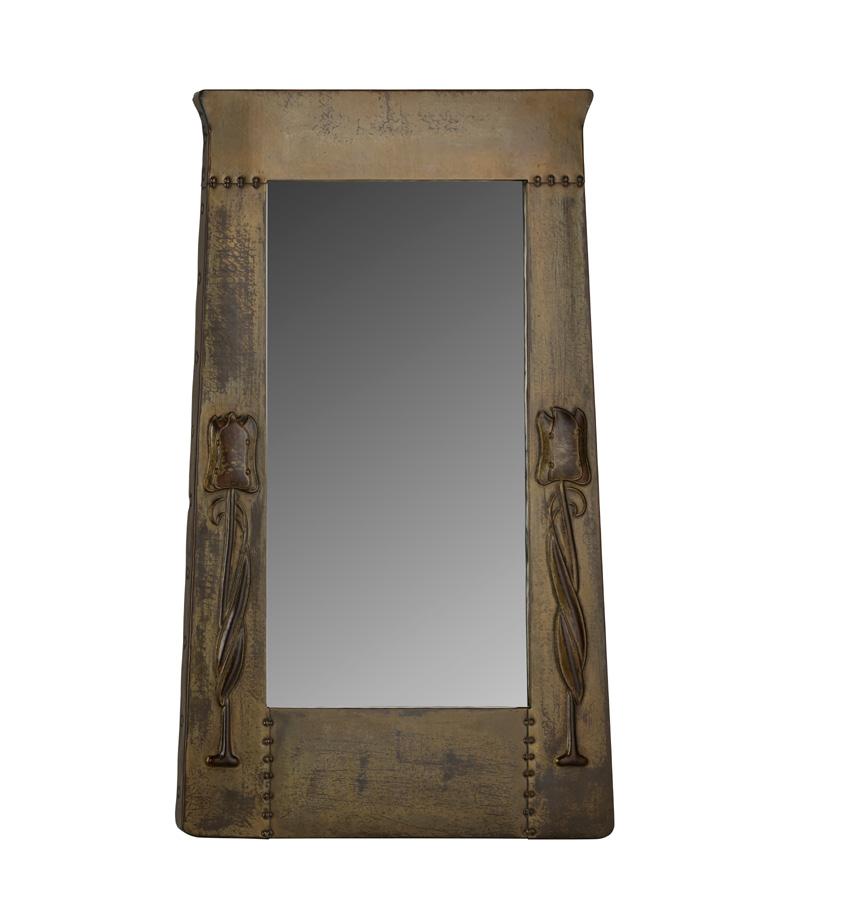
plated copper, mirrored glass
63.5cm x 39cm
£300‑500
230
LIBERTY & CO., LONDON (ATTRIBUTED MAKER)
PAIR OF ARMCHAIRS, CIRCA 1900
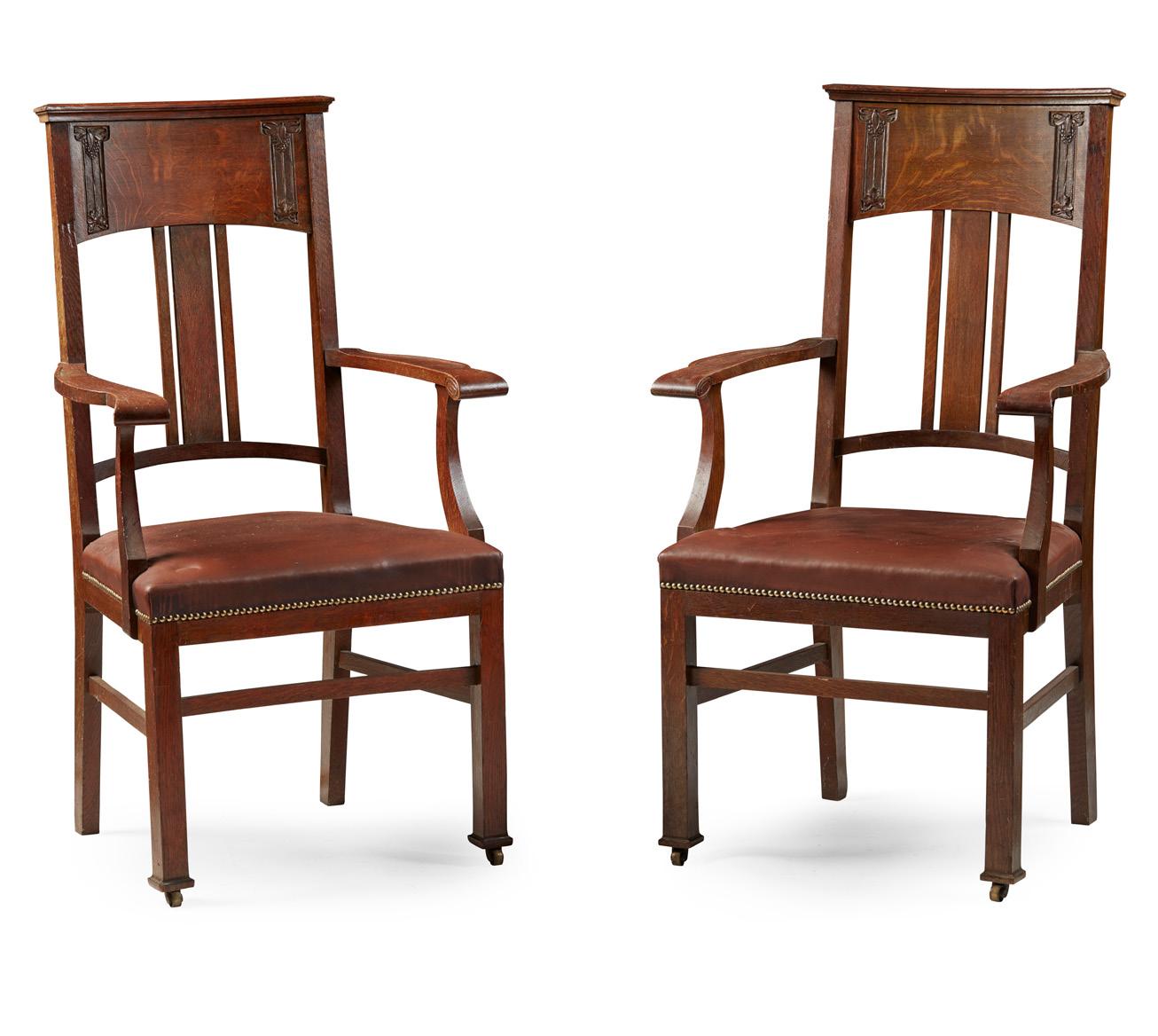
carved oak, with close‑nailed leather upholstered seats (2)
64cm wide, 119cm high, 53cm deep
Provenance: These chairs were used by The Prince and Princess of Wales at the opening of the Glasgow Garden Festival in 1988.
£600‑800
231
LIBERTY & CO., LONDON
ARTS & CRAFTS THREE‑FOLD SCREEN, CIRCA 1900
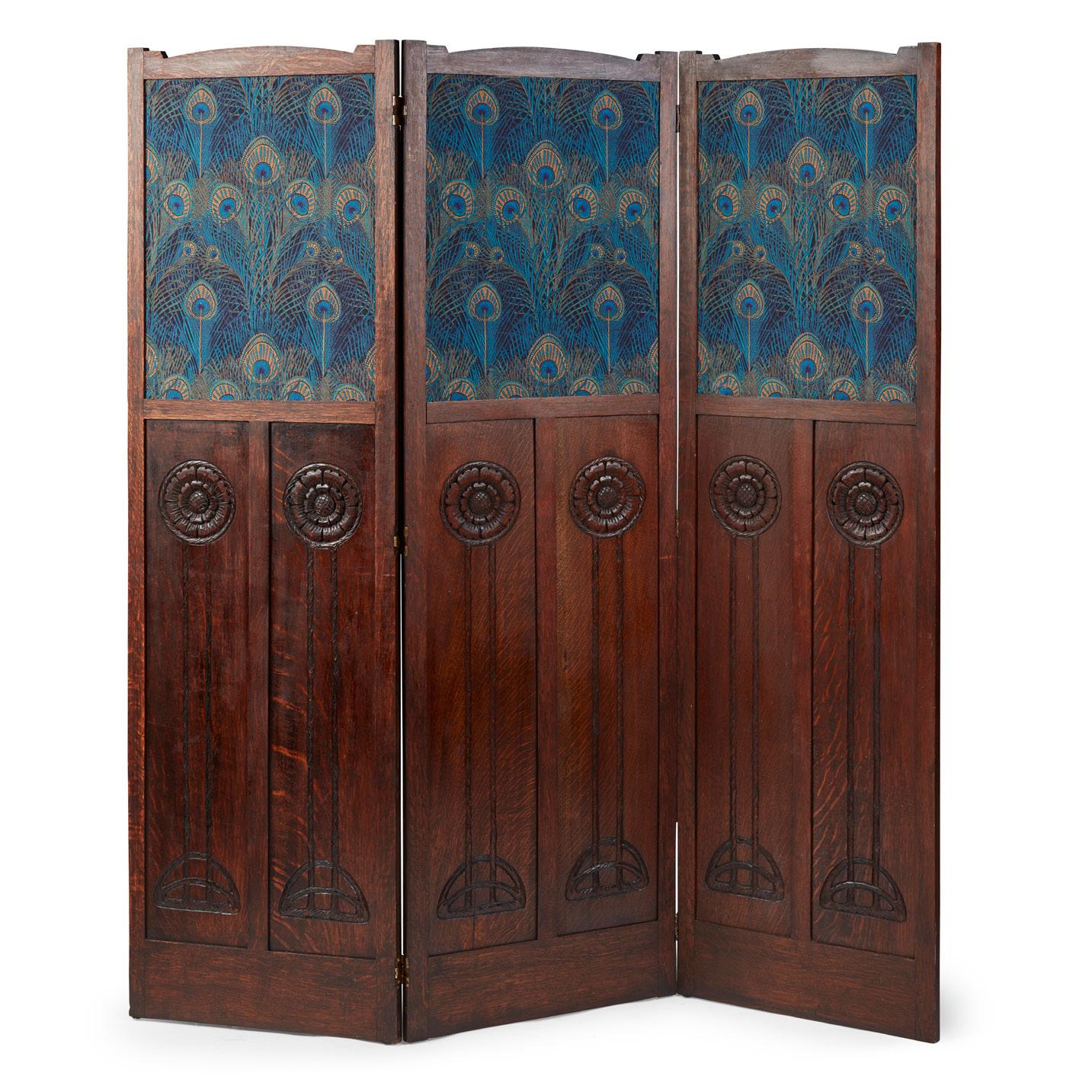
carved oak, with later printed fabric panels, applied
ivorine maker’s label
Each fold 52cm wide, 178cm high
£500‑800
232
LIBERTY & CO., LONDON (ATTRIBUTED MAKER)
ARTS & CRAFTS CABINET, CIRCA 1900
stained and carved oak, with three sliding doors to a shelved interior
163cm wide, 107cm high, 50cm deep
Provenance: Previously from The Millinery Works Collection.
£300‑500
92 Other fees apply in addition to the hammer price: see the ‘Buyer’s Guide’ section on page 2
234
ARCHIBALD KNOX (1864‑1933) FOR LIBERTY & CO., LONDON
‘TUDRIC’ CLOCK, CIRCA 1900

pewter, inlaid with abalone shell, stamped TUDRIC 0252 17cm high
Literature: Liberty Pewter Sketch Book, Westminster City Archives, London, n.d., p. 57, no. 0252
Tilbrook, Adrian J. The Designs of Archibald Knox for Liberty & Co., London, 1995, p. 106, no. 88
Martin, Stephen A. Archibald Knox, Art Media Press, London, 2001 pp. 240 and 241
£4,000‑6,000

233
ARCHIBALD KNOX (1864‑1933) FOR LIBERTY & CO., LONDON
JEWELLERY BOX, 1902
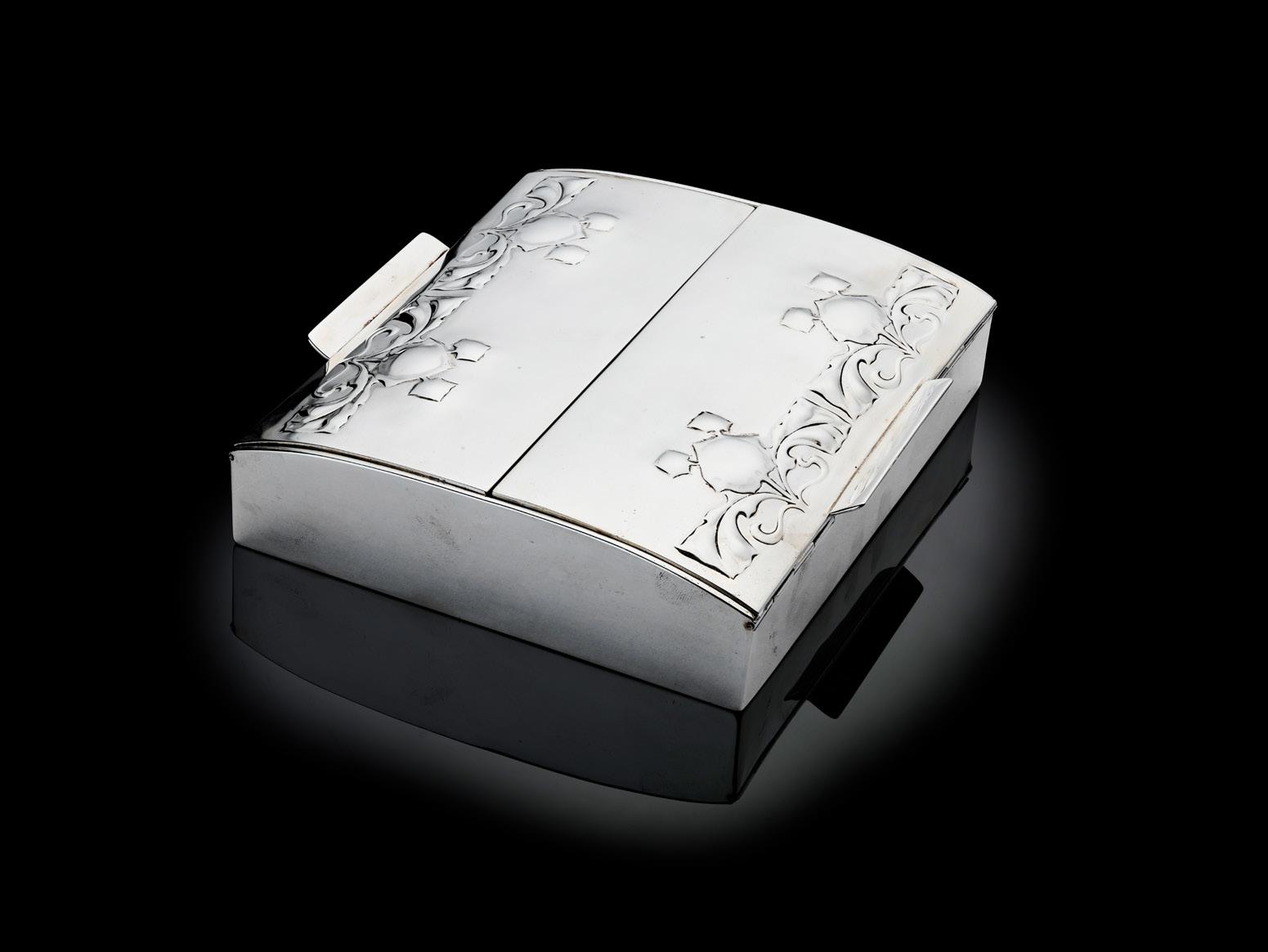
silver, later suede‑lined interior, indistinctly stamped L&Co/ CYMRIC, indistinctly hallmarked Birmingham 1902
16.8cm wide, 3.5cm high, 16.5cm deep
Note: This rare box will be included in the forthcoming monograph on Archibald Knox, edited by Stephen Martin.
£2,000‑3,000
93
235
ARCHIBALD KNOX (1864‑1933) FOR LIBERTY & CO., LONDON
‘TUDRIC’ GOBLET, CIRCA 1900
pewter, with green glass bowl, stamped MADE IN ENGLAND/ 7/
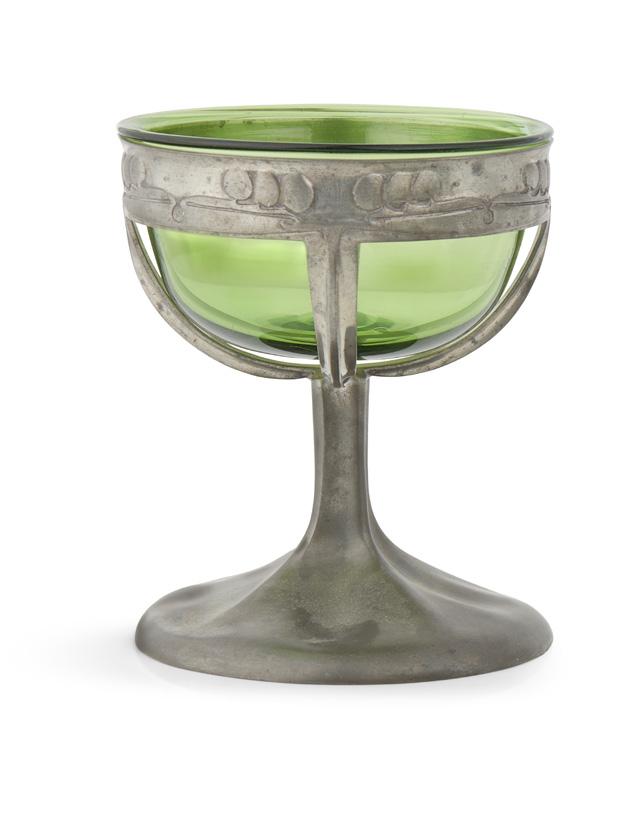
TUDRIC/ PEWTER/ 0956
15.5cm high
£400‑600
236
ATTRIBUTED TO LIBERTY & CO., LONDON
ANGLO‑MORESQUE OCCASIONAL TABLE, CIRCA 1900
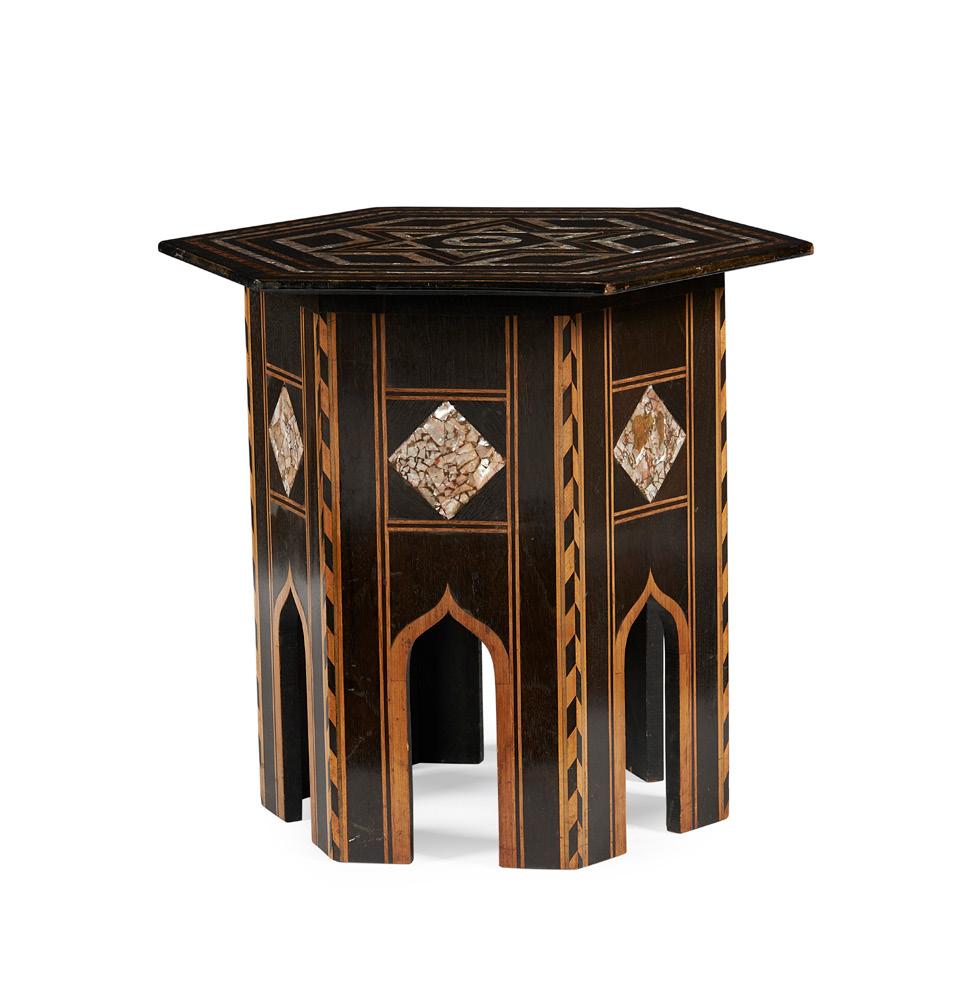


47cm wide, 72cm high
LIBERTY & CO., LONDON (ATTRIBUTED RETAILER)
ANGLO‑MORESQUE TABLE, CIRCA 1900
inlaid and ebonised wood, with mother‑of‑pearl
49cm across, 49cm high
£300‑500
238
LIBERTY & CO., LONDON (ATTRIBUTED RETAILER)
ANGLO‑MORESQUE TABLE, CIRCA 1890
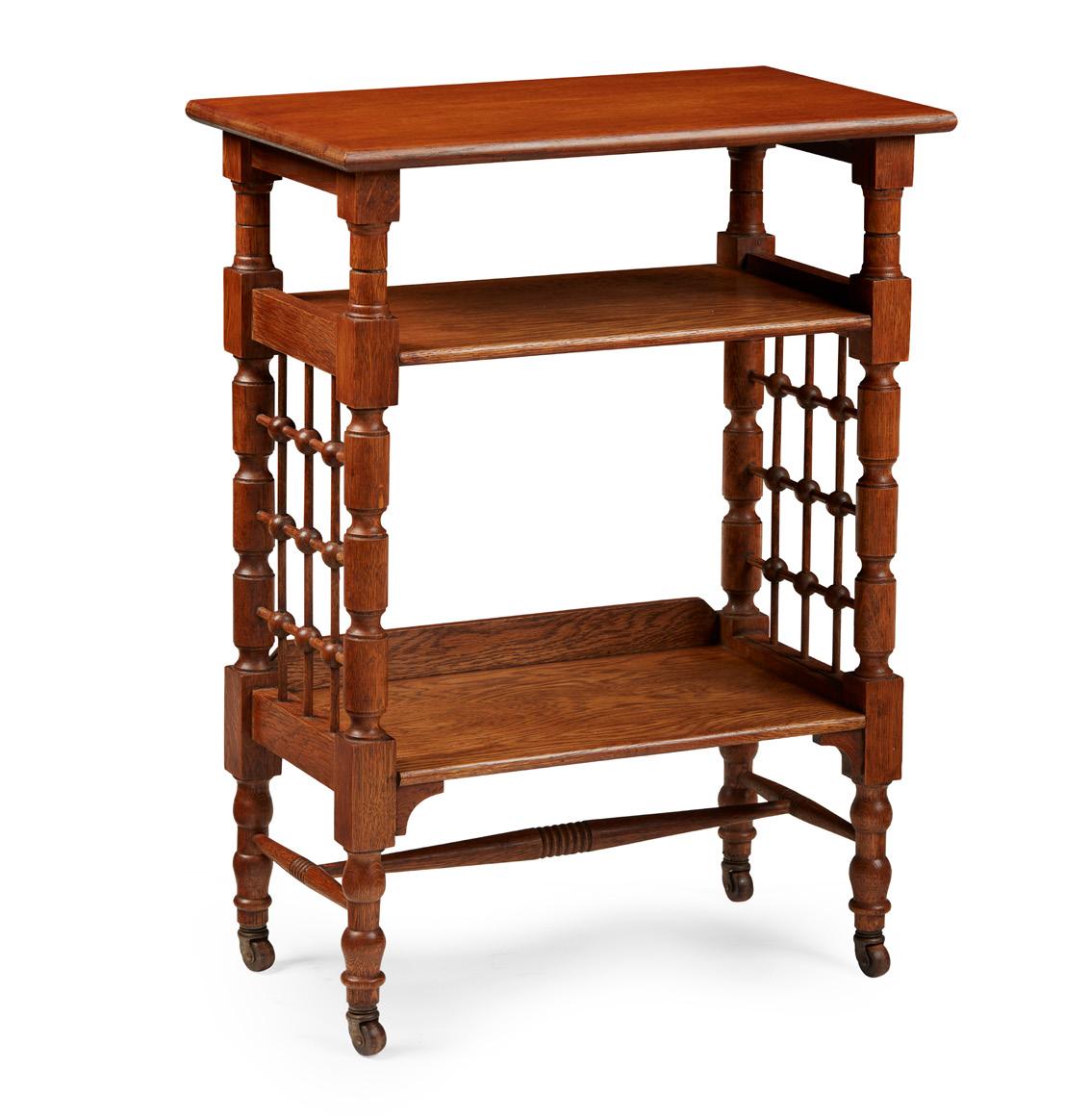
inlaid and ebonised wood, with mother‑of‑pearl
61cm across, 61cm high
£400‑600
239
LEONARD WYBURD (1865‑1958) FOR LIBERTY & CO., LONDON
ARTS & CRAFTS TABLE, CIRCA 1900 oak
59cm wide, 79.5cm high, 34cm deep
£300‑500
94
240
LIBERTY & CO., LONDON PAIR OF BOOKCASES, CIRCA 1910


oak (2)
57cm wide, 97.5cm high, 19.7cm deep
£400‑600
241
MANNER OF LIBERTY & CO., LONDON CANTERBURY, CIRCA 1900
carved walnut
61cm wide, 34cm deep, 66cm high
£400‑600
242
WILLIAM MOORCROFT (1872‑1945) FOR JAMES MACINTYRE & CO.
‘FLORIAN WARE’ JARDINIÈRE, CIRCA 1900
glazed earthenware, painted WM/ DES in green, printed ‘Florian Ware’ factory stamp, impressed marks (indistinct), 14.5cm diameter; together with a ‘DUBARRY WARE’ PLATE, for James Macintyre & Co., glazed earthenware, printed factory stamp, registration number 211991, 27cm diameter (2) £300‑500
95 Other fees apply in addition to the hammer price: see the ‘Buyer’s Guide’ section on page 2
ARCHIBALD KNOX (1899‑1933)
AUTUMN TREES, CIRCA 1905
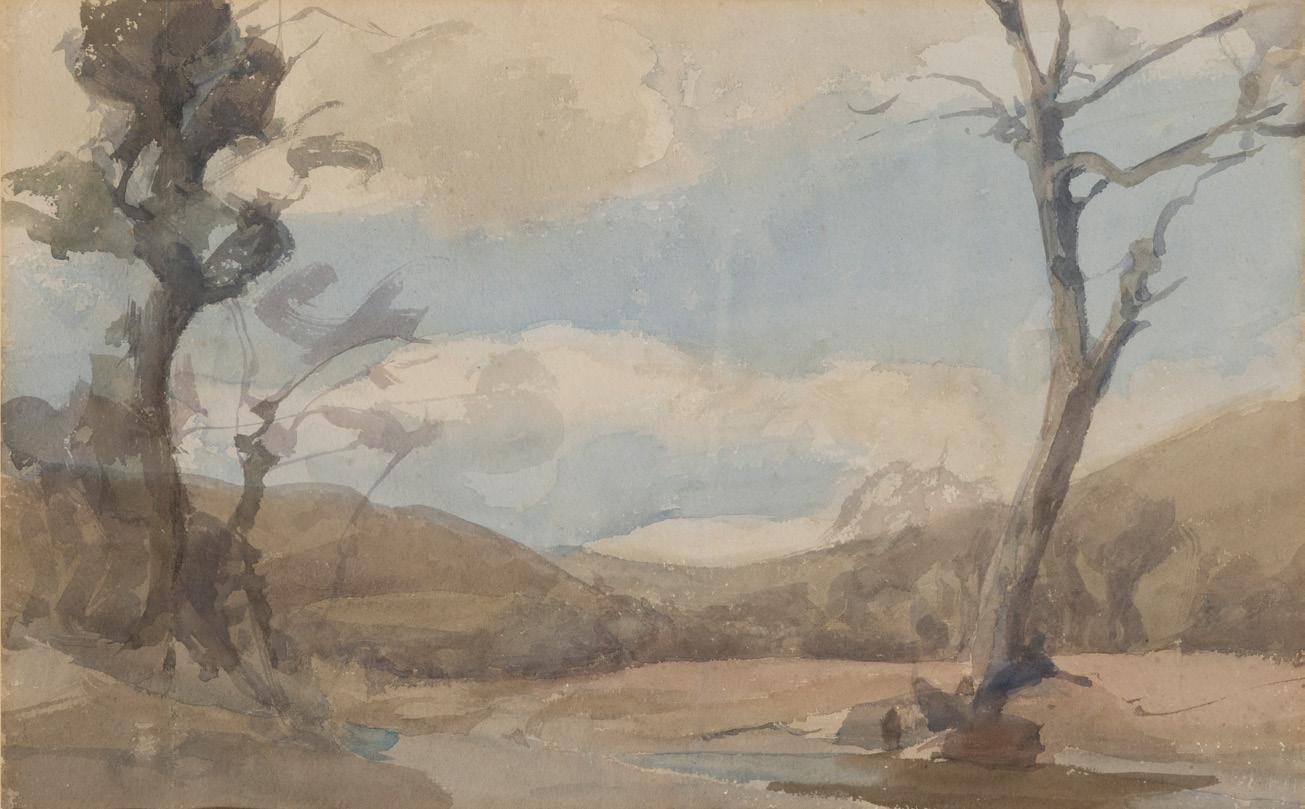
watercolour on paper, framed 65.7cm high, 90.7cm wide including frame
£1,800‑2,500
244
ARCHIBALD KNOX (1864‑1933) FOR LIBERTY & CO.,
LONDON
PAIR OF FLOWER VASES, BIRMINGHAM 1909
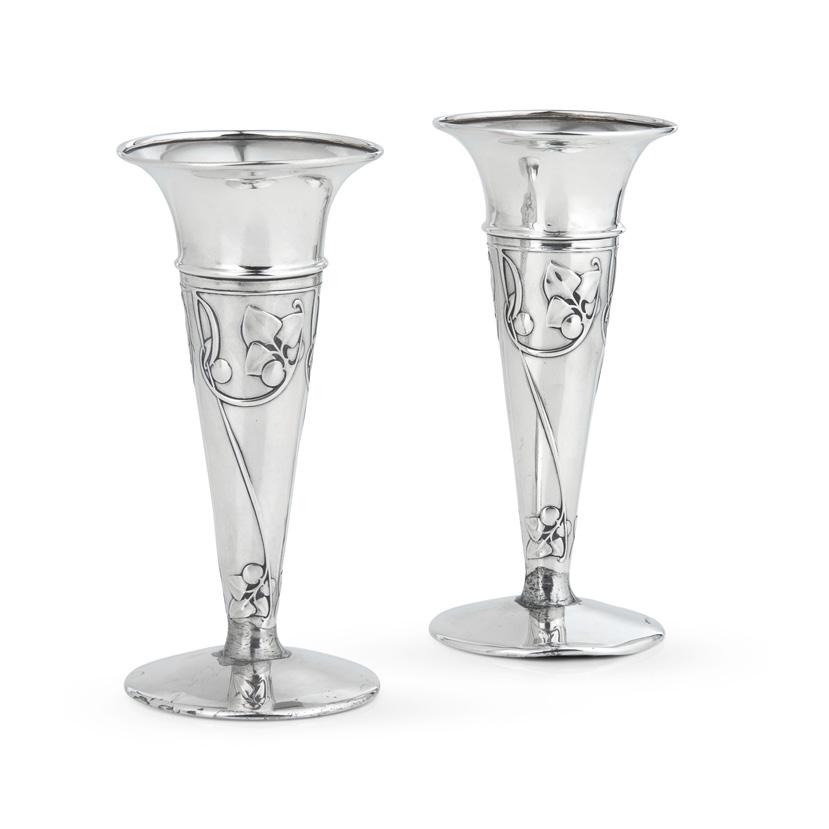
silver, stamped marks for W. H. Haseler, hallmarked Birmingham 1909 (2)
14.8cm high
£400‑600
245
ARCHIBALD KNOX (1899‑1933) FOR LIBERTY & CO., LONDON
PAIR OF ‘CYMRIC’ BRUSHES, BIRMINGHAM 1925
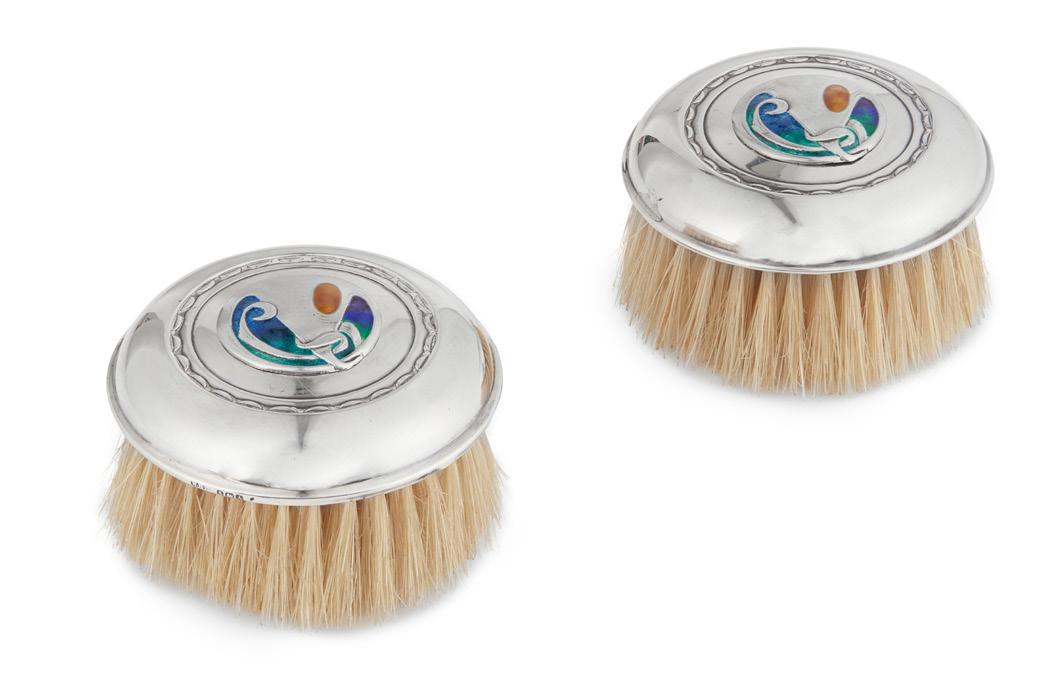
silver and enamel, made by William H. Hasler, stamped marks and hallmarked Birmingham 1925, within fitted box (2)
7.5cm diameter
£400‑600
246
ARCHIBALD KNOX (1864‑1933) FOR LIBERTY & CO.,
LONDON
CASED SET OF SIX SPOONS, BIRMINGHAM 1903
silver and enamel, each with maker’s mark L&CO, hallmarked Birmingham 1903, within a fitted case with silk and brushed suede lining, stamped LIBERTY & CO. LTD/ REGENT ST./
LONDON (6)
each spoon 11.6cm long
£500‑800

243
96 Other fees apply in addition to the hammer price: see the ‘Buyer’s Guide’ section on page 2
247
ARCHIBALD KNOX (1864‑1933) FOR LIBERTY & CO., LONDON
‘TUDRIC’ CLOCK MODEL NO. 096, CIRCA 1902‑5
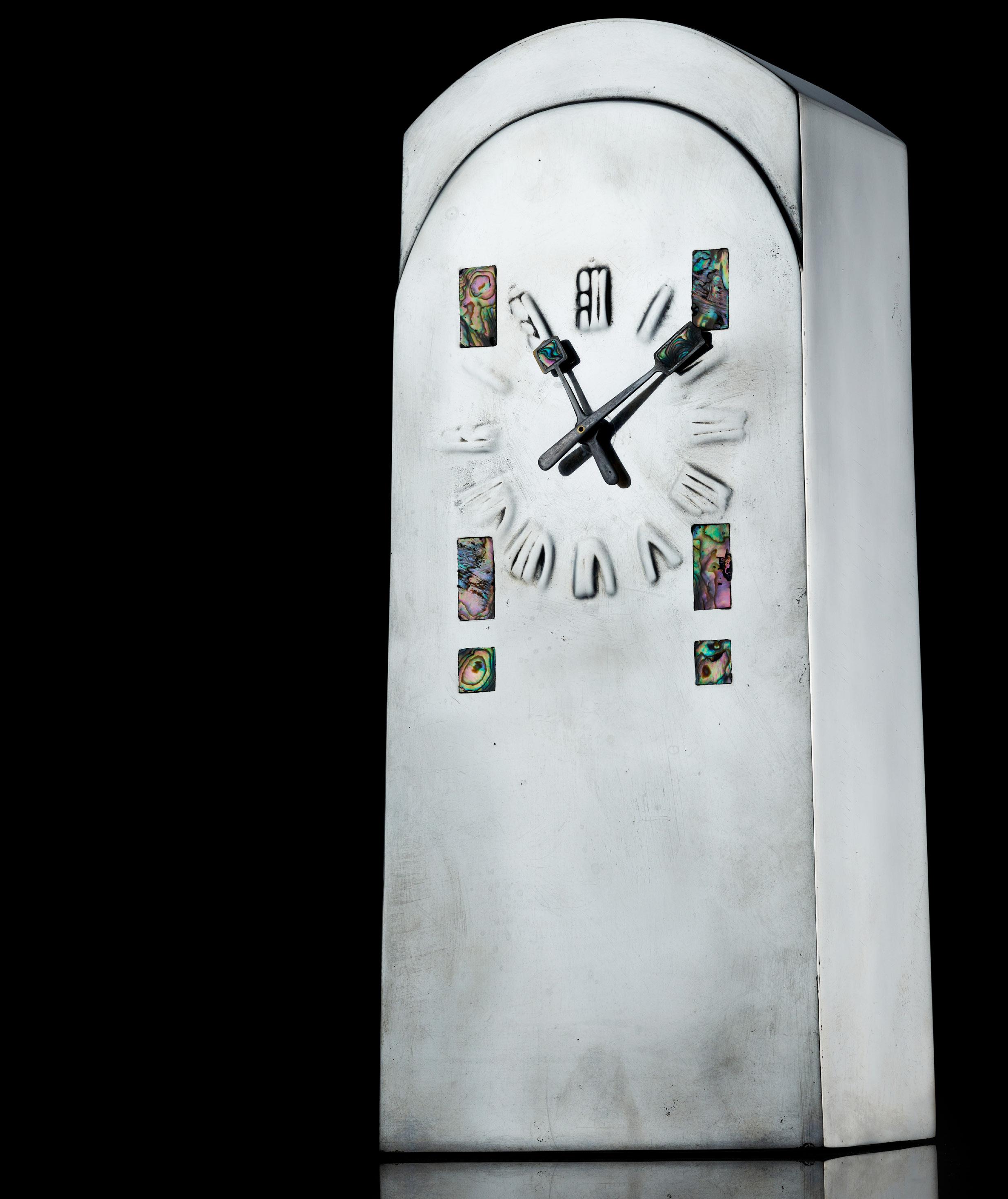

pewter and abalone, stamped under base 096
29.5cm high
Literature: Martin S. Archibald Knox, London 2001, p. 235 illus. £12,000‑18,000
97
248
LEONARD WYBURD (1865‑1958) (ATTRIBUTED DESIGNER) FOR LIBERTY & CO., LONDON SET OF EIGHT ‘ARTHURIAN’ DINING CHAIRS, EARLY 20TH CENTURY
oak, with later upholstery (8)
73cm wide, 90cm high, 49cm seat depth
Provenance: Jimmy Page
Paul Reeves: The Best of British Design from the 19th & 20th Centuries, Sotheby’s, 20th March 2008, lot 79

Private collection
Literature: Bennett, D. Liberty’s Furniture, Woodbridge 2012, p.48
Note: Leonard Wyburd, principal designer for Liberty & Co. from 1883, was inspired by ‘themes of chivalry and visions of a golden past’ which were so prevalent in 19th century art and design. His Handbook of Sketches of 1885 made references to knights and armour, and he was still using this theme to great effect in his watercolour studies at the Royal Academy in 1904.
£1,500‑2,000
98
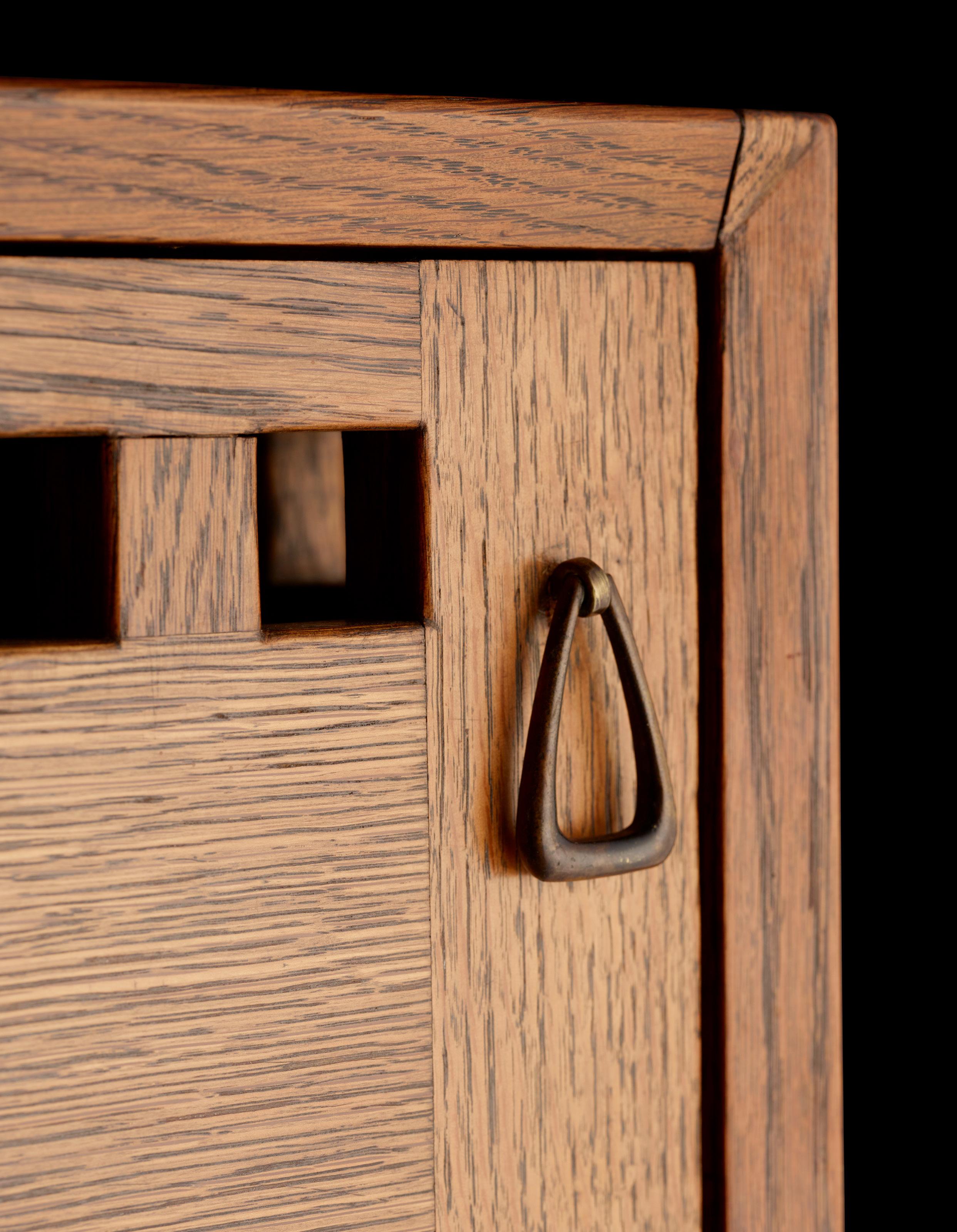
99
CHARLES RENNIE MACKINTOSH (1868‑1928)
CABINET FOR THE BLUE BEDROOM, HOUS’ HILL, 1904
oak, with brass handles and mother‑of‑pearl inlay 38cm (15in) wide, 168cm (66 1/8in) high, 33.6cm (13 1/4in) deep
Literature: Billcliffe, R. Charles Rennie Mackintosh: The Complete Furniture, Furniture Drawings & Interior Designs, Cameron & Hollis 2009, pp. 195‑197, 1904.J period photograph of the Blue Bedroom illus.; pp. 207 and 208, 1904.65 ‘Design and layout of furniture for the Blue Bedroom’; 1904.67 ‘Cabinet for the Blue Bedroom, Hous’hill’; 1904.67 illus.
Arwas V. Art Nouveau in Britain from Mackintosh to Liberty: The Birth of a Style, Andreas Papadakis, 2000, p.41, where this cabinet is illustrated.
Note: In 1903‑04, after working together on the Willow Tearooms in Glasgow for his patron Kate Cranston, Charles Rennie Mackintosh was invited to redecorate and refurbish her home ‘Hous’hill’, on the city’s outskirts. At this stage in his career, Mackintosh was in the throes of an innovative phase of creativity: experimenting with new materials, textures and forms, and how these contrasting elements could work coherently within a particular space. The ideas manifested at Hous’hill would inform future furniture designs and interiors, culminating in the commission for the second phase of The Glasgow School of Art in 1910.
Prior to his work on Hous’hill, many of Mackintosh’s interior schemes were white: elegant, white‑painted furniture adorned open white spaces which he decorated with flashes of coloured glass or stencilled roses. White interiors were also employed at Hous’hill however in the Blue Bedroom the furniture was typically stained or waxed and served as devices to break up what was a rather ordinary rectangular room. Stylised organic forms and Glasgow rose motifs were used sparingly; photographs and preliminary plans of

the bedroom indicate that decoration of this kind was minimal and largely reserved for the stained glass on a few basket lamps which were carefully positioned around the room.
This striking bedside cabinet, one of two produced for the bedroom, is decidedly rigid in form and follows a preference for simple geometric outlines. The elongated rectangular structure is further emphasised by a series of rectangular inlets for storing books and magazines. This effect is enhanced by the fine graining of the timber, which flows upwards in the direction of the exterior panelling. The decoration is relatively restrained and relies on a precise arrangement of cut‑out and inlaid squares, some of which have been inset with mother‑of‑pearl. Mackintosh’s preference for geometric linearity was carefully balanced with the subtle use of a curved stained‑glass panel, originally located in the central alcove of the cabinet, but now absent. By staining the cabinet as opposed to painting it white, Mackintosh allows the timber to play a role in its simple decoration. Contrasting textures of glass, brass, mother‑of‑pearl and the grain of the timbers work in harmony to create an innovative design which evokes an elegant yet restrained level of decoration. Other examples of furniture in the bedroom follow these new ideas to create a visually arresting interior scheme which would dominate some of his later commissions.
The two bedside cabinets were made for the Blue Bedroom by Francis Smith, one of Mackintosh’s regular cabinetmakers. His original designs for the interior show this example standing tall on the left‑hand facing side of the bed, closely positioned by the bed for ease of use and with a chair alongside each to balance the room. However, period photographs indicate Miss Cranston opted to position the cabinets slightly further away from the bed than initially intended, and the chairs were moved elsewhere. The other bedside cabinet now resides in a private collection.
£30,000‑50,000
249
A period photograph of the Blue Bedroom showing the current lot in situ
100
Image courtesy of the Glasgow School of Art

101
By 1914, Mackintosh’s professional fortunes were dwindling and life in Glasgow became unbearably oppressive. Following the completion of the Glasgow School of Art in 1909, Honeyman, Keppie & Mackintosh’s business received very little work, much like their competitors, as the city was grappling with a recession. Mackintosh resigned as partner of the firm in December 1913, supposedly with the intention of setting up his own company, yet sadly nothing came of this. Clearly requiring some rest and recuperation from this drastic turn of events, the Mackintoshes left Glasgow for a summer break to Walberswick in June 1914, but the uncertainty of the First World War and a rather unstable economic climate persuaded them to remain in the village for fifteen months.
Like a number of coastal villages across the UK, Walberswick became a hub of artistic creativity in the summer months. Bright blue skies, endless coastal cliffs and colourful fields as far as the horizon brought the likes of Philip Wilson Steer, E. A. Walton and Mary Newbery Sturrock to this charming fishing and boatyard community. Mary Newbery was the daughter of Frances Newbery, Headmaster of the Glasgow School of Art at the time Mackintosh designed its new premises. The two men had formed a very close friendship during their time in Glasgow. Mary was convalescing in Walberswick while the Mackintoshes were staying in the village, close to her family’s villa there. Every day they would venture over to her studio and it is thought that Mackintosh was encouraged by the Newberys to turn to painting during this time, in his search for solace and seclusion.
Over the next ten months or so, Mackintosh made over forty botanical watercolour studies using a variety of species: from wild plants such as willow catkins and kingcups to garden favourites fuchsias and petunia, as well as flowers from local fields and hedgerows such as sorrel and chicory. From 1901 Mackintosh had been sketching similar plants and flowers whilst on holiday within Britain, and further afield in Italy and Portugal. These earlier studies are more technical in composition; the background is almost completely abstract as alternating and overlapping perspectives of botanical cross‑sections are illustrated. The focus of these sketches was analytical: investigating ways in which certain plant forms could be stylised to create abstract patterns on the page.
250

CHARLES RENNIE MACKINTOSH (SCOTTISH 1868‑1928)
IVY SEED, WALBERSWICK
pencil and watercolour, inscribed, signed and dated lower right IVY SEED/ WALBERSWICK/ 1915/ CRMMMM
22.5cm x 18.2cm
Provenance: Acquired after the Memorial Exhibition, 1933, by R. W. B. Morris, a partner in Charles Macdonald’s legal firm and an executor of Margaret Macdonald Mackintosh’s estate
The Fine Art Society, London Private Collection (1977‑present)
Exhibited: The Fine Art Society, London, The Flower Drawings of Charles Rennie Mackintosh, May/June 1977
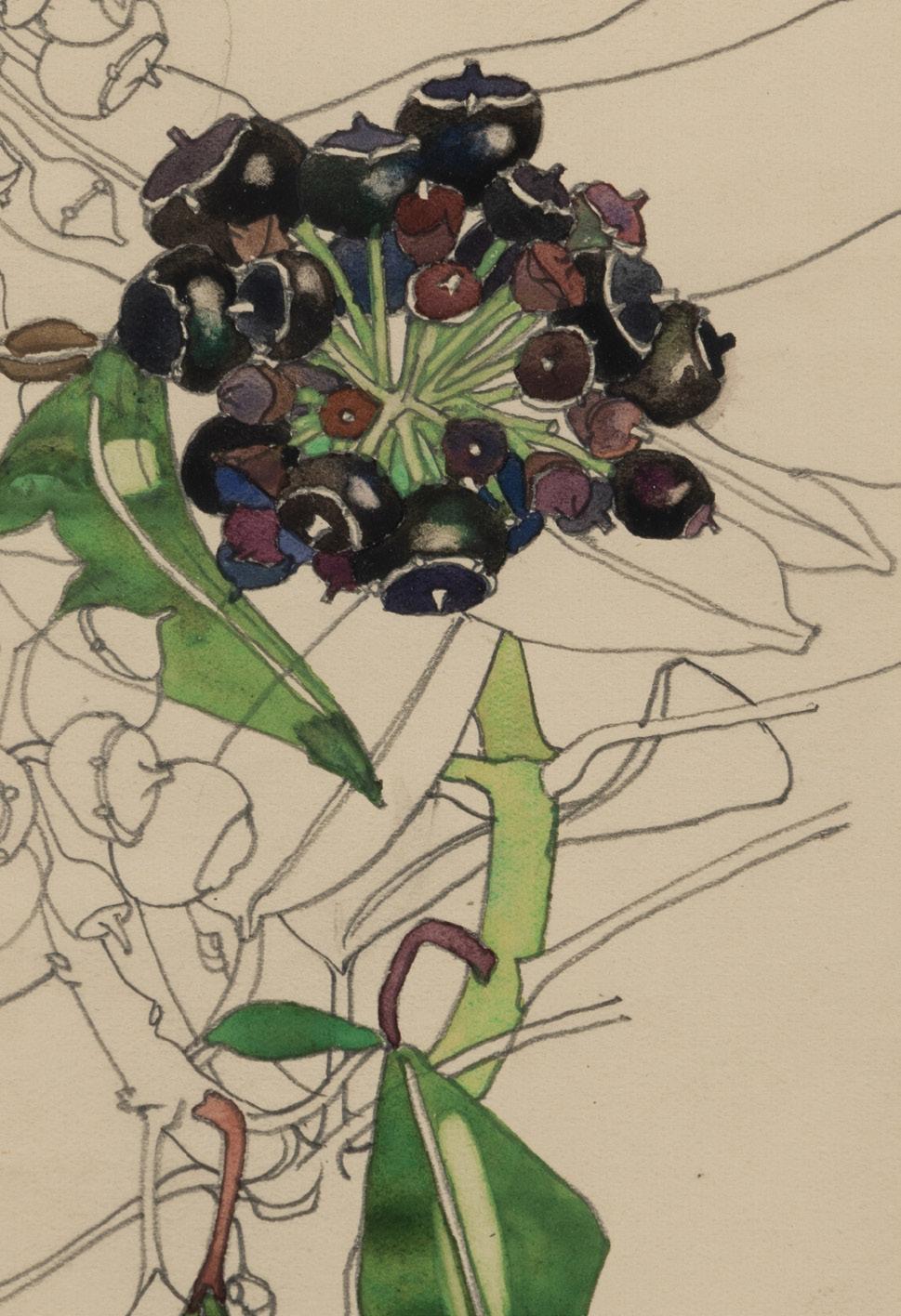
Literature: Billcliffe R. Charles Rennie Mackintosh and the Art of the Four, Quarto 2017, pp. 194 198 and 211 219
Billcliffe R. Mackintosh Watercolours Glasgow Art Gallery, London 1978, p. 38, no. 139 £30,000‑50,000
At Walberswick, the studies are decorative depictions, delicately drawn in a naturalistic manner. It is likely that Mackintosh worked with pressed specimens, perhaps picked on his walks to Sturrock’s studio, giving him an already flattened section to work from. In Ivy Seed, the plant is positioned off‑centre as the coloured leaves pointing towards the cartouche draw the eye into the complex structure of the branch itself. Mackintosh was clearly meticulous in his approach: connected stems and foliage are interwoven and overlaid in a beautiful display; there is a careful balance of tension and delicacy in the delineation of the leaves. The vibrancy of colour, subtly deployed across the page, breathes life into the work and helps capture the decorative beauty of his peaceful new environment.
The initials of Margaret Mackintosh appear frequently on many of these watercolours, and it was previously suggested that she contributed to the studies in some way. However, there is no stylistic evidence that correlates with Margaret’s own watercolour techniques. Mary Newbury Sturrock has stated that her initials merely indicate that she was there when the studies were made, thereby highlighting her constant presence in Charles’ life and art.
Mackintosh’s time spent studying the coastline and nature in and around Walberswick subsequently led to his arrest in 1915 when he was mistaken for a German spy. After a thorough search of their home led to discoveries of their artistic endeavours in Germany and Austria, Charles and Margaret were forced to leave the area with immediate effect. They eventually settled in London, where his deeply personal connections with nature formed the basis for further watercolours and some innovative textile commissions.
The spectacular series of Walberswick studies marks an interesting point in Mackintosh’s career. His intense personal and professional struggles prompted a search for solace in nature: these careful, naturalistic renderings of his surroundings are captivating in their simple beauty, evoking the serenity and contemplation he longed for.
102

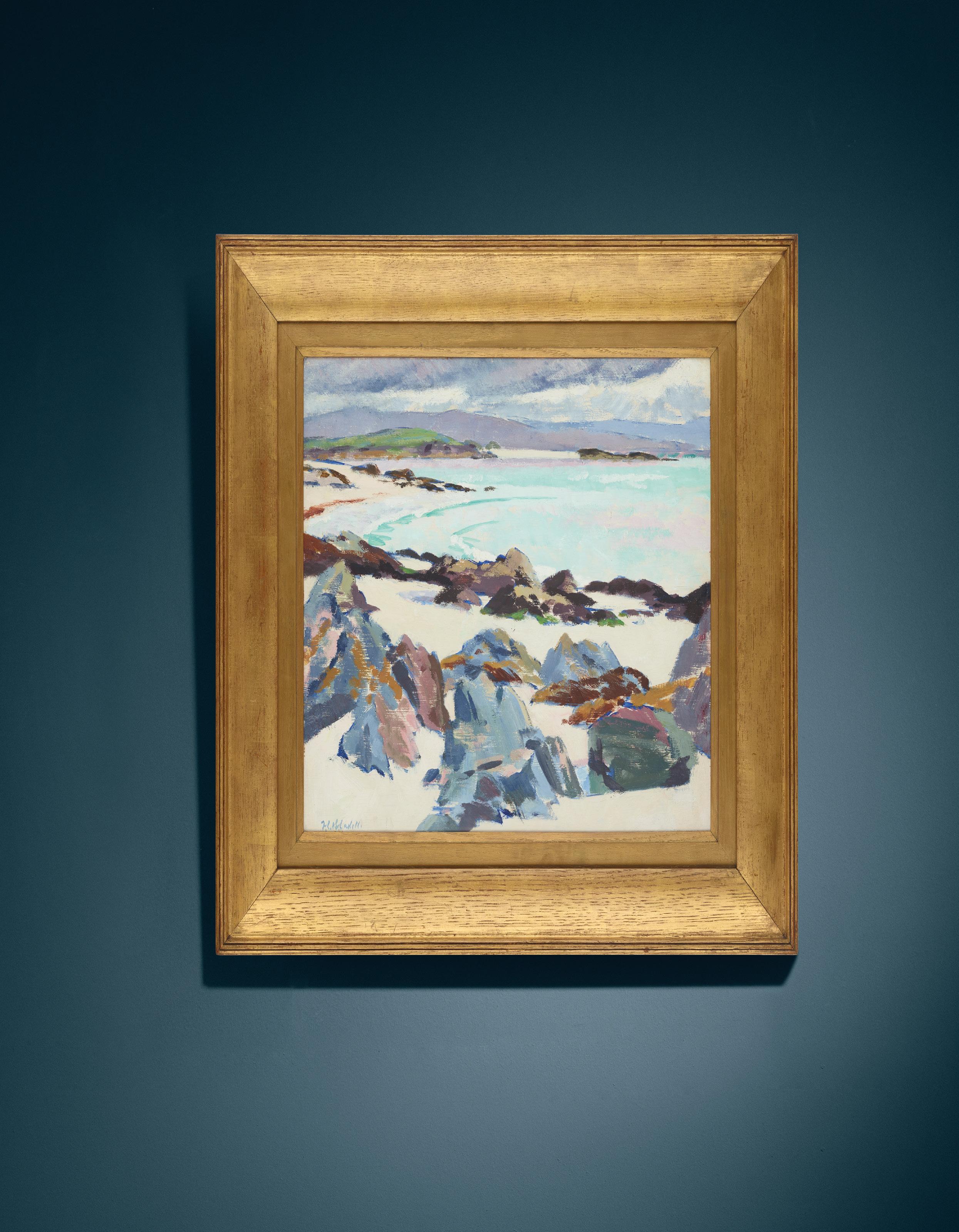
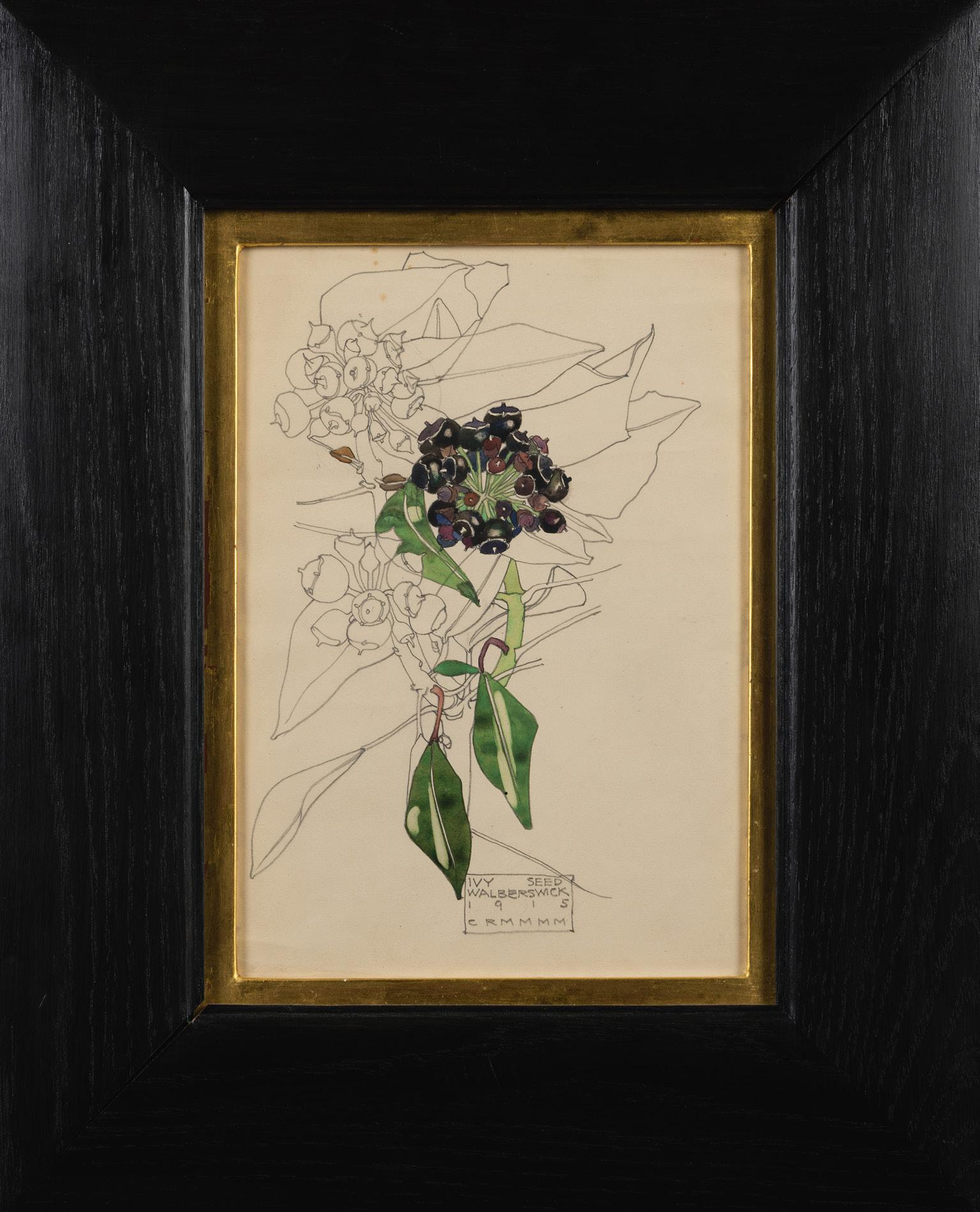
103
251
MARGARET MACDONALD MACKINTOSH (1865‑1933)
BOOKPLATE FOR JOHN EDWARDS, 1896 printed paper

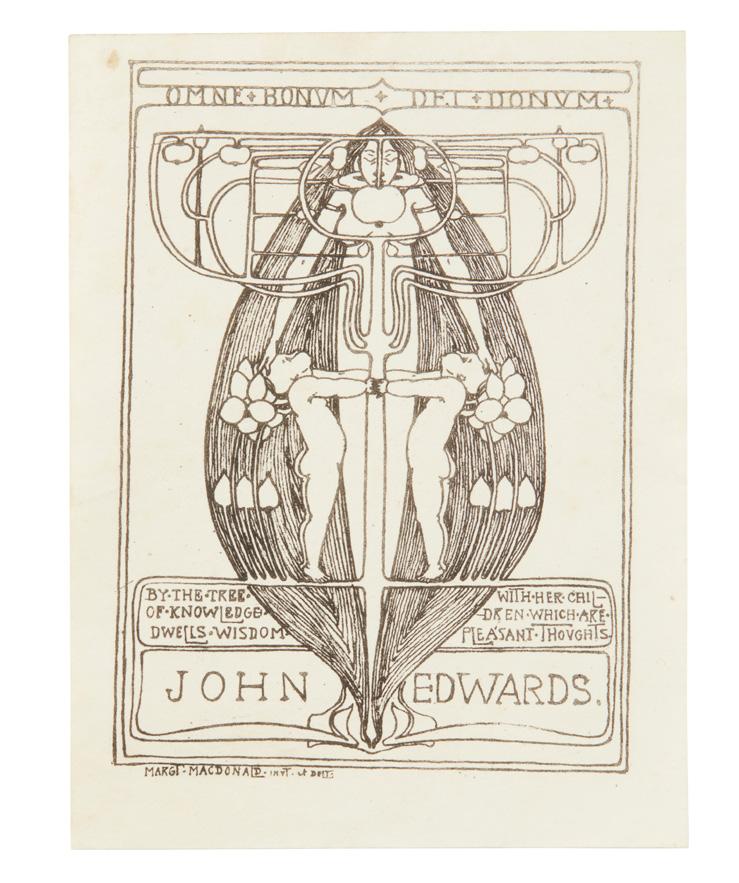
11.5cm x 9cm
Note: This image was also published in the ‘Studio’ magazine in 1897 and the Austrian Secession Movement periodical ‘Ver Sacrum’ in 1901.
£500‑800
252 §
JAMES HERBERT MACNAIR (1868‑1955) & CHARLES J. ALLEN (1862‑1956) FOR THE LIVERPOOL SCHOOL OF TROPICAL MEDICINE MARY KINGSLEY MEDAL, DESIGNED CIRCA 1903

silver, inscribed and engraved around the rim, signed J H MACNAIR/ C J ALLEN, stamped marks for Turner & Simpson, hallmarked Birmingham 1968, with fitted case
9.5cm x 5.6cm
£400‑600
253 §
MARGARET DE COURCY LEWTHWAITE DEWAR (1878‑1959)
COLLECTION OF BOOKPLATES, CIRCA 1900‑1910
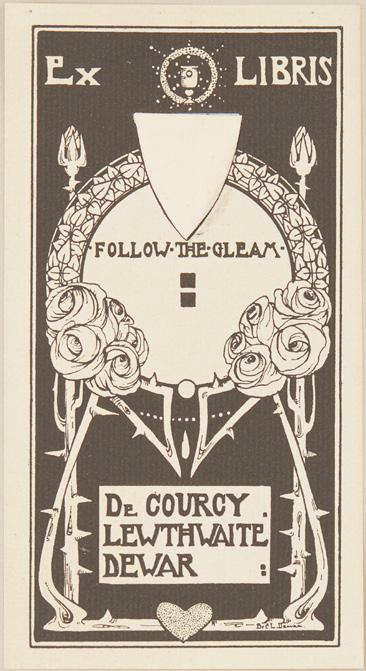
printed paper, comprising 34 bookplates, each tipped into a bound sketchbook, largest 19.5cm x 13cm, smallest 11cm x 7cm, together with 8 further bookplates, various designers including E.D. French; together with The Bookplate, 1924; Bookplate Magazine, 1919; and Weeds, an illustrated calligraphic manuscript, on five sheets of thick card bound in concertina format
Literature: The Studio Yearbook, 1908, p.317 where two of these bookplates are illustrated.

£600‑800
254
THE GLASGOW SCHOOL OF ART TWO COPIES OF THE SCHOOL PROSPECTUS
1907‑08 and 1908‑09 editions, printed by Begg, Currie & Russell Printers, Glasgow (2)

£400‑600
255
CHARLES RENNIE MACKINTOSH AND MARGARET MACDONALD MACKINTOSH INTEREST MEMORIAL EXHIBITION CATALOGUE 1933
McLellan Galleries, Glasgow, 4‑27th May
1933, printed by Begg Kennedy & Elder Printers, Glasgow
£600‑800
104 Other fees apply in addition to the hammer price: see the ‘Buyer’s Guide’ section on page 2

105
256
CHARLES RENNIE MACKINTOSH (1868‑1928)
TEXTILE DESIGN, CIRCA 1920
pencil and watercolour heightened with white, on tracing paper, signed and inscribed
C.R. Mackintosh./2 Hans Studio/43 A Glebe Place
Chelsea SW3 lower right, on the backing sheet, overmounted
17.5cm. x 16cm
Provenance: The Fine Art Society, London, 1989
Exhibited: The Fine Art Society, London, 1994
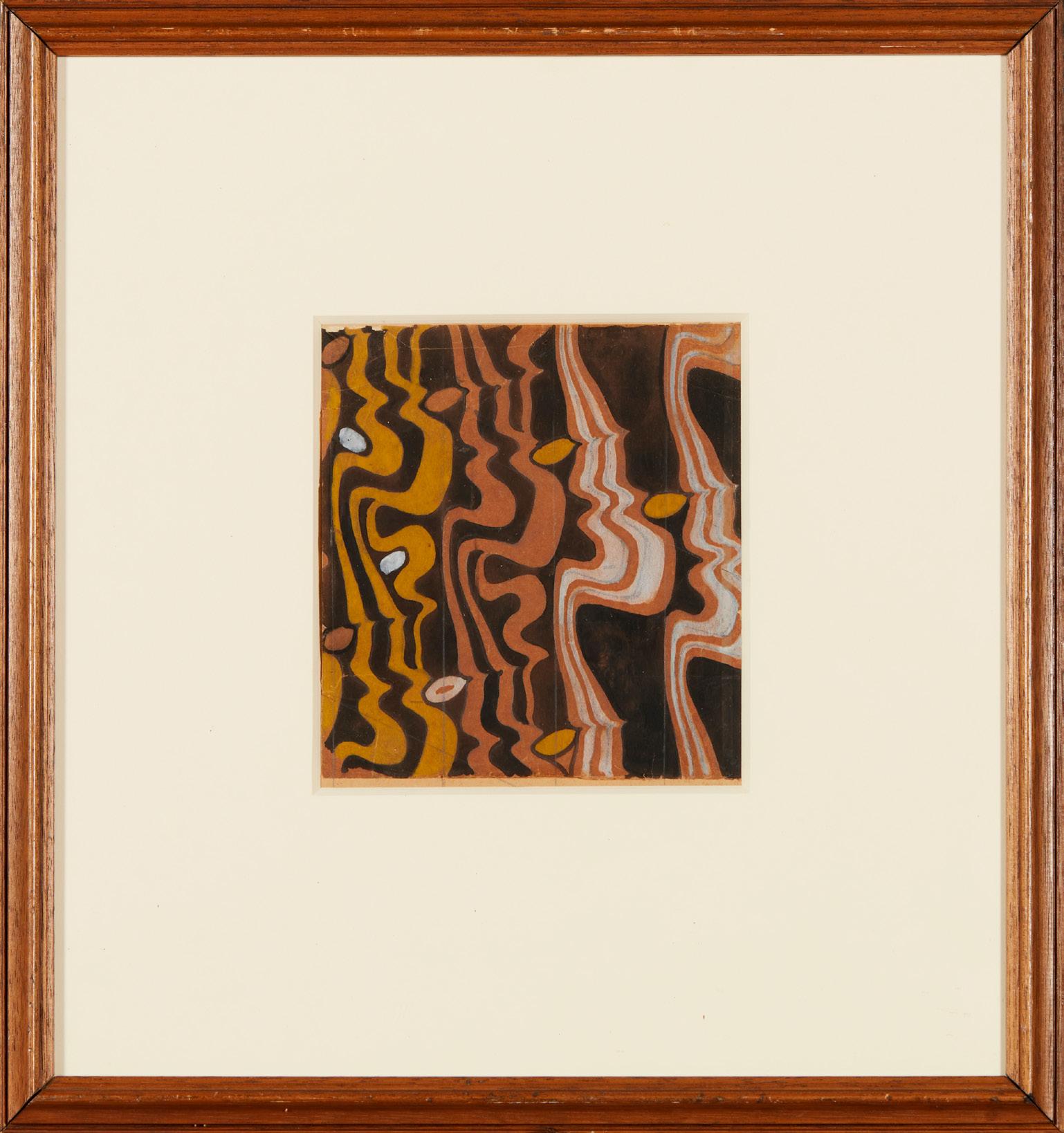

Mackintosh and the Glasgow Style, Travelling Exhibition in Japan, September 2000 ‑ February 2001, p. 137, Cat. No. 140.
Literature: Billcliffe R. Charles Rennie Mackintosh. Textile Designs, San Francisco 1993, p. 84 (‘Ochre, Black and White’) and p. 85 (‘Cyclamen’)
Billcliffe R. Charles Rennie Mackintosh and the Art of the Four, Quarto 2017, pp. 219 225, pl. 260
£10,000‑15,000
Note: In 1916 the Mackintoshes left Walberswick for London where they made their new home in rented lodgings in Chelsea and two adjacent small studios in nearby Glebe Place. The war had ended any idea of Charles setting up an architectural practice either in Glasgow or London, where he lacked the contacts or the money to do so.
The series of wildflower studies that Mackintosh produced at Walberswick suggested a new way forward as an artist. In London, he began a series of cut flower watercolours and textile designs. The first of these flower paintings to be exhibited, Anemones, appeared at the ISSPG (The International Society of Sculptors, Painters and Gravers) in May 1916. A piece of fabric made from one of his designs can be seen in the background, suggesting he had begun working for the textile roller printers, William Foxton Ltd and William Sefton & Co. before this date. His early textile designs developed from his later work in Glasgow and from the Viennese designers he had admired before the war. Later, he drew on his intimate knowledge of the natural world, to produce abstracted repeat patterns, as in the current example. A variation of this design also provides the backdrop for Cyclamen, a watercolour of around 1922‑23.
By 1920 Mackintosh had built an impressive body of work and had become one of the leading textile designers of the period. His diary entry for this year recorded income of £200 from the sale of designs for voiles, chintzes and handkerchiefs. Despite this relative success, fabric designs did not bring him the recognition he needed to attract further work or commissions as his name would not have been associated with the designs at this time.
In 1916 Mackintosh did however receive a commission from the engineering and toy model manufacturer W.J. Bassett‑Lowke for his house at 78 Derngate in Northampton, where he was able to use some of his printed textiles. However, apart from this and a small commission for Miss Cranston in Glasgow no other architectural work was forthcoming and painting remained his alternative career until his death in 1928.
106
MARION HENDERSON WILSON (1869‑1956) (ATTRIBUTED DESIGNER)
GLASGOW SCHOOL WALL MIRROR, CIRCA 1910 repoussé‑decorated brass, bevelled mirror plate 60cm x 32cm
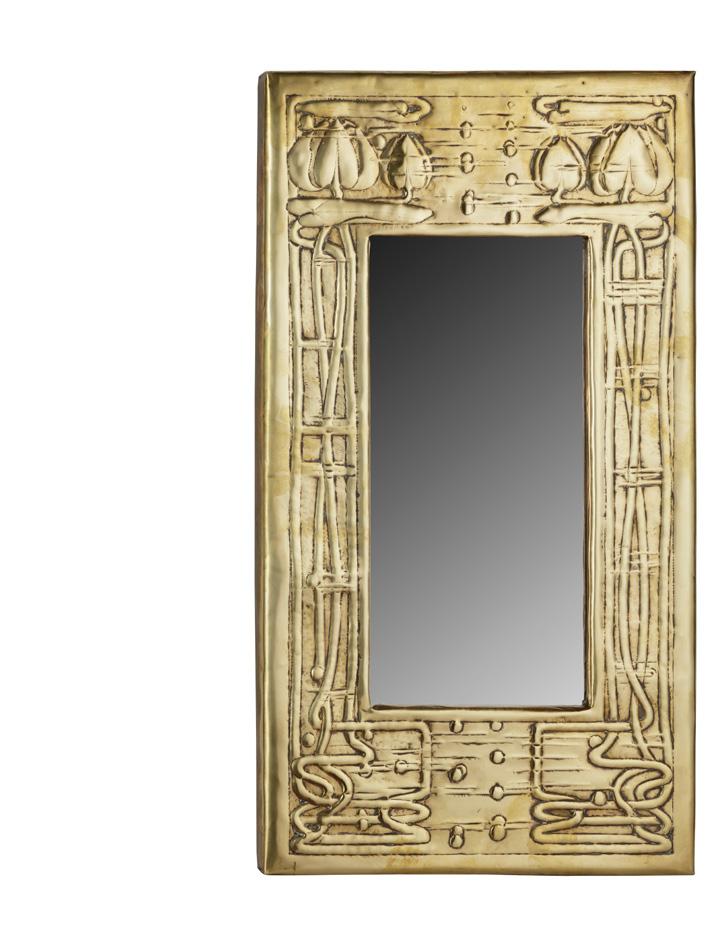
£400‑600
258
GLASGOW SCHOOL
PAIR OF STAINED GLASS WINDOWS, CIRCA 1900 stained and leaded glass within mahogany frames (2) glass 89cm x 35cm £400‑600

259
ERNEST ARCHIBALD TAYLOR (1874‑1951) FOR WYLIE & LOCHHEAD, GLASGOW SIDEBOARD, CIRCA 1902

inlaid oak, with patinated metal fittings
191cm wide, 132cm high, 68cm deep
Note: Initially apprenticed in the Glasgow shipbuilding industry, E. A. Taylor trained as an artist at the Glasgow School of Art, where he met Jessie M. King around 1898. Taylor joined the Glasgow cabinetmakers and retailers Wylie & Lochhead as a trainee designer in 1893. His furniture designs for the firm brought him great acclaim with exhibitions at the 1901 Glasgow International Exhibition and, with his fiancée Jessie King, a series of stained‑glass panels for the Turin International Exhibition of Modern Decorative Art in 1902. Taylor went on to lecture in furniture design at the Glasgow School of Art from 1903 to 1905. In 1908 he married Jessie King and moved to Manchester to manage and design for George Wragge Ltd where he produced many designs for stained glass. Between 1911 and 1914 the Taylors lived in Paris where they established an art school – the Shealing Atelier. This rare sideboard by Taylor demonstrates his skills as a furniture designer, the inlaid panels characteristic of the burgeoning ‘Glasgow Style’, the mouldings and cut‑out features enlivening the solid form. This example is similar in form to a sideboard designed by Taylor for William Douglas Weir (later Lord Weir) in Glasgow around 1901, following the success of his room for Wylie & Lochhead at the Glasgow International Exhibition the same year.
£3,000‑5,000
§
257
107 Other fees apply in addition to the hammer price: see the ‘Buyer’s Guide’ section on page 2
260
HANNAH MOORE WALTON (1863‑1940)
TWO FINGER BOWLS, CIRCA 1910
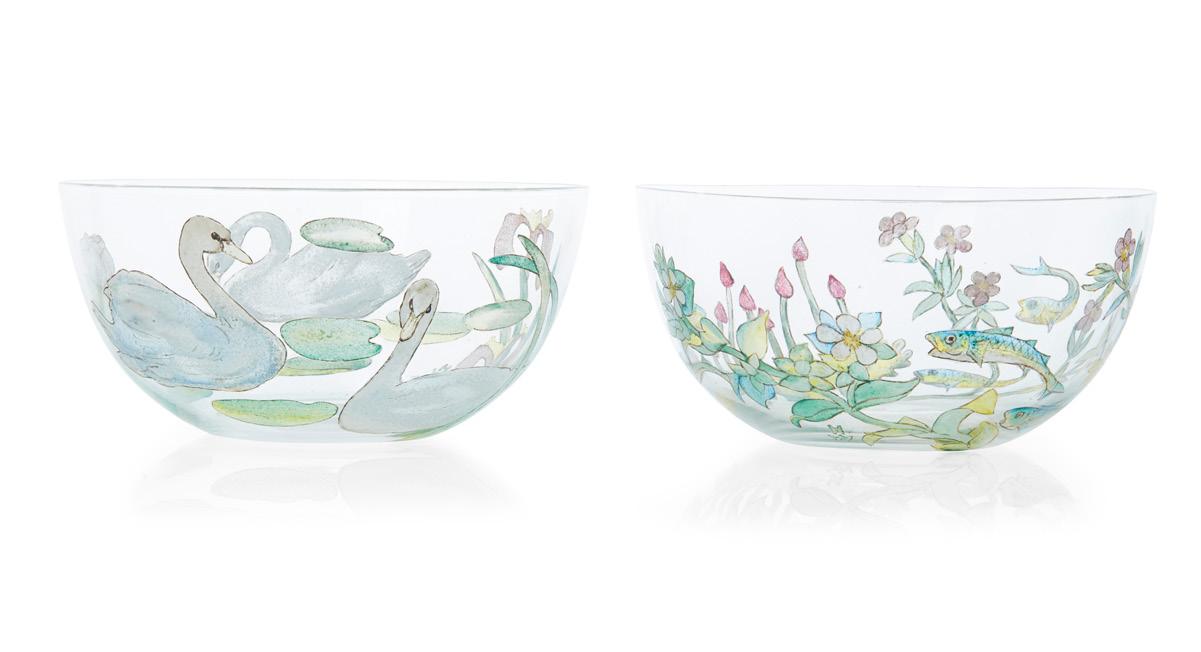
painted glass, signed with initials HW (2) 12.5cm diameter
Literature: Burkhauser J. ed. Glasgow Girls: Women in Art and Design 1880‑1920, Edinburgh 1990, p. 166
Note: Hannah Walton worked from the family home at 5 Belmont Terrace in Hillhead, Glasgow, where her sister Helen had established her studio in 1881. The sisters specialised in this type of painting on commercial glassware, and chose decorative subjects associated with water.
£300‑500
261 GLASGOW SCHOOL
EMBROIDERED TEA COSY, CIRCA 1910

coloured silks and gold threads, the design worked on both sides reserved on a cushioned silk satin ground
36cm wide, 26cm high
£300‑500
262
AGNES BANKIER HARVEY (1873‑1947) (ATTRIBUTED DESIGNER)
PAIR OF GLASGOW SCHOOL WALL SCONCES, CIRCA 1900

repoussé‑decorated brass (2)
16cm wide, 38cm high, 9cm deep
£400‑600
263
JAMES HERBERT MCNAIR (1868‑1955) (ATTRIBUTED DESIGNER)
‘OWL’ THREE‑FOLD SCREEN, CIRCA 1900
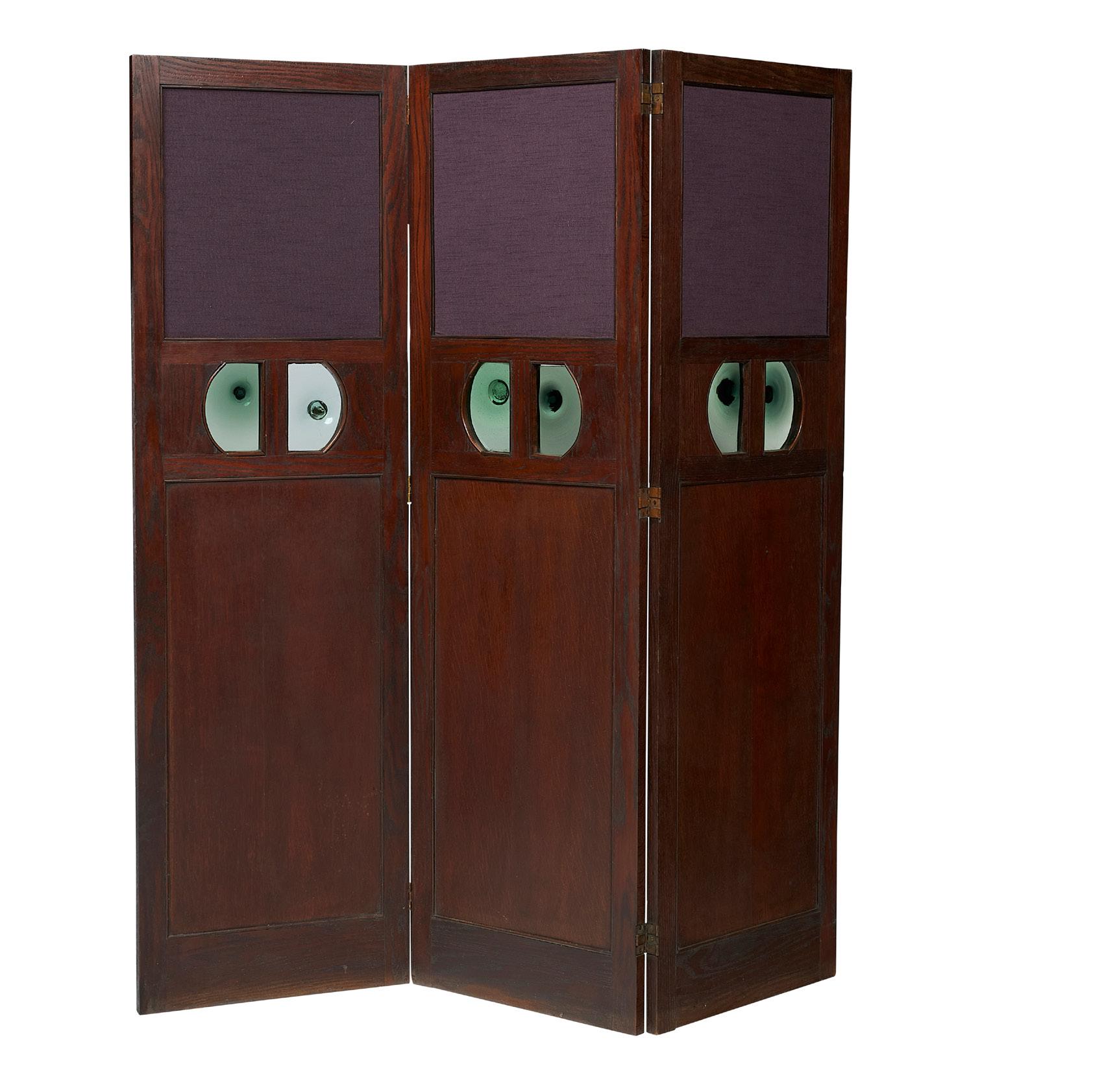
oak, linen, green glass, with brass hinges
Each fold 167cm x 50.5cm
£800‑1,200
108 Other fees apply in addition to the hammer price: see the ‘Buyer’s Guide’ section on page 2
264
SCOTTISH ARTS & CRAFTS MIRROR, CIRCA 1910 repousse‑decorated brass
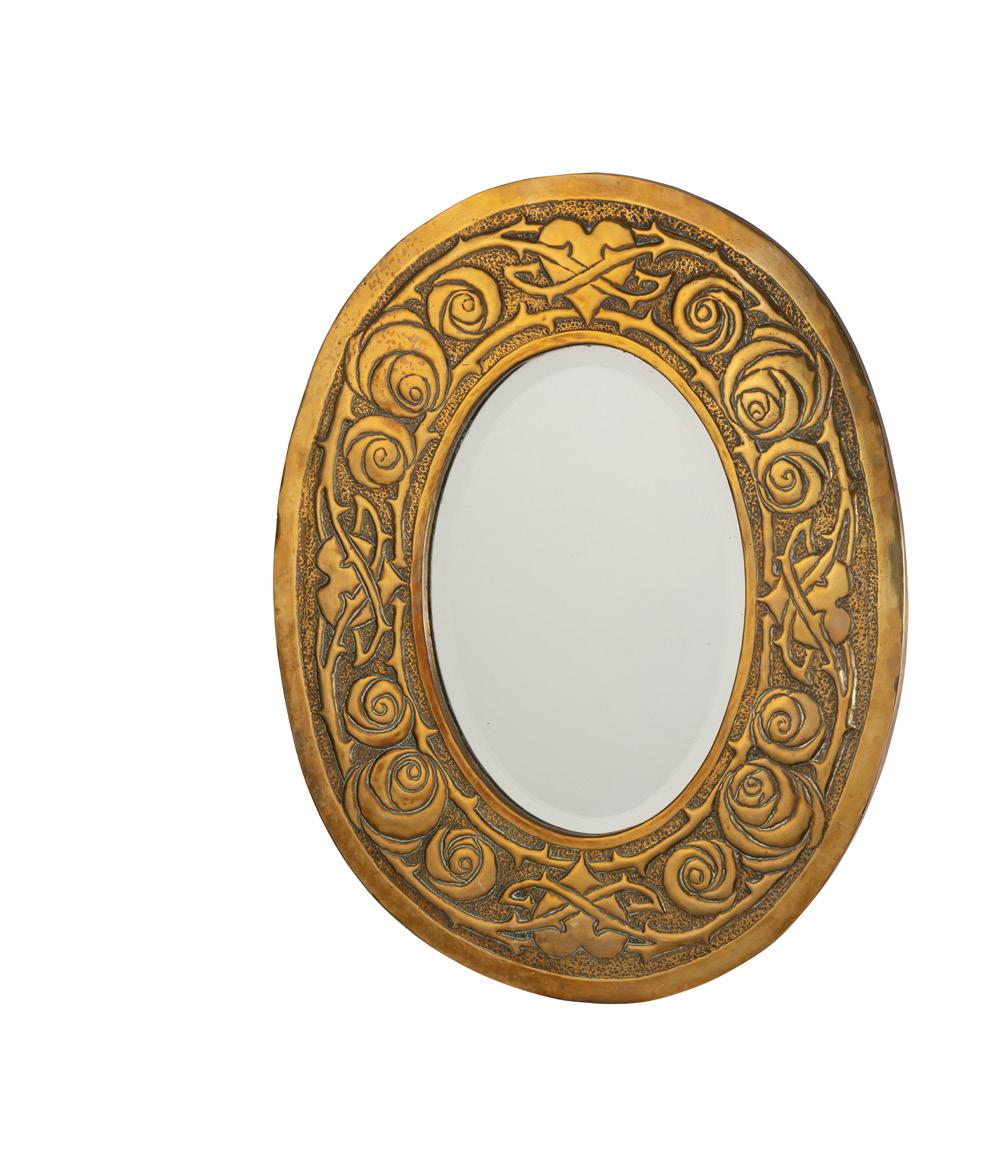
67.5cm x 53.5cm
£300‑500
265
THE GLASGOW SCHOOL OF PAINTING DESIGN FOR A BOOK COVER

gold paint on a painted green ground
48.5cm x 28.5cm
Provenance: The Fine Art Society, London
£200‑300
266
GEORGE HENRY WALTON (1867‑1933) (ATTRIBUTED DESIGNER) SIDE TABLE, CIRCA 1900

walnut
56cm wide, 72.5cm high, 44.5cm deep
£300‑500
267
ERNEST ARCHIBALD TAYLOR (1874‑1951) (ATTRIBUTED DESIGNER) FOR WYLIE & LOCHHEAD, GLASGOW
CHEST OF DRAWERS CIRCA 1900

stained beech, with brass panels, stamped 115628 to reverse, 106cm wide, 90.5cm high, 45.3cm deep; together with an ASSOCIATED CHAIR, mahogany, with drop‑in upholstered seat, 44cm wide, 101cm high, 46cm deep (2)
£400‑600
109
268
JESSIE MARION KING (1875‑1949)
KITE FLYING
pen and watercolour on paper, signed lower right JESSIE M. KING


34cm x 42.5cm
Provenance: The Fine Art Society London, 1972 £3,000‑5,000
269
JESSIE MARION KING (1875‑1949)
ARTIST’S COTTAGE, ARRAN watercolour, signed lower left JESSIE M. KING
23.5cm x 15cm
£800‑1,200
270
CELTIC REVIVAL COAL BOX, CIRCA 1910
repoussé‑decorated brass
50cm wide, 30.5cm high, 35cm deep £250‑350
271
MARGARET GILMOUR (1860‑1942) (ATTRIBUTED TO)
GLASGOW SCHOOL BLOTTER, CIRCA 1910
repoussé‑decorated brass, card
29.5cm x 45.5cm
£300‑500
110 Other fees apply in addition to the hammer price: see the ‘Buyer’s Guide’ section on page 2
272
JESSIE MARION KING (1875‑1949)
PATH THROUGH WOODLAND COTTAGES
pencil and watercolour on buff paper
36.5cm x 26cm
Provenance: Sotheby’s, Jessie M. King and E.A. Taylor, Charles Rennie Mackintosh Society, Queen’s Cross Church, Glasgow, 21st June 1977
£1,000‑1,500
273 §
ANNIE FRENCH (1872‑1965)
LADY WALKING IN A GARDEN pen and ink on paper, framed 10cm x 12cm
Provenance: Sir James French
Ewan Mundy Fine Art, Glasgow £300‑500
274
JESSIE MARION KING (1875‑1949)
‘YOUR DEAR HEAD BOW’D TO THE GILLIFLOWER BED’
pen and ink and graphite on vellum, framed
26.5cm x 13.5cm
£500‑800
275 §
ANNIE FRENCH (1872‑1965)


TWO POSTCARDS, CIRCA 1900
printed by Alexander Baird & Co., series no. 1021 and 1024, framed each 11.5cm x 7cm
Provenance: Ewan Mundy Fine Art, Glasgow £400‑600

111
277
ERNEST ARCHIBALD TAYLOR (1874‑1951)
COASTAL SCENE

oil on board, unsigned
29cm x 27.5cm
£600‑800
276 § KATHARINE CAMERON (1874‑1965)
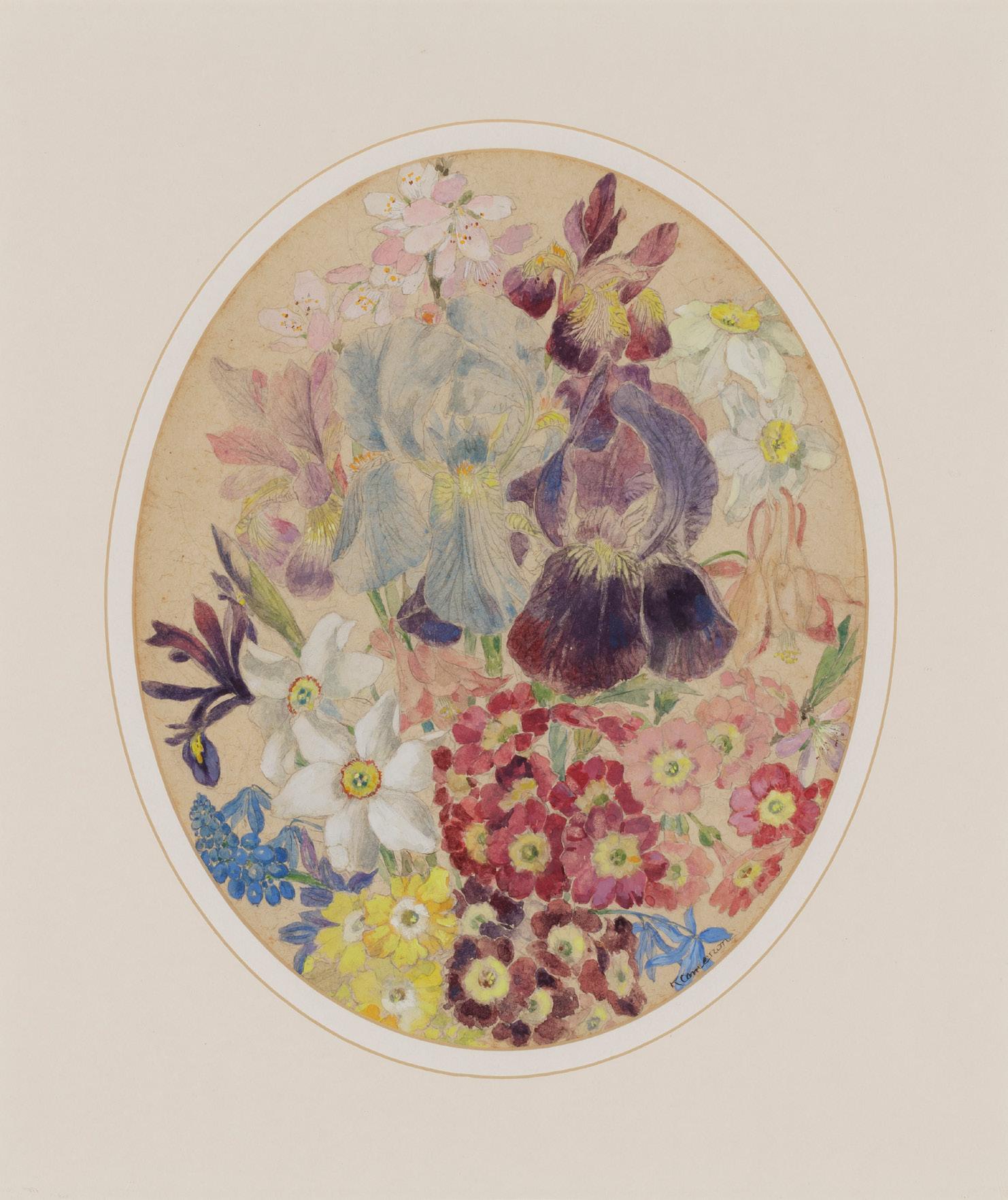
DAISIES AND DELPHINIUMS
pencil and watercolour, signed upper right K. CAMERON
54cm x 36.5cm
£1,000‑1,500
112
278 §
ELIZABETH MARY WATT (1885‑1954)
BEAUTY PARADE
ink, watercolour and bodycolour on wood, signed lower left
ELIZABETH MARY WATT
41.4cm x 24.5cm
£700‑1,000
279 §
ELIZABETH MARY WATT (1885‑1954)
ADMIRING GLANCES
ink and watercolour, with bodycolour, signed lower right
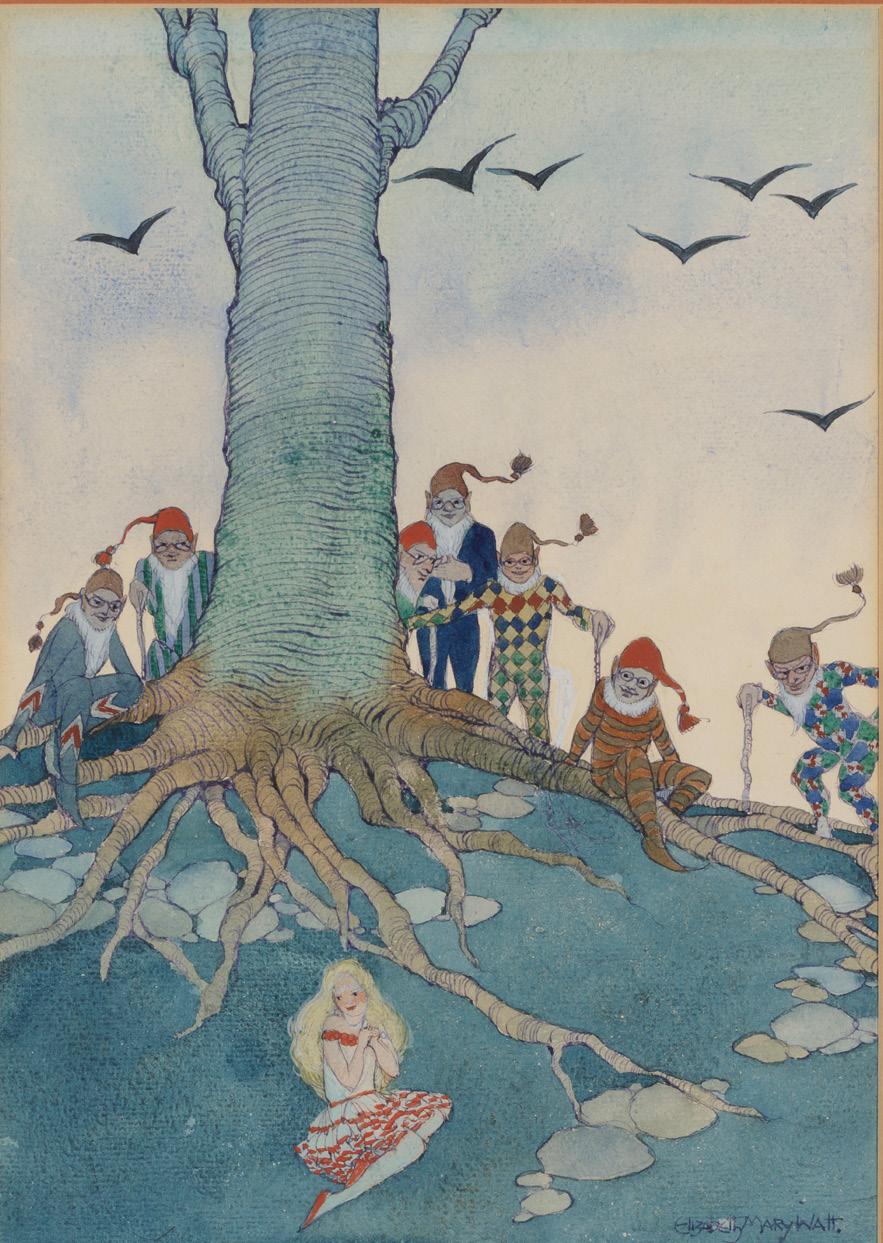
ELIZABETH MARY WATT
34cm x 24cm
£600‑800
280
SCOTTISH
GLASGOW SCHOOL LOG BOX, CIRCA 1900
repoussé‑decorated copper with glazed ceramic panel

42.5cm wide, 27.5cm high, 30cm deep
£300‑500
281
GLASGOW SCHOOL
CELTIC REVIVAL WALL MIRROR, CIRCA 1900
repoussé‑decorated brass, with mirror plate
35cm x 70cm
£300‑500
282
SCOTTISH
GLASGOW SCHOOL MIRROR, CIRCA 1910 repousse‑decorated brass, with mirror plate
46.5cm x 66cm
£300‑500
113 Other fees apply in addition to the hammer price: see the ‘Buyer’s Guide’ section on page 2
283 §
MARGARET ISOBEL WRIGHT (1884‑1957)
LES PETITES DANSEUSES
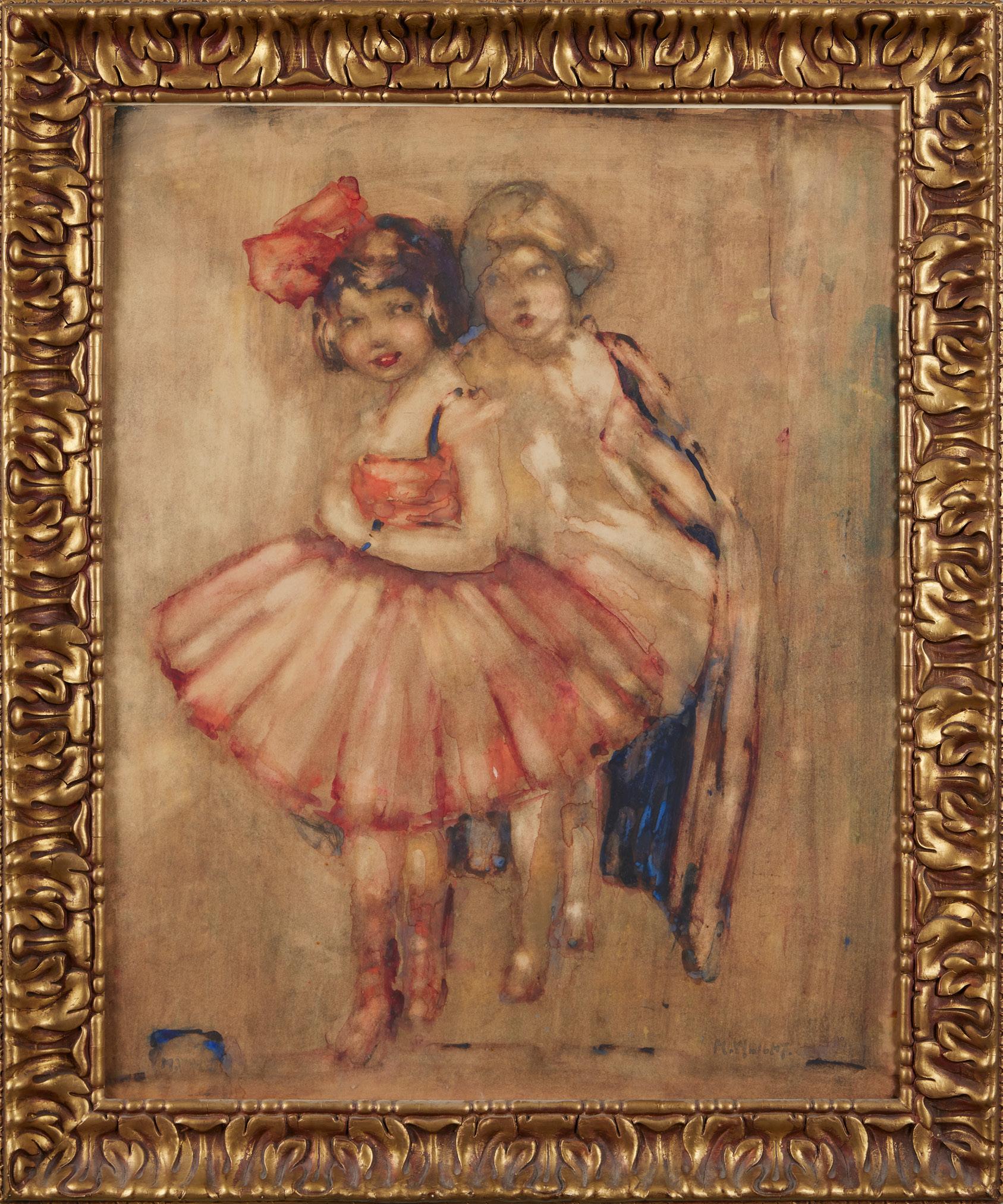
watercolour on paper, signed lower right M. WRIGHT, signed, dated and titled on artist’s label verso, 63.5cm x 49.5cm
Provenance: Whittington Fine Art, Old Amersham
Note: Margaret Wright was influenced by the ‘Glasgow Boys’. Born in Ayr in 1884 she studied at the Glasgow School of Art from 1902‑1908. She enlisted at the Glasgow Institute, the Royal Scottish Academy and the Paisley Institute. £2,000‑3,000
114 Other fees apply in addition to the hammer price: see the ‘Buyer’s Guide’ section on page 2
284 §
MAJEL DAVIDSON (1885‑1969)

LE BAOU DE SAINT JEANNET
oil on canvas
64cm x 56cm
£600‑800
286 §
KATHARINE CAMERON (1874‑1965)
DAISIES & BEES, 1897

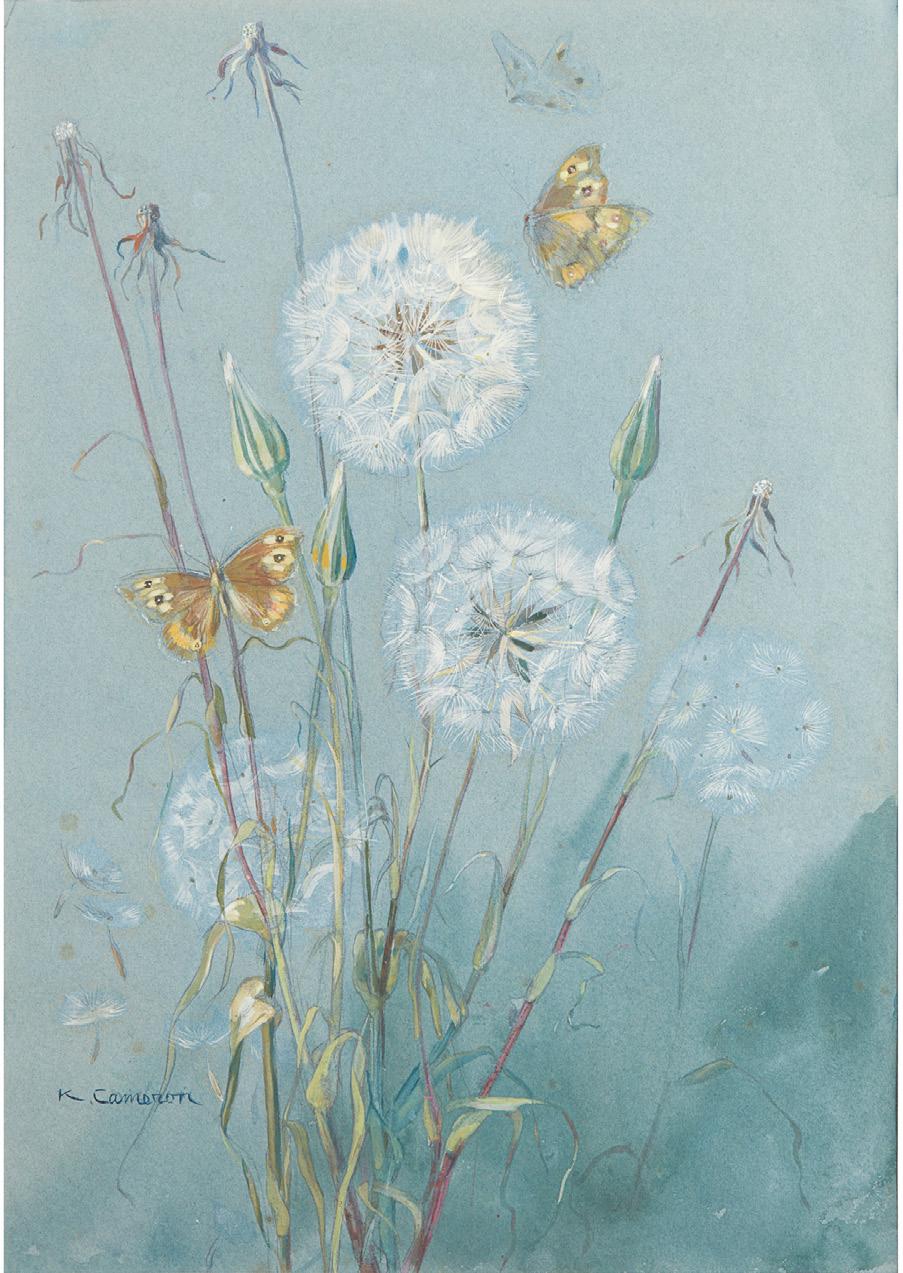
watercolour, signed and dated lower centre right 23cm x 35cm
Provenance: Bourne Fine Art, Edinburgh
£500‑700
285 §
KATHARINE CAMERON (1874‑1965)
DANDELIONS & BUTTERFLIES
watercolour on blue paper, signed lower left 37cm x 26cm
Provenance: Ewan Mundy Fine Art, Glasgow
£600‑800
115
287
ORIVIT, COLOGNE
JUGENDSTIL STRUT MIRROR. CIRCA 1900
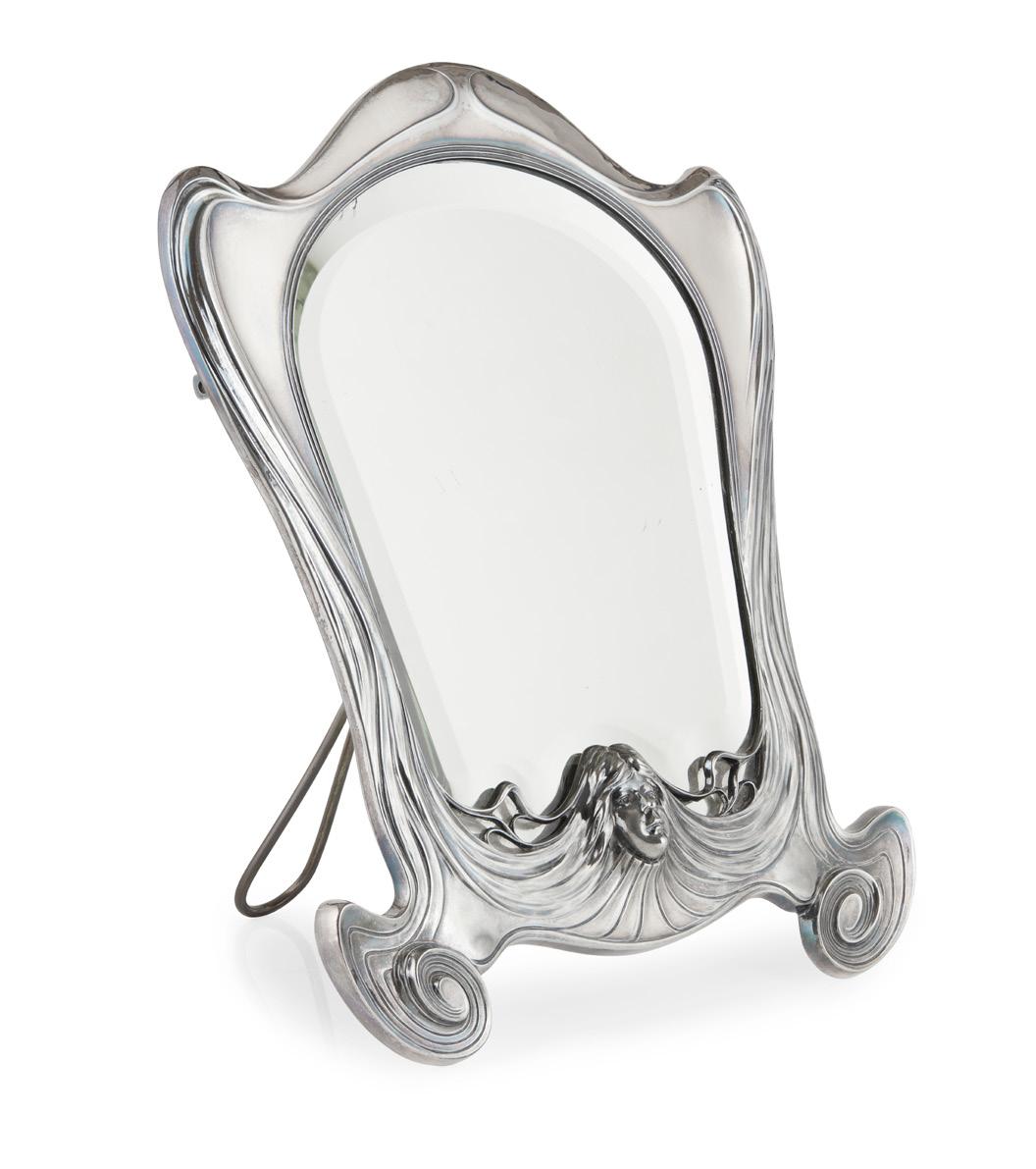
plated metal and mirrored glass, stamped 2280/ E.P. 38cm x 31cm
£300‑500
288
ORIVIT, COLOGNE
PAIR OF JUGENDSTIL CANDELABRA, CIRCA 1900
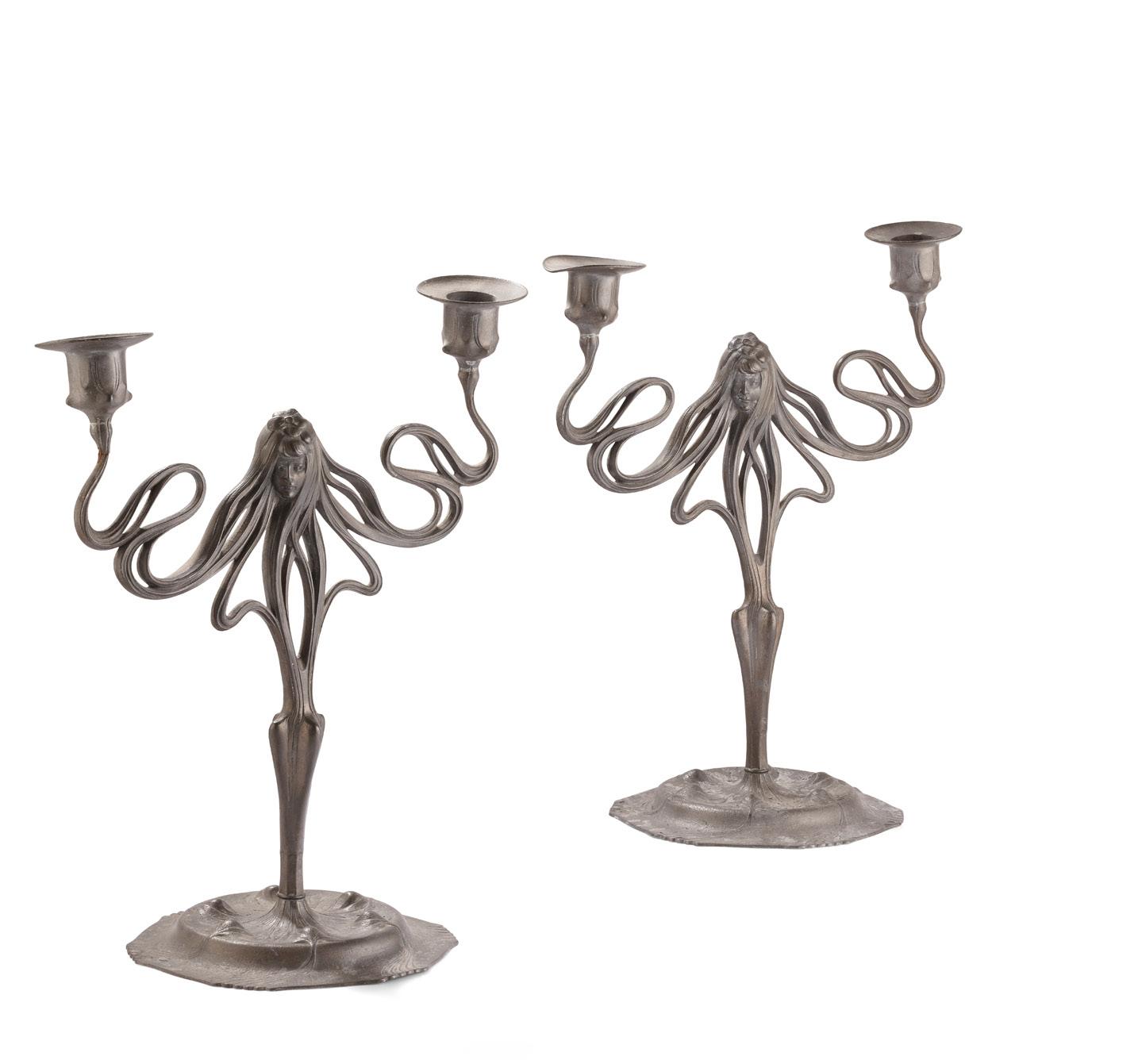
pewter, stamped ORIVIT 2210
31cm high
£400‑600
289
ORIVIT, COLOGNE
TWO JUGENDSTIL WINE DECANTERS, CIRCA 1900

cast pewter and glass, unmarked (2)
29.5cm high
£300‑500
116
290
WMF (WURTTEMBERGISCHE METALLWARENFABRIK)
JUGENDSTIL STRUT MIRROR, CIRCA 1900

silver plated metal, reserved on a beech ground and enclosing mirror plate, unmarked
57cm x 43cm
£400‑600
291
CONTINENTAL SECESSIONIST CIGARETTE CASE, CIRCA 1910 white metal, set with step‑cut rubies, stamped maker’s marks, 800/ 287, inside engraved LEONARD ROOME

9cm x 7.5cm £300‑500
292
MICHAEL POWOLNY (1871‑1954) FOR LOETZ FOOTED BOWL, CIRCA 1920
cased orange glass with applied trailing decoration

12.5cm diameter
£200‑300
293
JOSEF HOFFMANN (1870‑1956) FOR J. & J. KOHN, VIENNA OCCASIONAL TABLE, CIRCA 1910 stained beech, stamped J&J KOHN/ WIEN/ AUSTRIA
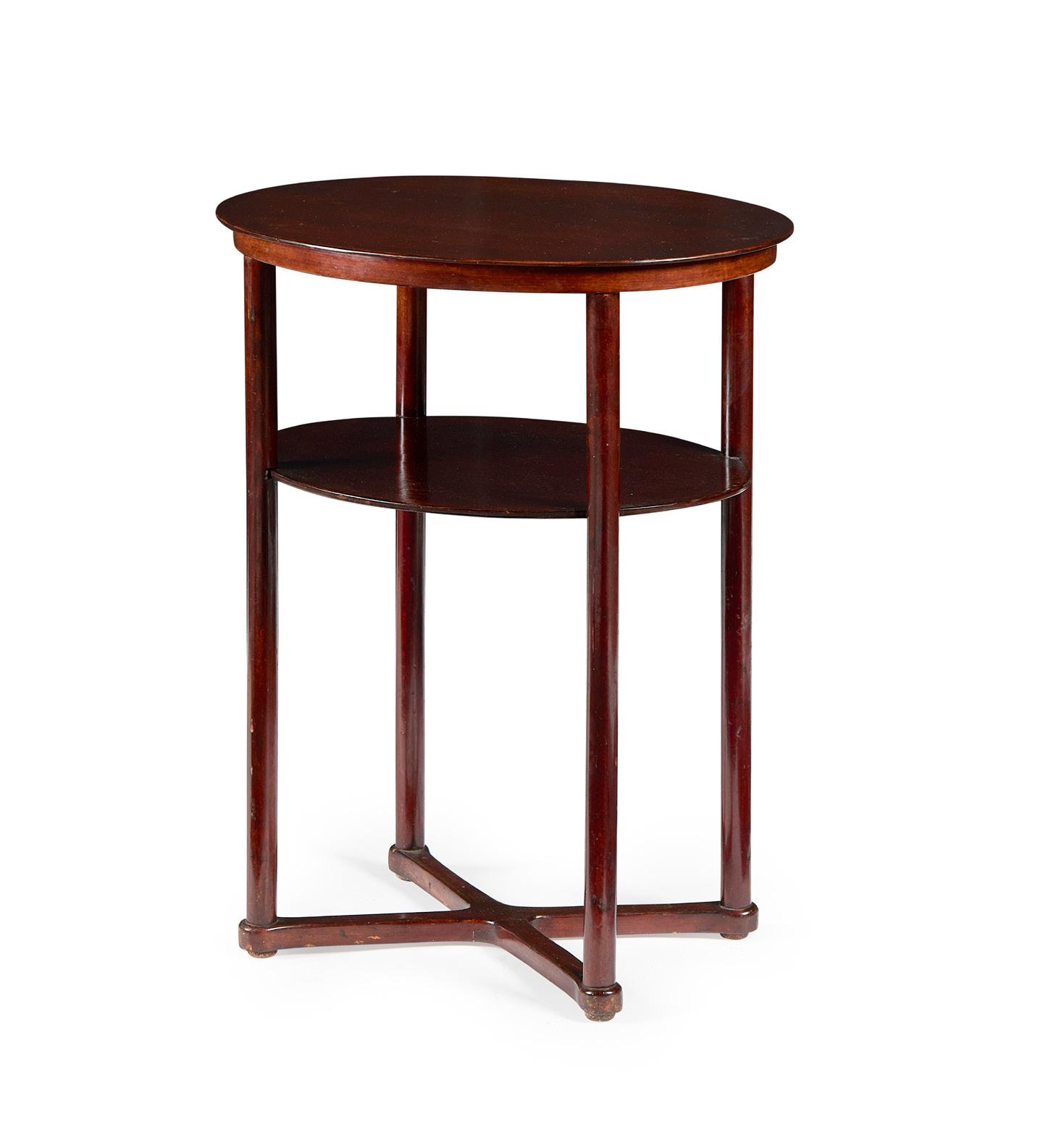
58cm across, 74cm high, 45cm deep £600‑800
294
CONTINENTAL BEDSIDE CABINET, CIRCA 1900 carved oak, with marble top 39cm wide, 80.5cm high, 45cm deep £250‑350
117 Other fees apply in addition to the hammer price: see the ‘Buyer’s Guide’ section on page 2
295
KARL MASSENETZ FOR J. & L. LOBMEYR, VIENNA PAIR OF WINE GLASSES, CIRCA 1914 with enamelled and gilt decoration (2)
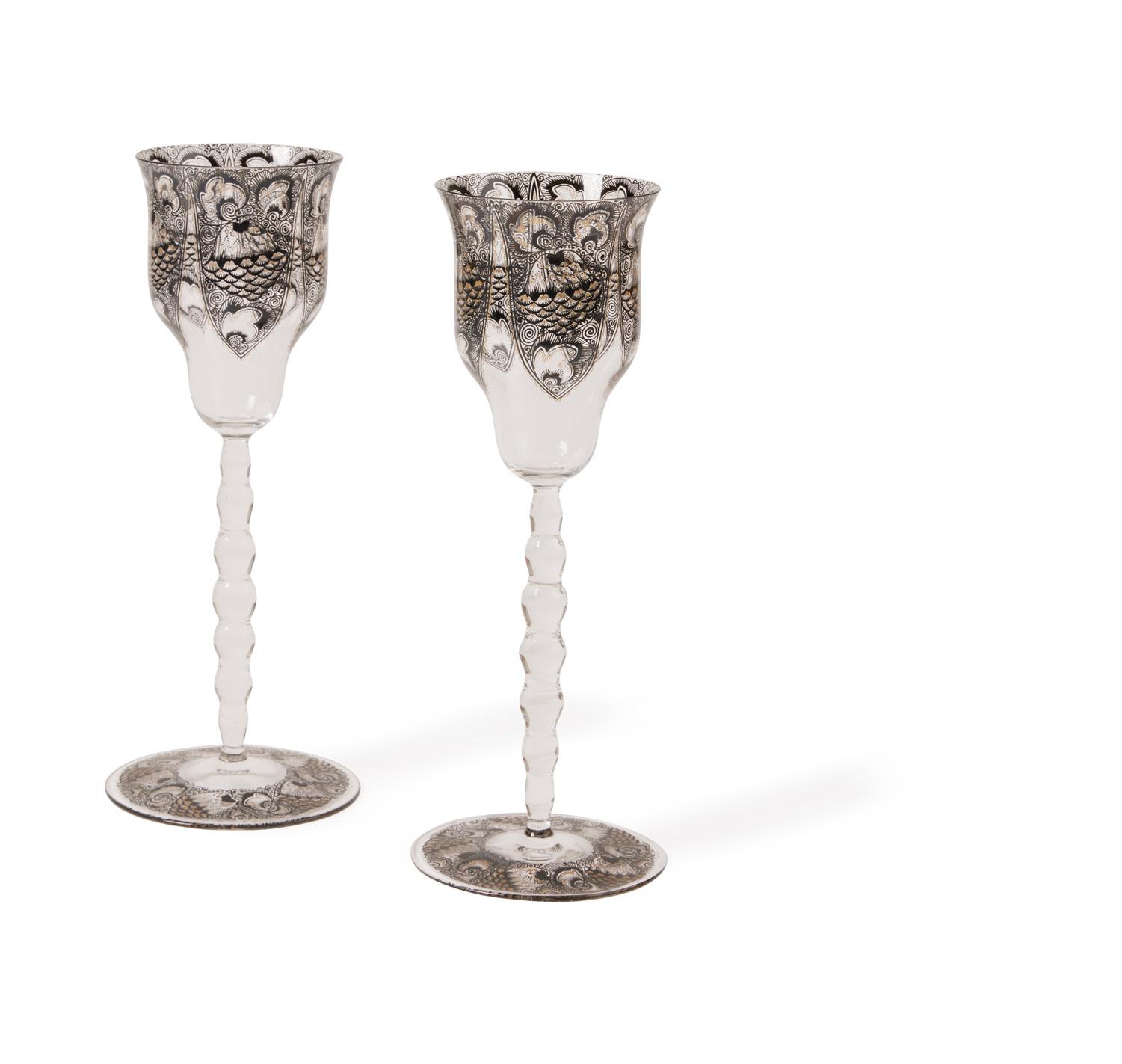
23.7cm high
£1,500‑2,000
296
RENI SCHASCHL (1895‑1979) FOR WIENER WERKSTÄTTE
FIGURE OF A WOMAN, CIRCA 1925 glazed earthenware, impressed maker’s mark WW, MADE IN AUSTRIA, 870 and painted cypher to the base

46.5cm high
£1,500‑2,000
297
WIENER WERKSTÄTTE
FOOTED BOWL & COVER, CIRCA 1920 green and yellow painted glass, decorated with country scenes, painted maker’s mark WW, applied paper label 14cm high, 13cm diameter
£500‑800

118 Other fees apply in addition to the hammer price: see the ‘Buyer’s Guide’ section on page 2
298
KOLOMAN MOSER (1868‑1918) FOR WIENER WERKSTÄTTE BROOCH, CIRCA 1900
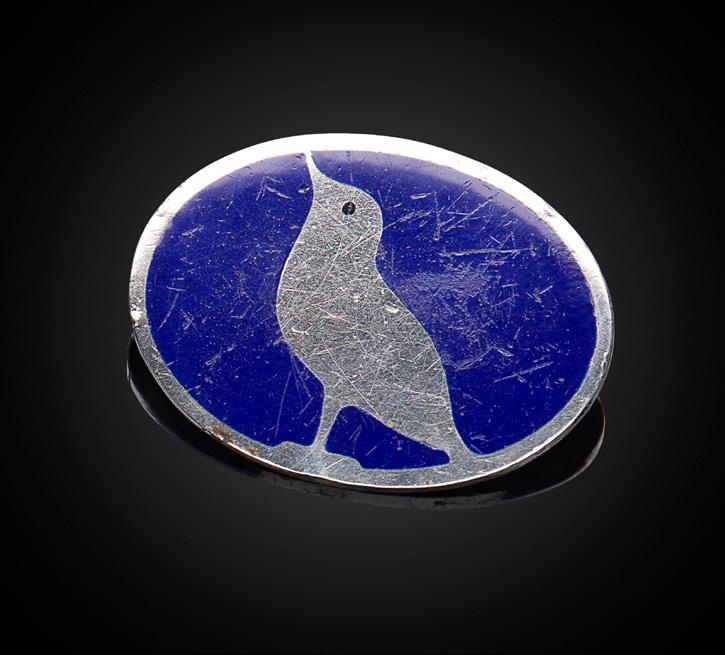
silver and enamel, stamped hallmarks
3.2cm across
£400‑600
299
HEINRICH LEVINGER, PFORZHEIM
JUGENDSTIL BROOCH, CIRCA 1900
white metal with plique‑a‑jour enamel and pearls, stamped HL/900/DEPOSE
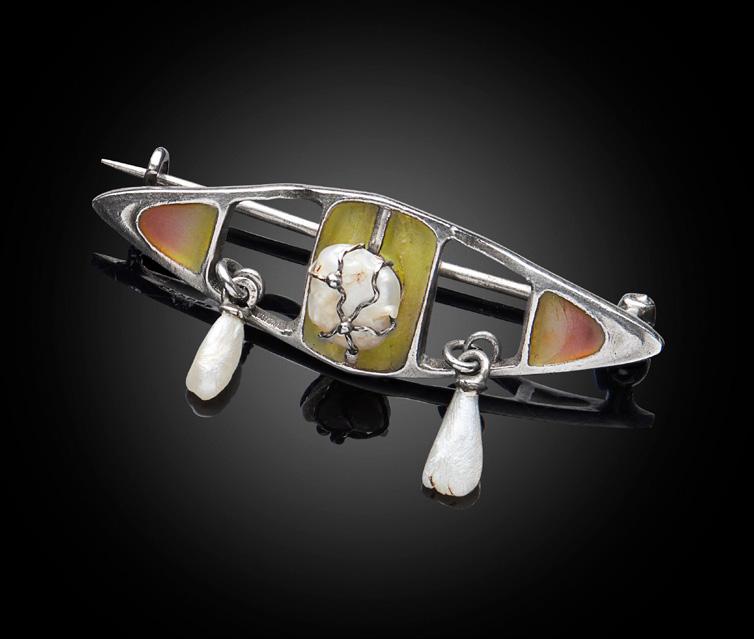
4cm long
£250‑350
300
GERMAN
JUGENDSTIL TWIN PEDESTAL DESK, CIRCA 1890

oak, with wrought steel fittings, later tooled leather skiver
140cm wide, 75.5cm high, 85cm deep
£800‑1,200
119
ALEXANDRE CHARPENTIER (1856–1909) AND
TONY SELMERSHEIM (1871‑1971)
‘LA FUITE DE L’HEURE’: FINE ART NOUVEAU
TABLE CLOCK, 1898
padouk and gilt bronze, the twin train movement striking the hour and half hour, the surmount signed in the bronze ALEXANDRE CHARPENTIER, the panels to the sides and front signed with monogram
87cm high, the surmount 32.5cm high
Literature: Alexandre Charpentier (1856‑1909): Naturalisme et Art Nouveau, Exhibition catalogue, Musée d’Orsay, pp. 115‑116 illus.
Art et Décoration, 1899, pp. 101‑102 (illustrated).
Paris, Le Musée d’Orsay, 22nd January ‑ 13th April 2008, Brussels, Le Musée d’Ixelles 29th May ‑ 31st August 2008 Alexandre Charpentier (1856‑1909): Naturalisme et Art Nouveau, no. 79
“It is necessary to make art part of contemporary life. To make the ordinary objects that surround us into works of art”. Paul Greenhalgh (ed.), Art Nouveau 1890‑1914, V & A Publications, London, 2002, p. 20.
Alexandre Charpentier and Tony Selmersheim belonged to Les Cinq (which later changed its name to Les Six Les Huit as new members joined) who advertised their ambitions, in an 1898 Paris exhibition, as to integrate art into present‑day life and to make everyday items beautiful and meaningful. They, like Emile Gallé, believed in the transformative and redemptive power of the arts to change not just an individual but society more broadly, and even the national economy. Charpentier created the sculptural components of this clock. Originally conceived as a larger figural group it is here employed at half the size. Besides the change in scale, the other difference between the two figural groups is the inclusion of a scythe in this present piece.
Charpentier had begun his career working for a medal maker and this clock incorporates three panels representing the Fates. He was very much at the forefront of the revival of interest in medal‑making and low‑relief plaques of the period. This art form very much suited the Art Nouveau ethos and the fascination for whip‑lash lines.
While Charpentier created the sculptural elements, it was the architect and decorator Tony Selmersheim who designed the case of the clock. Regarded as one of the leading Art Nouveau furniture makers, he worked alongside Victor Horta, Maurice Dufrêne and Henry van de Velde on La Maison Moderne, before forming a highly successful partnership with Charles Plumet. As is the case here, his work was characterised by simple forms that emphasised the structure of the piece, and by flowing elongated stem‑like lines that reference nature.
Like so many Art Nouveau works, this clock explores recurring Symbolist themes. The sculptural group surmounting the clock can be seen to represent Time, Age and Love. A young man kisses his lover whilst holding her aloft. Concurrently the man grasps the scythe being wielded by the old man, trying to keep him and it at bay. He represents not only old age but with the scythe offers a reminder of human mortality. Life is a cycle, and the bas‑relief panels below depict the Fates from Greco‑Roman mythology. In the front panel, Clotho holds a distaff, the left panel depicts Lachesis operating the spindle and on the right Altropos cuts the thread. This imagery is in keeping with the representation of time in the figural group surmount with a beginning and an end determined by another force. Instead of using classical models, Charpentier chose contemporary figures, and in so doing draws a clear link between art and modern life. Art is relevant and should speak to the present. This functional clock has been transformed and elevated by Charpentier and Selmersheim into a meaningful work of art.
£30,000‑40,000
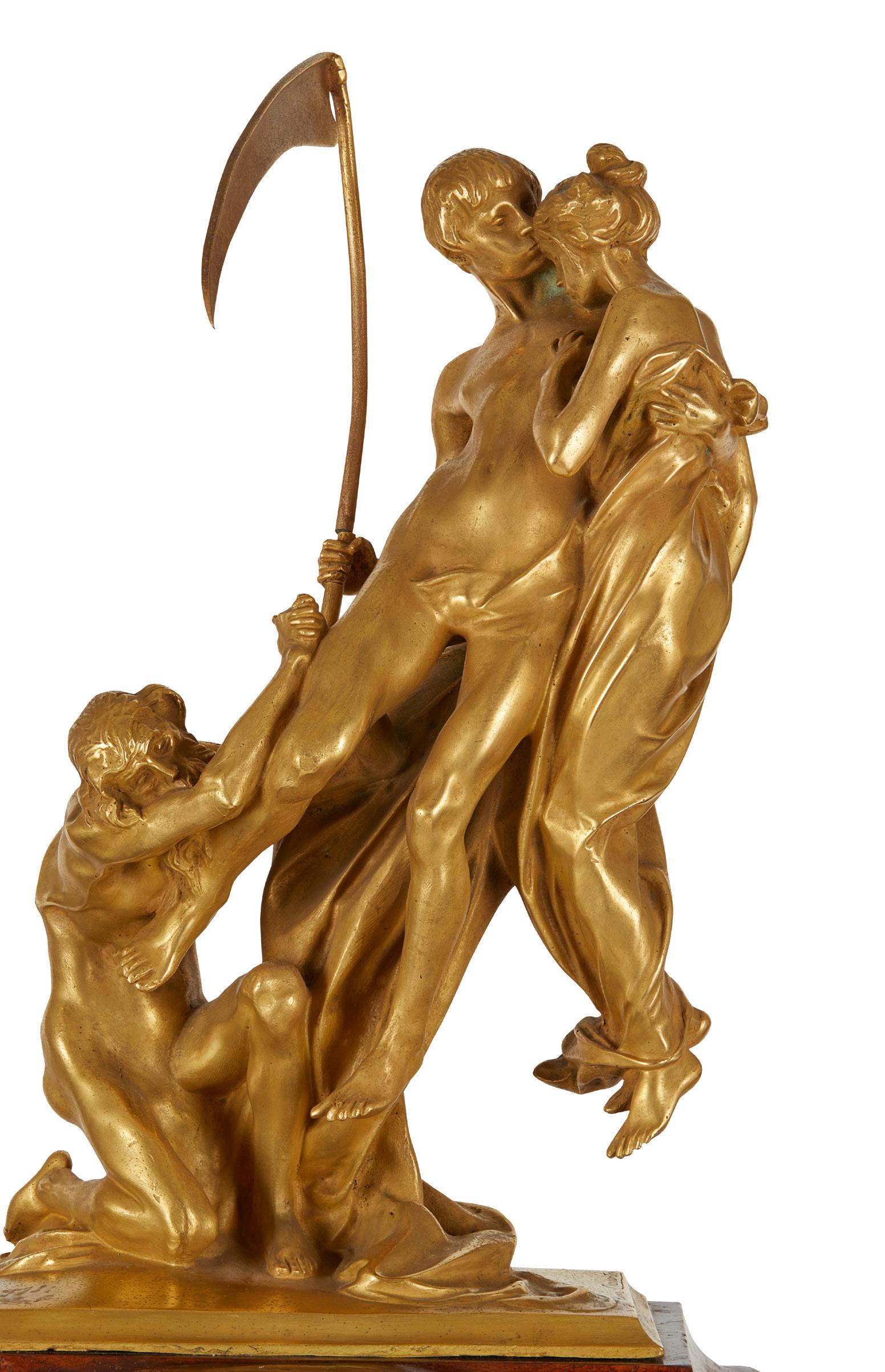
301‡
“It is necessary to make art part of contemporary life. To make the ordinary objects that surround us into works of art”.
120
Promotional quotation from “Les Six”
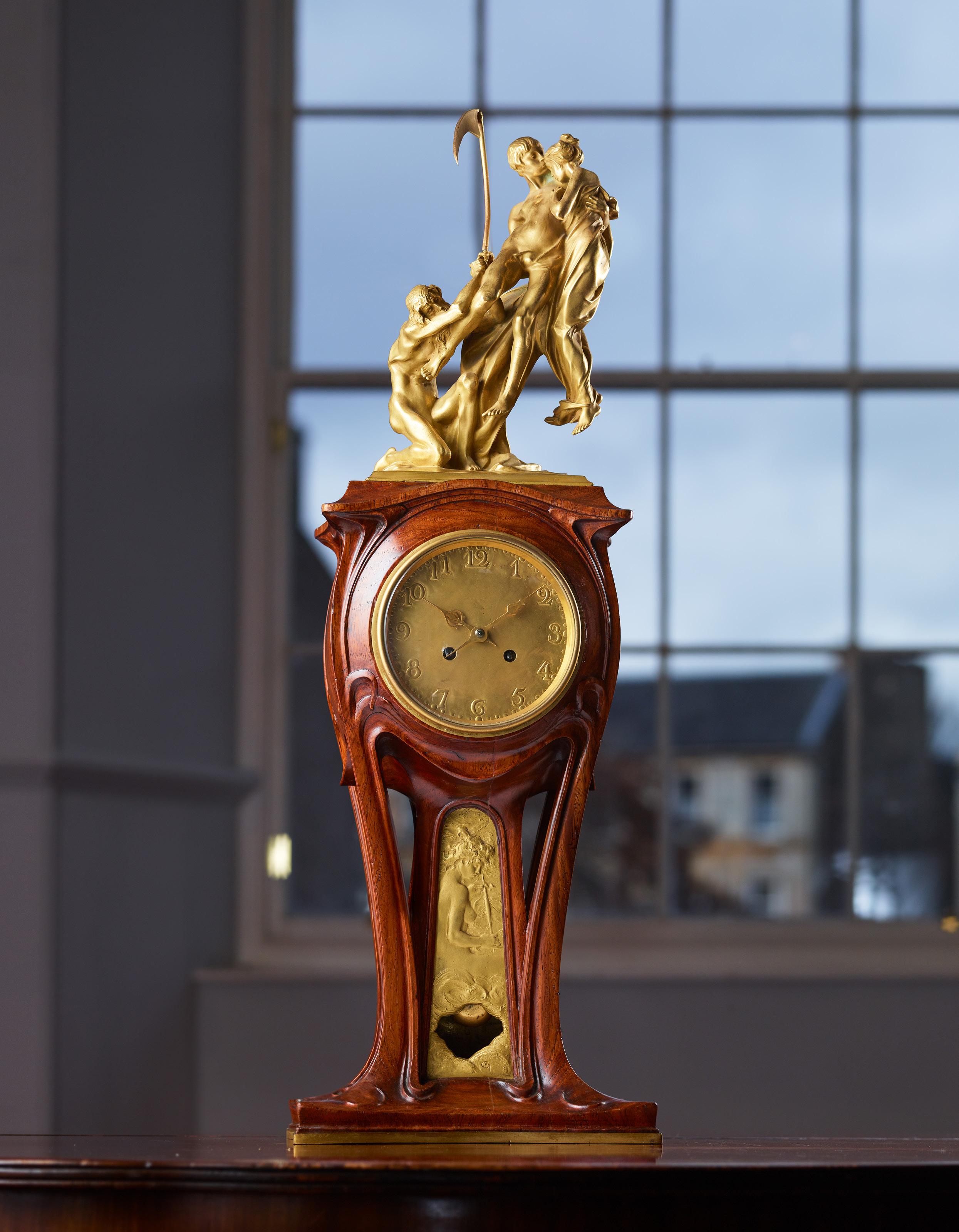
121
302
MAURICE DUFRÈNE (1876–1955)
DOUBLE INKWELL, CIRCA 1900

silvered bronze, with two glass liners, signed DUFRÈNE, underside of base stamped ARG
35cm wide, 15cm deep
£600‑800
303
DAUM FRÈRES, NANCY
TIGER LILY VASE, CIRCA 1900
mottled glass, overlaid and acid‑etched, cameo signature
DAUM NANCY, FRANCE with Cross of Lorraine
305
MYRSTEDT & STERN, STOCKHOLM
GROUP OF FOUR SIDE CHAIRS, CIRCA 1900
beech and ebonised beech, with original kelim close‑nailed upholstered seats, maker’s label under seat (4)
46cm wide, 91cm high, 43cm deep
£400‑600
GEORGES DE FEURE (1868‑1943)
ART NOUVEAU ARMCHAIR, CIRCA 1900

walnut, with later close‑nailed upholstery
67.5cm wide, 87cm high, 53cm deep
306
LOUIS COMFORT TIFFANY (1848‑1933)
‘FAVRILE’ VASE, CIRCA 1910

iridescent glass, etched L.C. TIFFANY FAVRILE H3736
10cm high
£200‑300
122
307
MULLER FRÈRES, LUNÉVILLE, FRANCE
‘POPPIES’ PLAFONNIER, CIRCA 1920
cameo glass, with an indistinct cameo signature, with chain supports 44.5cm diameter, 13.5cm high
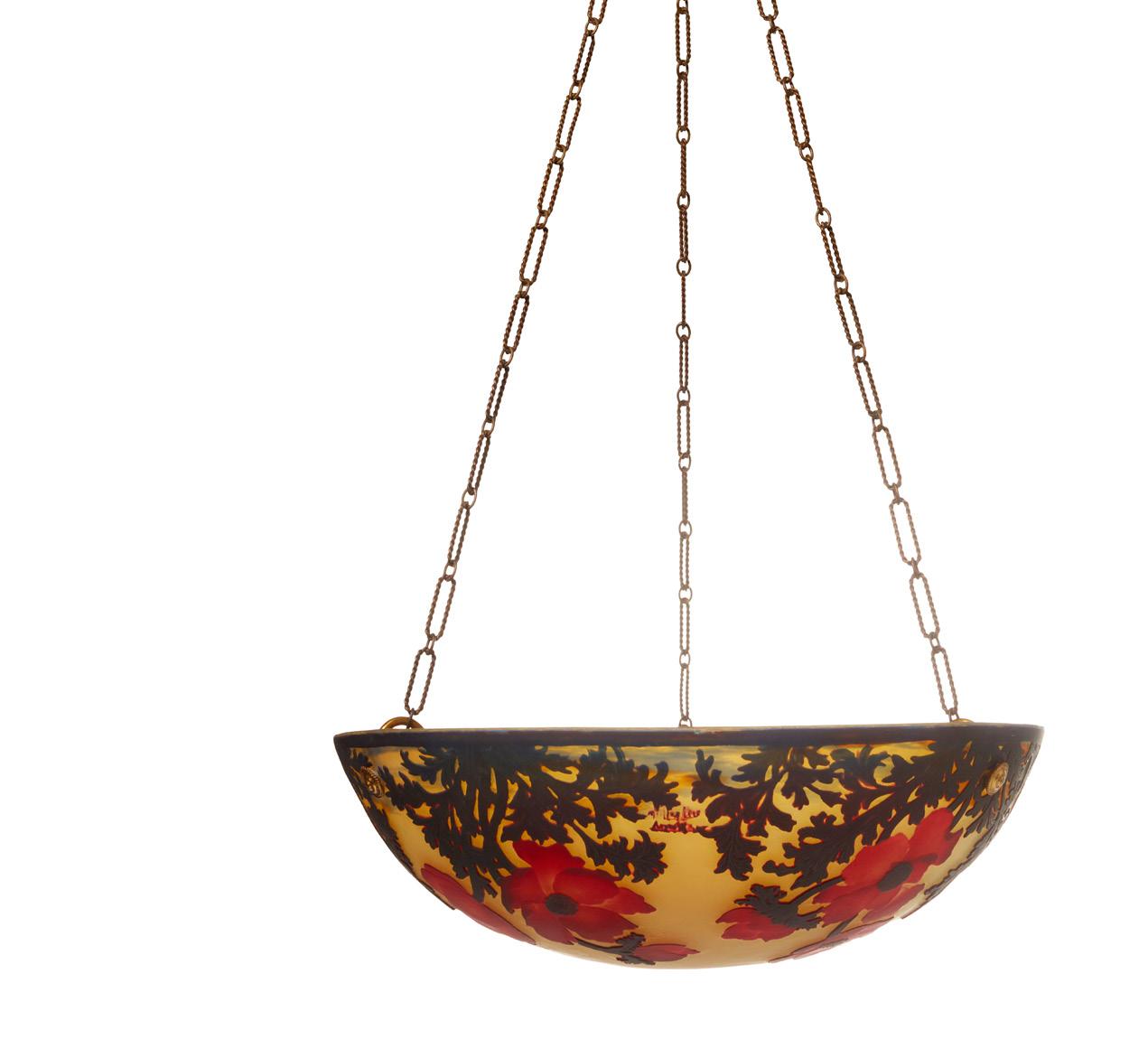

Provenance: Phillip’s, Glasgow Decorative Arts, April 1993, Lot 15
£2,000‑3,000
309
LOUIS MAJORELLE (1859‑1926)
‘OLGA’ ART NOUVEAU SALON TABLE, CIRCA 1900

mahogany, with gilt bronze cast sabots, bears paper label 30154
66.5cm across, 75cm high
Literature: Duncan A. Louis Majorelle: Master of Art Nouveau
Design New York: Abrams, 1991, p.206, where a comparable salon table is illustrated.
£2,500‑3,000
308
GEORGES DE FEURE (1868‑ 1943)
ART NOUVEAU CHAMBERSTICK, CIRCA 1900
silvered bronze modelled as a lily 15cm high, 22cm wide £600‑800

123 Other fees apply in addition to the hammer price: see the ‘Buyer’s Guide’ section on page 2
311
LEON NOEL DELAGRANGE (1872‑1910)
LOIE FULLER (SCARF DANCER)
patinated bronze, signed in the bronze DELAGRANGE, with foundry stamp
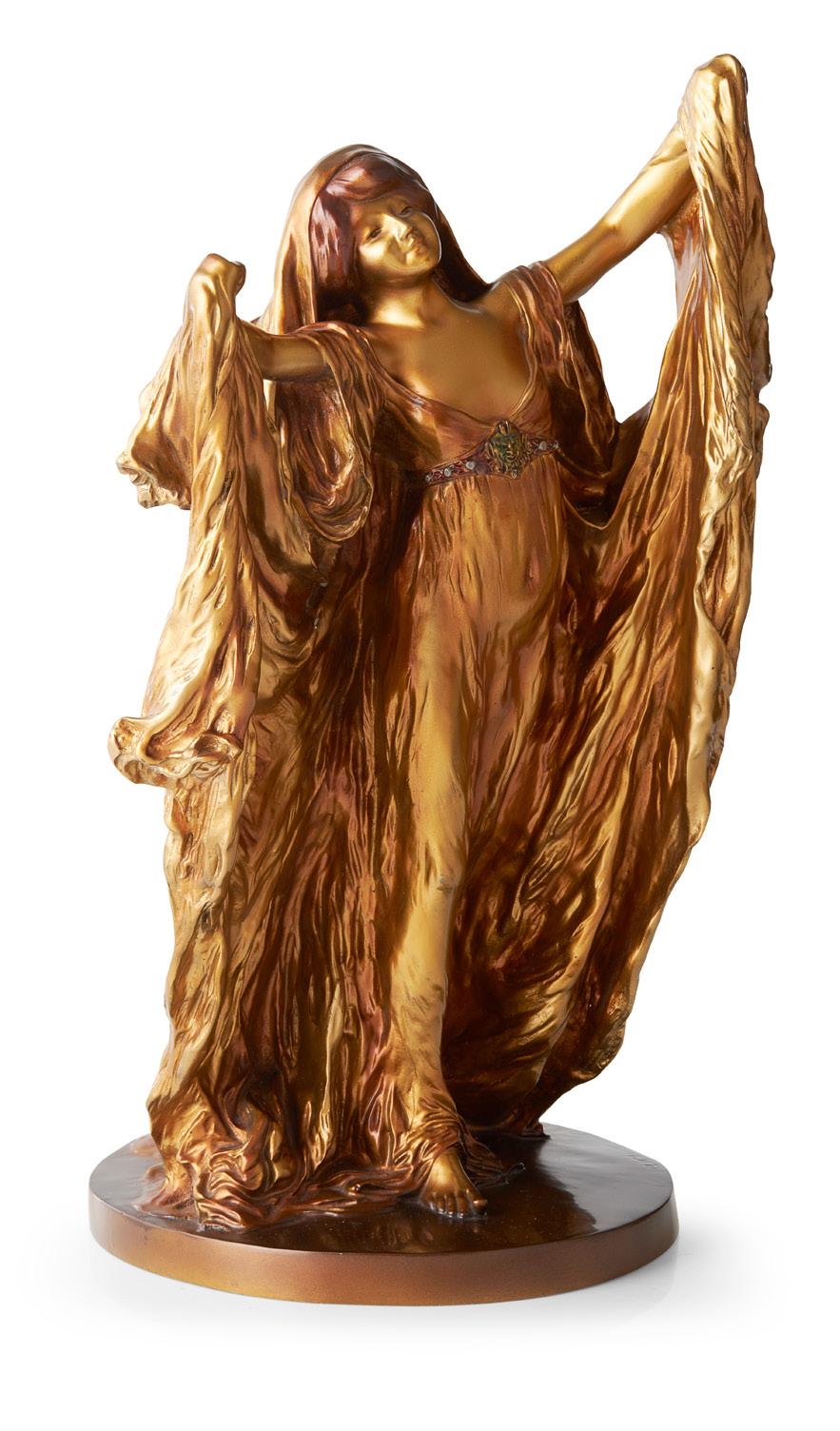
36cm high
£3,000‑5,000
310
FRENCH
PAIR OF ART NOUVEAU
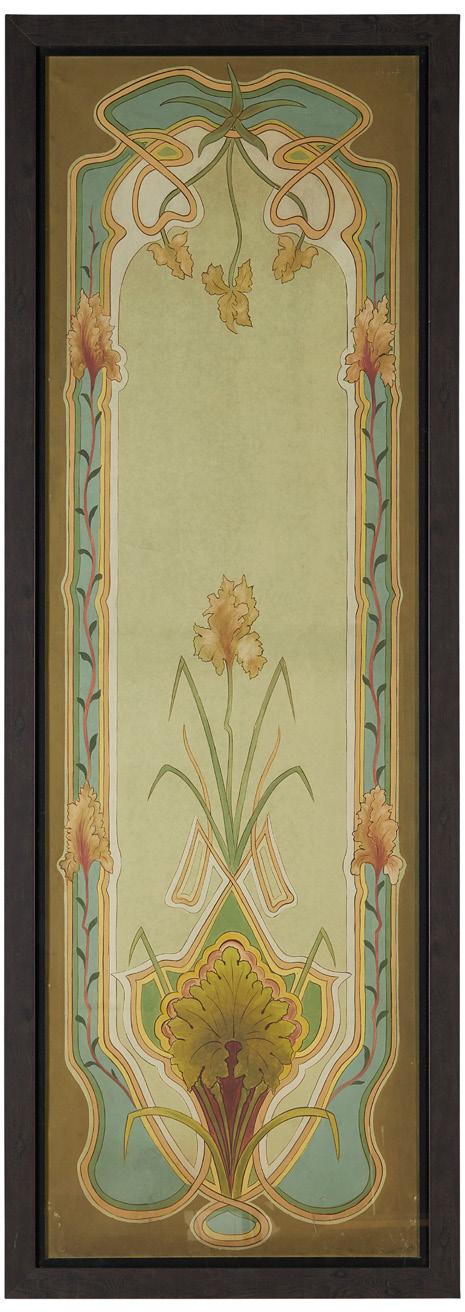
WALL PANELS, CIRCA 1900
Gouache (2)
148cm x 46cm
£500‑800
312
FRENCH
ART NOUVEAU DISPLAY
CABINET, CIRCA 1900

walnut with brass fittings and bevelled mirror plate, interior fitted with adjustable shelves
85cm wide, 184cm high, 45cm deep
£500‑800
313
ENGLISH, MANNER OF J.S. HENRY
PLANT STAND, CIRCA 1900
mahogany, inlaid with specimen woods and pewter
26cm diameter, 114.5cm high
£200‑300
124 Other fees apply in addition to the hammer price: see the ‘Buyer’s Guide’ section on page 2
314
LUDWIG MAROLD (1865‑1898)
FEMME AUX NENUPHARS
engraving, after a painting of 1897 106cm x 50cm

£500‑700
315
CONTINENTAL PAIR OF JUGENDSTIL CANDELABRA, CIRCA 1900 pewter, later finished in gold (2)

25.5cm high
£400‑600
316
MANNER OF OTTO WAGNER SECESSIONIST DRESSING TABLE, CIRCA 1900

stained mahogany, walnut, mirrored glass and marble
131cm wide, 174cm high, 43cm deep £300‑500
317
ROYAL DUX, BOHEMIA BEDOUIN FIGURE GROUP, EARLY 20TH CENTURY
painted porcelain, impressed 1731, painted 44, applied pink triangle with impressed factory mark 44cm high
£200‑300
125
318‡
THÉODORE DECK (1823‑1891)
FAÏENCE VASE, CIRCA 1880


glazed ceramic, signed to base TH. DECK 48.7cm high
Note: Born in Guebwiller, Haut‑Rhin, Théodore Deck moved to Vienna as a young man, training as a stove‑maker and producing work for Schönbrunn Palace. He returned to France in 1847 and, impressed by the majolica wares shown by the Minton factory at the Exposition Universelle of 1855, Deck was moved to produce his own. In 1856 he established his faïence workshop Joseph‑Théodore Deck Ceramique Française, initially producing ceramics in the Islamic and Turkish Iznik style. Throughout the 1880s Deck’s pottery began to reflect elements of japonisme, a popular element of the Aesthetic Movement in the late 19th century.
Working with notable artists such Raphaël Collin, Deck developed a number of his own glazes, the most familiar being bleu de Deck, used in this pair of baluster vases.
Deck’s obituary in the New York Times recognises that it was “at the Exhibitions of Decorative Arts, in Paris in 1880 and 1884, [that] he attained world‑wide celebrity with his vases, red, turquoise, Deck blue, and other colors (sic), limpid, profound, and dazzling.” A committed aesthete, “Deck died at Sèvres, in the little pavilion‑with rooms of gold, satin, and velvet, filled with vases painted in manganese violet and eel yellow colors (sic), lacquers, netsukes, and swords of Japan…. He was inseparable from his surroundings; he wore the air of their art and charm as if he had been born among them.”
£6,000‑8,000
126 Other fees apply in addition to the hammer price: see the ‘Buyer’s Guide’ section on page 2

127
CAMILLE GAUTHIER (1870‑1963) (ATTRIBUTED TO) ART NOUVEAU DINING SUITE, CIRCA 1900
tulipwood, bronze, comprising an EXTENDING DINING TABLE, with four later leaves, 127cm long (closed), 323cm long (open), 74cm high, 124cm deep; a SIDEBOARD CABINET, with marble top and cast bronze handles, 172cm wide, 165cm high, 49cm deep; and SEVEN DINING CHAIRS, each with later close‑nailed leather upholstery, 44cm wide, 91cm high, 37cm deep (9)

Note: Camille Gauthier began his career with Louis Majorelle in 1893, as a draftsman in the design office. At this point in his career, Majorelle was producing reproductions of Louis XV furniture. These he exhibited in 1894 at the Exposition d’Art Décoratif et Industriel in Nancy, but the influence of the glass and furniture‑maker Emile Galle (1846 ‑ 1904) inspired him to take his production in new directions.

As a draftsman for the firm Gauthier will have been absorbed in producing designs for marquetry, carved details and the sinuous lines of the Art Nouveau style. By 1900 he decided to set up his own company and in 1904 joined forces with industrialist and upholsterer Paul Poinsignon.
The firm was immediately successful, appealing to a wide market and producing high‑quality furnishings in their mechanized workshops. Their production adhered to the principles of the School of Nancy (L’École de Nancy). The School was part of a wider effort to dissolve the divide between the ‘major’ arts of painting and sculpture and the ‘minor’ decorative arts. Set up by Émile Gallé in 1901, it was principally supported by designers Louis Majorelle, Victor Prouvé, and the glassmakers August and Jean‑Antonin Daum. Camille Gauthier was on the steering committee. They aimed to enhance the artistic content of industrially produced articles through the intervention of the craftsman, building on the legacy of the writings of John Ruskin and William Morris in Britain. £10,000‑15,000
128 Other fees apply in addition to the hammer price: see the ‘Buyer’s Guide’ section on page 2
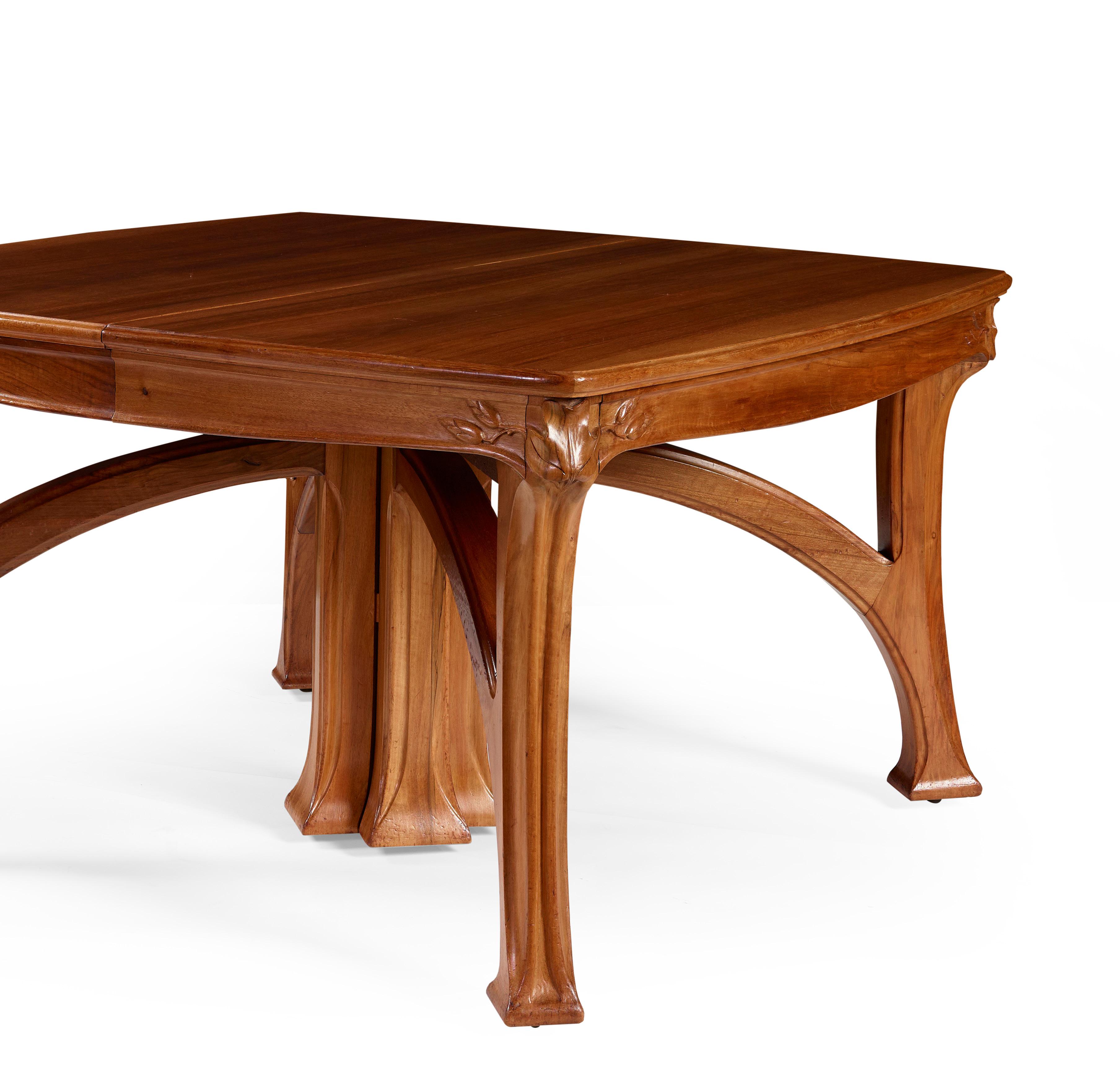
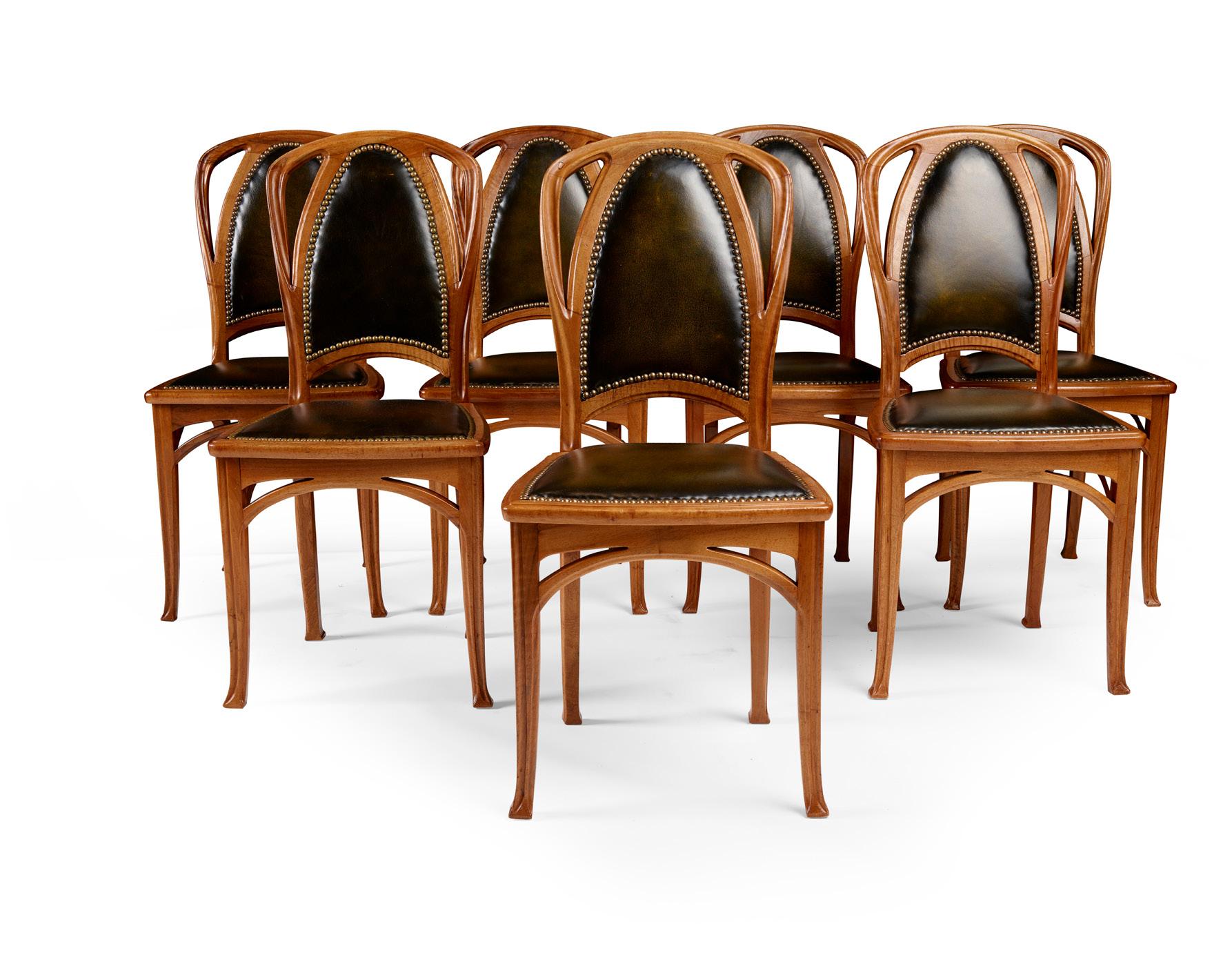
129
320
CHARLES REPELIN (1860‑1934)
ART NOUVEAU PORTRAIT OF A GIRL oil on canvas, signed and dated lower right CH. REPELIN 1897

79cm x 72cm £1,000‑1,500
321
LOUIS MAJORELLE (1859‑1926)
ART NOUVEAU CABINET, CIRCA 1900 walnut, with specimen wood marquetry inlay, pokerwork signature L. MAJORELLE/ NANCY 56.5cm wide, 150cm high, 46cm deep £4,000‑6,000

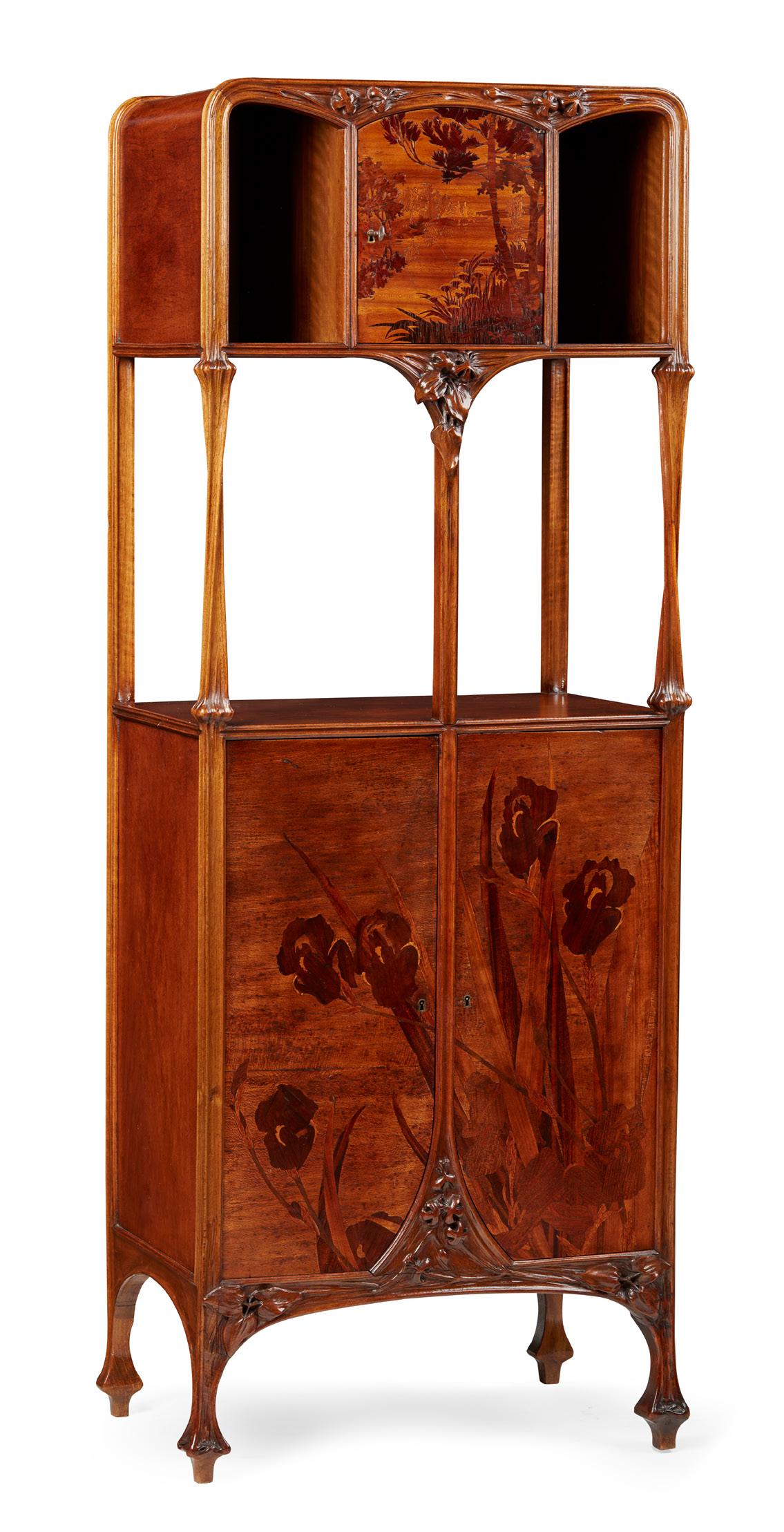
130
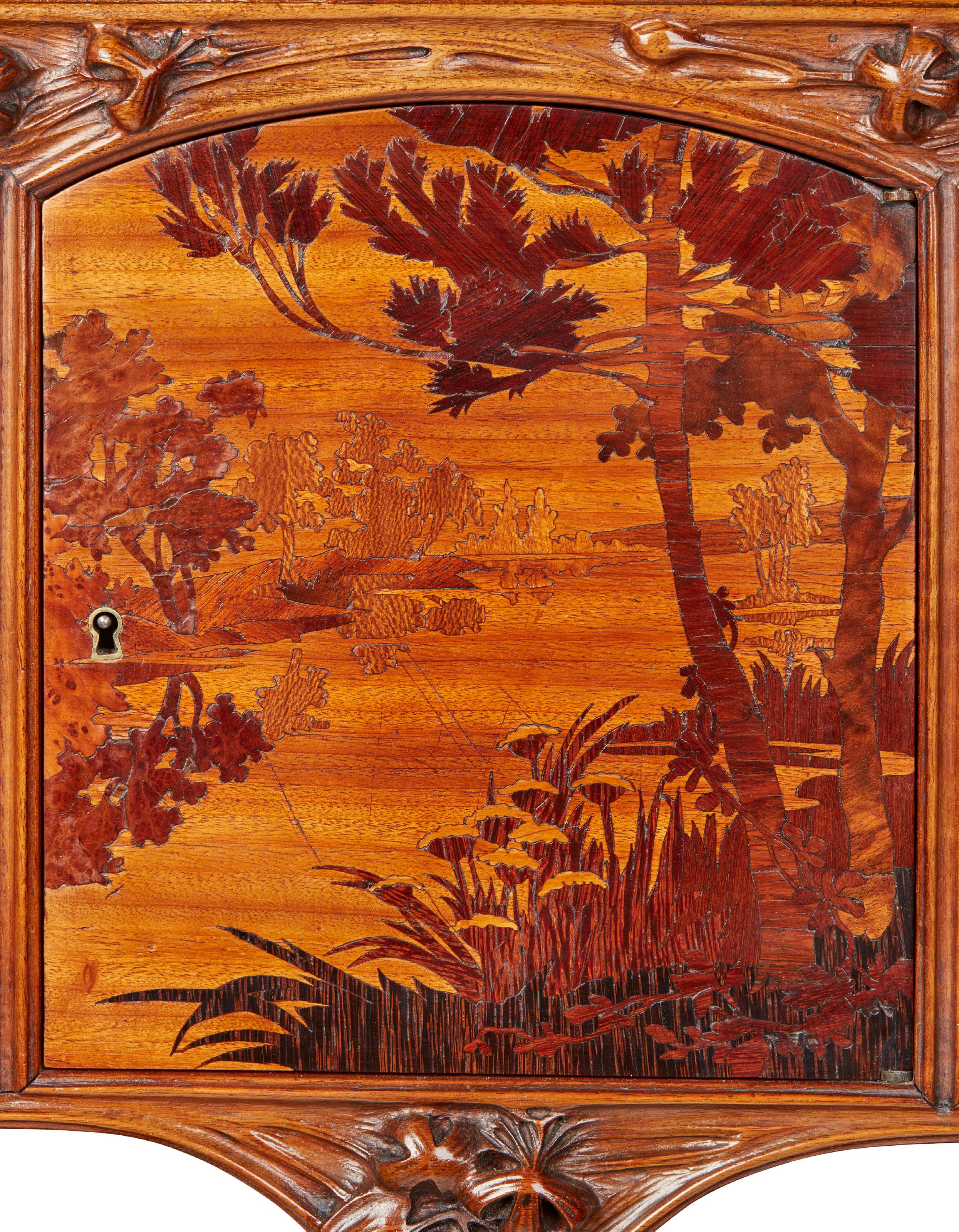
131
322
DAUM FRÈRES, NANCY
VASE, CIRCA 1900
painted cameo glass, decorated with flowering aquilegia, signed to the body DAUM/ NANCY with Cross of Lorraine
8.7cm high
Provenance: Sotheby’s, New York, Arcade Art Deco, 18th March 1994, Lot 44
£500‑700
323
DAUM FRÈRES, NANCY
VASE, CIRCA 1900
painted cameo glass, decorated with flowering lilies, signed to the body DAUM/ NANCY with Cross of Lorraine
8.7cm high
Provenance: Christie’s, South Kensington Decorative Arts 1850 to the Present Day, March 1993, Lot 67 £500‑700
324
EMILE GALLÉ (1846‑1904)
MINIATURE FIRE POLISHED
‘IRIS’ VASE, CIRCA 1900


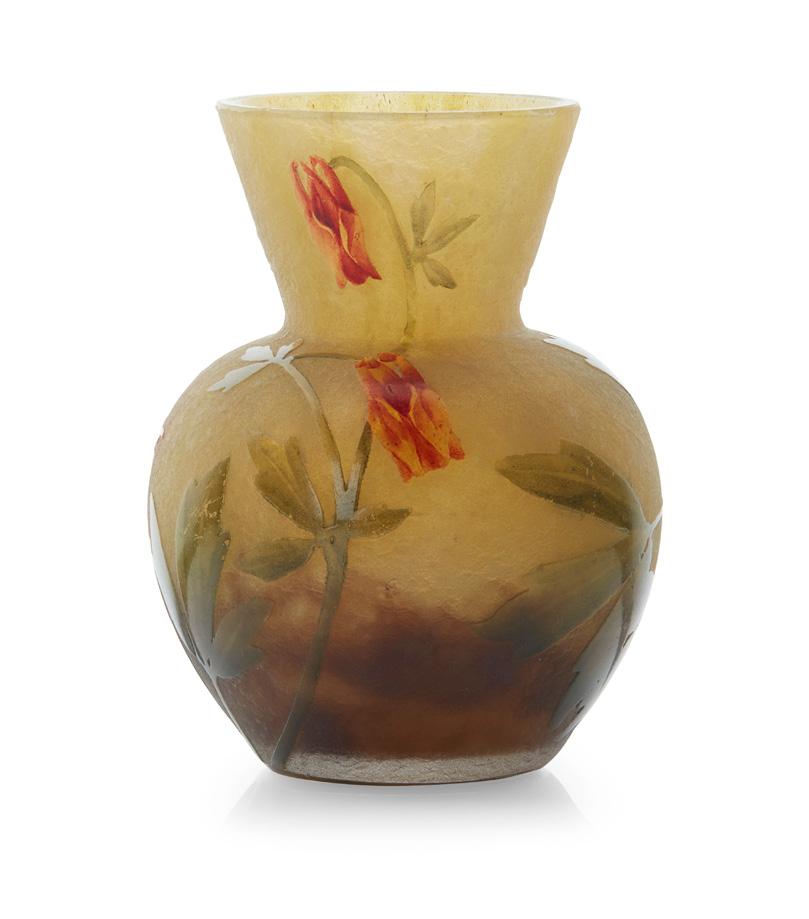
cameo glass, acid‑etched and overlaid, cameo signature GALLÉ
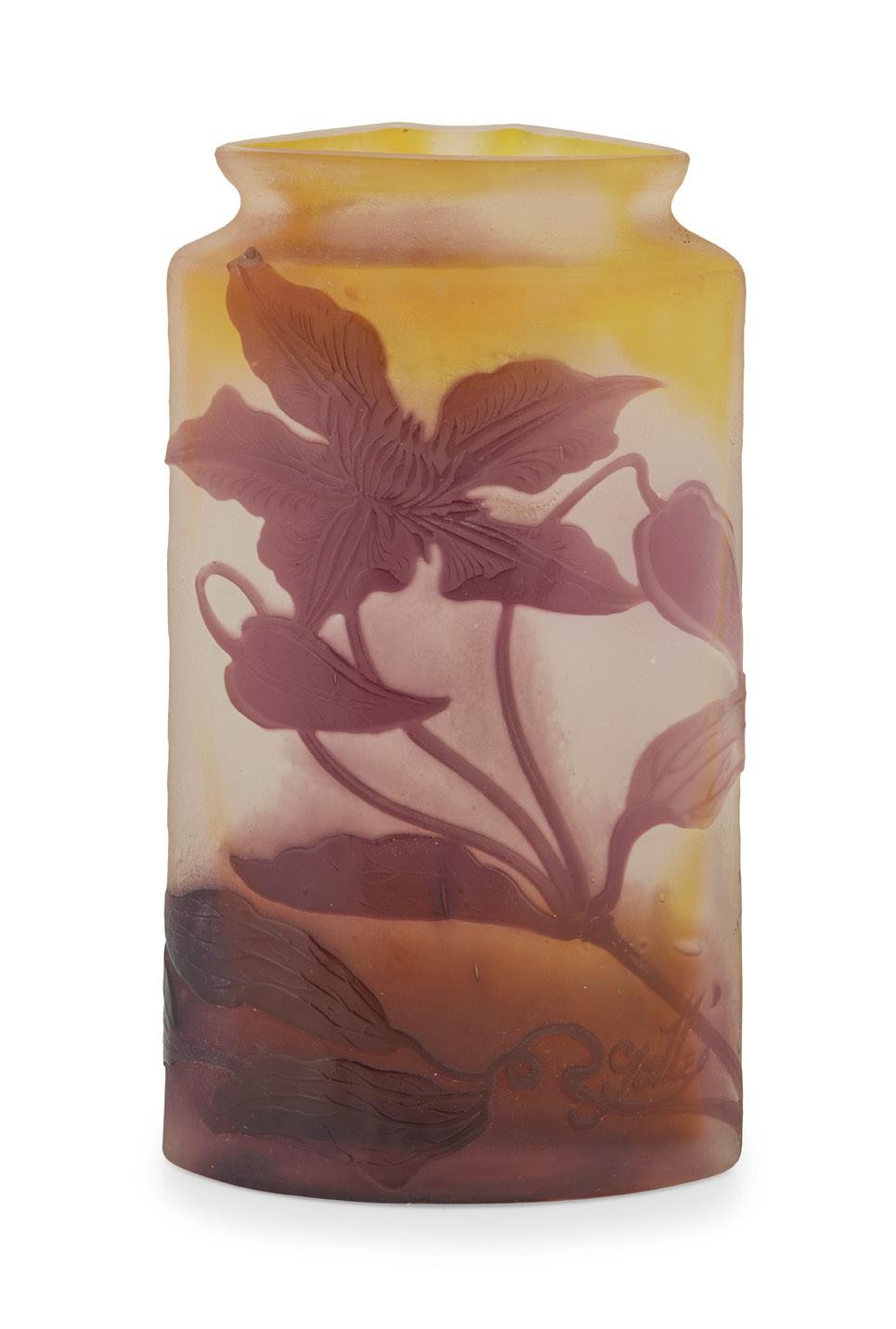
10cm high
£600‑800
325
GALLÉ
‘CLEMATIS’ VASE, CIRCA 1910
cameo glass, cameo signature to body GALLÉ
17.5cm high
£300‑500
132 Other fees apply in addition to the hammer price: see the ‘Buyer’s Guide’ section on page 2
326
EMMANUEL VILLANIS (1858–1914)
L’AMOUR DE L’ART
bronze, inscribed L’AMOUR DE L’ART, signed E. VILLANIS 67cm high
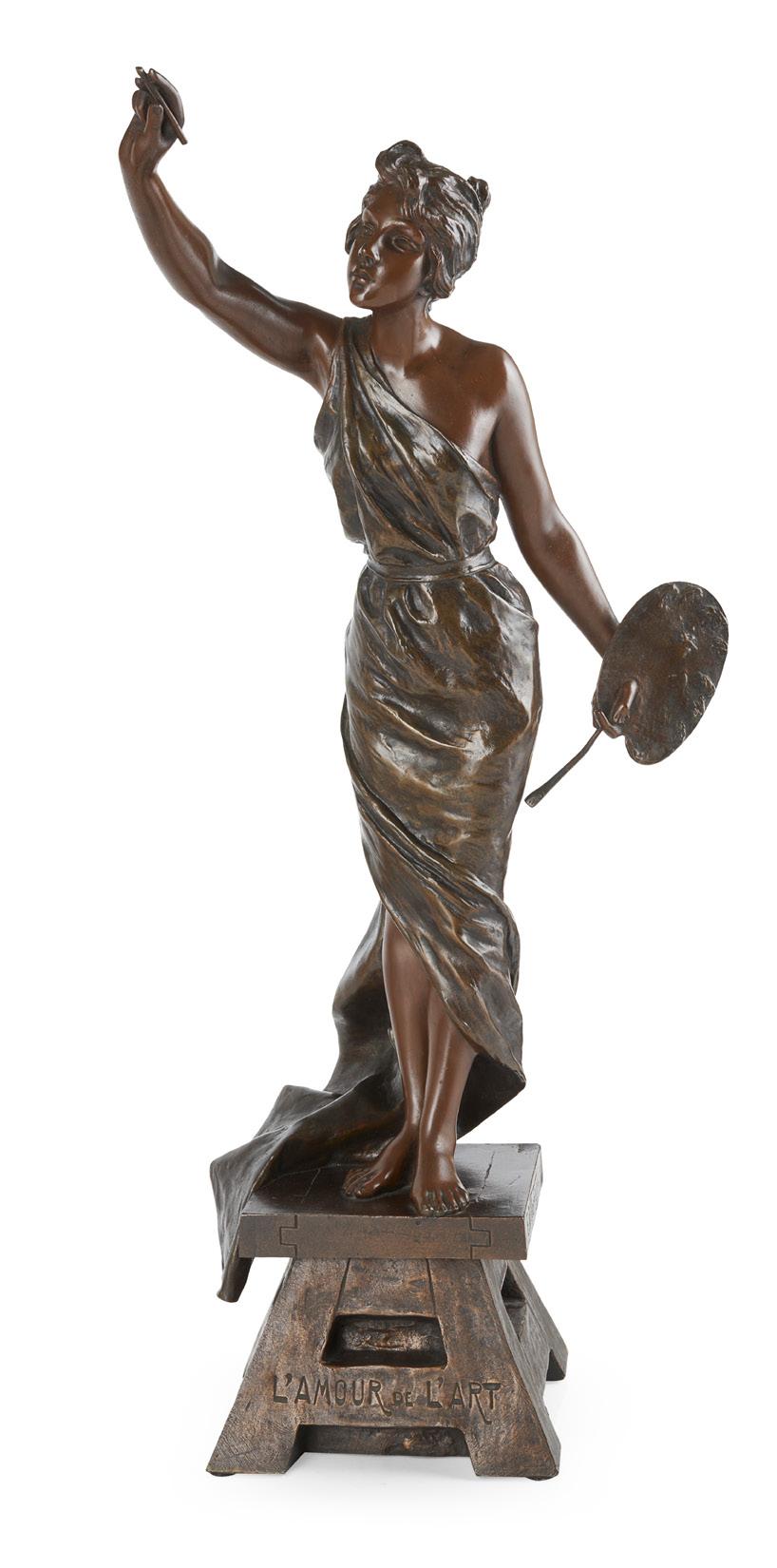
£600‑800
327
GEORGES ENGRAND (1852‑1936)
ART NOUVEAU TAZZA, CIRCA 1910
patinated bronze, signed in the bronze ENGRAND
35.5cm high
£300‑500
328
WILHELM HAVERKAMP (1864‑1929) DER BOCKSPRUNG (LEAPFROG)
bronze, on marble plinth, signed and dated in the bronze W. HAVERKAMP, ROM 1891 52cm high, including plinth
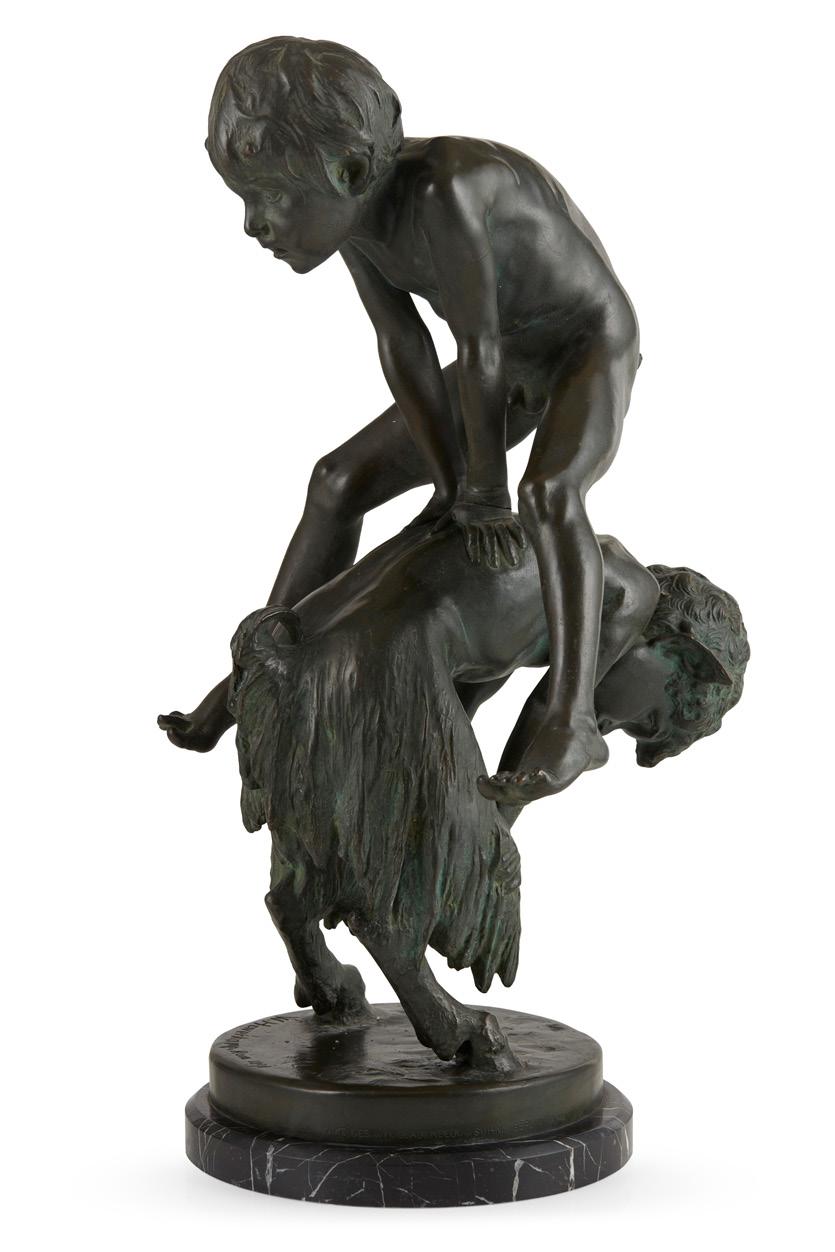
£800‑1,200
329
FRITZ SCHMOLL VON EISENWORTH (1883‑1963) FOR BRUCKMANN & SÖHNE, HEILBRONN COFFEE POT, CIRCA 1913
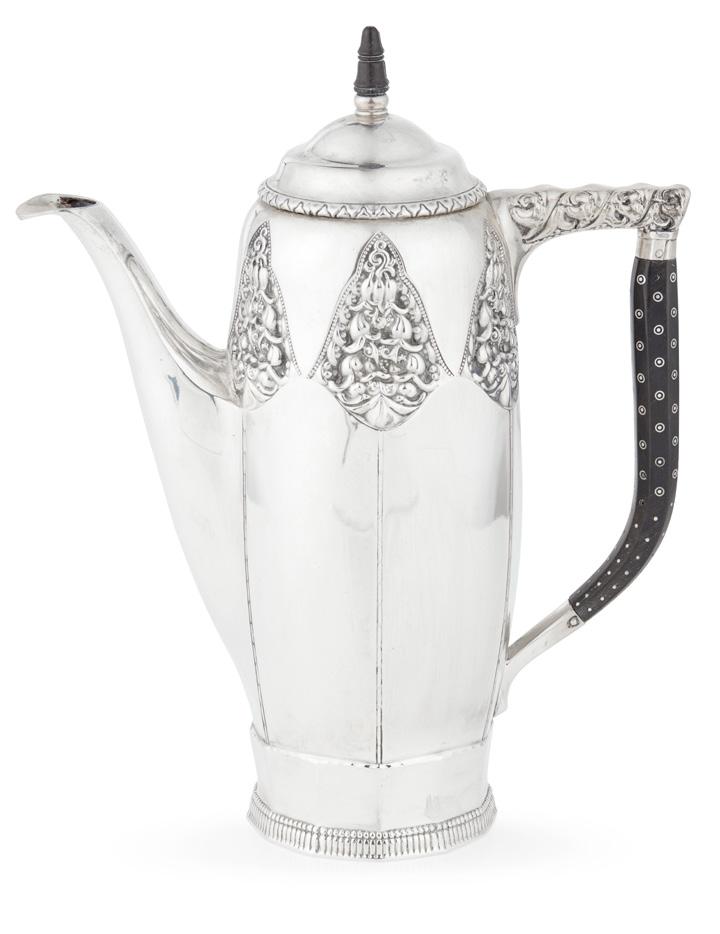
silver and ebonised wood, stamped LEUS WERNER/ 800 28cm high

Note: An example of this coffee pot is also in the British Museum (1995,0716.1)
£800‑1,200
133

134
DAUM FRÈRES, NANCY
VASE, CIRCA 1930
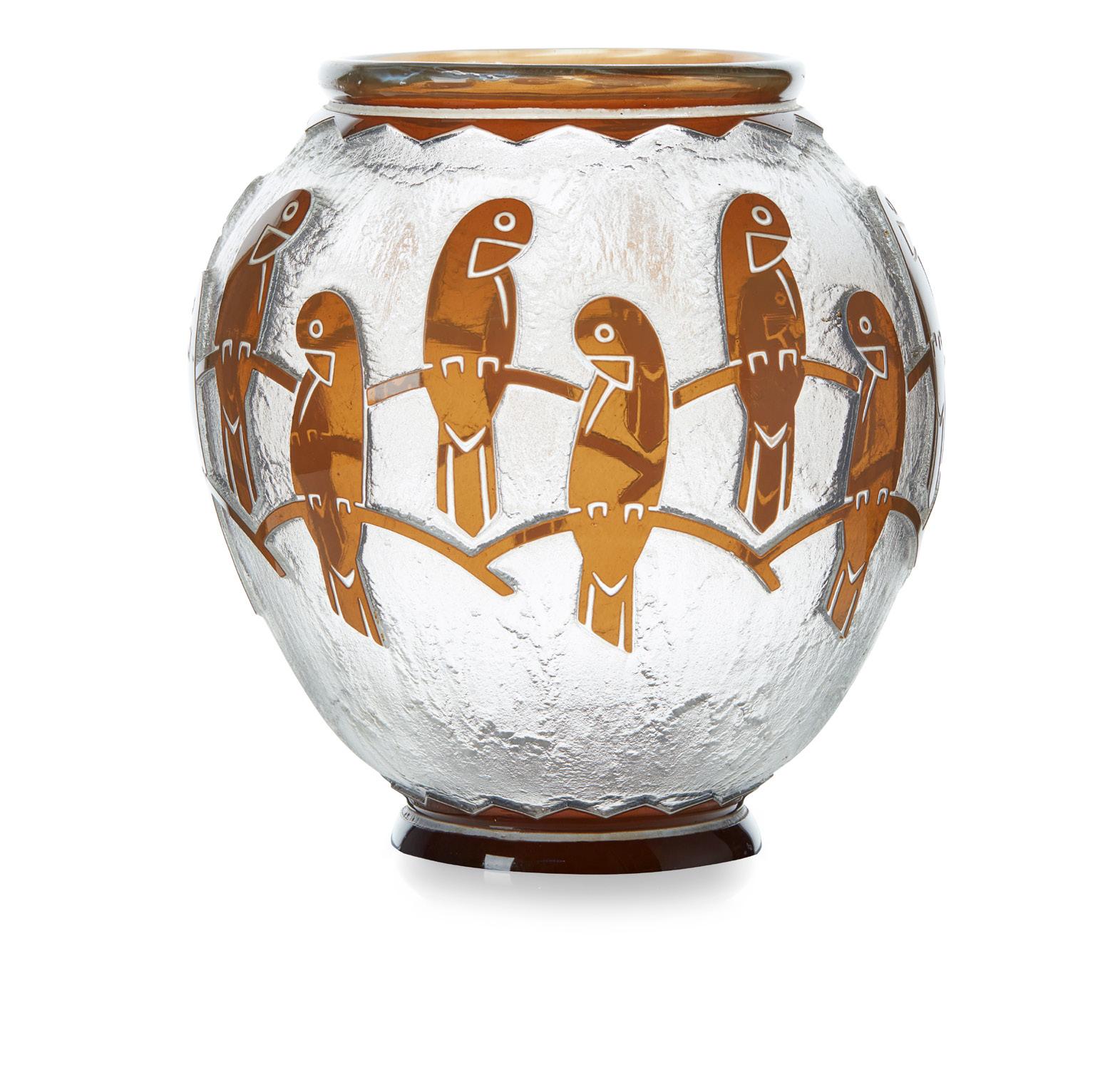
cameo and overlaid glass, decorated with parrots, etched to foot DAUM NANCY
FRANCE
30cm high
£4,000‑6,000
330
R.
ART DECO MANTEL CLOCK, CIRCA 1925
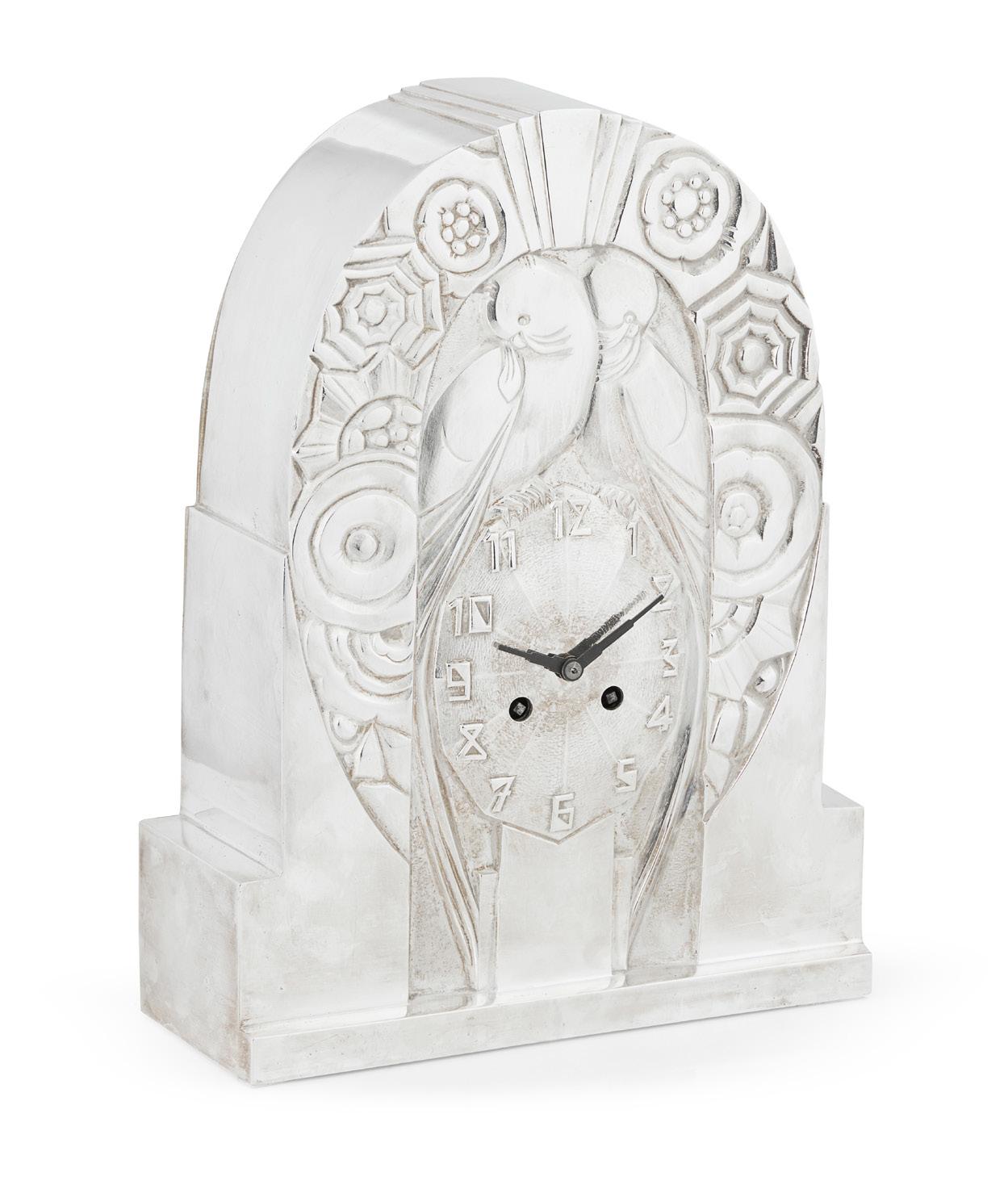
silver plated bronze, unsigned
35cm high
£800‑1,200
TERRAS
331‡
135 Other fees apply in addition to the hammer price: see the ‘Buyer’s Guide’ section on page 2
334Y FRENCH
ART DECO TWIN PEDESTAL DESK, CIRCA 1935
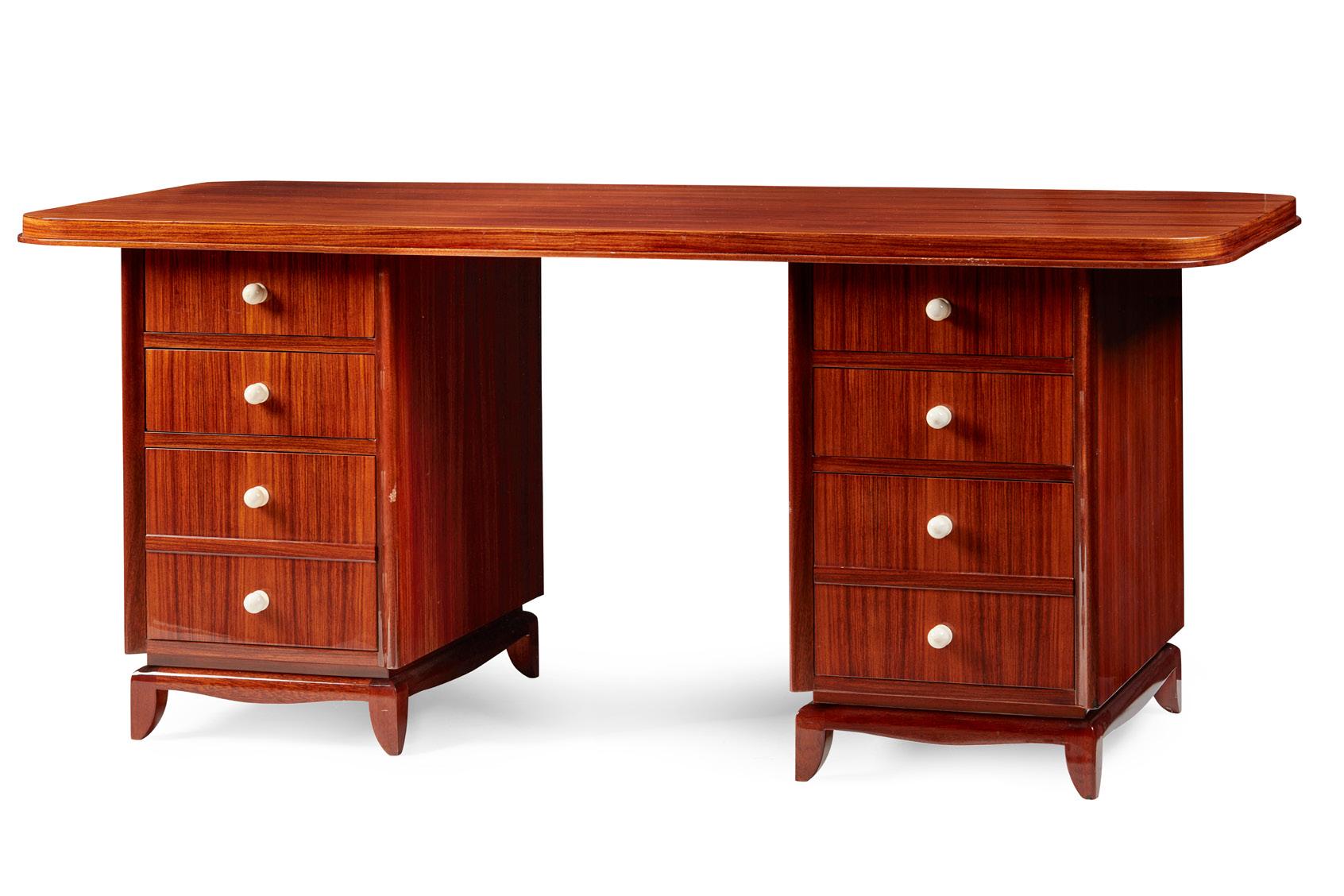
mahogany, with ivory handles
179cm wide, 79cm high, 78cm deep
Note: Sold in compliance with UK Government and APHA regulations, with (non‑transferable) exemption registration reference YGZ72WDW.
£1,000‑1,500
332 §
LOUIS ICART (1888‑1950)
‘MON MODÈLE’ 1933
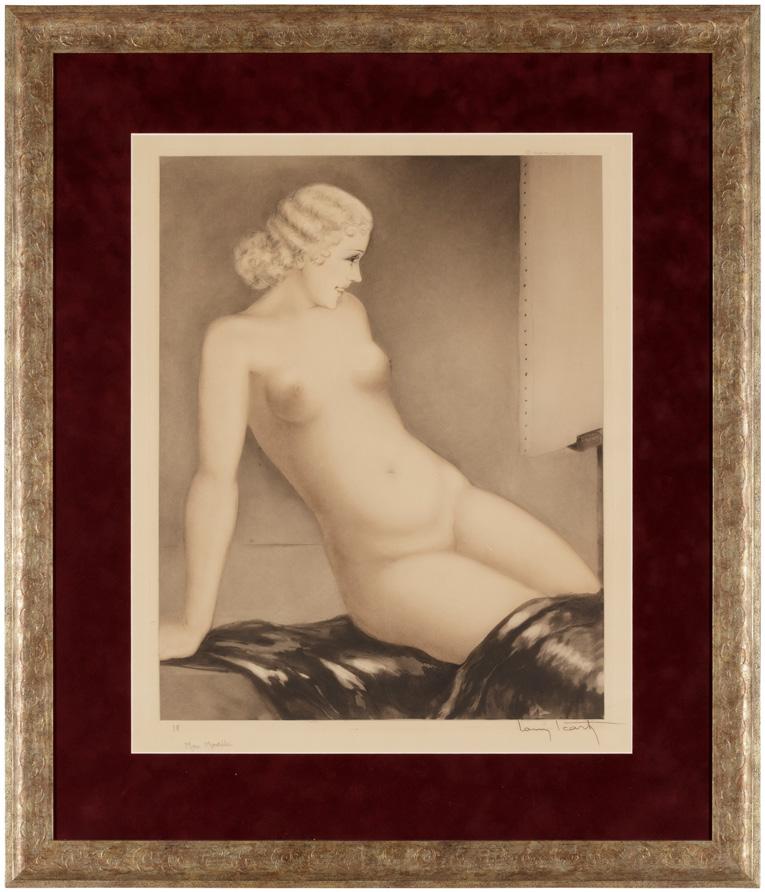
etching and drypoint, with hand‑colouring, signed and inscribed in pencil, with the artist’s blindstamp
53cm x 41cm
£600‑800
333
JULES LELEU (1883 –1961)
PAIR OF EASY CHAIRS, CIRCA 1930
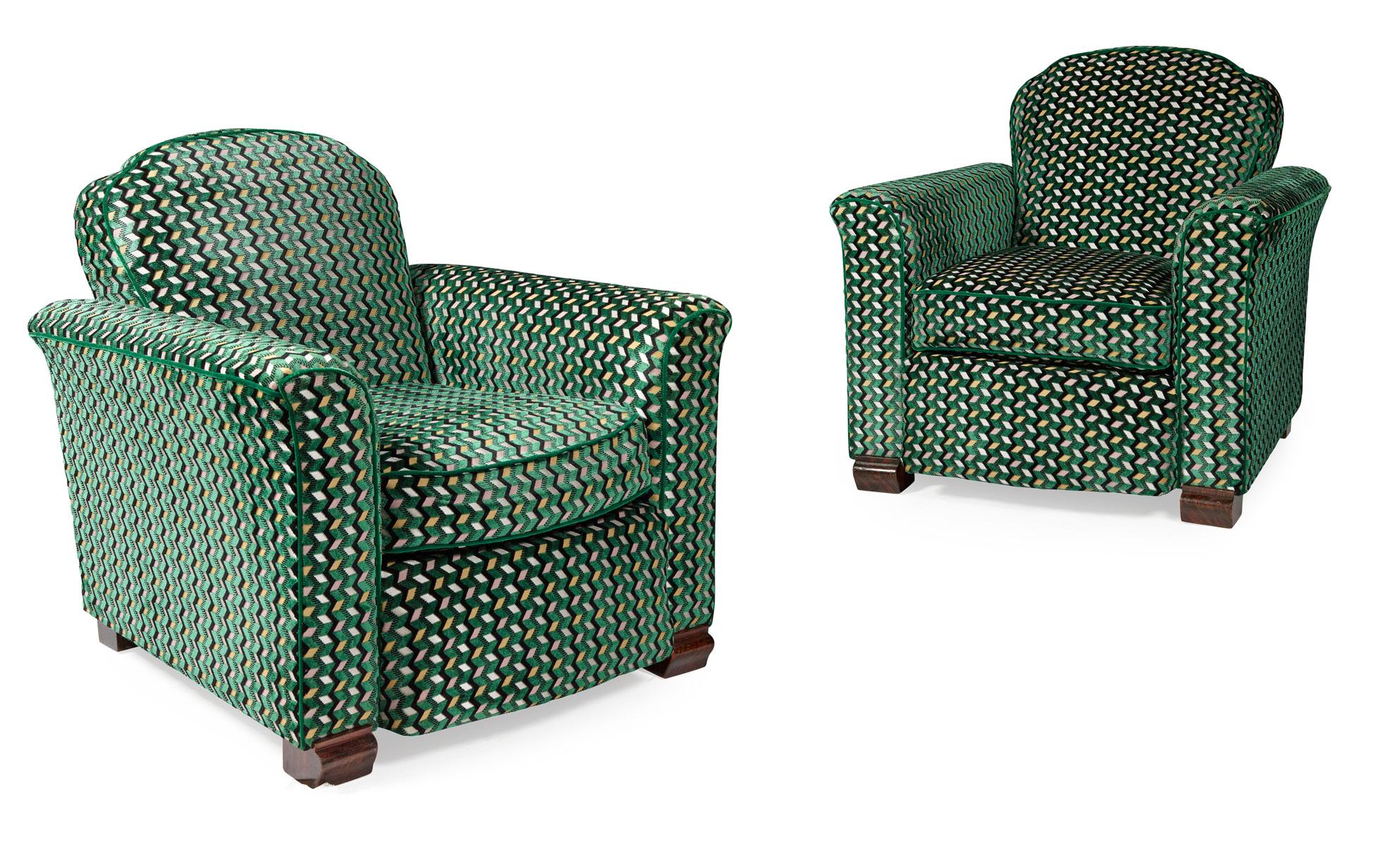
Macassar ebony frames, later upholstered (2)
84cm wide, 78cm high, 82cm deep
£2,000‑3,000
136 Other fees apply in addition to the hammer price: see the ‘Buyer’s Guide’ section on page 2
335‡
DAUM FRÈRES, NANCY
TABLE LAMP, CIRCA 1930

acid‑etched glass, wrought steel mounts, wheel‑etched to base and shade DAUM NANCY FRANCE
48cm high
Literature: Lesieutre, A. The Spirit and Splendour of Art Deco, New York, 1974, n.p., cat. no. 220
Daum, N. Daum: Maitres Verriers, Lausanne, 1985, p. 150 (for a related example)
Bacri, C. Daum: Masters of French Decorative Design, New York, 1992, pp. 206 209 (for related examples)
Esveld, T. Daum Art Deco Glass: A Private Collection, Brasschaat, Belgium, 2015, p. 238
£5,000‑7,000
137
336‡
ORFÈVRERIE GALLIA
BOXED SET OF TWELVE ANIMAL AND BIRD KNIFE RESTS, CIRCA 1930

cast metal, stamped GALLIA, box with printed mark
337
MANNER OF SUE ET MARE
ART DECO STOOL, CIRCA 1925
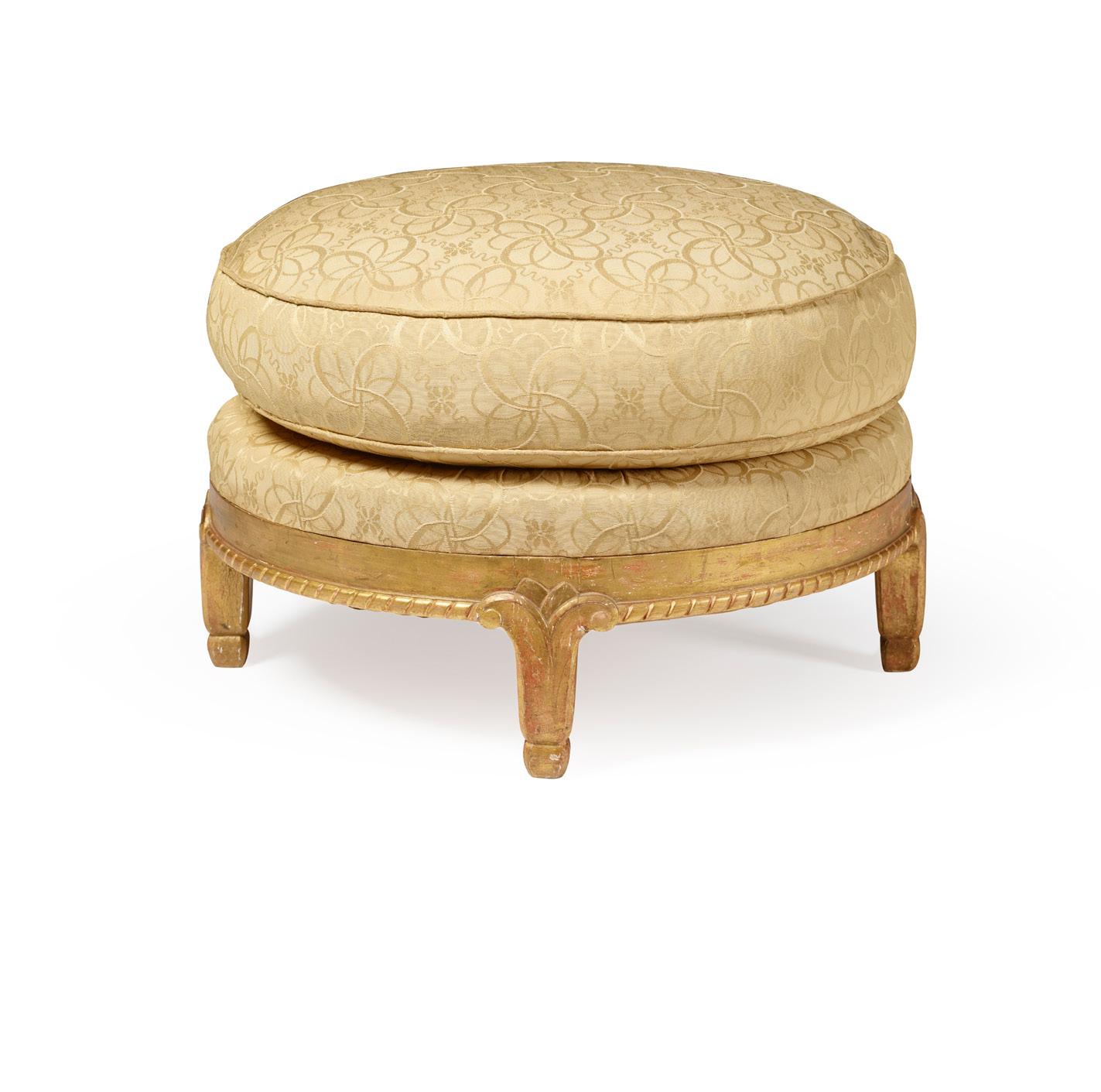
gilded wood, with later silk upholstery and matching squab cushion
63cm diameter, 45cm high
£400‑600
338
MANNER OF EDGAR BRANDT ART DECO CONSOLE

TABLE, CIRCA 1930
marble, wrought steel
137cm wide, 82cm high, 36cm deep
£1,000‑1,500
138 Other fees apply in addition to the hammer price: see the ‘Buyer’s Guide’ section on page 2
339
ALFRED DAGUET (1875‑1942)
FISH ROUNDEL PLAQUE, CIRCA 1900
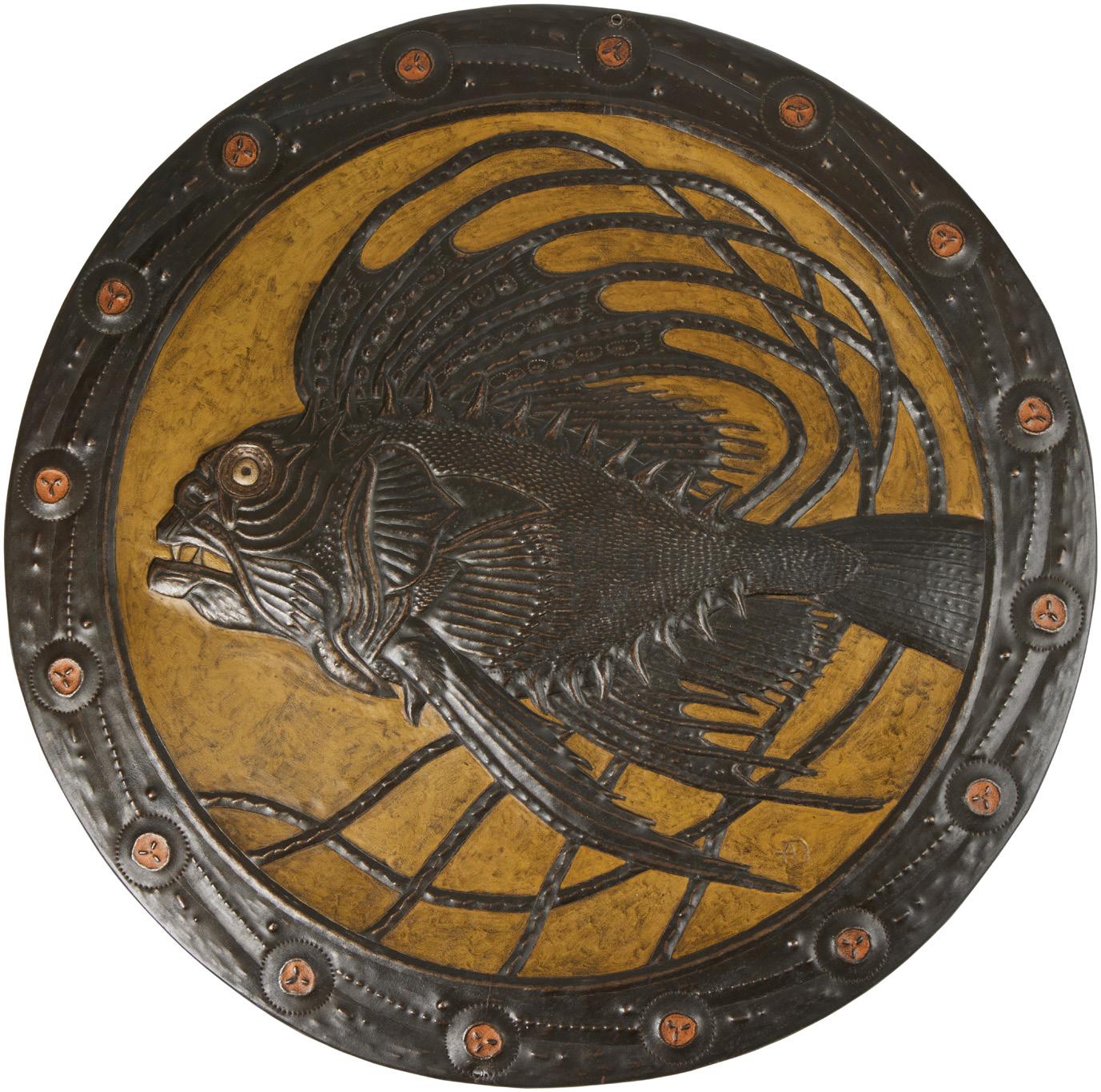
repoussé decorated copper, with applied patination, monogram mark AD
50cm diameter
Note: Alfred Daguet’s atelier was situated above Siegfried Bing’s famous showroom, Maison de l’Art Nouveau, that displayed his works as well as those by Louis Comfort Tiffany, and numerous other Art Nouveau artists such as Clément Massier, Eugène Gaillard and Georges de Feure. Bing was a major proponent of the Art Nouveau movement and his pavilion at the Exposition Universelle of 1900 in Paris signified to the world the importance of this new style. £4,000‑6,000
340‡ DEMETRE CHIPARUS (1886‑1947)
ACCIDENT DE CHASSE
gilt and cold‑painted bronze, variegated marble base, signed in cast D. H. Chiparus, applied plaque ACCIDENT de CHASSE Par D.H. Chiparus (Récompensé au Salon) 25cm high, 42cm long, 19cm deep £3,000‑5,000
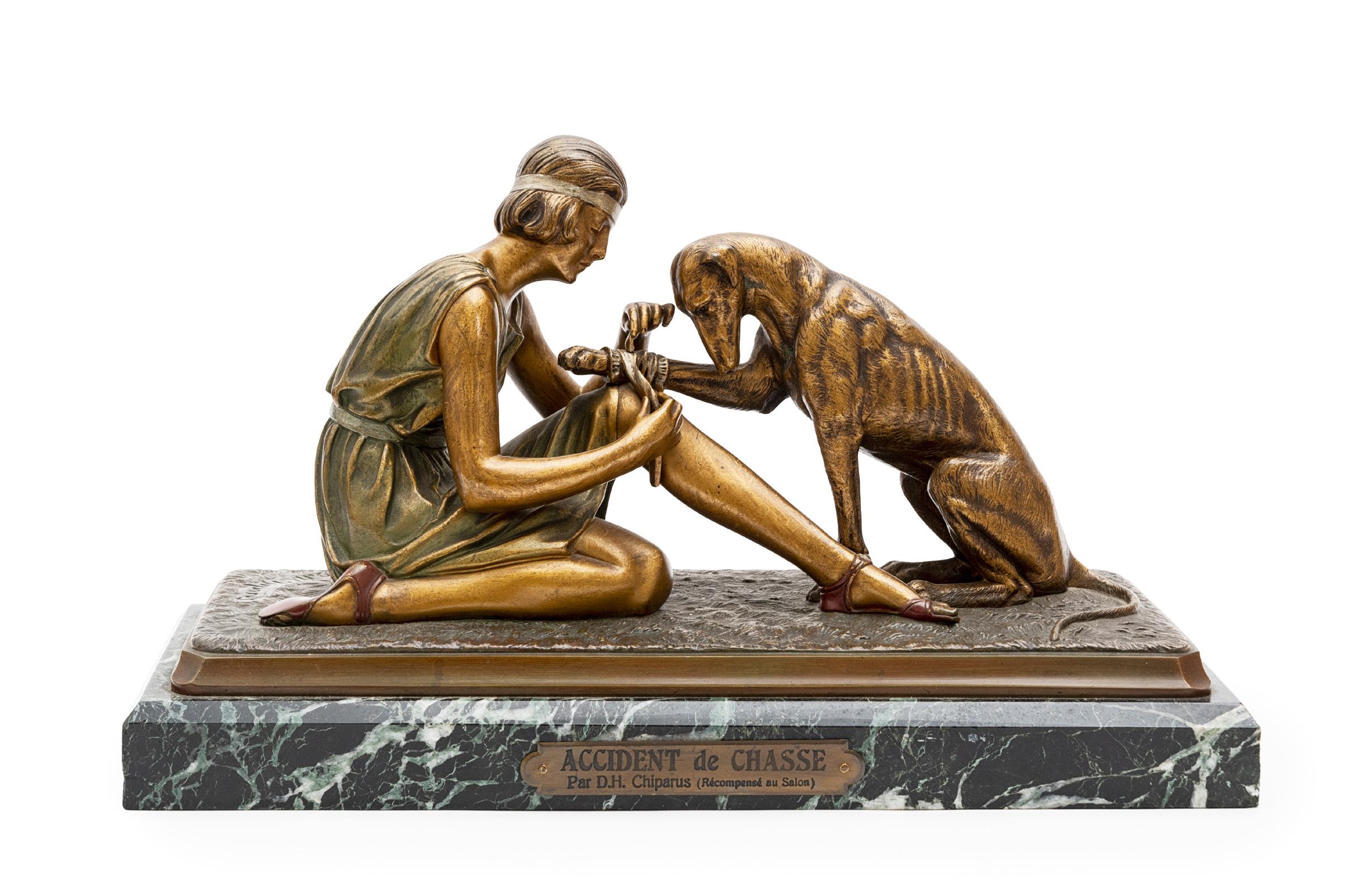
139
342
FRENCH, MANNER OF EDGAR BRANDT
ART DECO STRUT MIRROR, CIRCA 1930
wrought steel, bevelled mirrored glass
44.5cm x 74cm
£500‑800
343
FRENCH, MANNER OF EDGAR BRANDT
ART DECO TABLE LAMP, CIRCA 1930

wrought steel, with moulded frosted glass shade, indistinctly signed to base
50cm high
£1,500‑2,000
341
FRENCH, MANNER OF EDGAR BRANDT
ART DECO WALL MIRROR, CIRCA 1930

wrought steel, with bevelled mirror plate

45.5cm x 112cm
£400‑600
344
PIERRE‑ADRIEN DALPAYRAT (1844‑ 1910)
INKWELL, CIRCA 1890
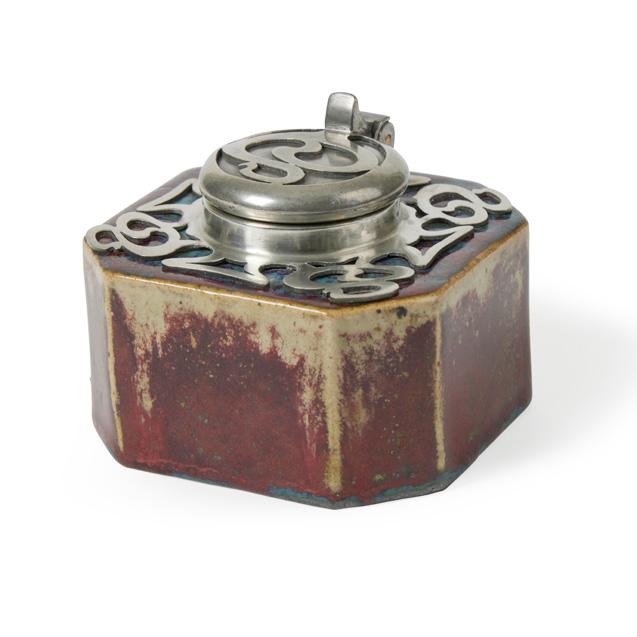
high‑fired glazed stoneware, with pewter lid, signed DALPAYRAT to base
10.5cm wide, 8.5cm high, 10.5cm deep
£500‑800
140
345‡
CAMILLE FAURÉ (1872‑1944) FOR LIMOGES
THREE VESSELS, CIRCA 1930
enamelled metal, comprising a large shallow bowl, miniature vase and small bowl, the former two signed C. FAURE LIMOGES, latter signed C. FAURE LIMOGES FRANCE (3)

27.5cm diameter, 7cm high, and 15.2cm diameter respectively
£600‑800
346Y
MANNER OF JULES LELEU
ART DECO CABINET, CIRCA 1935

stained mahogany, sycamore with line inlay, with ivory escutcheons, interior fitted with adjustable shelves 160cm wide, 150cm high, 43cm deep
Note: Sold in compliance with UK Government and APHA regulations, with (non‑transferable) exemption registration reference BX4JNTB1.
£500‑800
141 Other fees apply in addition to the hammer price: see the ‘Buyer’s Guide’ section on page 2
347
KARL HAGENAUER (1898–1956)
WALL MASK, 1940S
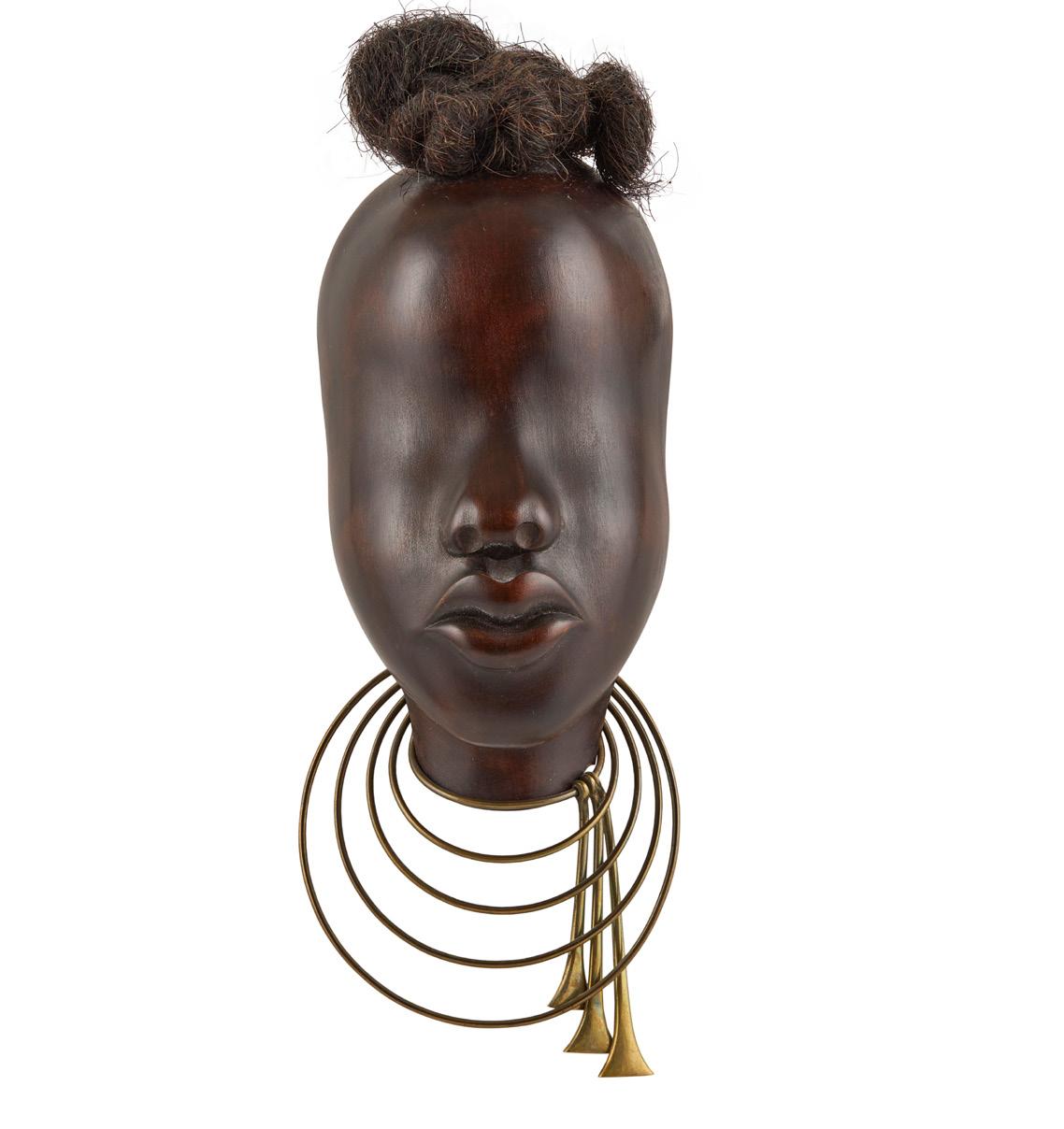
carved wood, bronze, horsehair, stamped verso HAGENAUER WIEN/ MADE IN AUSTRIA
28cm tall
£400‑600
348
JOSEF LORENZL (1892‑1950) FOR GOLDSCHEIDER, AUSTRIA
ART DECO FIGURE, CIRCA 1935
glazed earthenware, printed factory marks, painted artist signature, impressed 7904 27.5cm high
£800‑1,200
349
SANDRO VACCHETTI (1889‑1976) FOR ESSEVI, TURIN
ART DECO FIGURE, CIRCA 1930


glazed ceramic, painted ESSEVI/ N53/ N282, incised LZA (indistinct)
26cm high, 32cm wide
£800‑1,200
350
HELEN CREETH (1859‑1941)
AUSTRALIAN ARTS & CRAFTS BROOCH, CIRCA 1910 sterling silver, porcelain, inscribed to reverse LESCHENAULTIA, W.A., CREETH, the silver rim mount stamped STG. SILVER 5cm diameter
£200‑300
351 §
ASTRID BEGAS (1905‑1997)
DANCER, CIRCA 1950
gilded metal, on a marble base, signed to base of figure A. BEGAS
figure 17cm high; total height 23.5cm £300‑500
142 Other fees apply in addition to the hammer price: see the ‘Buyer’s Guide’ section on page 2
352
JOSEF LORENZL (1892‑1950) (ATTRIBUTED TO)
ART DECO DOUBLE LADY TABLE LAMP, CIRCA 1925 patinated metal, raised on an alabaster plinth and with opaque glass shade
51cm high
£600‑800
353Y
ANTOINE BOURAINE (1886‑1948)
THE SEALION
bronze, ivory, raised on onyx plinth, cast La Stele foundry mark

31cm high
Note: Sold in compliance with UK Government and APHA regulations, with (non‑transferable) exemption registration reference MY7SNAWY.
£600‑800
354
ROYAL DUX
ART DECO FIGURE, CIRCA 1930 painted and glazed earthenware, applied manufacturer’s label, stamped 3103
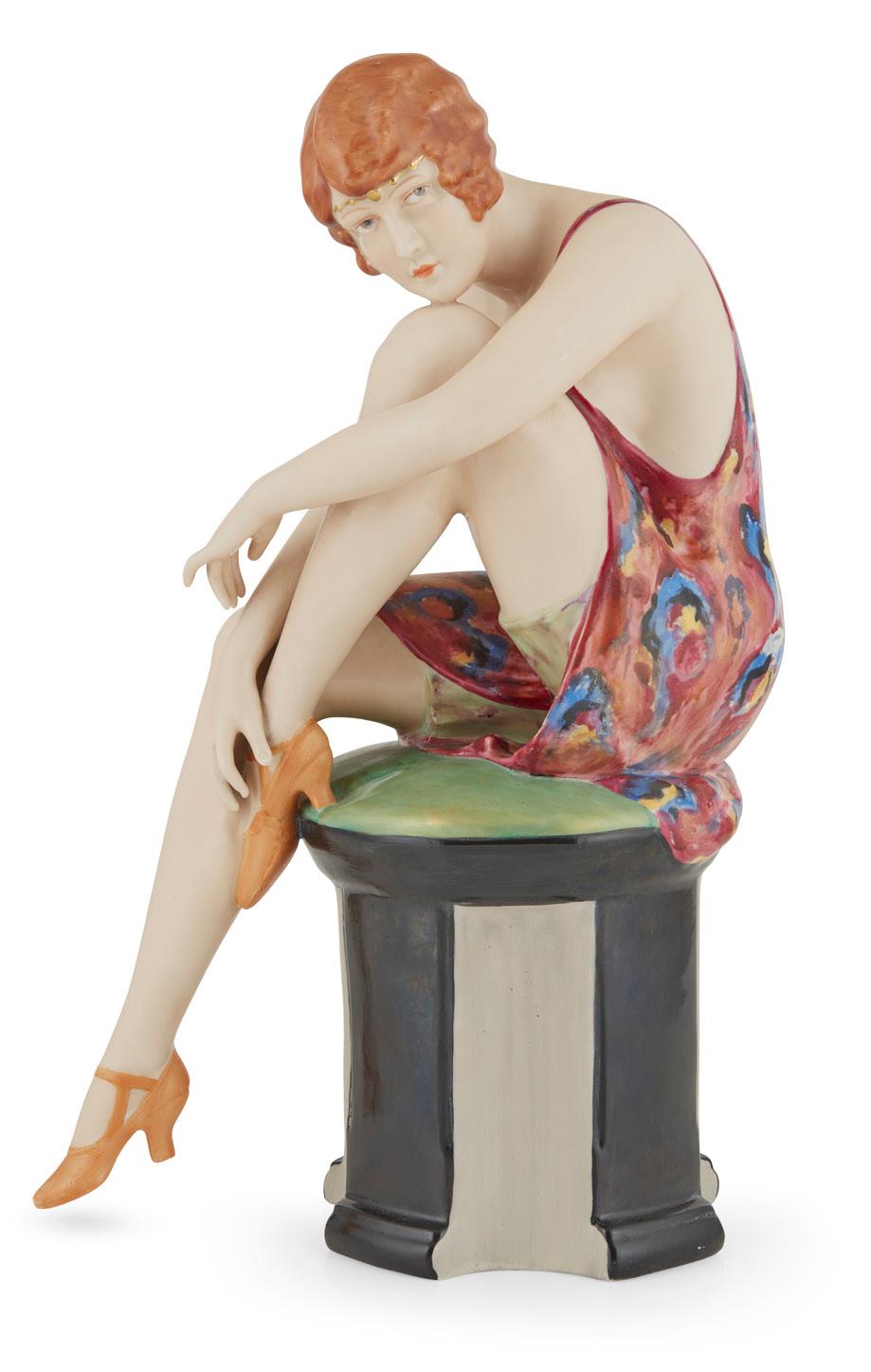
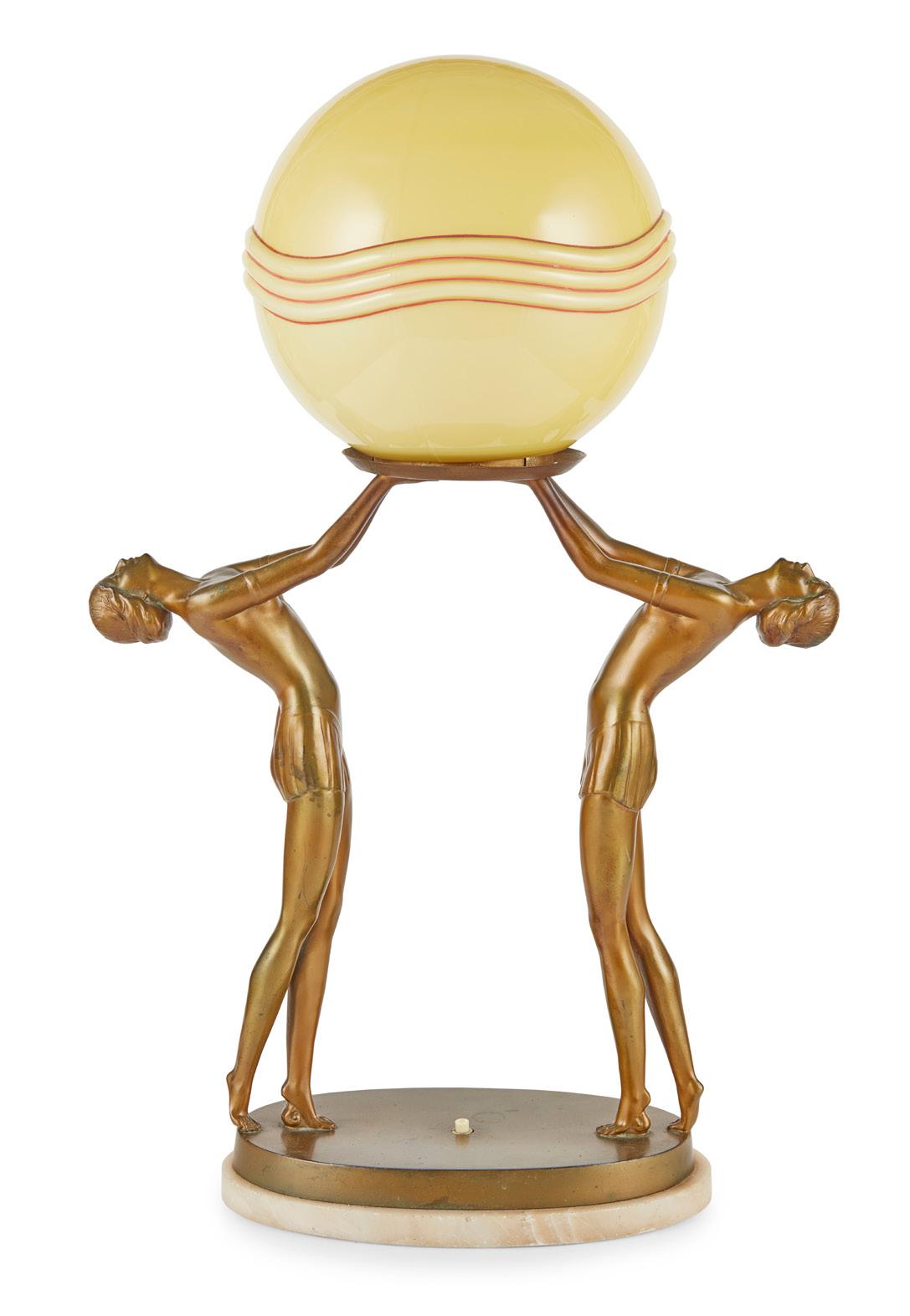
34cm high
£1,500‑2,000
143
CLAIRE HERCZEG (1906‑1997) FOR GOLDSCHEIDER, AUSTRIA ART DECO FIGURINE, CIRCA 1935

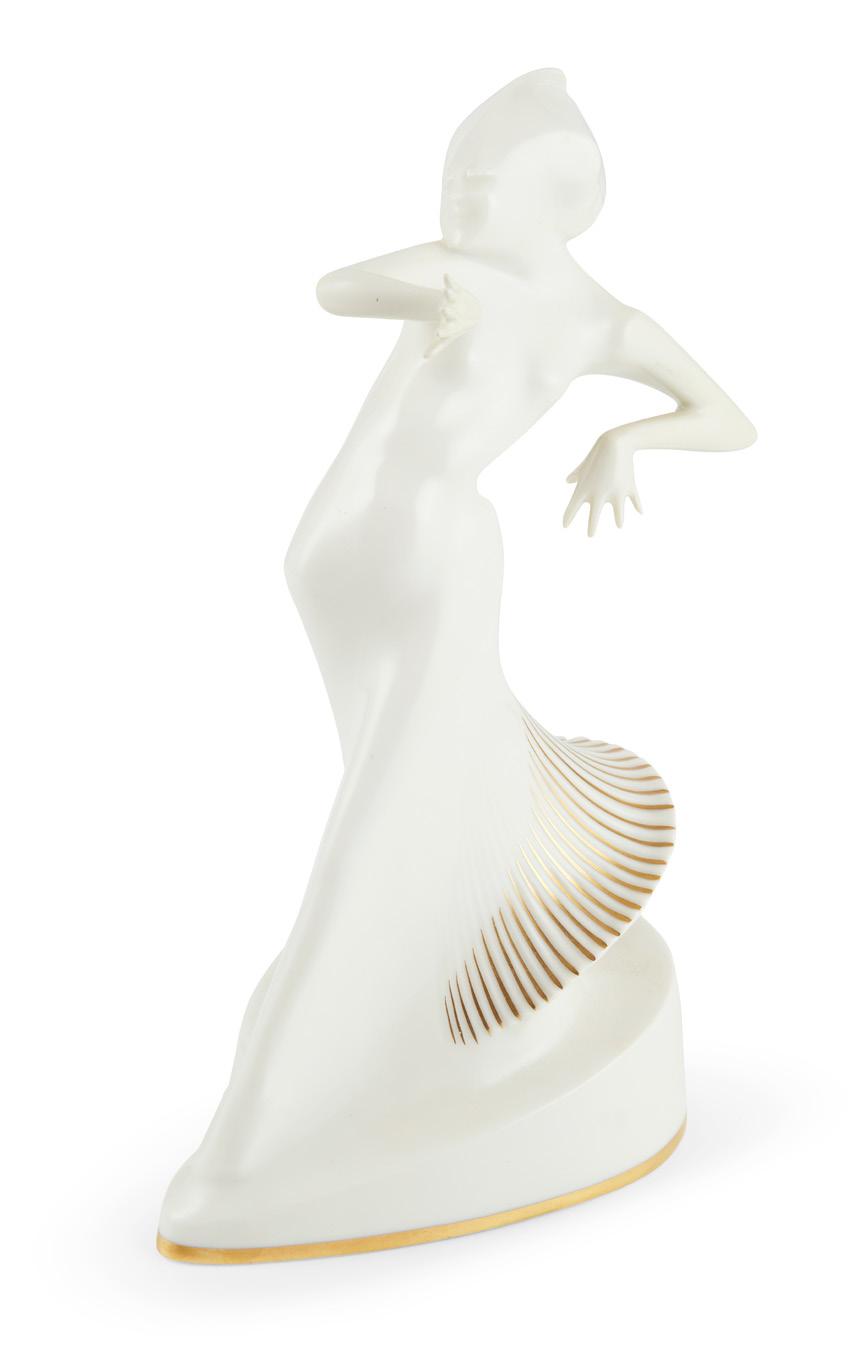
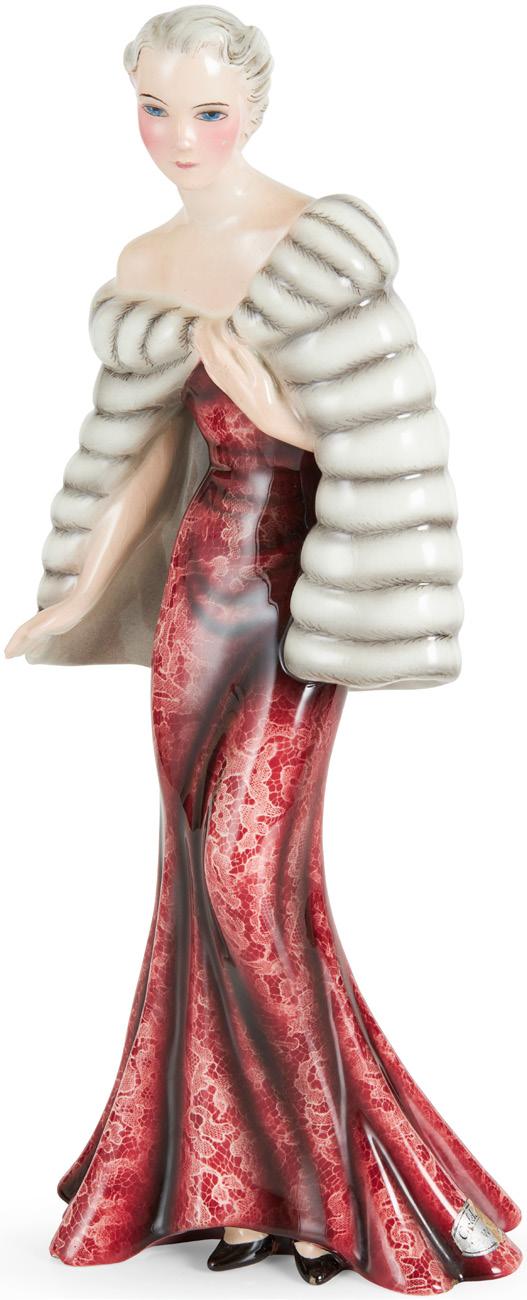

glazed earthenware, traces of applied maker’s label, printed factory marks and artist signature, impressed 8204/ 177/ 10
31cm high
£500‑700
356
THEO A. VOS (1887‑1948)
FOR HUTSCHENREUTHER A.G. DANCER, CIRCA 1925
glazed porcelain, with gilded highlights, printed factory and maker’s marks, gilded number 56 28cm high
£600‑800
357
CONTINENTAL, MANNER OF KOLOMAN MOSER PAIR OF ART NOUVEAU CABINET DOORS, CIRCA 1910
stained and leaded glass, within pitch pine frames (2) Including frame 137cm x 83.5cm £300‑500
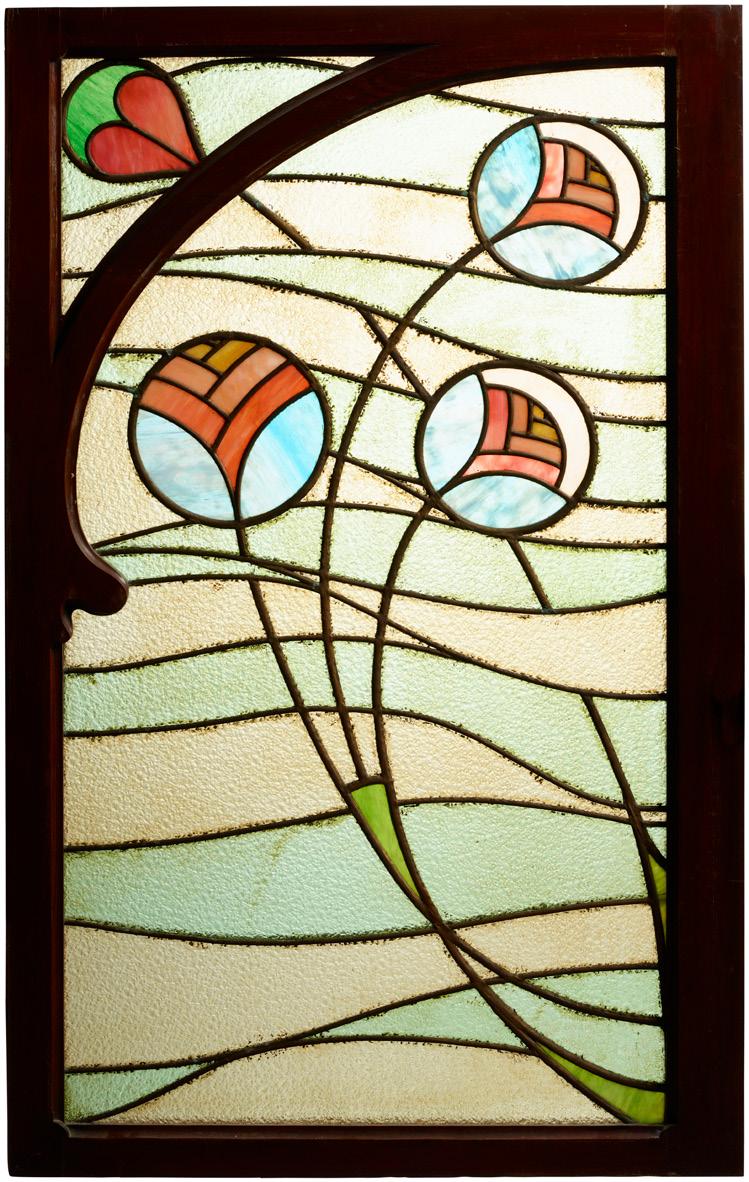
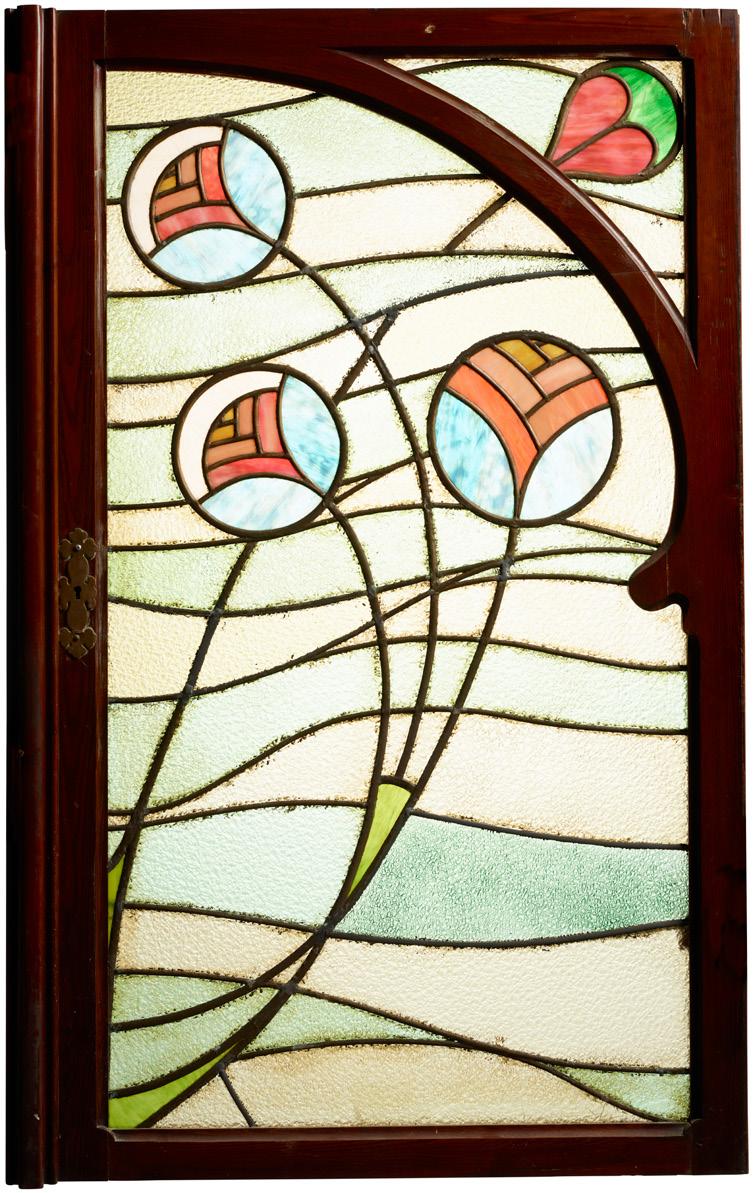


358
GUSTAV HAUBER BRACELET, CIRCA 1900
white metal, set with turquoise cabochons, stamped maker’s mark/ 800 approx. 18cm long
£250‑350
144

145
359 §
ASHLEY HAVINDEN (1903–1973)
ART DECO CARPET, CIRCA 1930
hand‑knotted wool, bears applied label verso
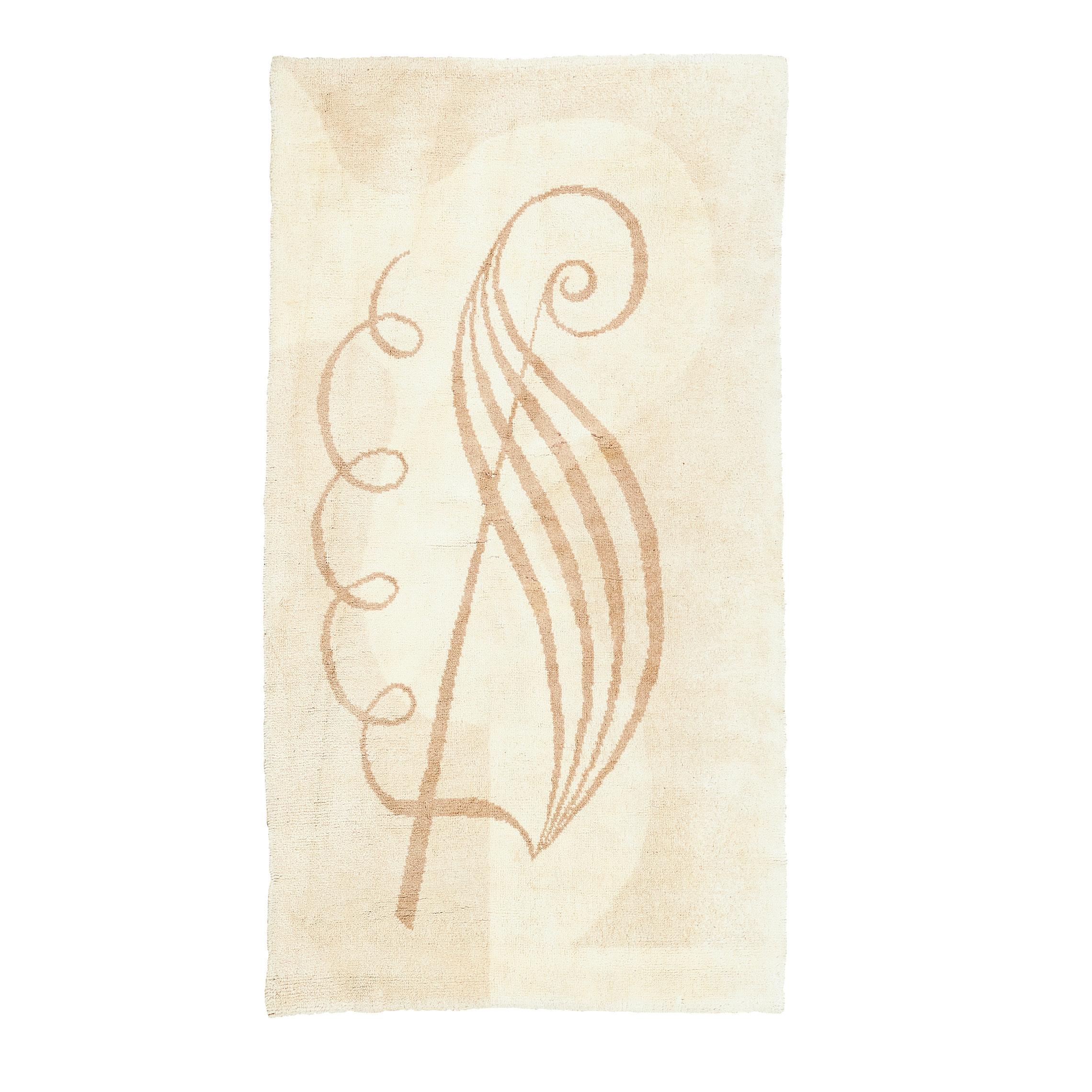
245cm x 152cm
Note: Ashley Havinden was a painter, typographer, graphic and textile designer. In 1922, when he joined W.S. Crawford – one of London’s largest advertising agencies – he had not received any formal art training. He subsequently took evening classes in design and drawing at Central School of Arts & Crafts (1922‑23) and received private drawing lessons from Henry Moore in 1933. The London Gallery held Havinden’s first solo exhibition in 1937. Two years later he was one of the nine British artists to feature in an exhibition of abstract paintings held at the Lefevre Gallery. He remained with W.S. Crawford for forty‑five years becoming art director in 1929 and vice‑chairman in 1960. During this time, Havinden was given full freedom to develop his distinctive style, working on campaigns for Martini, Liberty’s and Chrysler, amongst others. Meanwhile, he produced rug and textile designs for Duncan Miller Ltd and Edinburgh Weavers. For the V&A’s 1946 exhibition Britain Can Make It, he designed the Men’s Wear displays, as well as the exhibition catalogue cover. Havinden received an OBE for his services to British Design in 1951.
£2,000‑3,000
146
360 §
CHARLES D’ORVILLE PILKINGTON JACKSON (1887‑1973)
‘DAWN’, 1925
bronze, signed and dated in the bronze PILKINGTON JACKSON/ 1925, raised on a stepped slate plinth 63cm high, 76cm high including plinth Provenance: Stanley Cursiter and by descent
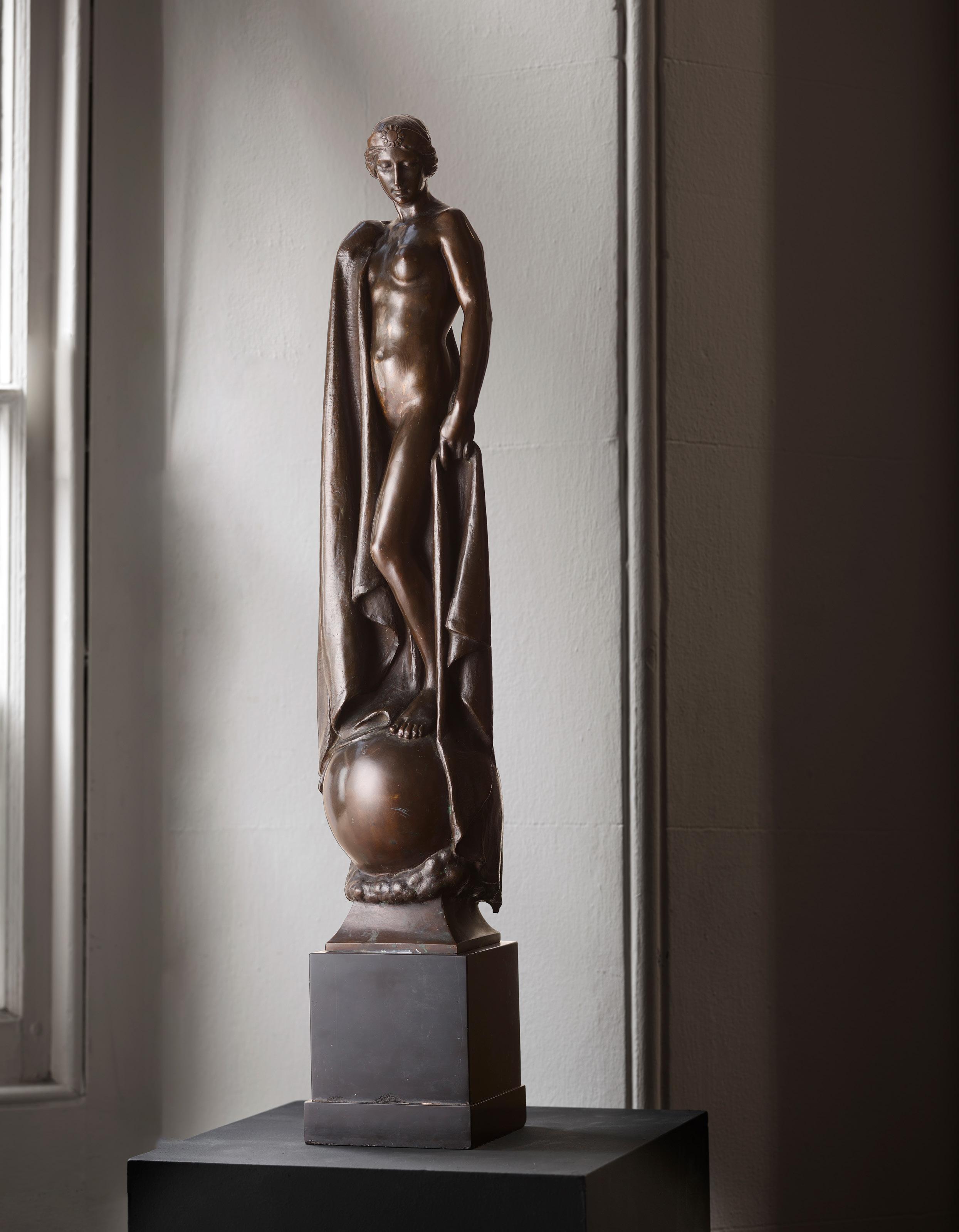
Note: The sculptor Charles Pilkington Jackson set up his first studio in 1912 with the founder William McDonald. Commissions included collaborations with Sir Frank Mears and Sir Robert Lorimer. After the First World War, he set up on his own at 12, Church Lane, Edinburgh (now Gloucester Lane).
During the 1920s Pilkington Jackson principally worked on memorials, among these the Elsie Inglis Memorial with Sir Frank Mears in 1922 and the Alloa War Memorial with Sir Robert Lorimer in 1925. He also produced some portraiture and allegorical work during this period including the current lot. ‘Dawn’ was cast by McDonald and Creswick between July 24th and March 1925, and the orb of the sun was cast separately. The marble base was supplied by Galbraith and Winton. Never on the open market before now this is the only example of this figure known to have been cast. The figure was given by Pilkington Jackson to the Orcadian artist Stanley Cursiter, in exchange for two oil paintings which the artist produced of Pilkington Jackson’s studio at 12, Church Lane.
The work of Carl Milles was an important influence on Pilkington Jackson, who visited the Swedish sculptor in 1929. After the Second World War, he continued to work, his career culminating in the monumental sculpture The Bruce at Bannockburn, cast in 1964.
£6,000‑8,000
147
361
SYBIL DUNLOP (ATTRIBUTED DESIGNER)
BAR BROOCH
white metal, set with chrysoprase and pink quartz cabochons, 7.5cm long; together with a PAIR OF EARRINGS, white metal set with chrysoprase and pink quartz cabochons, stamped SILVER, 2.5cm diameter; and a further PAIR OF EARRINGS, white metal, set with coloured stones, 1.1cm diameter (5)

£250‑350
362
KATE EADIE (ATTRIBUTED DESIGNER)
ARTS & CRAFTS BAR BROOCH, CIRCA 1900
white metal, set with oval and cushion‑cut amethysts
7.2cm long
£300‑500
363
BERNARD INSTONE (1891‑1987) (ATTRIBUTED TO)
THREE PIECES OF JEWELLERY, CIRCA 1920
comprising a RING, silver set with an amethyst stone, size N/O; a FURTHER RING, white metal, set with an amethyst stone, size L; and a CLIP BROOCH, white metal, set with synthetic rubies and sapphires, 4cm long (3)


£250‑350

364
DORRIE NOSSITER (1893‑1977)
NECKLACE, CIRCA 1930
white metal, the clasp set with citrines, to a strand of rose quartz and hardstone beads

47cm long
£400‑600
148
365
CHARLES VYSE (1882‑1971)
‘THE SLEEPER AWAKES’, CIRCA 1931 painted and glazed pottery, incised C. VYSE/ CHELSEA
30.5cm high
£700‑1,000
366
CHARLES VYSE (1882‑1971)
‘THE MACAW’, A CHELSEA POTTERY FIGURE, INTRODUCED IN 1923 painted pottery, painted maker’s marks under base CV/ CHELSEA/ ENGLAND/ 1924

33cm high
£800‑1,200
367
CHARLES VYSE (1882‑1971)
FIGURE OF A PANTHER, CIRCA 1930



glazed stoneware, incised CHARLES VYSE/ CHELSEA
24.5cm high
£250‑350
149 Other fees apply in addition to the hammer price: see the ‘Buyer’s Guide’ section on page 2
371
STELLA
368
STELLA R. CROFTS (1898‑1964)
FIGURE OF A CLOUDED LEOPARD, CIRCA 1925 glazed terracotta, incised STELLA R. CROFTS, painted DEERSBANK/ NORSEY WOOD/ BILLERICAY/ LOCAL CLAY

10cm high
£250‑350
369
STELLA R. CROFTS (1898‑1964)
‘AMERICAN BISON’, DATED 1925 unglazed stoneware, incised S.W./ S.G./ STELLA R. CROFTS/ 1925/ AMERICAN BISON
14cm high
£250‑350
17cm high
£250‑350
370 §
CLARISSE LEVY‑KINSBOURG (1896‑1959)
BUST OF A GIRL

terracotta, signed CLARISSE LEVY/ KAZAL FRANCE
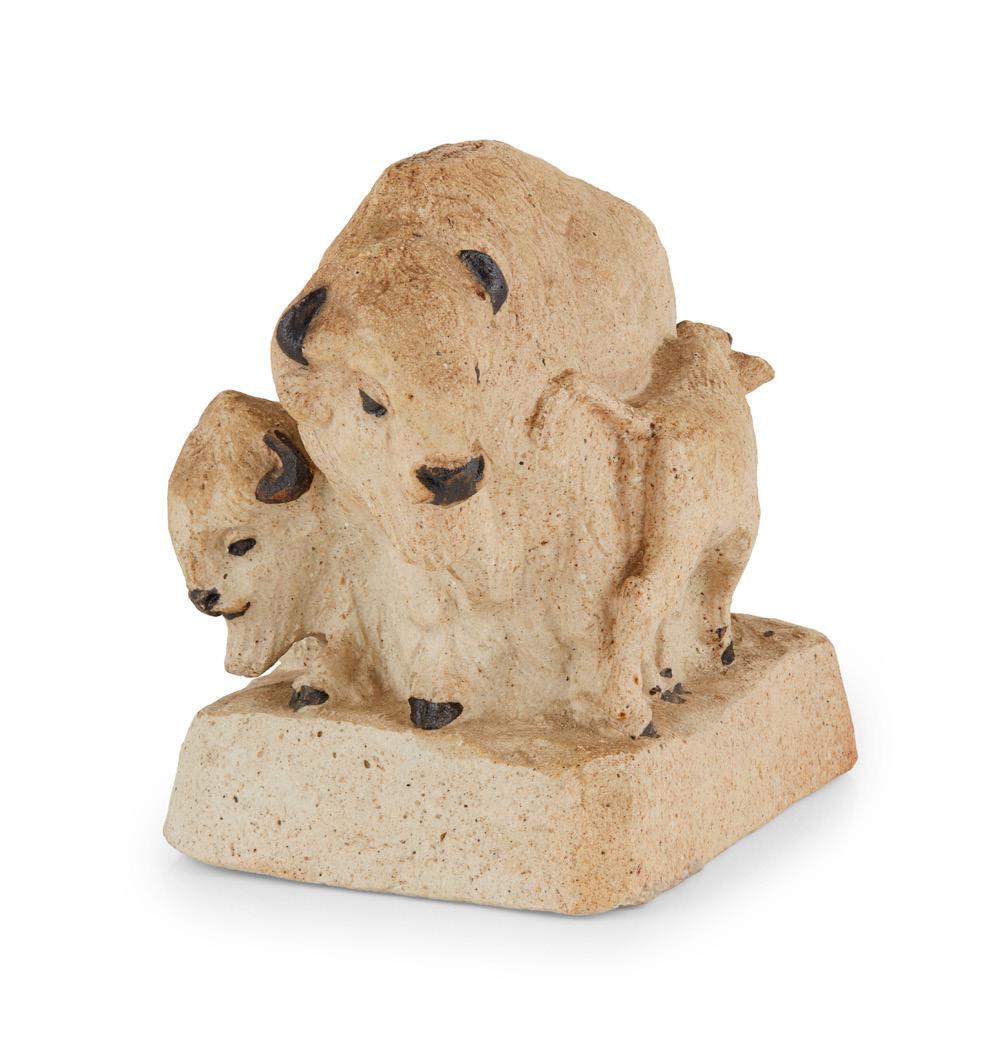
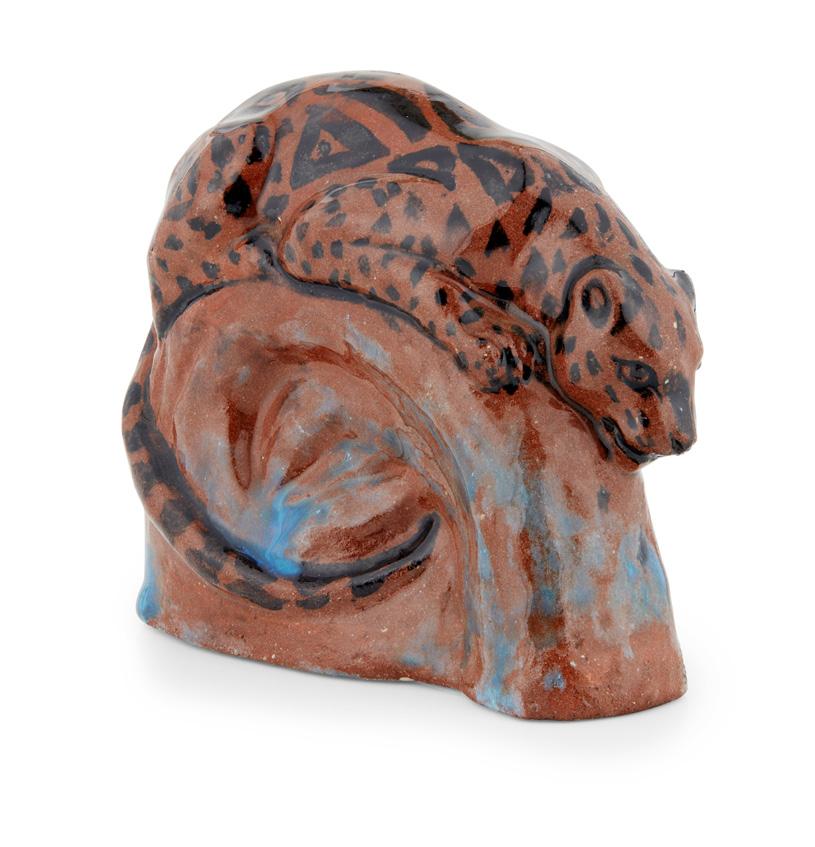
34.5cm high
£300‑500
R. CROFTS (1898‑1964)
FIGURE OF A FOX, CIRCA 1925 glazed stoneware, incised STELLA R. CROFTS
150 Other fees apply in addition to the hammer price: see the ‘Buyer’s Guide’ section on page 2
373
ENGLISH ART DECO TIERED OCCASIONAL TABLE, CIRCA 1930
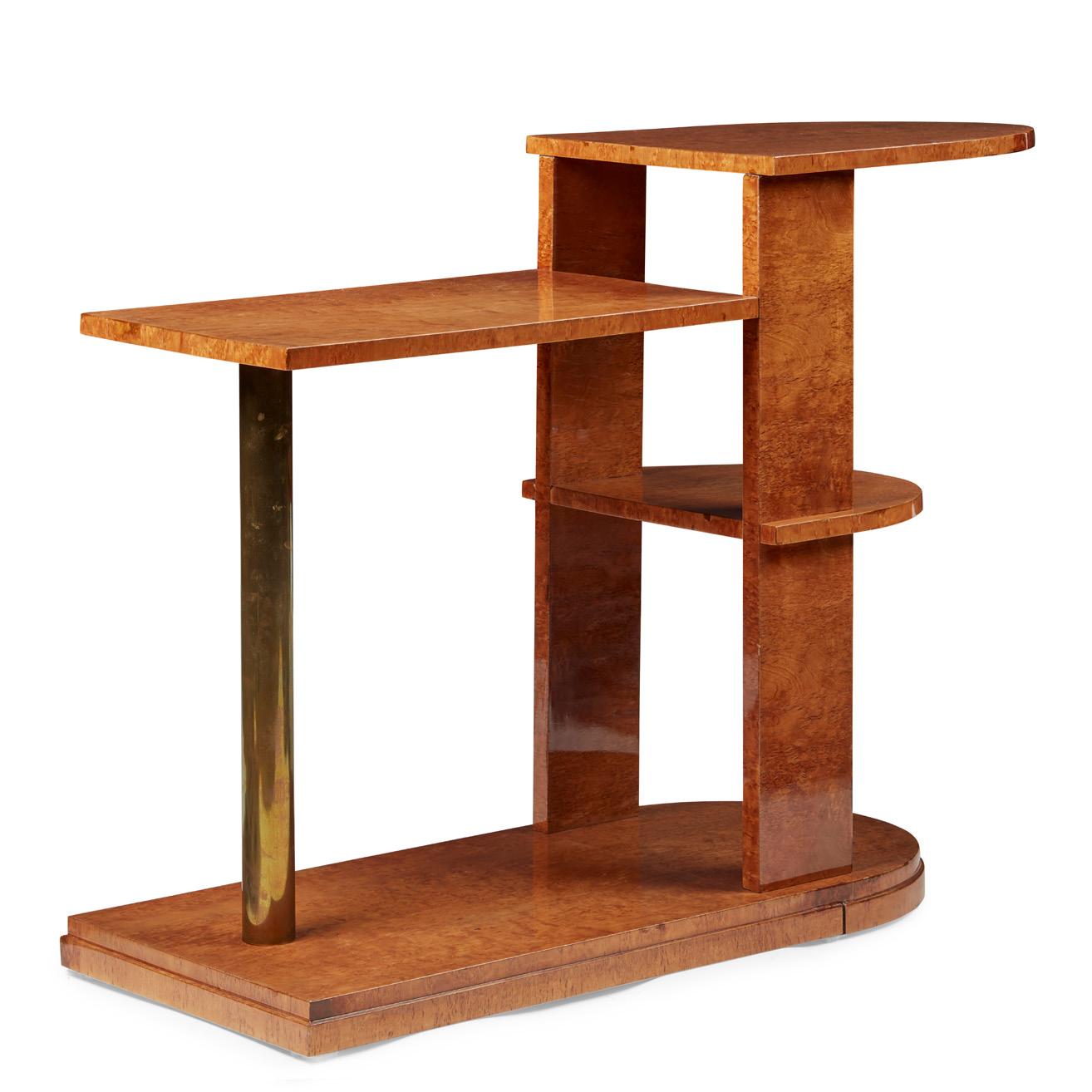
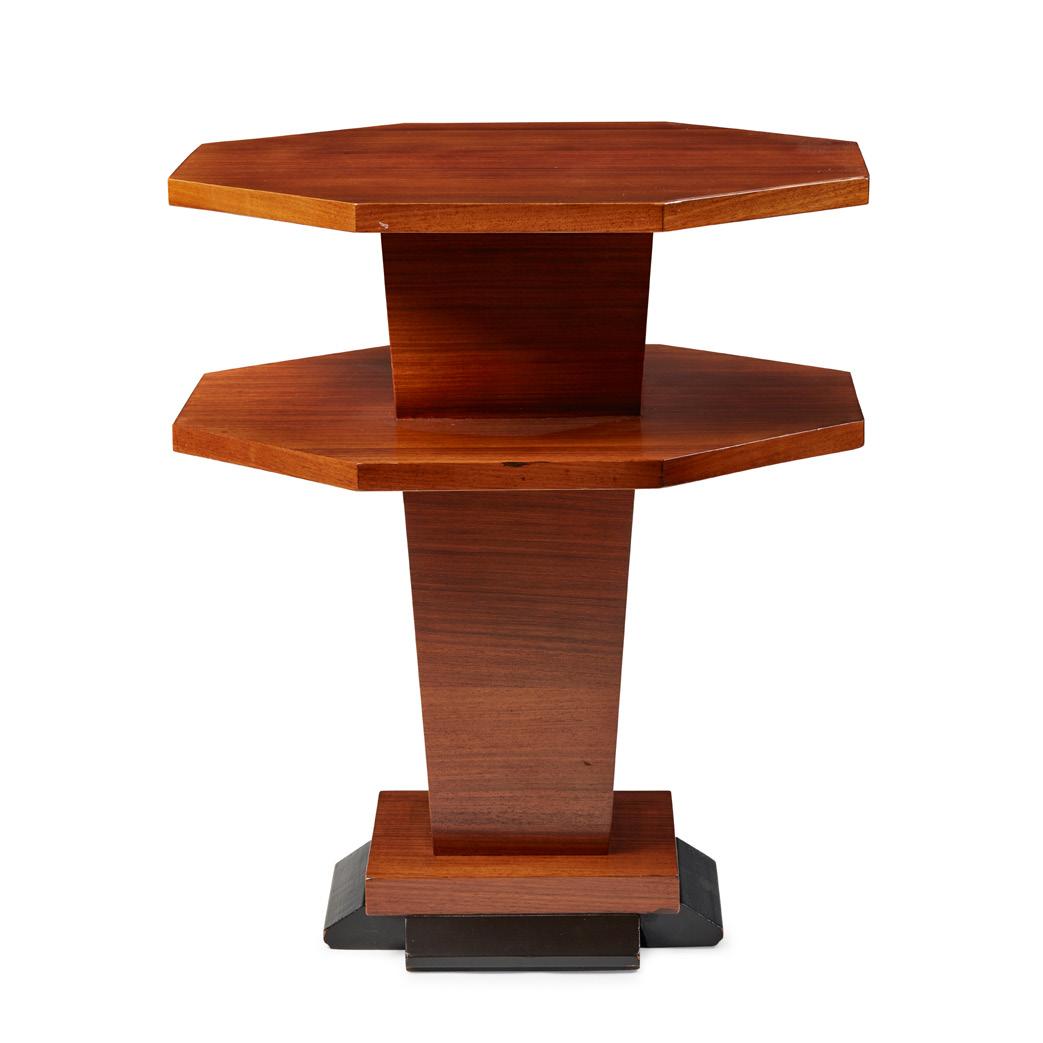
walnut and ebonised wood
60cm across, 70cm high
£300‑500
374
ENGLISH ART DECO TIERED TABLE, CIRCA 1930
burr walnut veneer and brass
86cm wide, 80cm high, 40cm deep
£400‑600
372 §
SIR
WILLIAM REID DICK (1878‑1961)
‘CONTROLLED ENERGY’; PAIR OF FIGURES, CIRCA 1930 bronze, mounted on green marble plinths as book ends (2) 11cm high, 9cm wide, 12.7cm deep excluding base, 12.5cm high, 10.5cm wide, 16.5cm deep including base



Note: The Art Deco headquarters for the Unilever Group, Unilever House was built in 1930‑31 to a design by J. Lomax‑Simpson with Burnet, Tait and Lorne. The building is noted for its monumental facade, mounted with a large pair of statues by Sir William Reid Dick entitled ‘Controlled Energy’. Other artists involved in the project included Eric Gill and Gilbert Ledward. These rare figures by Reid Dick are reductions of the figures on the facade. At the inauguration of Unilever House on 18 July 1932, a pair of small models of these groups in bronze, designed to form book ends were presented to the Lord Mayor and Lord Leverhulme. Another pair, the only other known apart from the current lot, is now in a London private collection.
£1,000‑1,500
151
375 HEAL & SON, LONDON WRITING DESK, CIRCA 1931


mahogany, with brass fittings, with original pencil design
108.5cm wide, 101cm high, 62.5cm deep
Note: The original pencil design for this desk, with instructions on how to open the secret drawers and dated 1931 is stuck to the inside of the central drawer. In addition, early Heal’s label included with this lot, registration number R. 4759 £2,000‑3,000
152
376
ENGLISH
TWO BOOKS OF FASHION SKETCHES, 1927
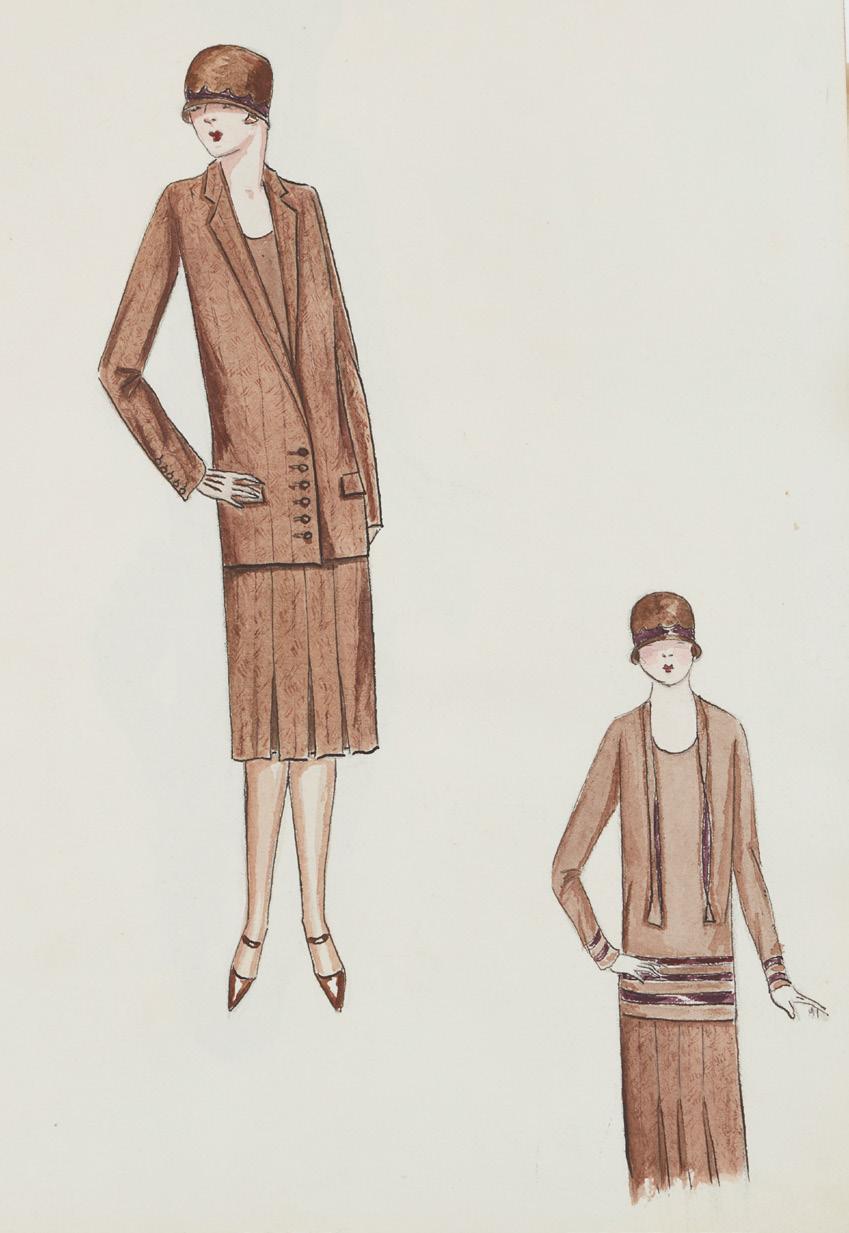
watercolour, pencil and mixed media, the first with 30 sheets, each with single designs, 14 sheets have works verso (44 works in total, with 2 inserts), one inscribed in pencil Mrs P Carter Act II, another inscribed Mrs Whitty Act 1., contained in a date embossed canvas bound Windsor and Newton series 26 sketchbook, with a printed stamp to the cover Spring 1927; the second with 27 sheets, each with single designs, 7 sheets with works verso (34 drawings, with 3 inserts), within canvas bound Windsor and Newton series 26 sketchbook, with a printed stamp to the cover Autumn 1927, 29.3 x 22.9 cm (2)
Provenance: Cecil Beaton
£400‑600
377
CLARICE CLIFF (1899‑1972)
‘MELON’ (‘PICASSO FRUIT’) PATTERN PLATE, CIRCA 1930 glazed earthenware, printed ‘BIZARRE’ and factory marks 34cm diameter

£200‑300
378
HARRY & LOU EPSTEIN, LONDON
ART DECO ‘CLOUD’ ARMCHAIR, CIRCA 1935

later white leather upholstery, with burr walnut inlay
74cm wide, 82cm high, 68cm deep
£400‑600
379
ENGLISH
ART DECO WALL CLOCK, CIRCA 1935
chrome‑plated and patinated metal, glass
25.5cm x 29cm
£200‑300
153 Other fees apply in addition to the hammer price: see the ‘Buyer’s Guide’ section on page 2
380
ALFRED POWELL (1865‑1960) FOR WEDGWOOD
VASE, CIRCA 1925
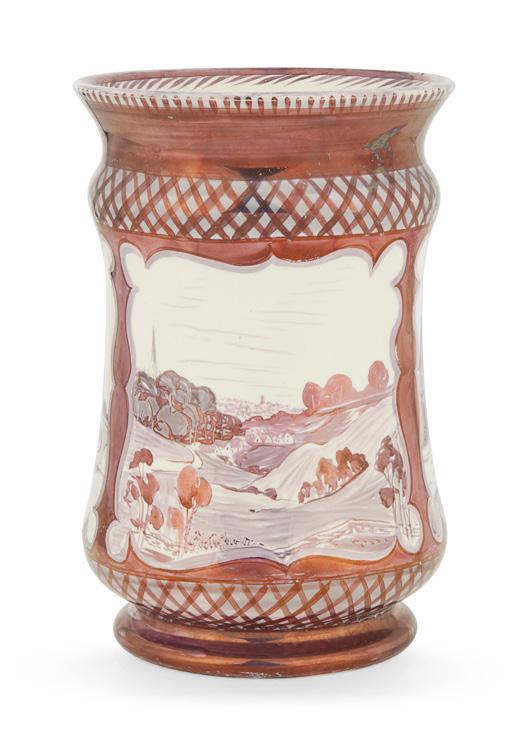
lustre‑glazed earthenware, painted with views of Tetbury, Gloucestershire, painted lustre monogram/ 3497, impressed WEDGWOOD/ MADE IN ENGLAND
20.5cm high
£300‑500
381
HEAL & SON, LONDON
ARTS & CRAFTS ‘465’ TABLE, CIRCA 1900

oak
121.5cm wide, 118cm extended, 74.5cm high
Literature: Heal, Oliver S. Sir Ambrose Heal and the Heal Cabinet Factory 1897‑1939, Unicorn, 2014, p. 167 where a line drawing for a similar example is illustrated.
£400‑600
382
GORDON RUSSELL (1892‑1980)
DRESSING TABLE, CIRCA 1930
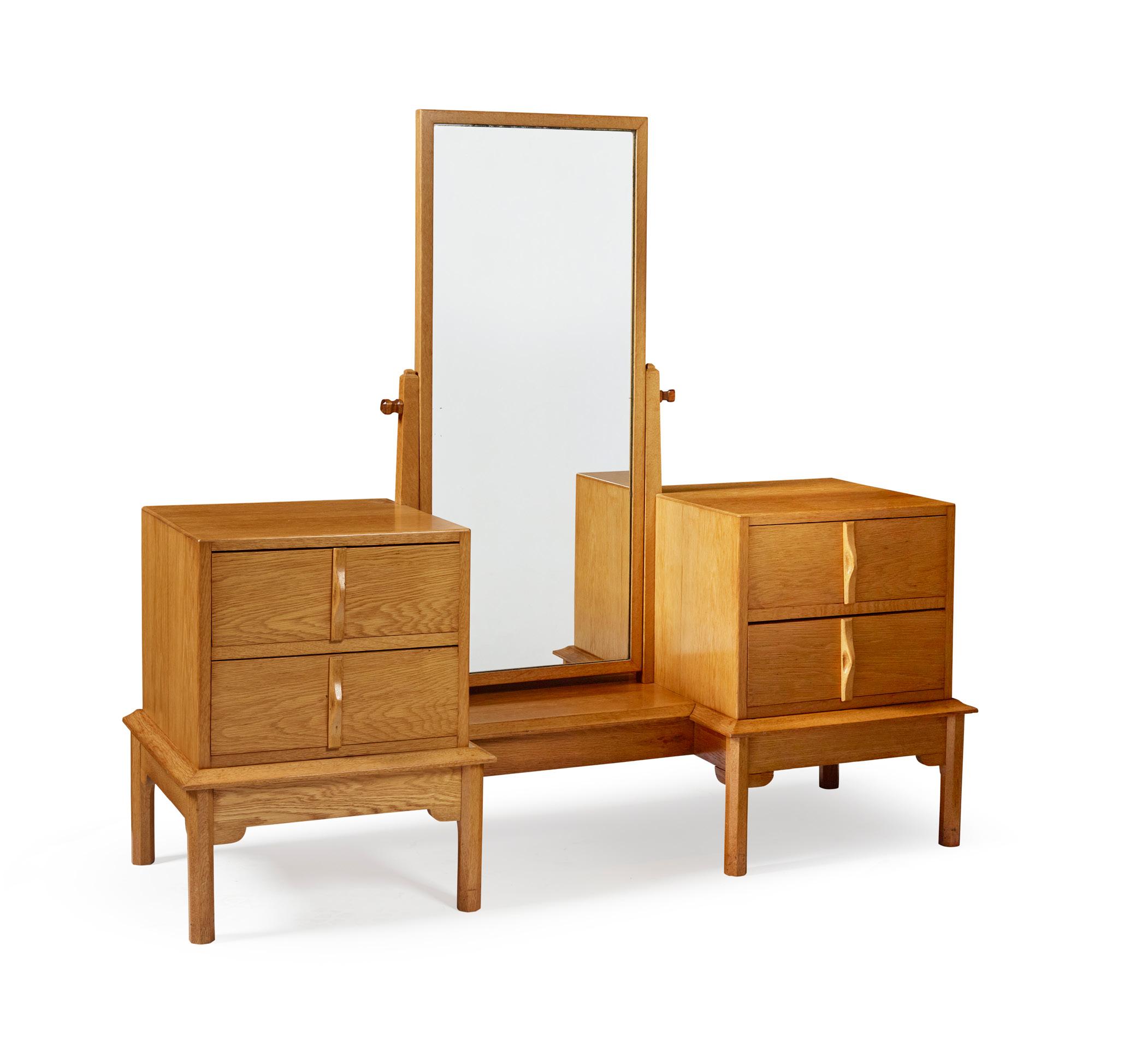
oak, with mirror plate 143cm wide, 135.5cm high, 48cm deep
£1,200‑1,800
154 Other fees apply in addition to the hammer price: see the ‘Buyer’s Guide’ section on page 2
383
ALFRED POWELL (BRITISH 1865‑1960) FOR WEDGWOOD FOOTED BOWL & COVER, CIRCA 1920
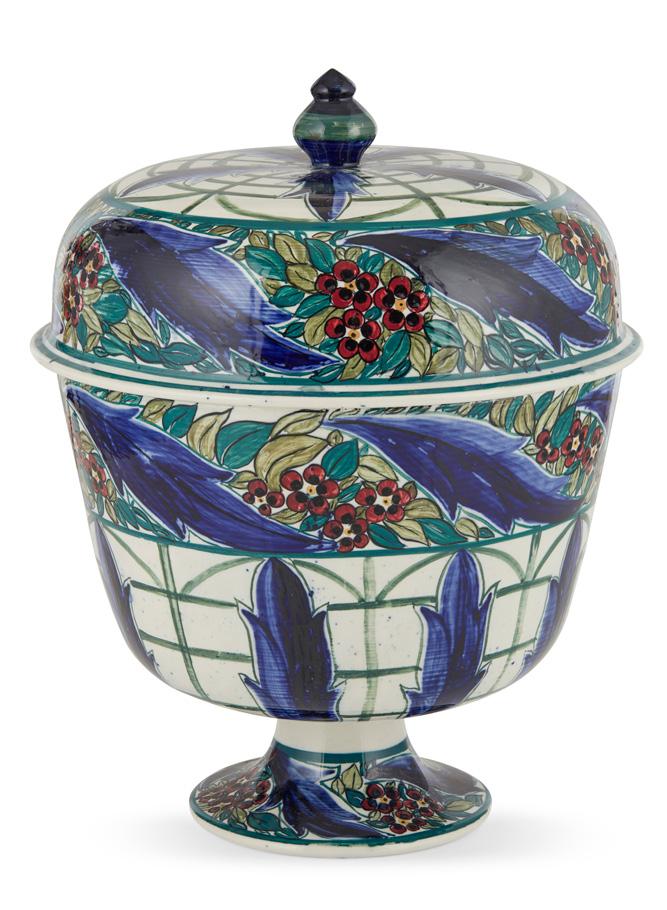
painted and glazed earthenware, impressed WEDGWOOD
30cm high
£500‑800
384
ROBERT WEIR SCHULTZ INTEREST
DROP LEAF ARCHITECTS TABLE, CIRCA 1920

walnut
closed 85cm wide, 74cm high, 106cm deep, open 151cm wide
Note: By repute, this table came from the offices of the Arts and Crafts architect, artist, landscape designer and furniture designer Robert Weir Schultz (1860–1951)
£500‑800
385
COTSWOLDS SCHOOL
ARTS & CRAFTS DROP‑LEAF TABLE, CIRCA 1910
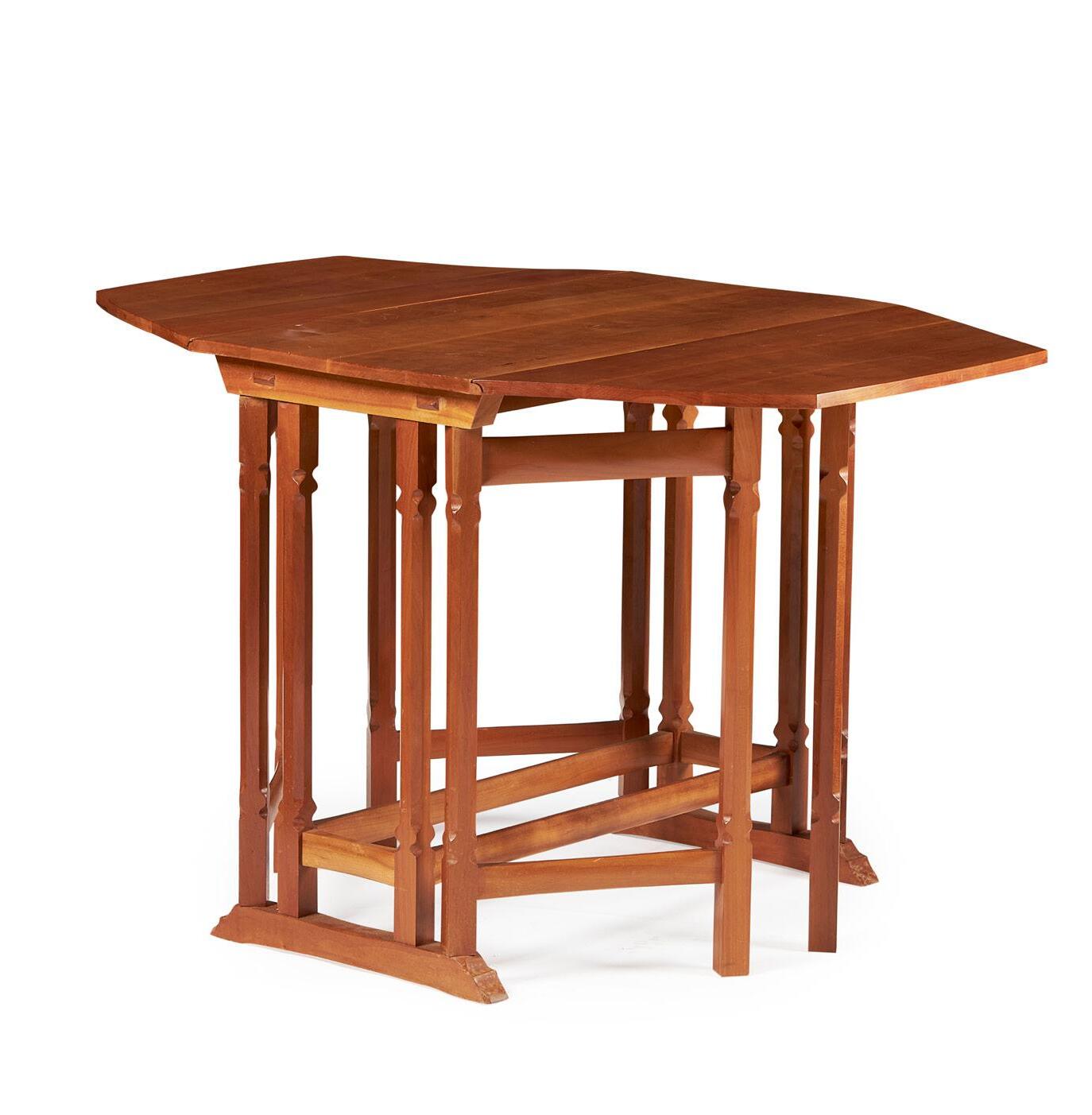
maple
Open 106.5cm across, 68.5cm high, 76cm deep; closed 43cm across £400‑600
386
ENGLISH
ARTS & CRAFTS TOILET MIRROR, CIRCA 1900
oak, with mirrored glass plate
70cm wide, 54.5cm high, 25cm deep
£200‑300
155
CHARLES
VYSE (1882‑1971)
TWO VASES, 1930S

glazed stoneware, each incised
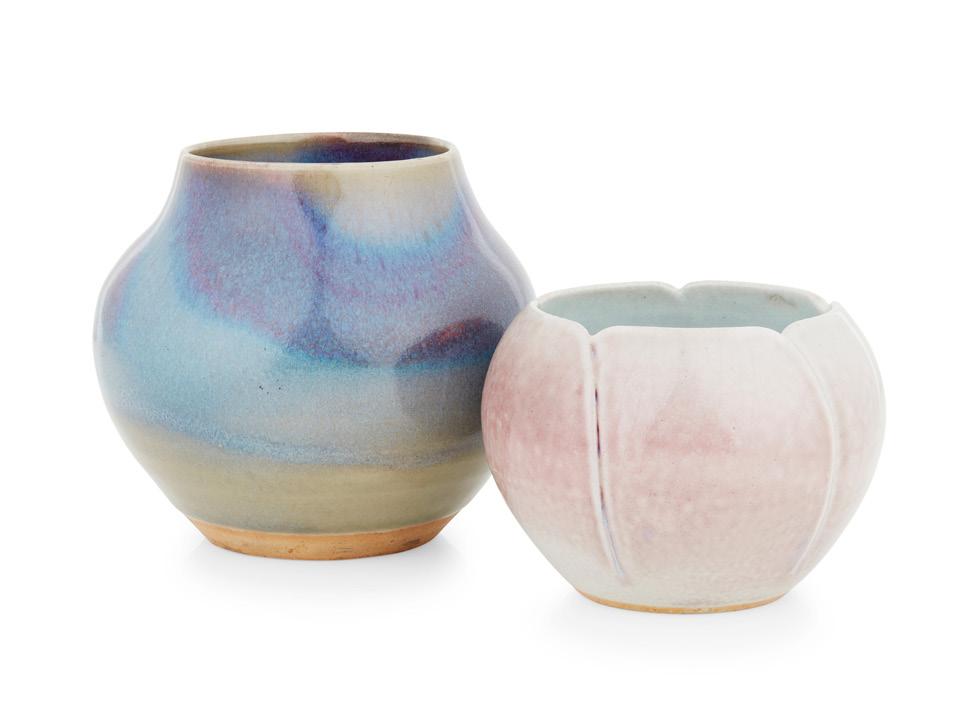
C. VYSE/ CHELSEA (2)
11.5cm and 8cm high
£250‑350
PILKINGTON’S TILE & POTTERY CO.
TWO VASES, CIRCA 1910
glazed earthenware, impressed factory mark (2)
26cm high and 23cm high
£250‑350
ENGLISH, MANNER OF HEAL & SON, LONDON PAIR OF SMALL BOOKCASES, CIRCA 1930

limed oak, with glazed doors (2) 46cm wide, 103.5cm high, 20cm deep
£400‑600
388
389
387
156
390
CHARLES NOKE (1858‑1941) AND HARRY NIXON (1886‑1955) FOR ROYAL DOULTON
‘CHANG’ MINIATURE VASE, CIRCA 1930

flambé‑glazed earthenware, painted NOKE/ HN/ CHANG/ ROYAL DOULTON

9cm high
£250‑350
391
CHARLES NOKE (1858‑1941) FOR ROYAL DOULTON
‘SUNG’ VASE, CIRCA 1925
flambé‑glazed earthenware, painted SUNG, with printed factory mark
14.5cm high
£250‑350
392
BERNARD MOORE (1850‑1935)
HIGH‑FIRED VASE, CIRCA 1910

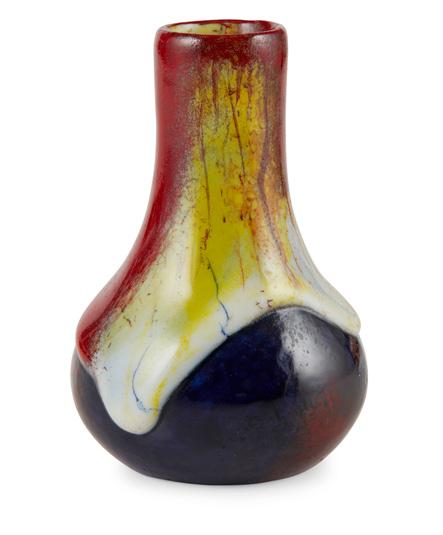
glazed earthenware, painted BERNARD
MOORE/ E6, impressed 1170
15cm high
£250‑350
393
HEAL & SON, LONDON
ARTS & CRAFTS OCCASIONAL TABLE, CIRCA 1920

oak, applied makers label and branded serial number
63cm diameter, 51cm high
£300‑500
394 Y
RUSKIN POTTERY
POT POURRI BOWL AND COVER, CIRCA 1910
lustre‑glazed earthenware, ivory
18.3cm diameter, 18cm high
Note: Sold in compliance with UK Government and APHA regulations, with (non transferable) exemption registration reference GW6KTZUX.
£200‑300
157 Other fees apply in addition to the hammer price: see the ‘Buyer’s Guide’ section on page 2
NEVILLE NEAL (1925‑2000), AFTER ERNEST GIMSON
ROCKING CHAIR, CIRCA 1920
oak, with rush seat

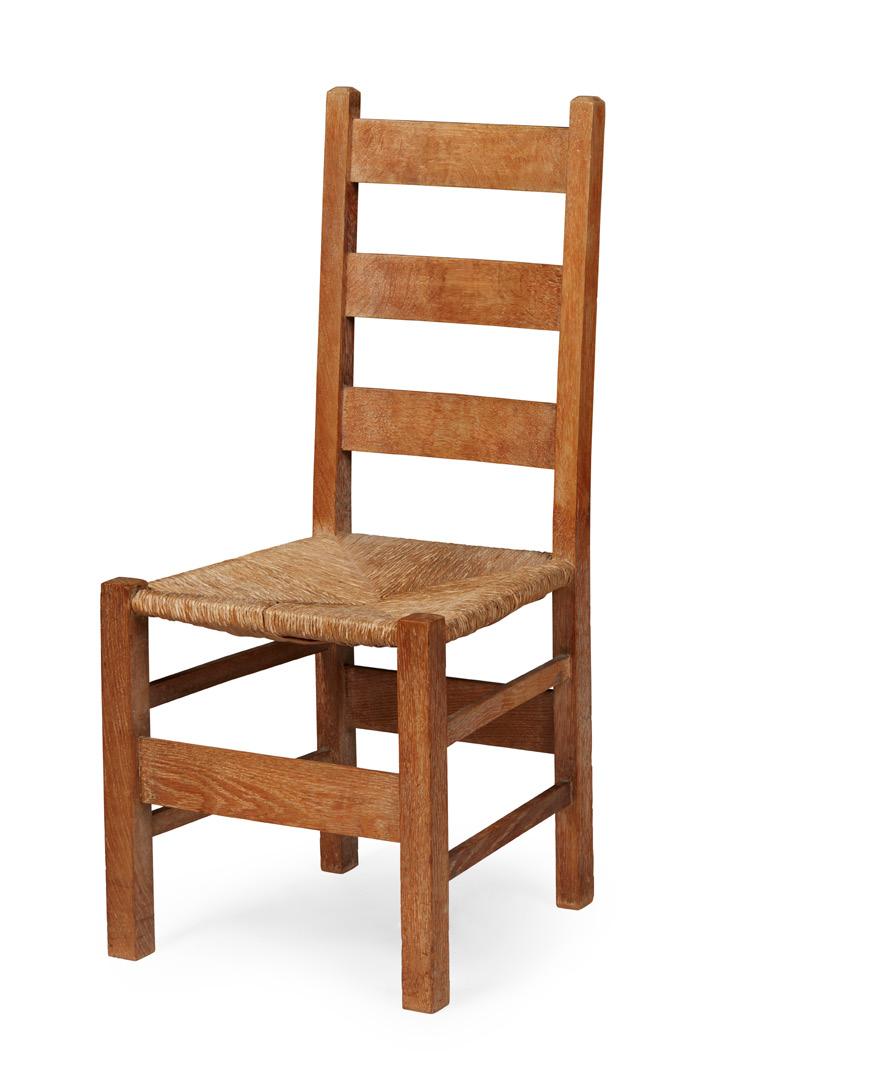
53.5cm wide, 109cm high, 67cm deep £600‑800
PAIR OF COTSWOLD SCHOOL BOOKCASE

CABINETS, CIRCA 1920
oak, with macassar ebony handles (2)

40.5cm wide, 156cm high,
397
HEAL & SON, LONDON
BEDROOM SUITE, CIRCA 1930
oak, comprising a WARDROBE, oak, 91cm wide, 183cm high, 51cm deep; a DRESSING TABLE, oak with mirrored plate, 92cm wide, 142cm high, 47cm deep; a ‘952’ SIDE CHAIR, with rush seat, 40cm wide, 91cm high, 42.5cm deep; an OCCASIONAL TABLE, 41cm square, 69cm high; a STOOL, 52cm wide, 61cm high, 28cm deep; and TWO SINGLE BEDS, headboards (including modern divan mattresses and bases) 91cm wide, 105cm high; footboards 91cm wide, 67cm high (7)
Literature: Heal, Oliver S. ‘Sir Ambrose Heal and the Heal Cabinet Factory 1897‑1939’, Unicorn, 2014, p.247 where a line drawing for the ‘952’ chair is illustrated.
£1,200‑1,800

395
158 Other fees apply in addition to the hammer price: see the ‘Buyer’s Guide’ section on page 2
398
JOHN MONCRIEFF LTD., PERTH ‘MONART’ VASE, CIRCA 1930 glass, with aventurine inclusions
21.5cm high
£300‑500
399
JOHN MONCRIEFF LTD., PERTH ‘MONART’ VASE, CIRCA 1930 glass, with aventurine inclusions, 20cm high; together with a SHALLOW DISH, 31cm diameter (2)
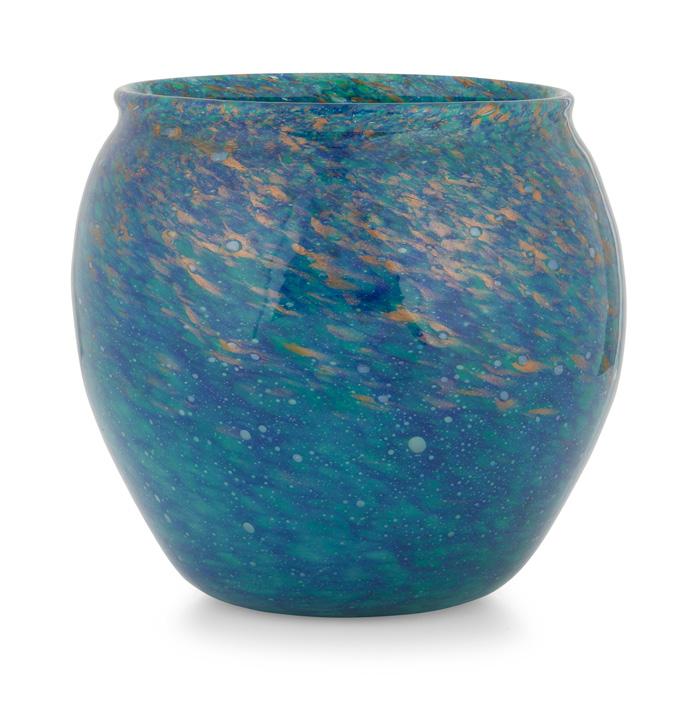
£300‑500
400
JOHN MONCRIEFF LTD., PERTH TWO ‘MONART’ VASES, CIRCA 1930 glass, with polychrome inclusions, one with traces of original paper label V1 A.187, each 19cm high; together with a SHALLOW DISH, 32.5cm diameter (3)


£300‑500
401
SIR ROBERT LORIMER (1864‑1929) (ATTRIBUTED DESIGNER) FOR SCOTT MORTON & CO., EDINBURGH
ARTS & CRAFTS THRONE CHAIR, CIRCA 1910 oak, carved with a design of the burning bush, bears a maker’s label under the seat rail SCOTT MORTON AND TYNECASTLE CO. LTD, MURIESTON ROAD EDINBURGH
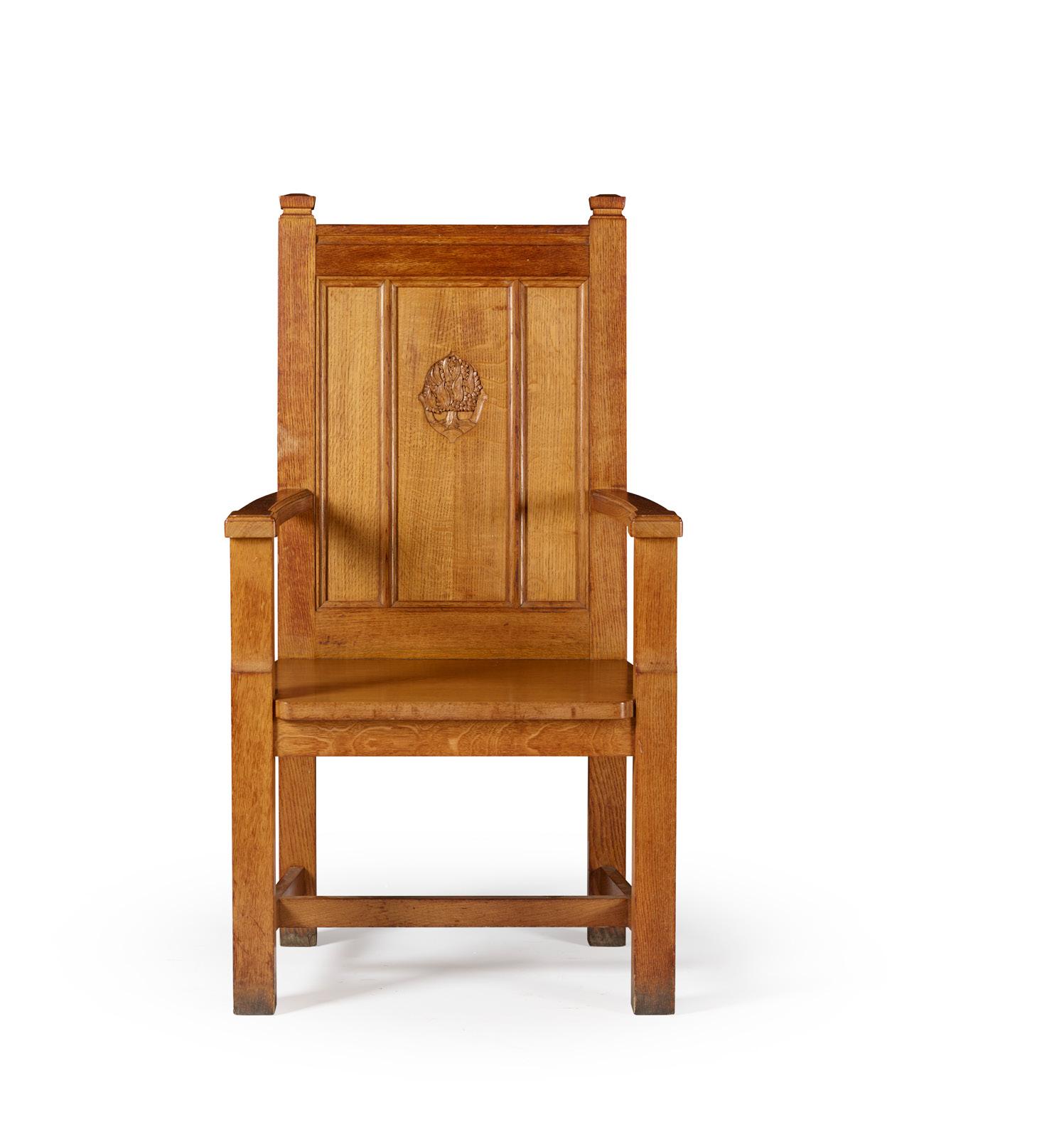
65cm wide, 118cm high, 47.5cm deep
£500‑700
159
402
ALEXANDER RITCHIE (1856‑1941)
IONA HEART‑SHAPED BOX & COVER, CHESTER 1908

silver, stamped maker’s marks and hallmarked 1908
5.6cm across
£400‑600
403 §
HANNAH FRANK (1908‑2008)
FOUR LITHOGRAPHIC PRINTS comprising ‘NIGHT FORMS’, 1932, signed in pen lower right, 40.2cm x 29.3cm; ‘FLIGHT’, 1939, signed in pencil lower right, 44cm x 30.5cm; ‘WOMAN WITH BIRDS’, 1947, signed in pencil lower right, 44.5cm x 34.2cm; and ‘MOON BALLET’, 1934, signed in pencil lower right, 43cm x 29.3cm, all unframed (4)

£500‑700
404 §
BENNO SCHOTZ (1891‑1984)
STUDY OF CHRISTOPHER WITH APPLE bronze, signed in the bronze BENNO SCHOTZ, on wood plinth

55cm high, with plinth 58cm high
£600‑800
405
GEORGE BAIN (1881‑1968) FOR QUAYLE & TRANTER LTD., KIDDERMINSTER
CELTIC ‘HUNTING’ WOOL RUG, CIRCA 1948 machine‑woven wool

193cm x 120cm
£700‑1,000
160 Other fees apply in addition to the hammer price: see the ‘Buyer’s Guide’ section on page 2
406 PETER WAALS (1870‑1937) (ATTRIBUTED MAKER)
KNEEHOLE DESK, CIRCA 1920
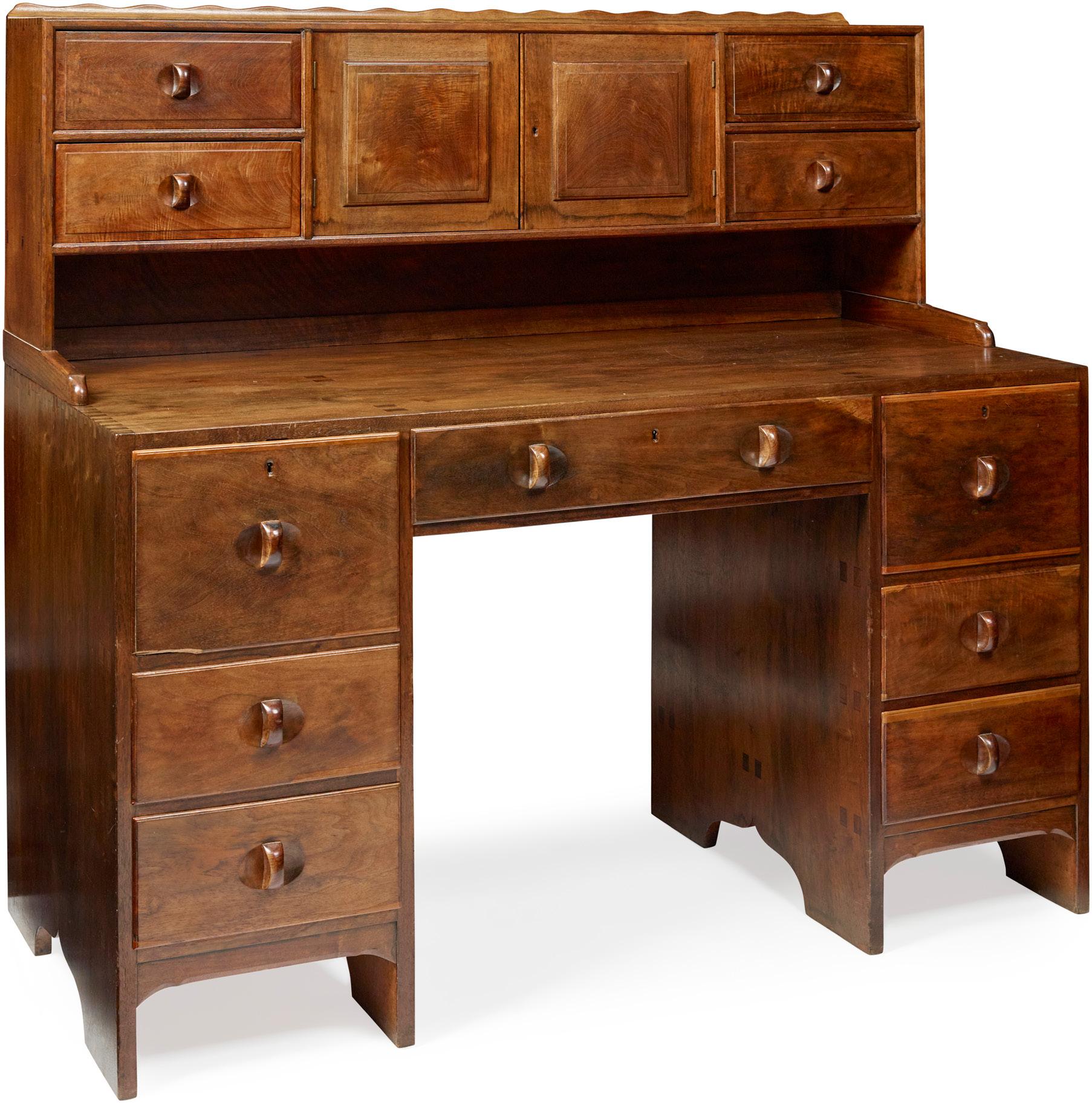

walnut
122cm wide, 124.5cm high, 56cm deep £4,000‑6,000

161
407
EDWARD BARNSLEY (1900‑1987)
CHEST OF DRAWERS, CIRCA 1976
yew, with ebony inlay

91.5cm wide, 80cm high, 47.5cm deep
Provenance: John Hemingway, 1 Ash Hill Garden, Leeds
Note: The cabinetmaker for this chest of drawers was assistant Oskar Dawson, under foreman Herbert Upton. £4,000‑6,000
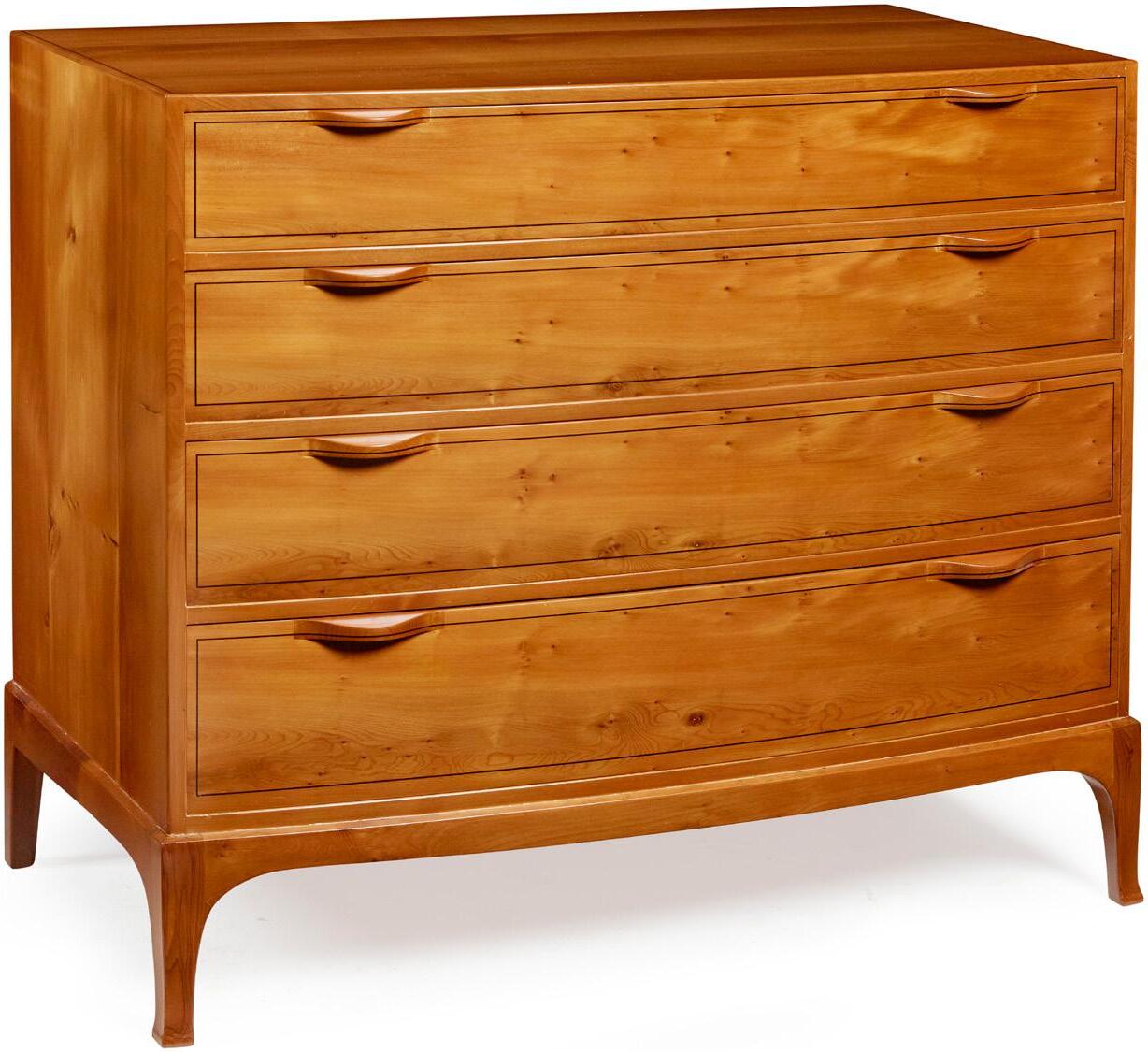
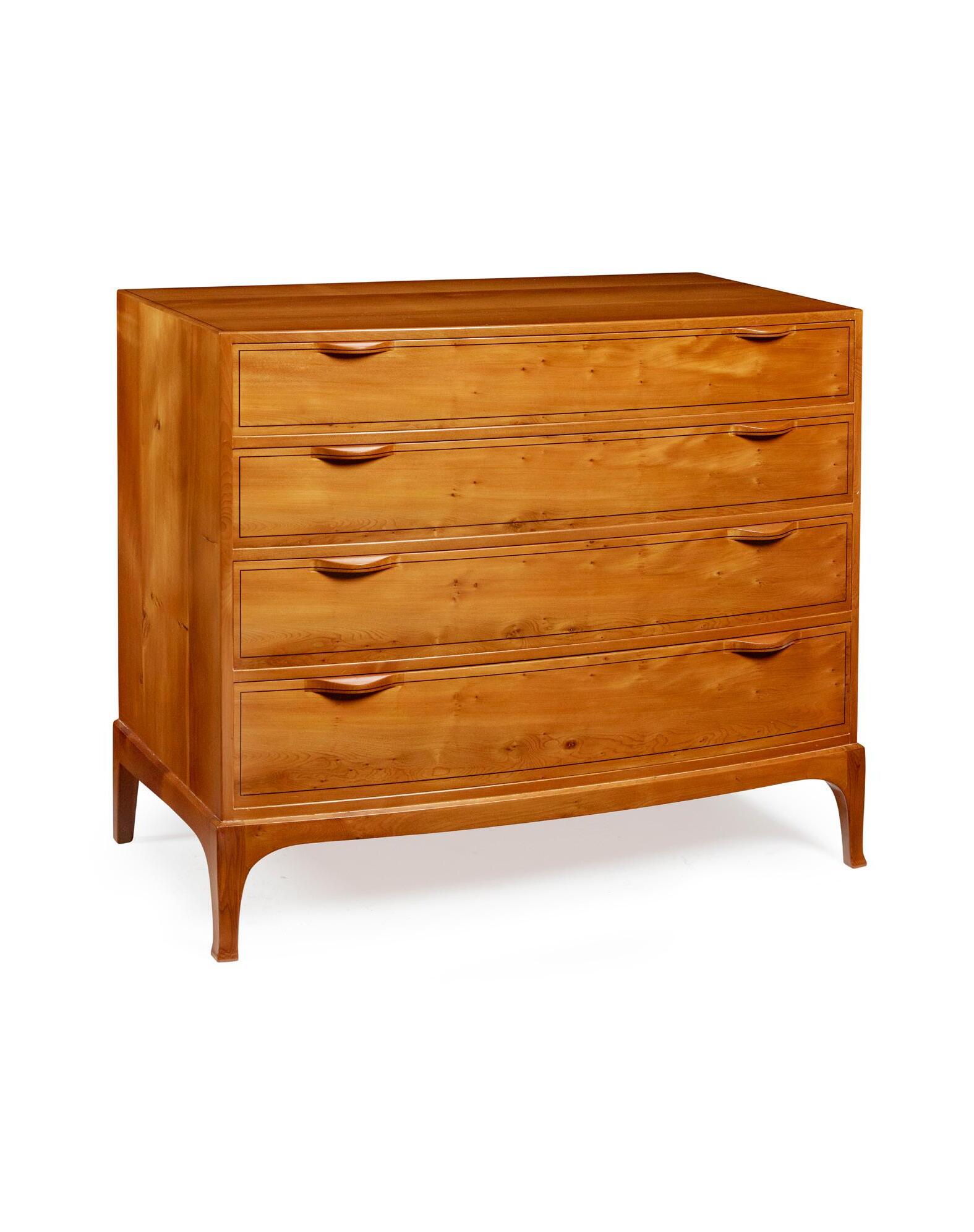
408
EDWARD BARNSLEY (1900‑1987)
SIDEBOARD, CIRCA 1958
Australian black bean, with burr oak back and sycamore line inlay
198cm wide, 95cm high, 52cm deep £3,000‑5,000
162
409
EDWARD
PAIR OF BOW‑FRONT CABINETS, CIRCA 1956

African mahogany (2)
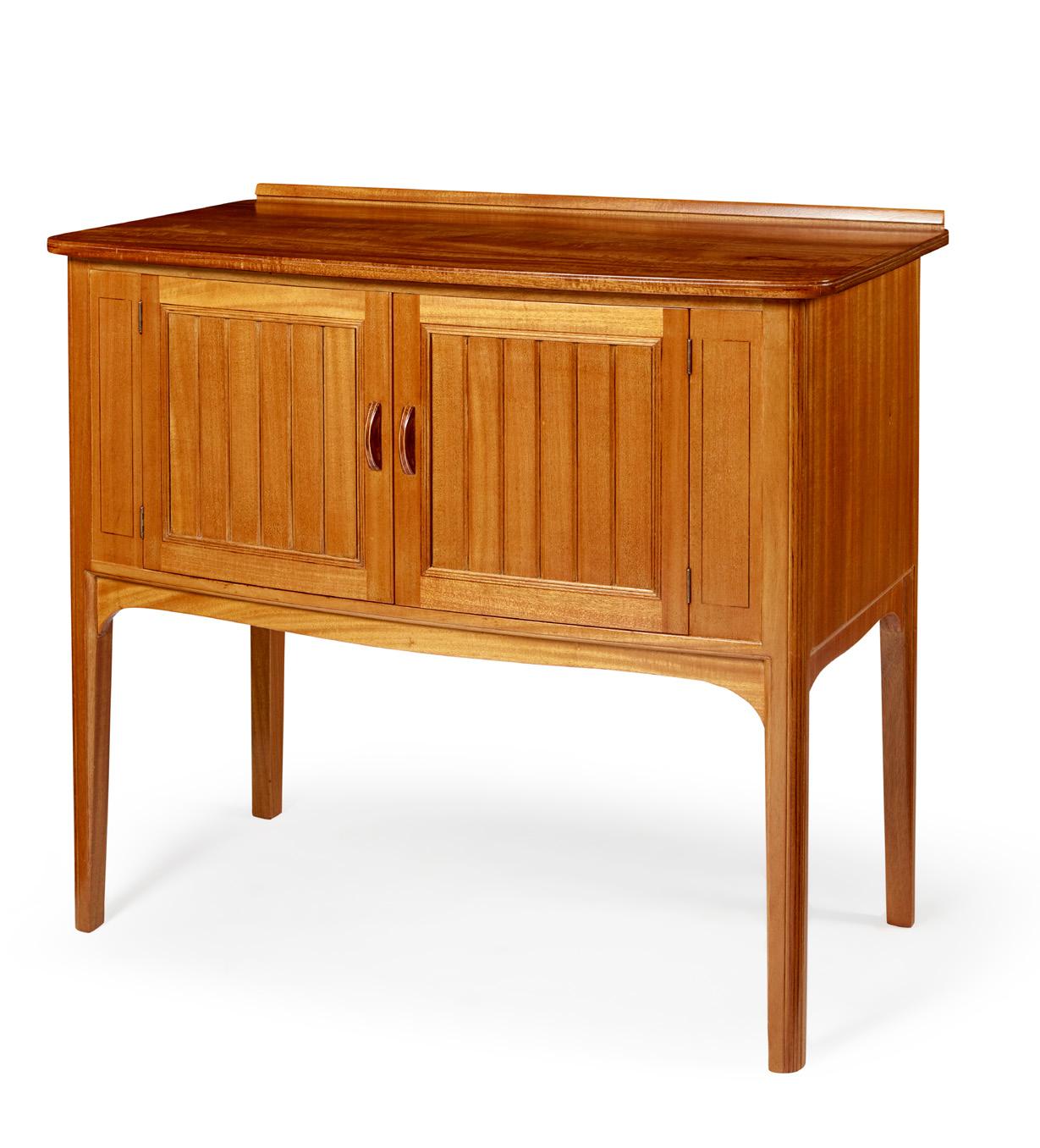
96cm wide, 88.5cm high, 53.5cm deep £3,000‑5,000
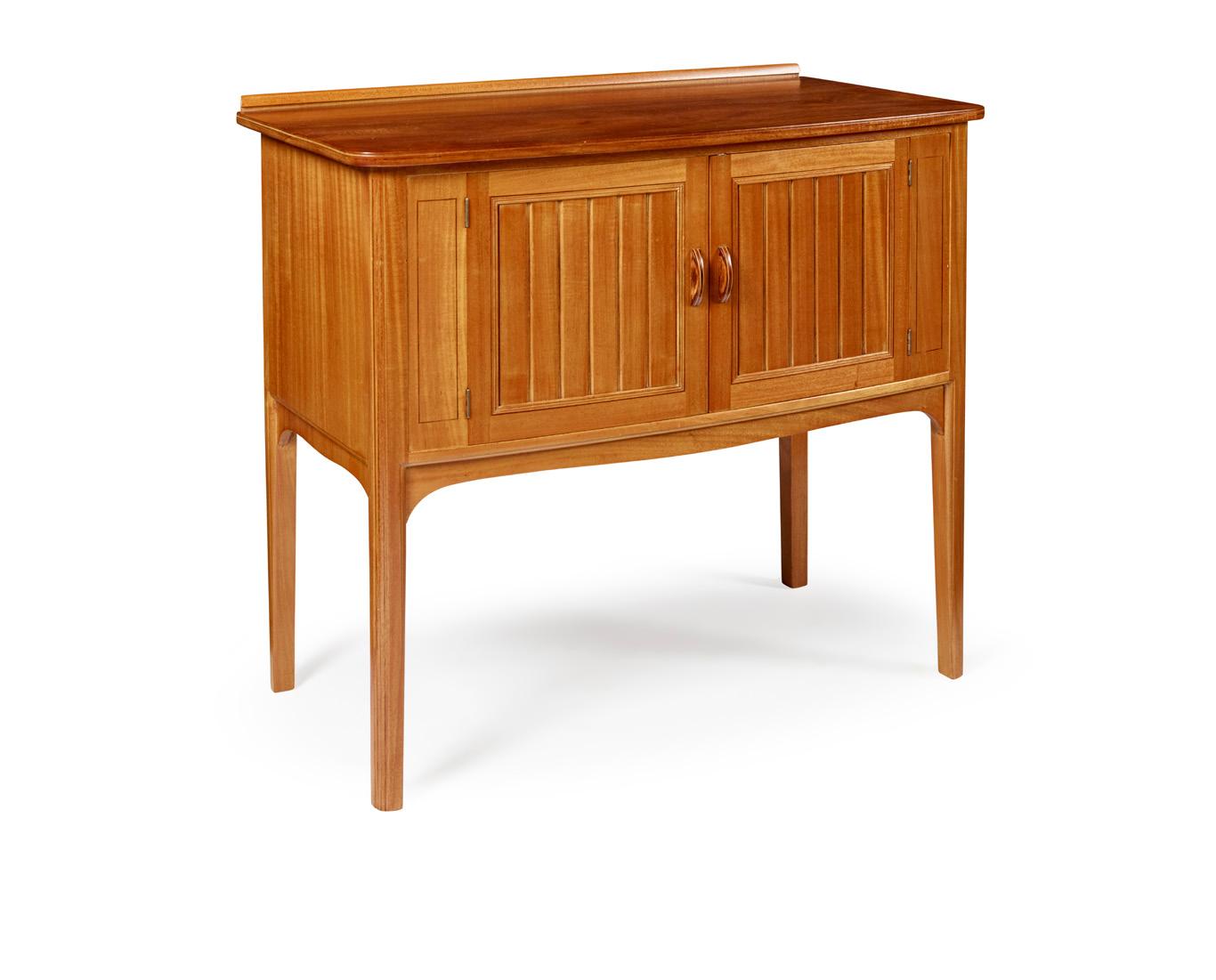 BARNSLEY (1900‑1987)
BARNSLEY (1900‑1987)
163 Other fees apply in addition to the hammer price: see the ‘Buyer’s Guide’ section on page 2
 410 PETER WAALS (1870‑ 1937) BOOKCASE, CIRCA 1935 oak
410 PETER WAALS (1870‑ 1937) BOOKCASE, CIRCA 1935 oak
164 Other fees apply in addition to the hammer price: see the ‘Buyer’s Guide’ section on page 2
162.5cm wide, 178cm high, 30cm deep £4,000‑6,000
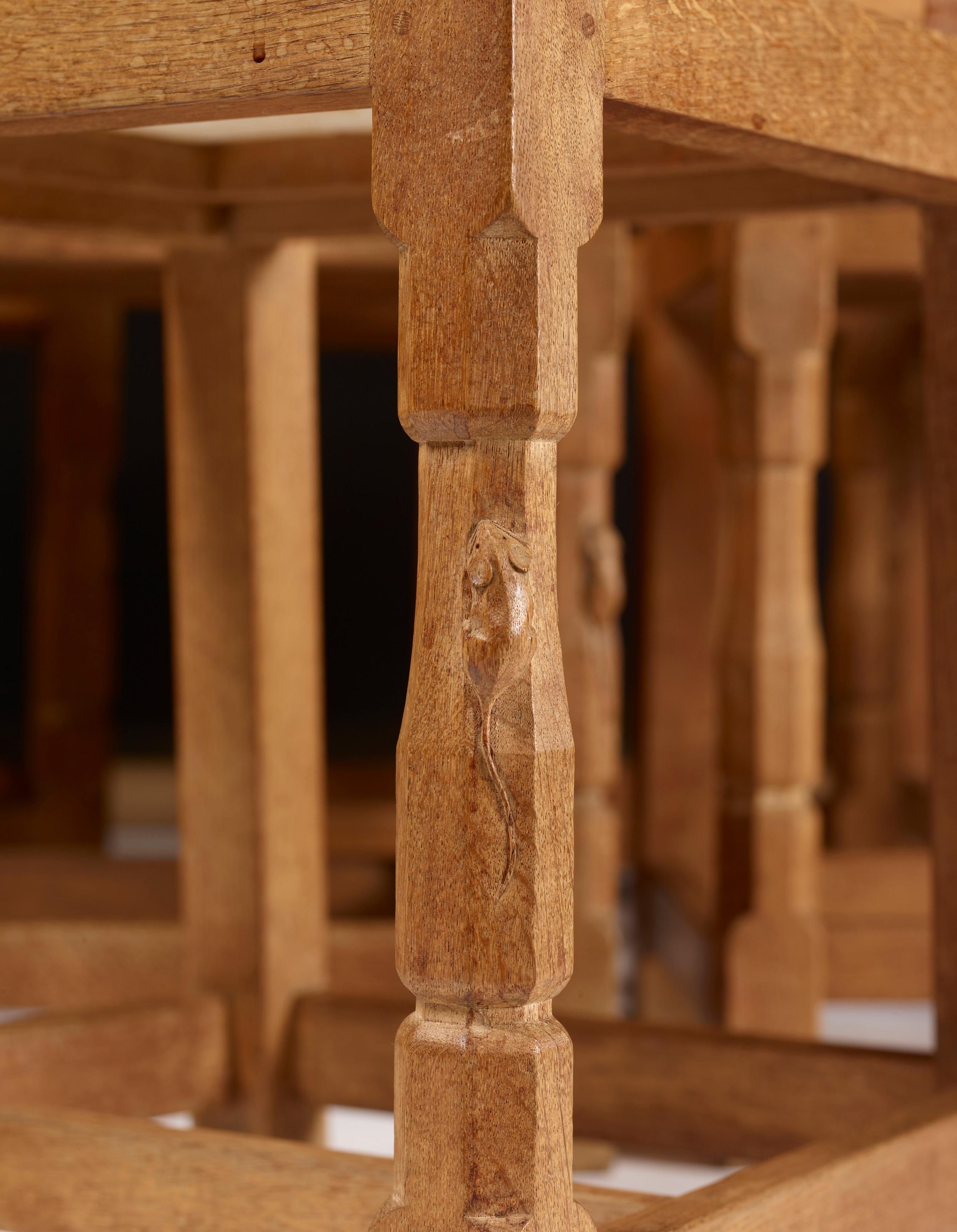
165
411
ROBERT ‘MOUSEMAN’ THOMPSON (1876‑1955)
CORNER CUPBOARD, CIRCA 1930

oak with carved mouse signature, patinated steel fittings
108cm wide, 148cm high, 68cm deep
Provenance: Collection of Robert Lawrie.
Note: Robert Lawrie (1903–1982) commissioned Robert Thompson to make several pieces for his home in the 1930’s and early 1940’s. He was a British alpine and polar equipment specialist and racing driver born in Burnley. He trained as a shoe and boot maker at his father’s firm which he later ran.
By the late 1920s he had become an accomplished climber and alpinist, and he started to design, manufacture and supply mountaineering boots to his own design. His boots proved popular and he was commissioned to supply boots for the 1933 Everest expedition led by Hugh Ruttledge. He provided boots, climbing and mountaineering equipment to many expeditions including John Hunt’s successful 1953 Everest campaign.
£4,000‑6,000
166 Other fees apply in addition to the hammer price: see the ‘Buyer’s Guide’ section on page 2
413
ROBERT ‘MOUSEMAN’ THOMPSON (1876‑1955)
STOOL, LATE 1920S‑EARLY 1930S

oak, with dense burr oak seat, turned on a lathe, with carved mouse signature
43cm wide, 35cm high, 28cm deep
£2,000‑3,000
412
ROBERT ‘MOUSEMAN’ THOMPSON (1876‑1955)
MANTEL CLOCK, CIRCA 1930

oak, with carved mouse signature, fitted with an 8‑day movement

23.5cm wide 17.5cm high
£2,000‑3,000
167
415
ROBERT ‘MOUSEMAN’ THOMPSON (1876‑1955)
WALL CLOCK, CIRCA 1990
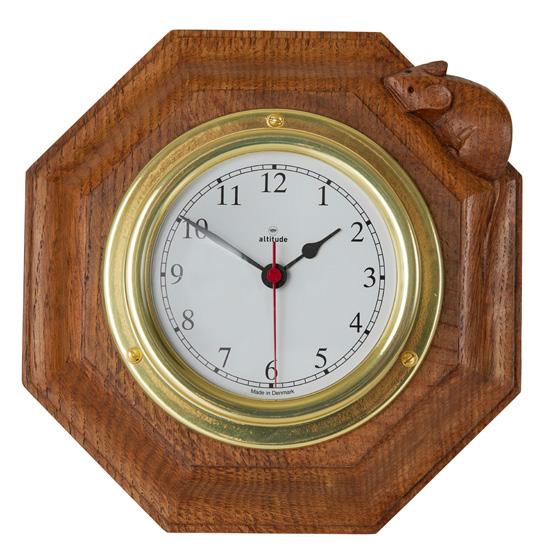
oak, with carved mouse signature, fitted with a later movement 19cm across
£300‑400
416
ROBERT ‘MOUSEMAN’ THOMPSON (1876‑1955)
LARGE BOWL, CIRCA 1960S‑70S adzed oak, with carved mouse signature to the exterior 27.5cm diameter

£400‑600
417
ROBERT ‘MOUSEMAN’ THOMPSON (1876‑1955)
PAIR OF SPINNING STOOLS, CIRCA 1980

oak, each with carved mouse signature (2) 31cm wide, 84cm high, 27cm deep
£300‑500
414
ROBERT ‘MOUSEMAN’ THOMPSON (1876‑1955)
BOOK TROUGH, CIRCA 1940S‑50S adzed oak, with carved mouse signature 46.5cm wide, 20cm high, 20.2cm deep
£300‑500
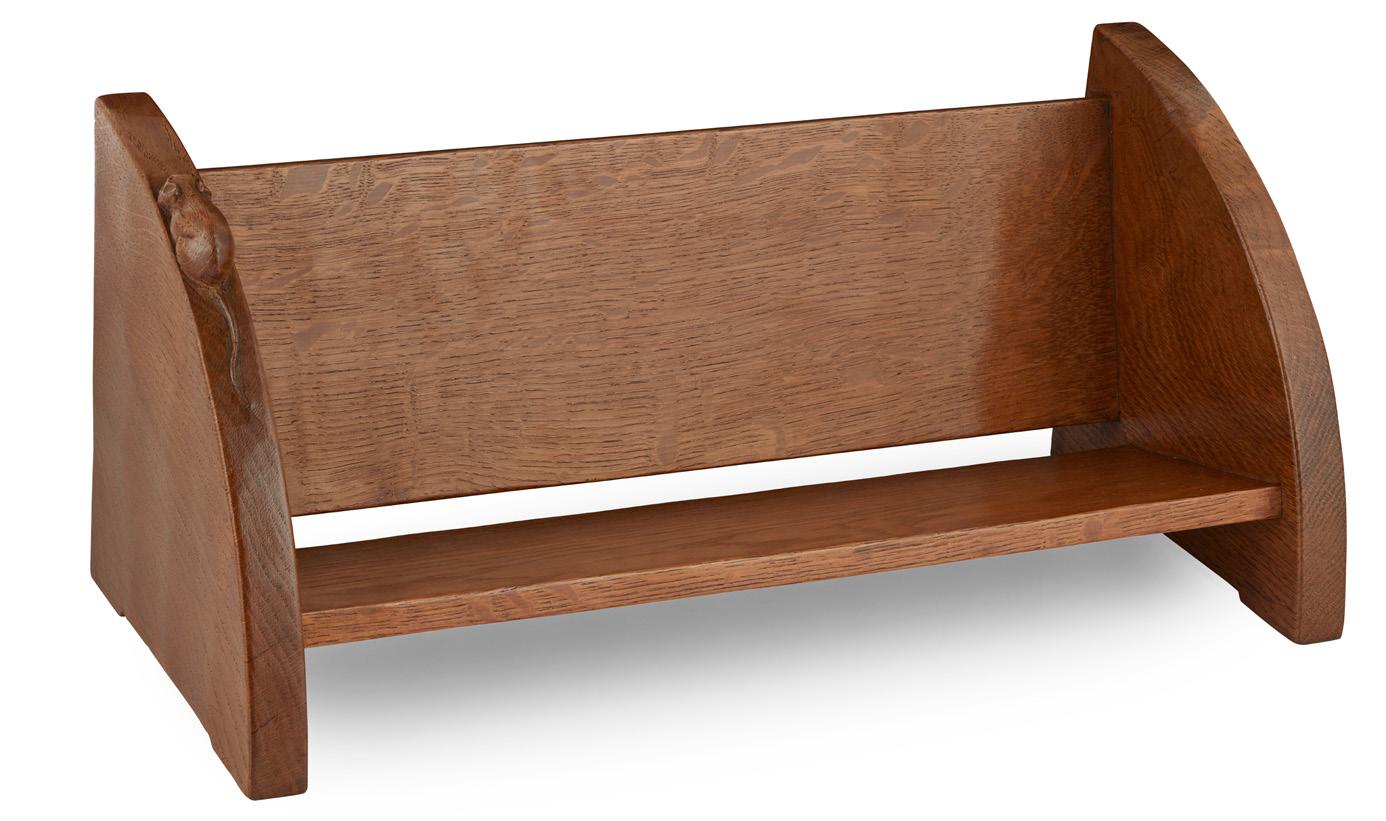
168
SET OF EIGHT DINING CHAIRS, CIRCA 1970

oak, with close nailed leather seats, each with carved mouse signature (8)
44.5cm wide, 84.5cm high, 41cm deep £1,500‑2,000
CIRCULAR DINING TABLE, CIRCA 1970 adzed oak, with carved mouse signature 137cm diameter, 74cm high £1,500‑2,000
 418
ROBERT ‘MOUSEMAN’ THOMPSON (1876‑1955)
419 ROBERT ‘MOUSEMAN’ THOMPSON (1876‑1955)
418
ROBERT ‘MOUSEMAN’ THOMPSON (1876‑1955)
419 ROBERT ‘MOUSEMAN’ THOMPSON (1876‑1955)
169 Other fees apply in addition to the hammer price: see the ‘Buyer’s Guide’ section on page 2



170
ROBERT ‘MOUSEMAN’ THOMPSON (1876‑1955) CORNER CUPBOARD, CIRCA 1930 oak and burr oak, with carved mouse signature and ‘G’ 75cm wide, 193cm high, 42cm deep approx
421 STAN ‘WOODPECKER’ DODDS (1928‑2012)
CARVED ELEPHANT FIGURE, CIRCA 1980

oak, with carved woodpecker signature 16cm wide, 17cm high
Provenance: From the estate of Stan Dodds £2,000‑3,000
422 STAN DODDS (1928‑2012) (ATTRIBUTED MAKER) FOR ROBERT ‘MOUSEMAN’ THOMPSON (1876‑1955)
CARVED OWL, CIRCA 1960S‑70S
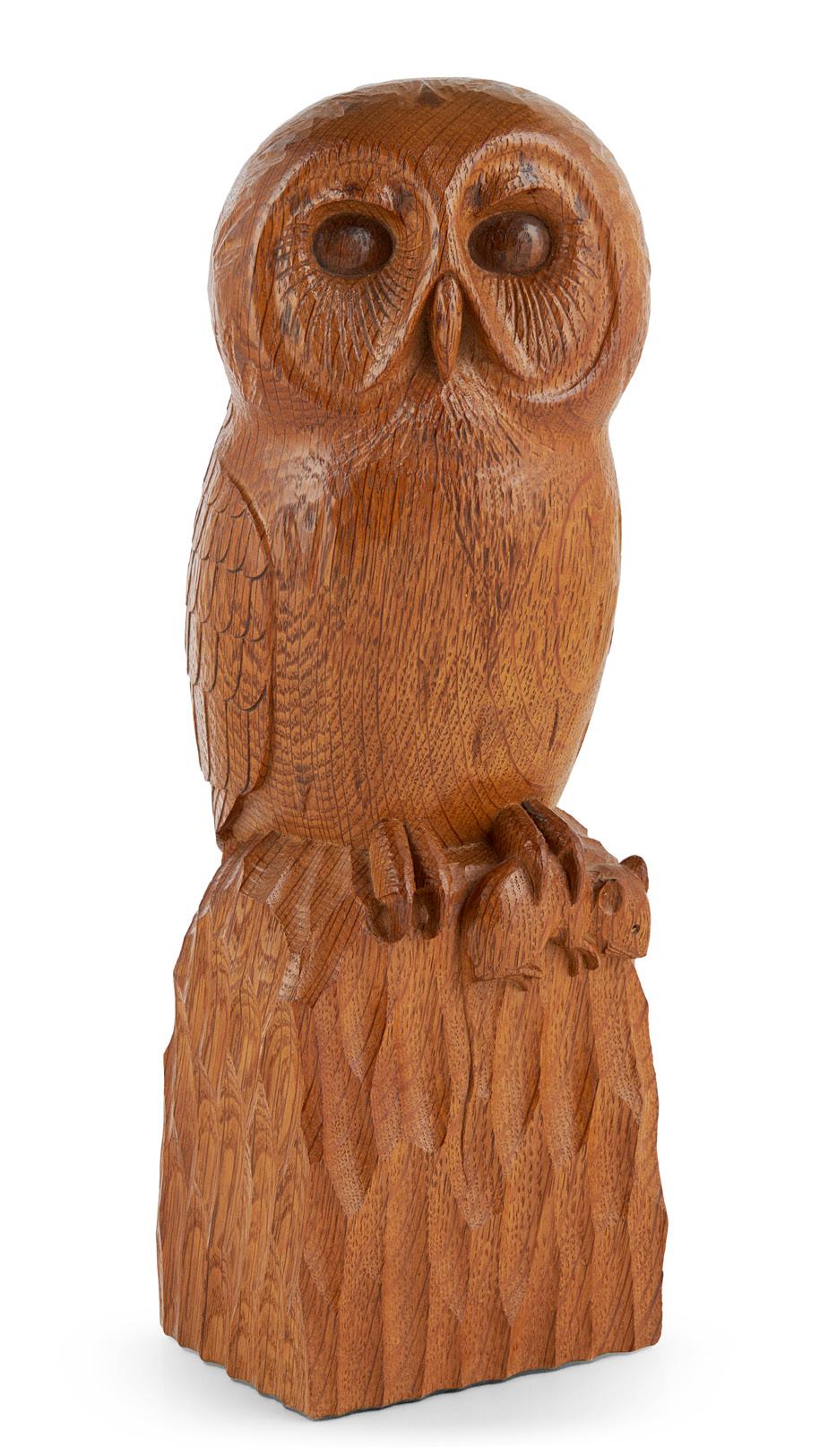
oak, with carved mouse signature 33cm high £3,000‑5,000
423 STAN ‘WOODPECKER’ DODDS (1928‑2012)
CARVED BOAR AND SOW, CIRCA 1970
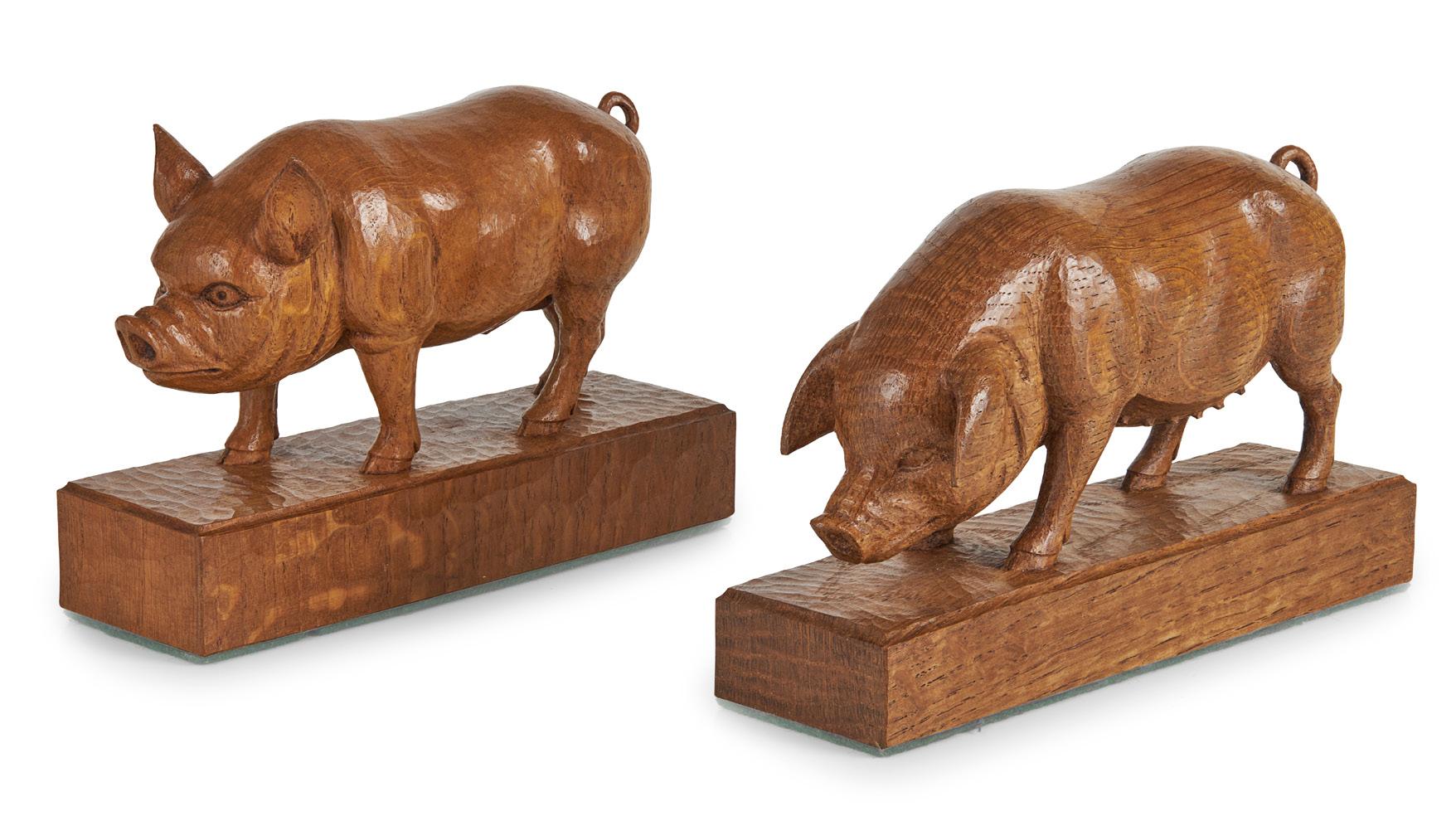
oak, each with carved woodpecker signature to each base
boar 16cm wide; sow 17.3cm wide
Provenance: From the estate of Stan Dodds £2,500‑3,500
171 Other fees apply in addition to the hammer price: see the ‘Buyer’s Guide’ section on page 2
425
ROBERT ‘MOUSEMAN’ THOMPSON (1876‑1955)
TWO ASHTRAYS, CIRCA 1950S‑1960S
oak, each with carved mouse signature, 10cm across; together with TWO NAPKIN RINGS, 1980s‑1990s, oak with carved mouse signature to each, 5cm high (4) £300‑400
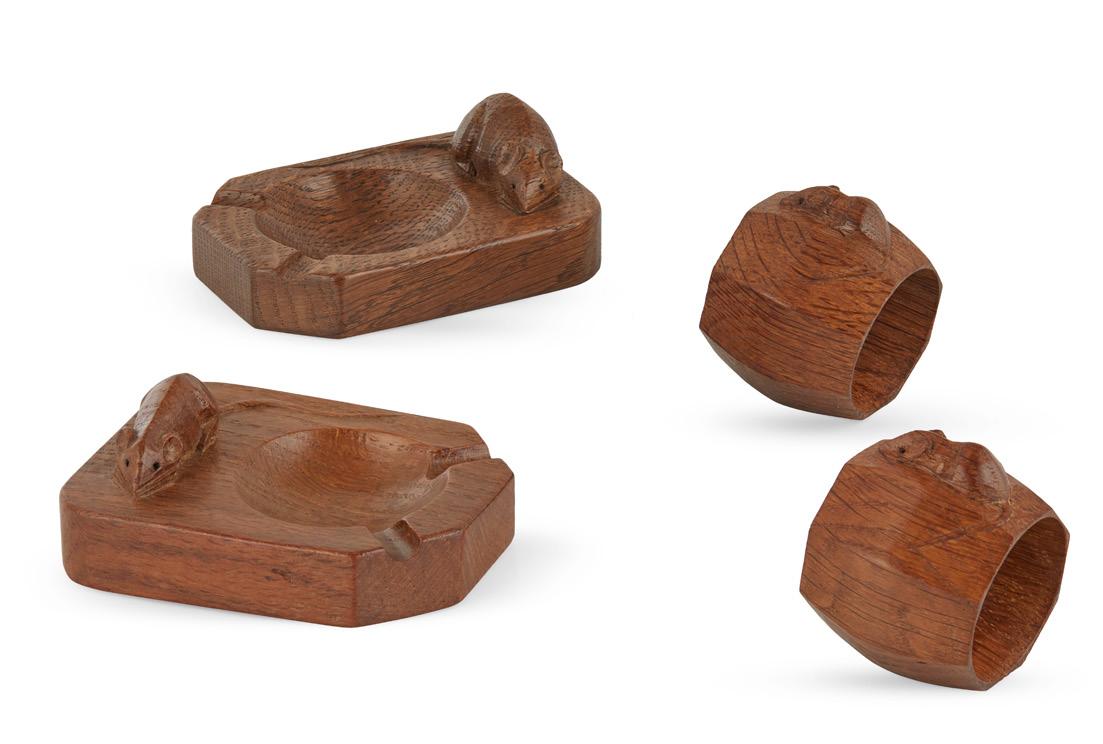
424
ROBERT ‘MOUSEMAN’ THOMPSON (1876‑1955)
CHEESEBOARD, CIRCA 1960S‑1970S
oak, with carved mouse signature
37cm across including handle £300‑400
426
ROBERT ‘MOUSEMAN’ THOMPSON (1876‑1955)
LARGE KIDNEY‑SHAPED TRAY, CIRCA 1970

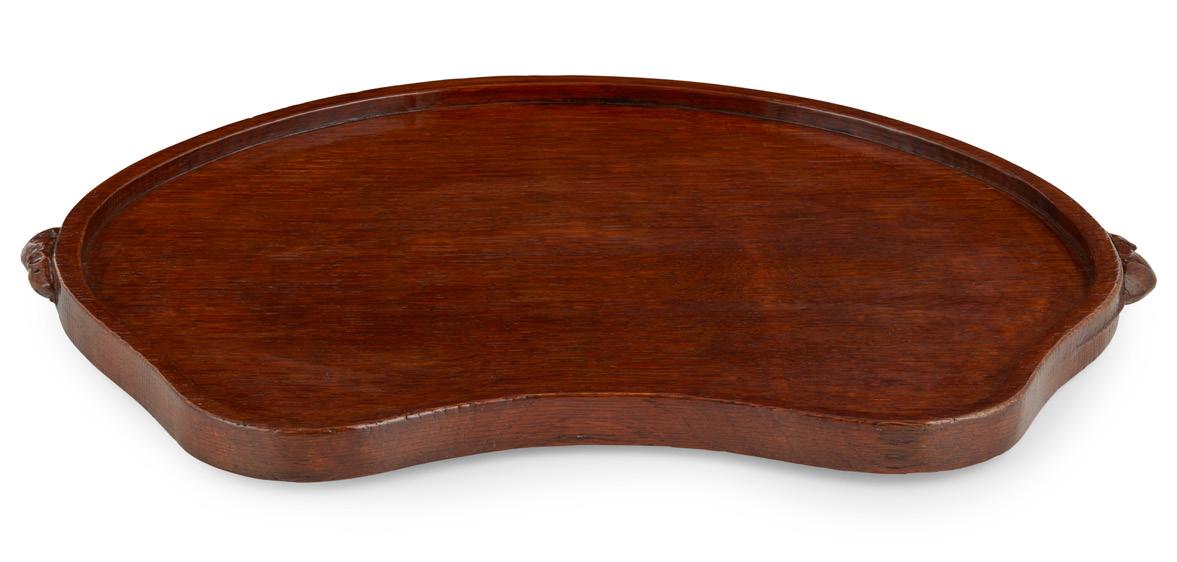

oak, with carved mouse signature to each end 46cm across £300‑500
427
ROBERT ‘MOUSEMAN’ THOMPSON (1876‑1955)
SMALL DISH, CIRCA 1980S
oak, with carved mouse signature to the centre 17cm diameter £250‑350
428
ROBERT ‘MOUSEMAN’ THOMPSON (1876‑1955)
BOOK TROUGH, CIRCA 1990S
oak, with carved mouse signature
46.5cm wide, 20.5cm high, 20.5cm deep £250‑350

172 Other fees apply in addition to the hammer price: see the ‘Buyer’s Guide’ section on page 2
429
ROBERT ‘MOUSEMAN’ THOMPSON (1876‑1955)
CHEESEBOARD, CIRCA 1950

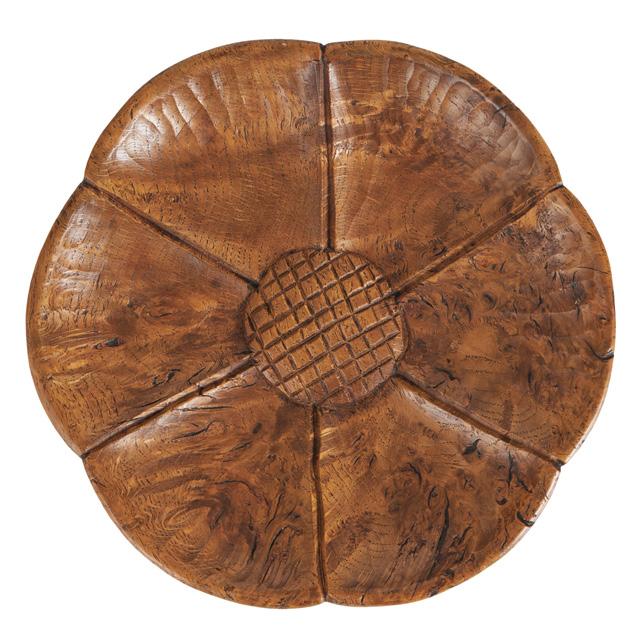
oak, with carved mouse signature

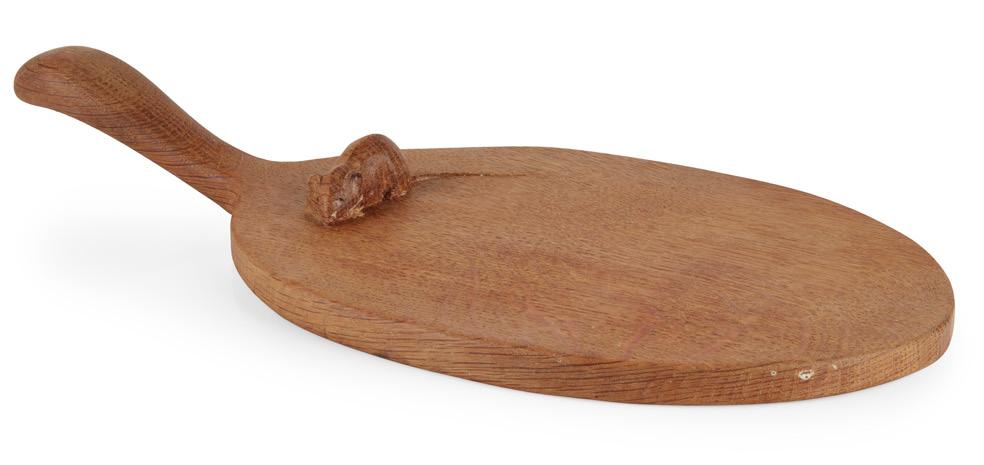
37.5cm long
£200‑300
430
THOMAS ‘GNOMEMAN’ WHITTAKER (1912‑1991)
CARVED FLOWER, CIRCA 1960 burr oak, with carved gnome signature 22cm diameter £250‑350
OPEN BOOKCASE, CONTEMPORARY oak and burr oak with adjustable shelves and carved mouse signature 142cm wide,


173
86cm high, 35cm deep £2,000‑3,000
433
NEIL MORRIS FOR H. MORRIS & CO. LTD., GLASGOW
‘CLOUD TABLE’, CIRCA 1947

mahogany plywood, Betula wood, applied makers plaque and retailer’s paper label 103cm wide, 48cm high £800‑1,200
432
J. L. LEGORRETA, MEXICO, AFTER HANS J. WEGNER
PAIR OF FOLDING CHAIRS, CIRCA 1960S
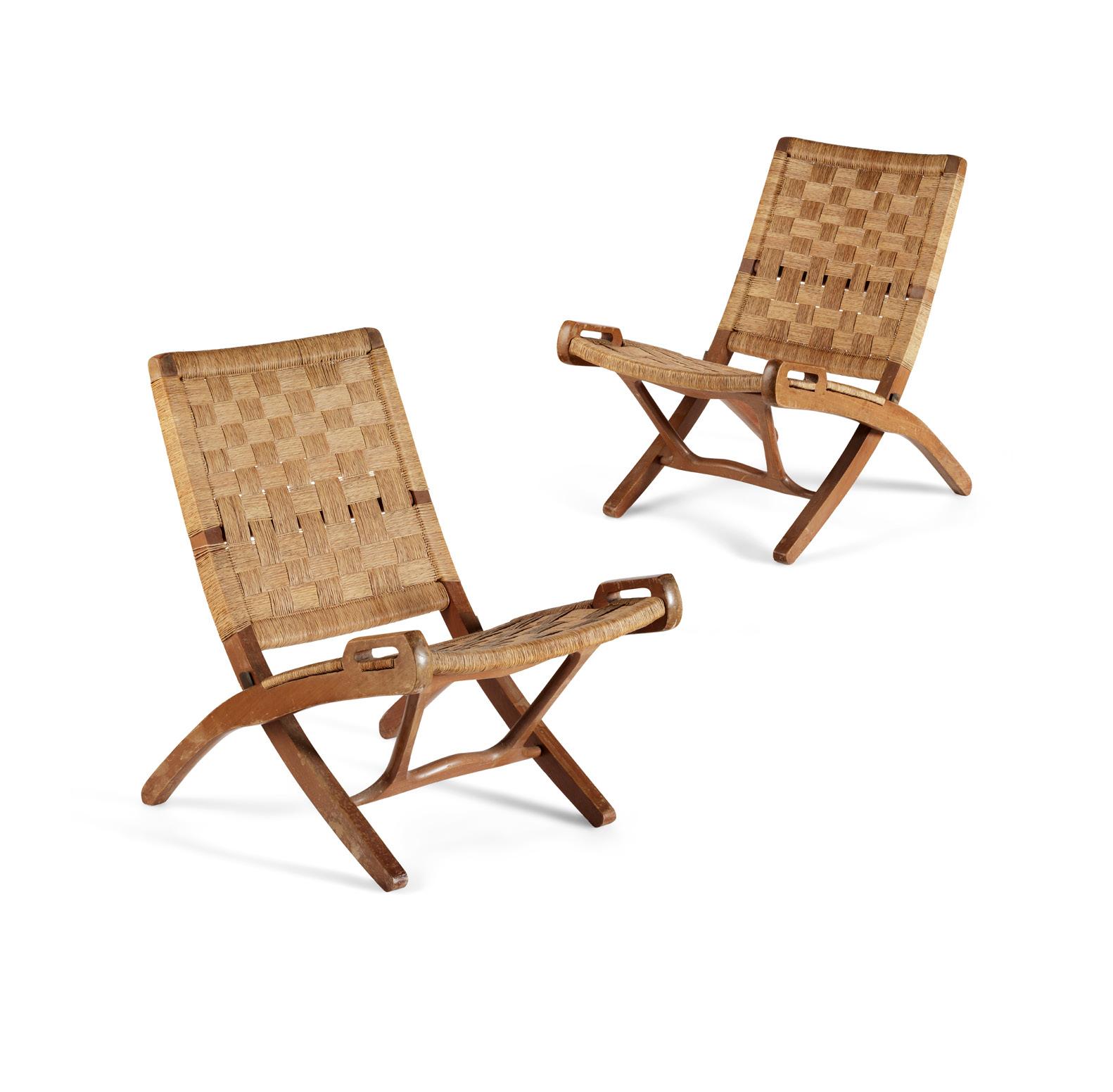
walnut, with woven rush upholstery, each with retailer’s metal tag impressed J.L. LEGORRETA, MEXICO CITY, MEUBLES TROPICALES (2)
59cm wide, 75cm high, 70cm deep
£300‑500
434
ALVAR AALTO (1898‑1976) FOR ARTEK

36/401 ARMCHAIR, DESIGNED 1933 birch ply with upholstered sprung seat and back 63cm wide, 91.5cm high, 68cm deep £500‑700
435
ARNO MALINOWSKI (1899‑1976) FOR GEORG JENSEN
THREE BROOCHES, 1933‑1944
model no. 256, 4.2cm wide; model no. 239, 4cm wide; together with model no. 311, 4.8cm wide; and model 318, 4cm square, each with stamped maker’s marks (3)
£400‑600
174 Other fees apply in addition to the hammer price: see the ‘Buyer’s Guide’ section on page 2
436
ARNO MALINOWSKI (1899‑1976) FOR GEORG JENSEN
PENDANT NECKLACE, 1933‑1944
model no.95, with link chain, 4.2cm wide; together with another PENDANT NECKLACE BY ARNO MALINOWSKI FOR GEORG JENSEN, model no. 97, with a link chain, 4cm wide; and a BROOCH BY ARNO MALINOWSKI FOR GEORG JENSEN, model no. 311, 4.8cm wide, each with stamped maker’s marks (3)
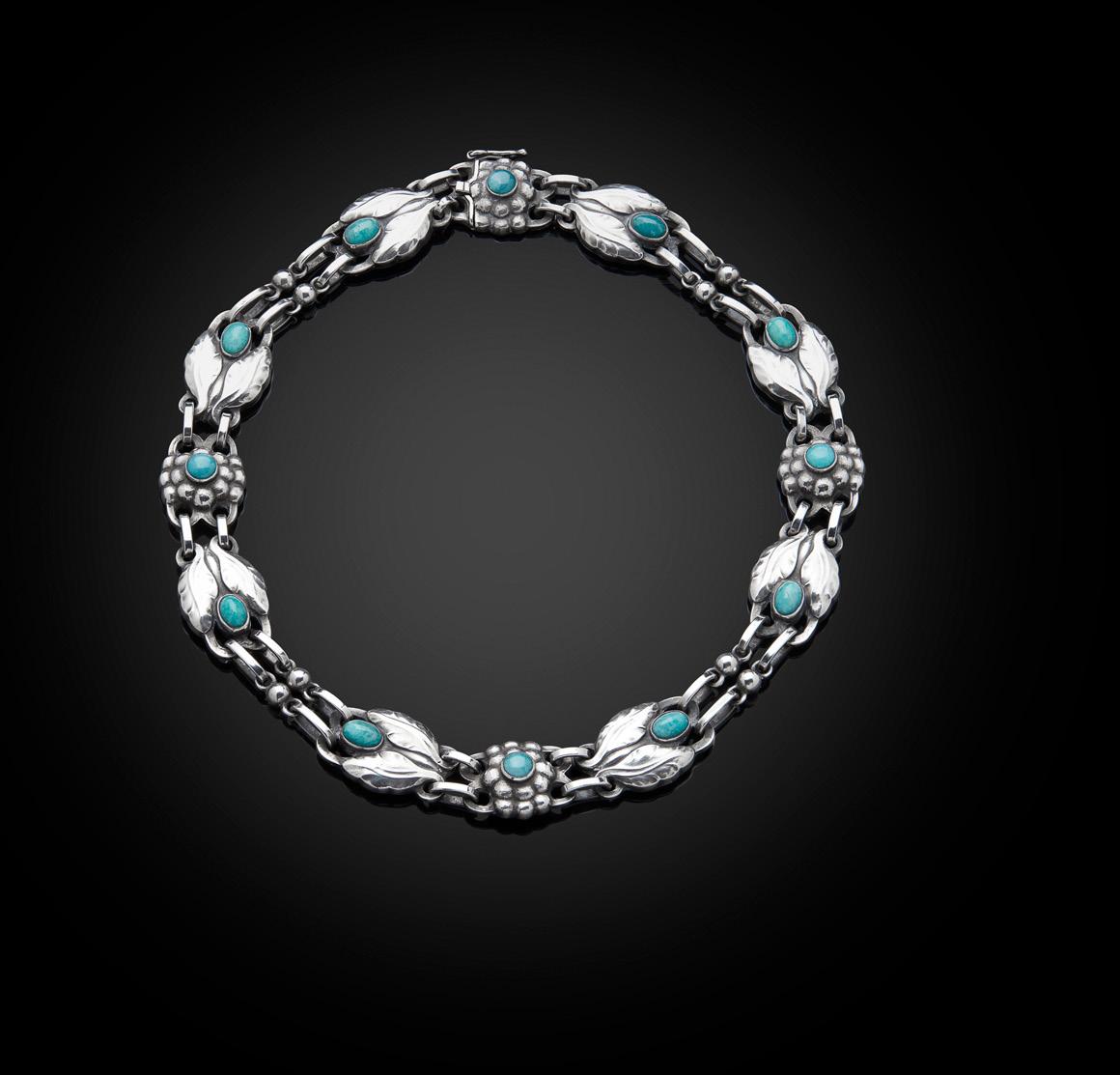
£400‑600
437
GEORG JENSEN (1866‑1935)
NECKLACE, 1933‑1944
model no.15, sterling silver, set with amethyst cabochons, stamped GEORG JENSEN/ STERLING/ DENMARK/ 15 50cm long including chain

£600‑800
440
GEORG JENSEN (1866‑1935)
BROOCH, CIRCA 1920
model 82, sterling silver, 2.8cm diameter; together with a PAIR OF BUTTONS, model 28, 1.9cm diameter; PAIR OF EARRINGS, model 47, set with green chrysoprase cabochons, 1.1cm diameter; and THREE BUTTONS, model 103, 2cm diameter, each stamped with maker’s marks (8)
£250‑350
438
GEORG JENSEN (1866‑1935)

NECKLACE, POST‑1945
model no.1, first designed 1904, sterling silver, set with blue hardstone cabochons, stamped GEORG JENSEN/ STERLING/ DENMARK/ 1
36cm long
£800‑1,200
439
HENRY HEERUP (1907‑1993) FOR GEORG JENSEN
‘MOTHER & CHILD’ PENDANT NECKLACE

model 150, silver and enamel, stamped maker’s marks, 5.8cm x 6cm; together with a GEORG JENSEN TIMEPIECE, silver and enamel, amber dial marked GEORG JENSEN/ SWISS, 3.7cm tall (2)
£200‑300
441
HENNING KOPPEL (DANISH 1918‑1981) FOR GEORG JENSEN BROOCH, DESIGNED 1954
model 315, silver and green enamel, 4.3cm wide; together with an AMORPHIC BROOCH BY HENNING KOPPEL FOR GEORG JENSEN, DESIGNED 1956, model 323, sterling silver and black enamel, 7cm across, each with stamped maker’s marks (2)
£300‑500
175
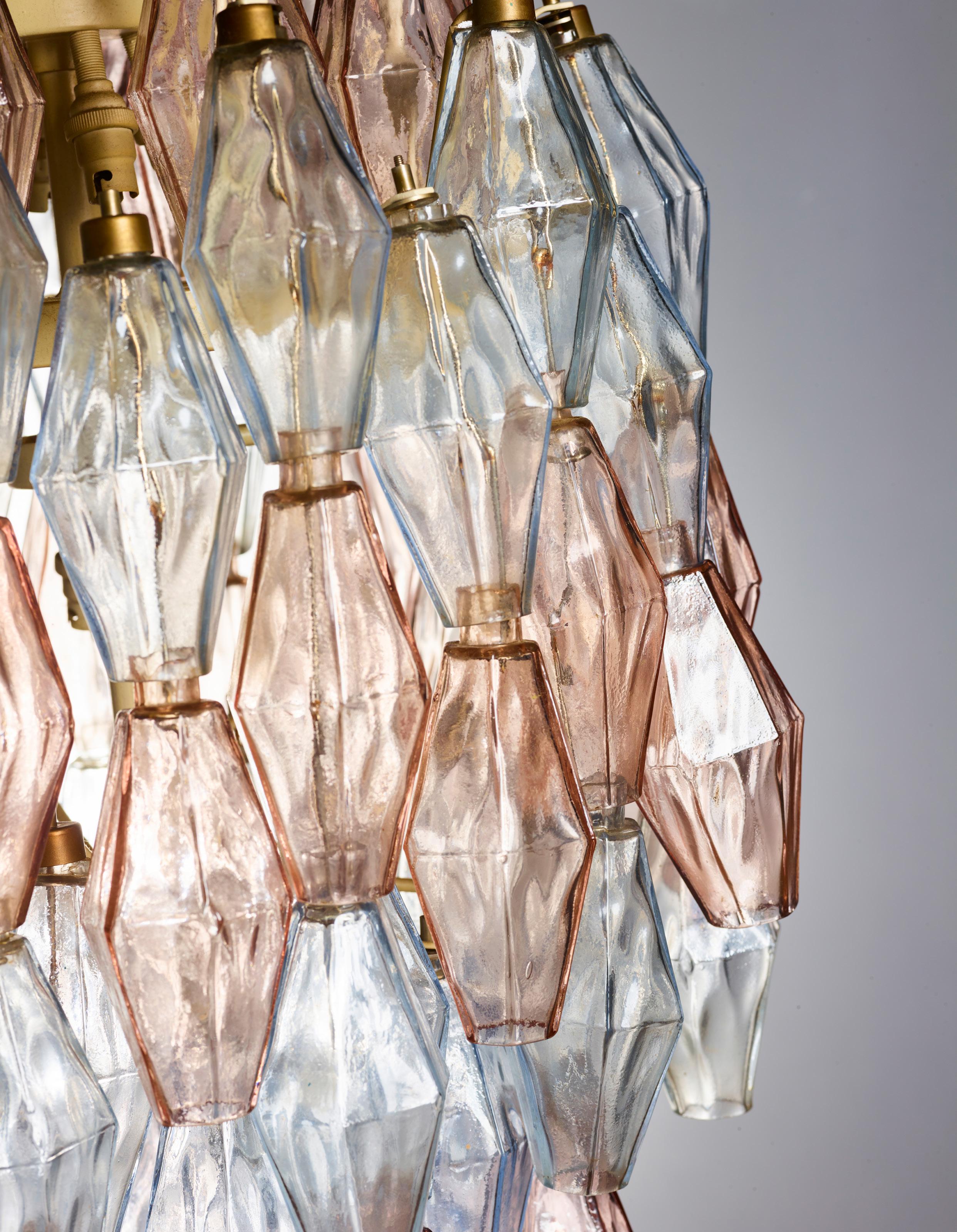
176
443
AFRA SCARPA (1937‑2011) AND TOBIA SCARPA (B. 1935) FOR MAXALTO ‘ARTONA’ MODEL CENTRE TABLE, CIRCA 1975
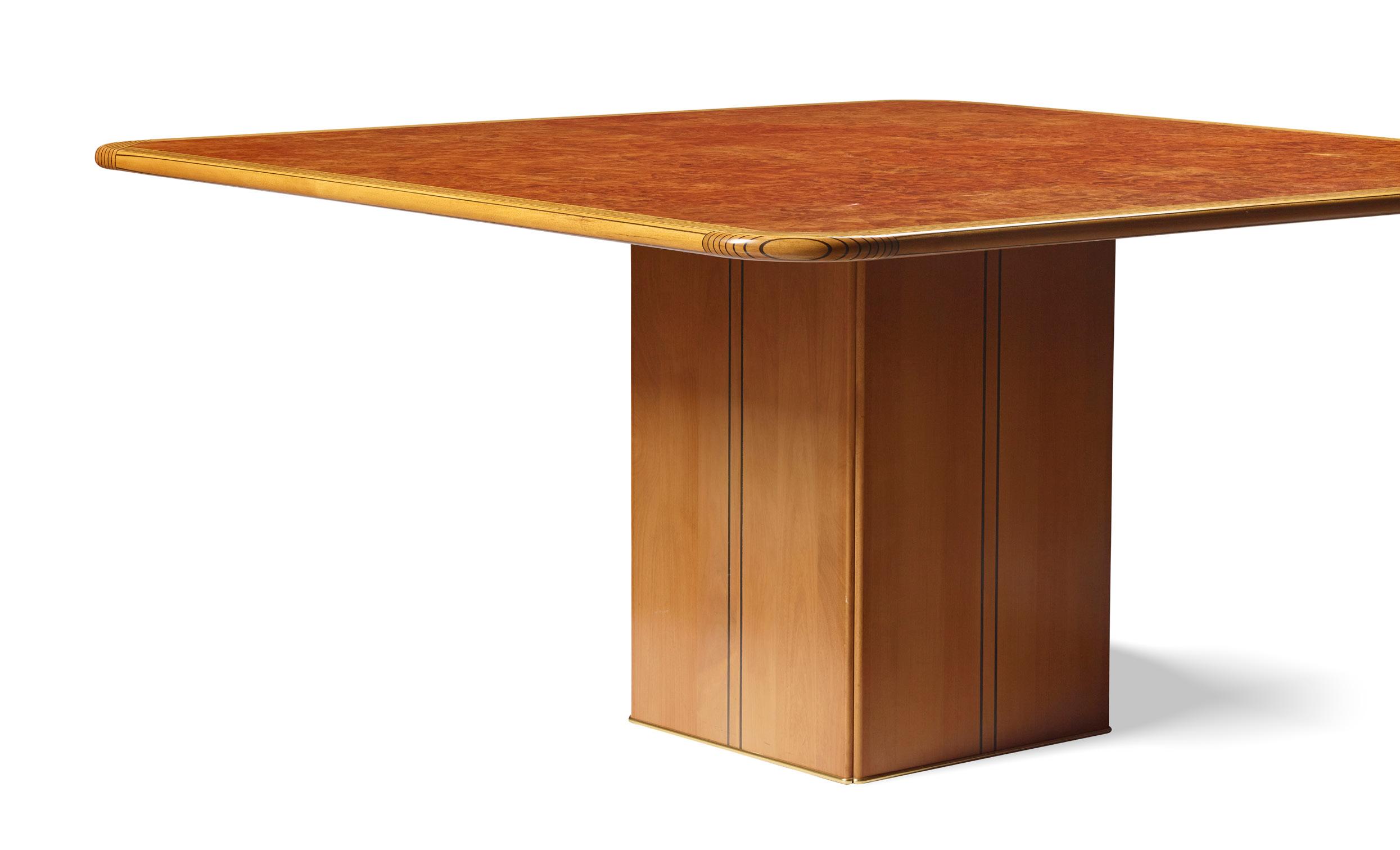
walnut, burr walnut parquetry inlay, ebony inlay to the rim and base, base with brass trim
139.5cm wide, 69.5cm high, 139.5cm deep
Literature: Gramigna G. Repertorio del Design Italiano 1950‑2000 per L’Arredamento Domestico, Umberto Allemandi 2021, p. 232 £2,000‑3,000
442
CARLO SCARPA (1906‑1978) FOR VENINI ‘POLIEDRI’ CHANDELIER, CIRCA 1955 glass, painted metal light, 56cm high, 45cm diameter, total height 118cm £1,000‑1,500
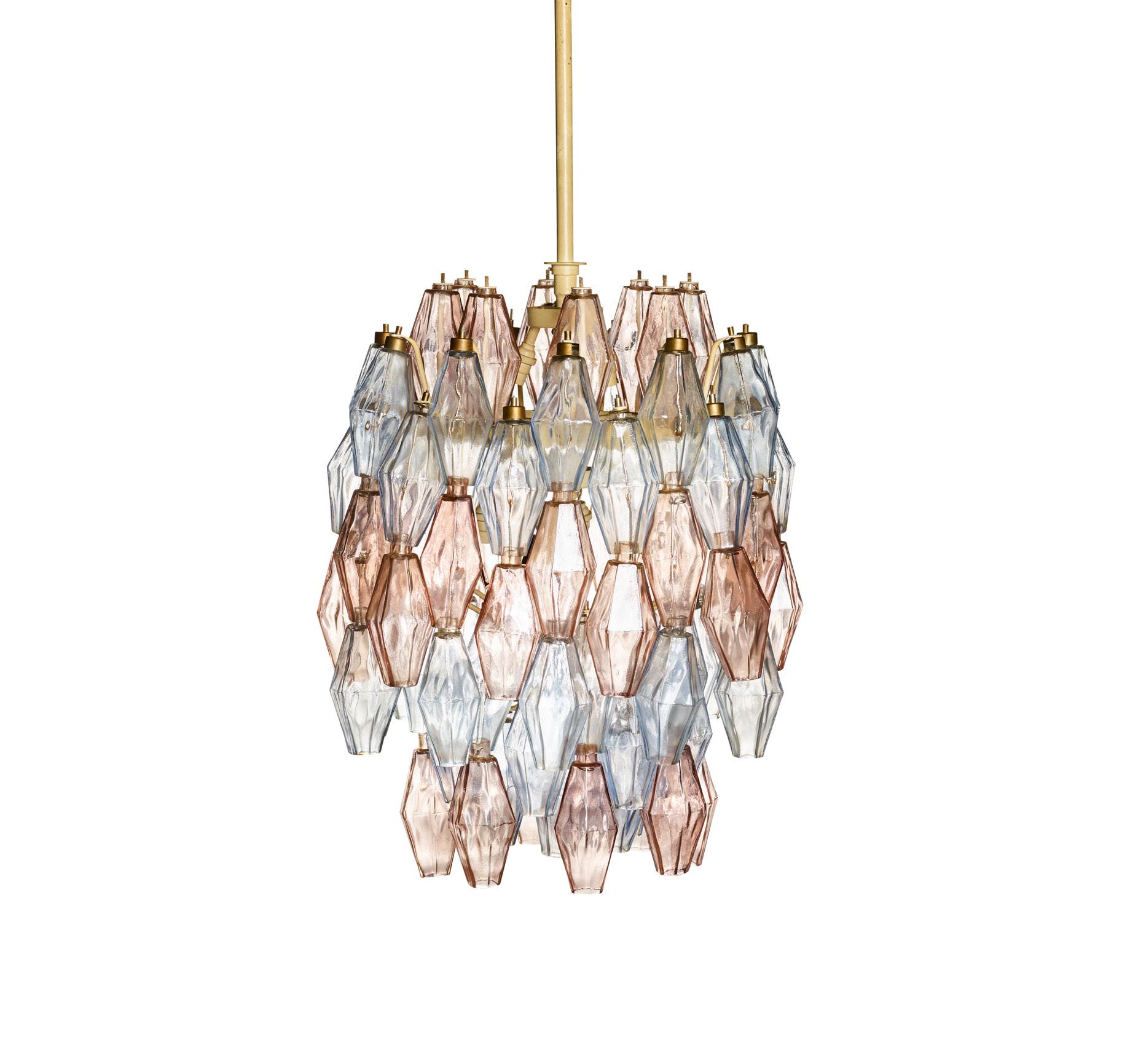
177 Other fees apply in addition to the hammer price: see the ‘Buyer’s Guide’ section on page 2
444
MARIO BELLINI (B. 1935) FOR CASSINA
PAIR OF ‘DUC 405’ ARMCHAIRS, DESIGNED 1976 grey leather, each bears cloth label CASSINA MADE IN ITALY (2)


91cm wide, 71cm high, 83cm deep £600‑800
445
PAUL KINGMA (1931‑2013)
TABLE, CIRCA 1990
slate, inlaid with brass and copper, facsimile signature to top 114.5cm long, 48cm high, 71cm deep £300‑500

178 Other fees apply in addition to the hammer price: see the ‘Buyer’s Guide’ section on page 2
446
CARLO SCARPA (ITALIAN 1906‑1978) FOR VENINI PAIR OF ‘POLIEDRI’ CEILING LIGHTS, CIRCA 1955 glass, painted metal (2) light 33cm high, 19.5cm diameter, total height 65cm £800‑1,200
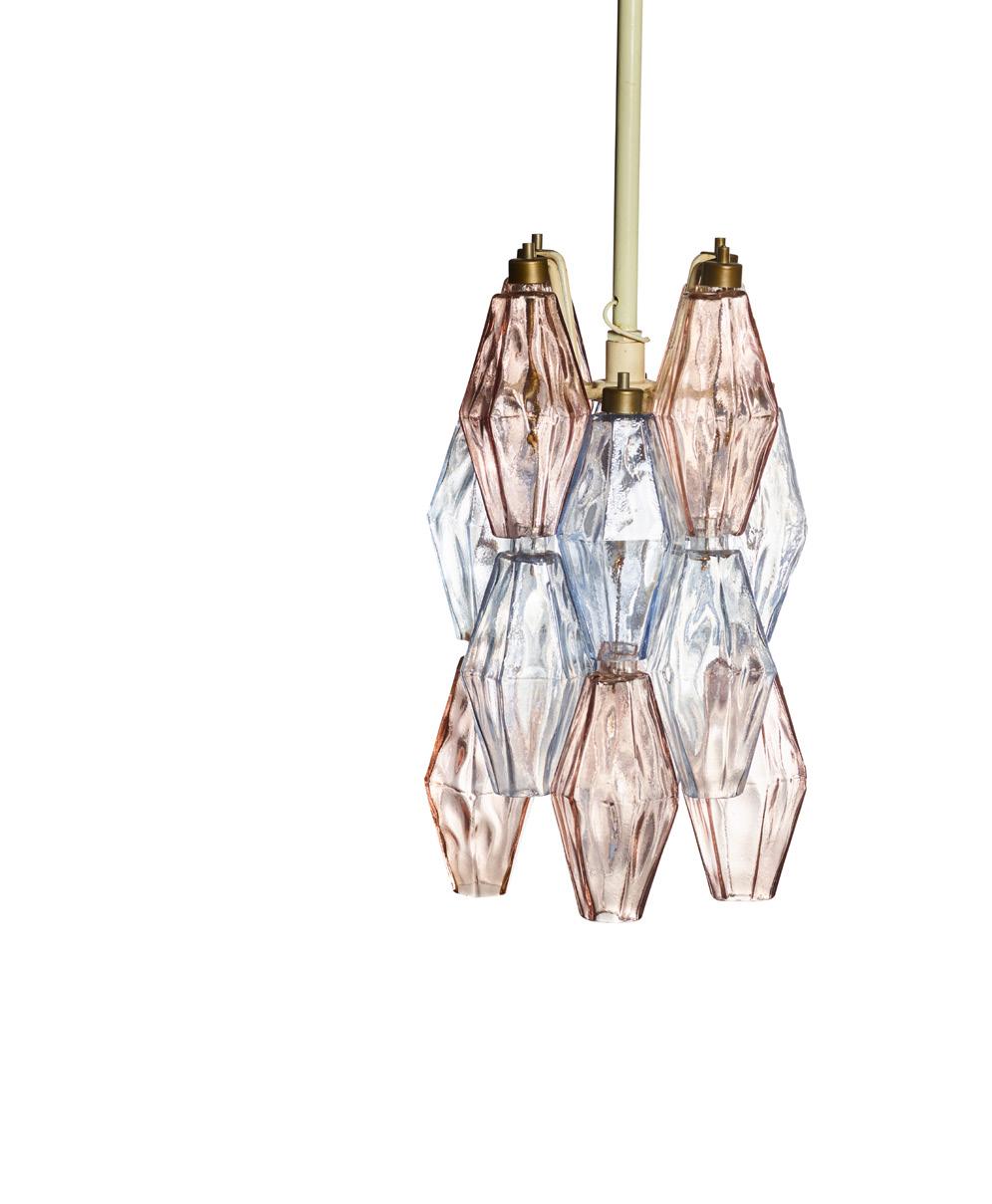
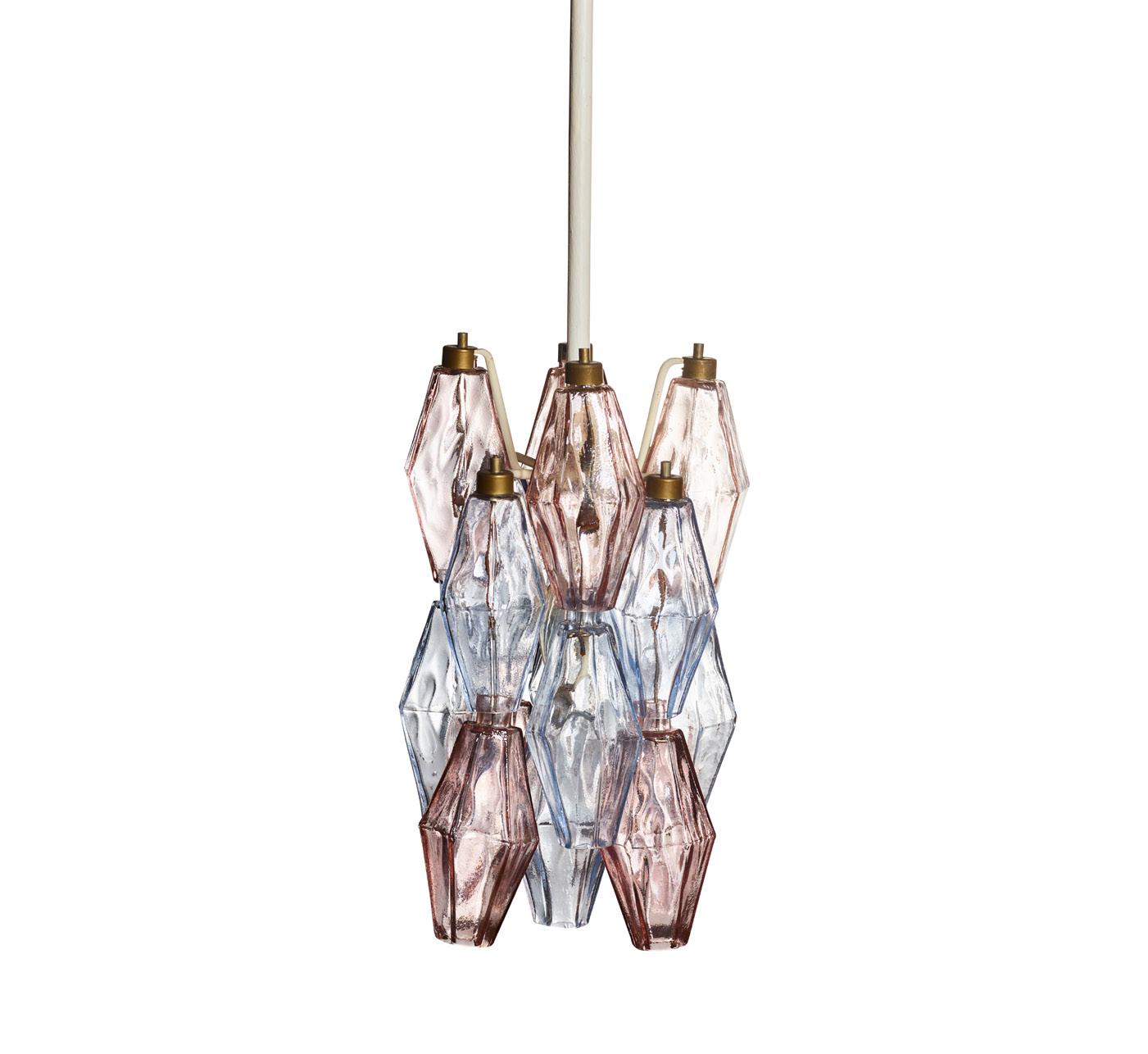
447 §
BERNARD HESLING (1905‑1987)
ABSTRACT ROUNDEL
enamel on steel, painted HESLING, mounted in gilt frame 42cm square in frame

£600‑800
448
METAFORM, ITALY CENTRE TABLE, MODERN
Carrara Gioia marble, on patinated steel base 140cm diameter, 73cm high £500‑800
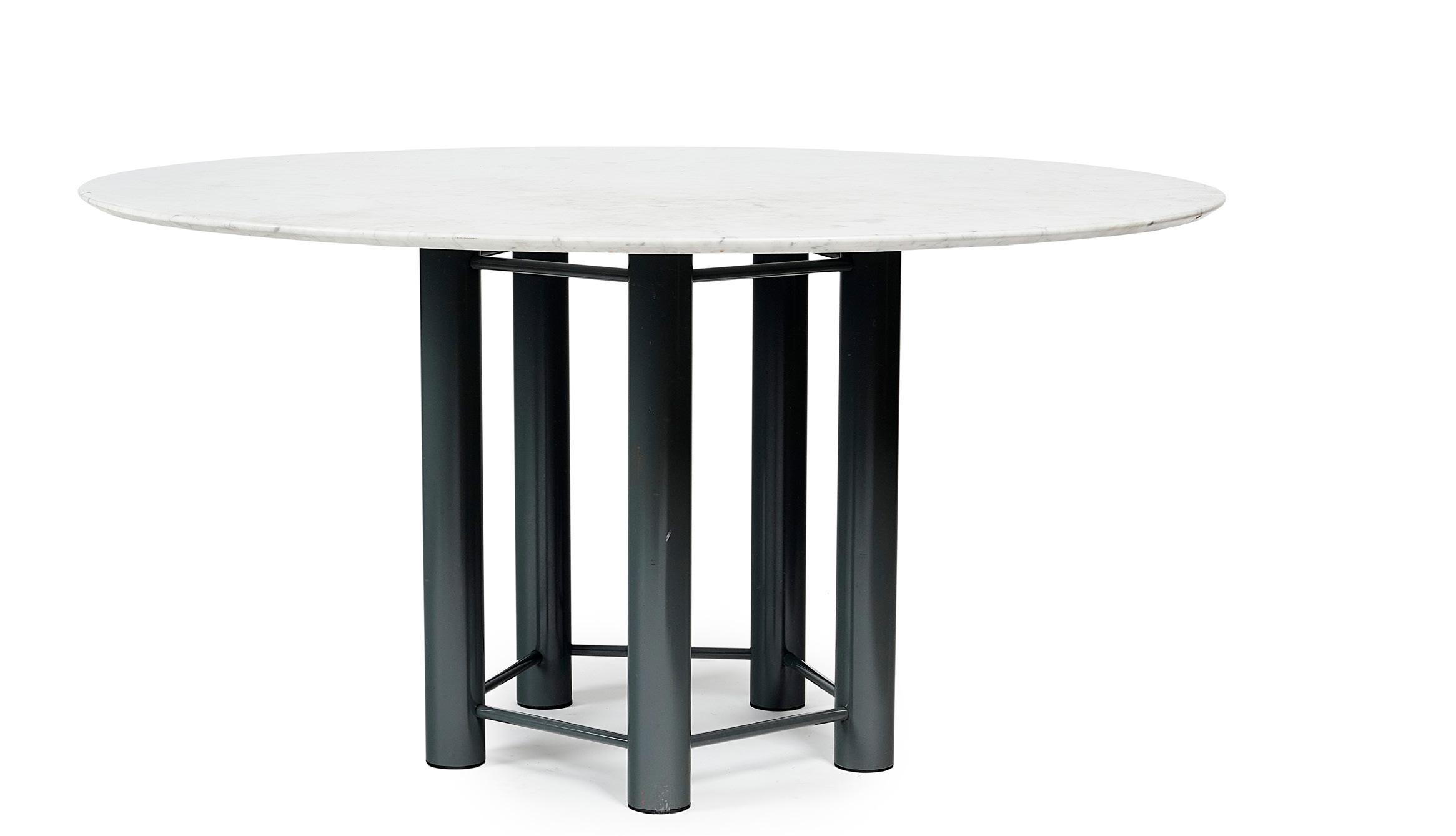
179
449
EDINBURGH WEAVERS
WOVEN FABRIC PANEL, CIRCA 1960
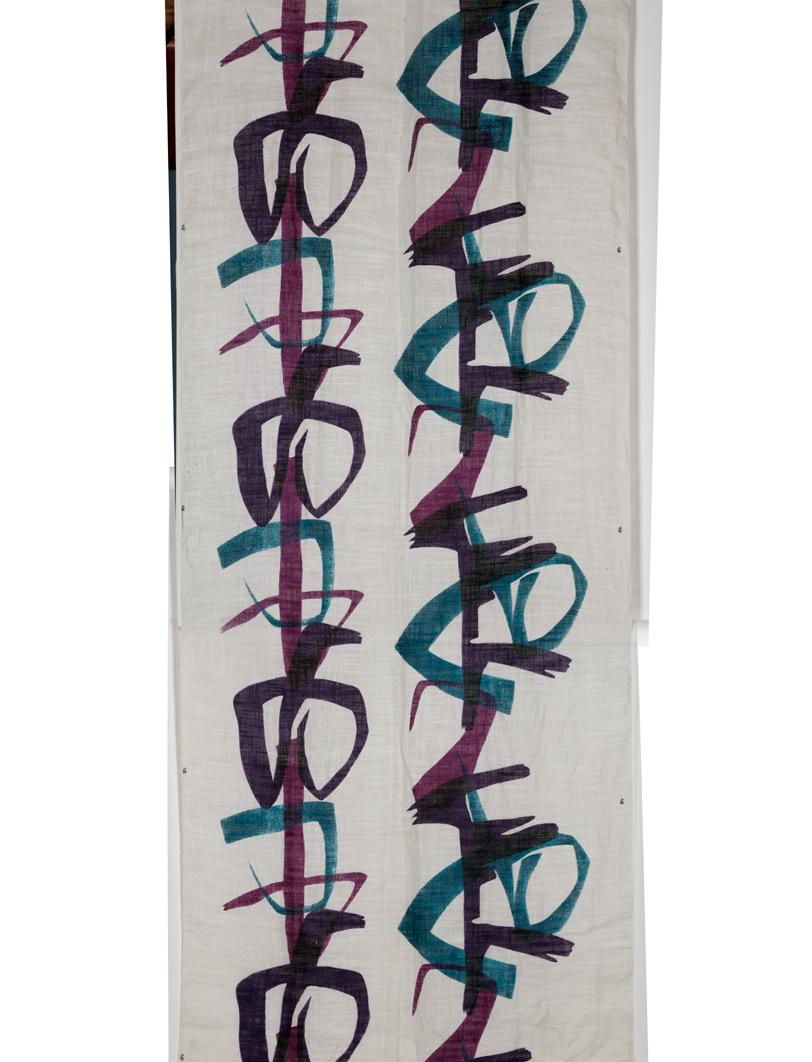
printed linen, marked to selvedge with manufacturer’s mark
310cm x 124cm
£200‑300
451 §

ALICE MACFARLANE STUDIO‑POTTERY VASE, CIRCA 1990S

glazed stoneware, apparently unmarked
67.5cm high
Note: Two large pottery vases by Alice Macfarlane of Stirling, from the collection of Sir Nicholas Goodison ‑ British Art: Innovation and Craftsmanship, were sold at Christie’s 25th May 2022, lot 44
£300‑500
450 §
JOHN PIPER (1903‑1992) FOR WEDGWOOD
‘THE GREEN MAN’ PLATE, 1989‑1990
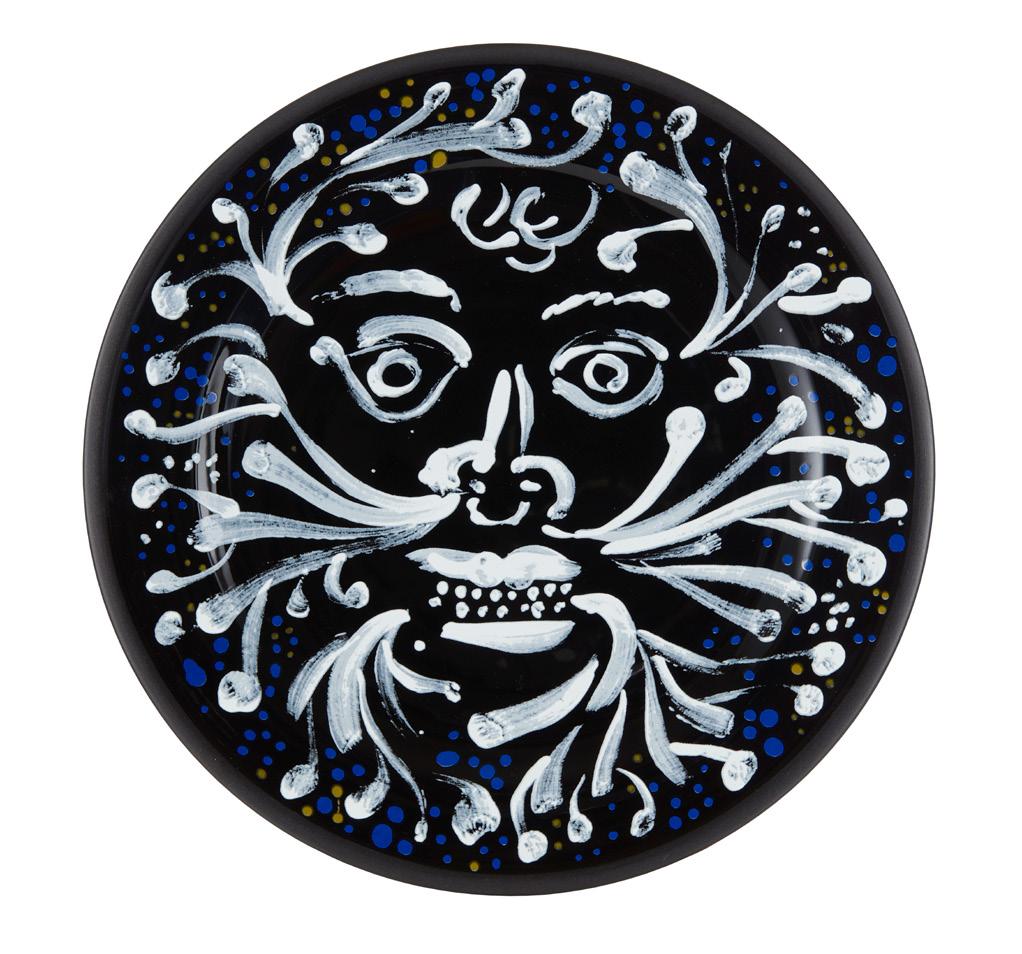
black basalt, with printed decoration, printed marks verso, within the original box, with documentation
31cm diameter
Note: One of a series of six plates commissioned by the Art Fund and Wedgwood in editions of 500
£300‑500
452
MANNER OF ROBERT CLATWORTHY
FIGURE OF A DOG
bronze, raised on an ebonised wood plinth

bronze 16cm long; total height including plinth 22cm high
£400‑600
180 Other fees apply in addition to the hammer price: see the ‘Buyer’s Guide’ section on page 2
453 §
SCOTTIE WILSON (1891‑1972)
UNTITLED ‑ SW36
pen, ink and gouache, signed lower right SCOTTIE, unframed 51cm x 63.5cm
Provenance: Gimpel Fils, London
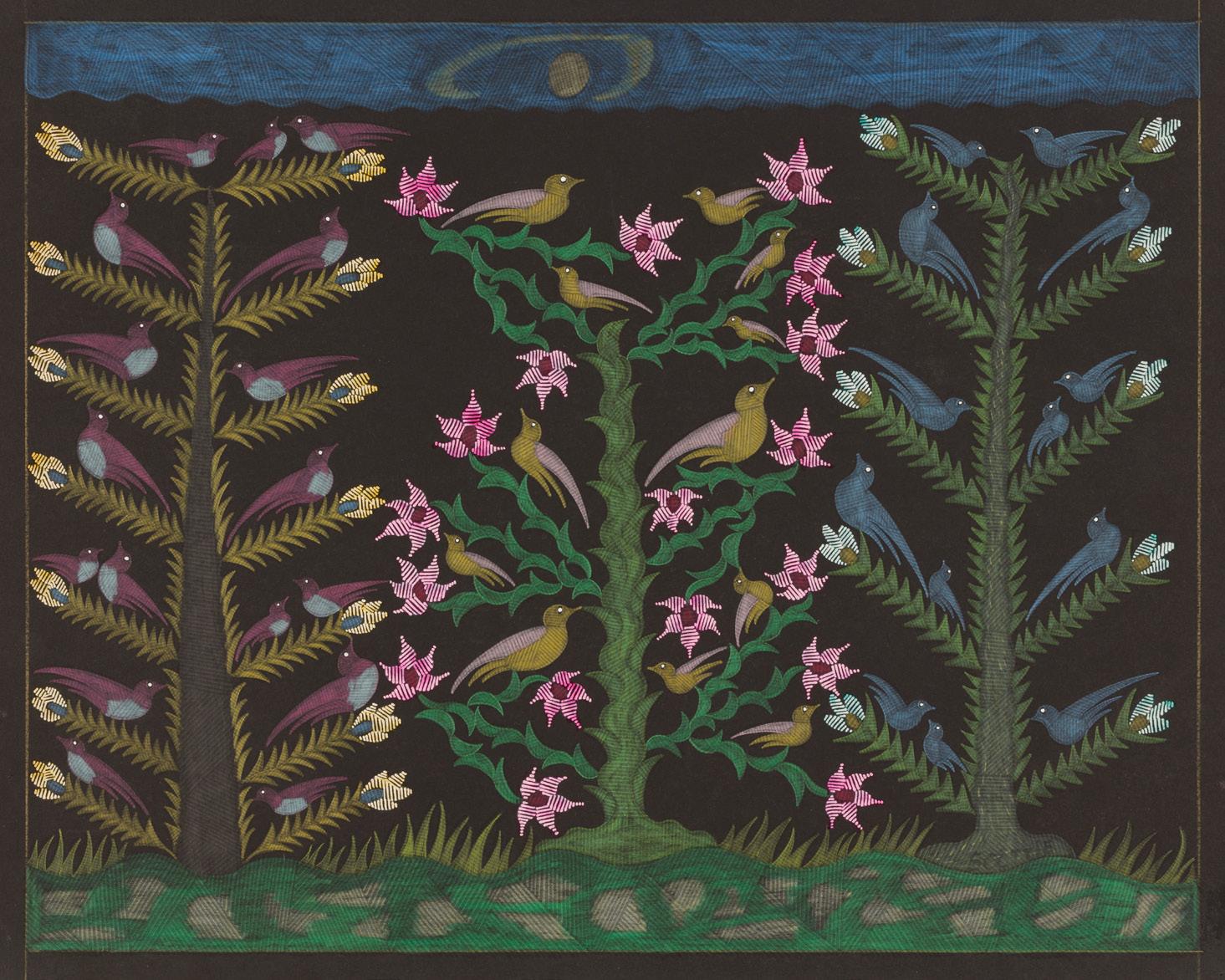
£800‑1,200
454 §

NORMAN GRANT (B. 1943)
‘MOLECULAR STRUCTURE OF PLANKTON’ NECKLACE, CIRCA 1973
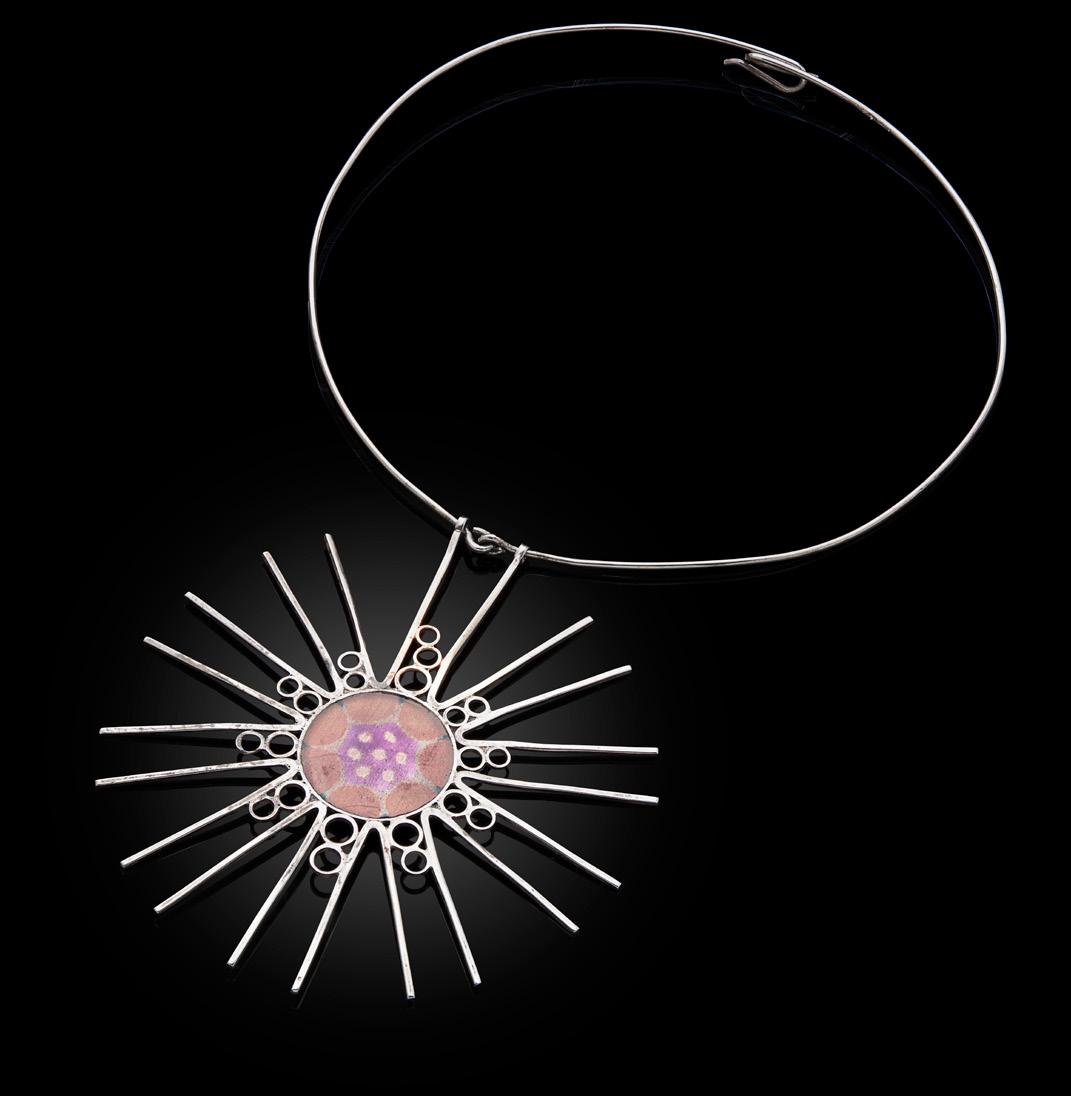
white metal, enamel, stamped maker’s mark NG pendant 9cm diameter
Note: Norman Grant was an artist and silversmith who set up Dust Jewellery in the 1970s. He specialised in enamelled silver pieces, including brooches, earrings, pendants and cufflinks and started hallmarking his work in 1973.
£300‑500
455 §
NORMAN GRANT (1943‑2017)
‘MICROSCOPIC PLANT CROSS SECTION’ SERIES BRACELET, EDINBURGH 1971

silver and enamel, stamped NG, hallmarked NG Edinburgh 1971
18cm long
£700‑900
181
456
DAVID LINLEY, LONDON
CONSOLE TABLE, 2001

walnut, with inlays of burr walnut and Indian ebony, stamped LINLEY; together with THE ORIGINAL PRINTED DESIGN (2)

152cm across, 87.5cm high, 54cm deep £800‑1,200
457
DAVID
PEDESTAL, 2001
walnut with inlays of burr ash and Indian ebony, stamped LINLEY (twice), together with THE ORIGINAL PRINTED DESIGN (2)
40cm square, 121cm high
£400‑600
LINLEY, LONDON
182 Other fees apply in addition to the hammer price: see the ‘Buyer’s Guide’ section on page 2
DESIGN SINCE 1860
19 APRIL EDINBURGH
TRAVEL & VINTAGE POSTERS
26 APRIL LONDON
LALIQUE

27 APRIL LONDON
MODERN MADE MODERN & POSTWAR ART & DESIGN
28 APRIL LONDON


























































































































































































































































































































































































































































































 BARNSLEY (1900‑1987)
BARNSLEY (1900‑1987)
 410 PETER WAALS (1870‑ 1937) BOOKCASE, CIRCA 1935 oak
410 PETER WAALS (1870‑ 1937) BOOKCASE, CIRCA 1935 oak










 418
ROBERT ‘MOUSEMAN’ THOMPSON (1876‑1955)
419 ROBERT ‘MOUSEMAN’ THOMPSON (1876‑1955)
418
ROBERT ‘MOUSEMAN’ THOMPSON (1876‑1955)
419 ROBERT ‘MOUSEMAN’ THOMPSON (1876‑1955)












































